For 2022 Gas Price News, visit: 2022 Oregon Gas Price News
Updated 1/4/2022
Refinery, Distribution, Weather Issues Send Pump Prices Higher
Oregon has largest weekly jump in the country
PORTLAND, Ore., – A refinery fire in Texas and some distribution snags in the Pacific Northwest are putting upward pressure on pump prices as 2022 begins. For the week, the national average for regular edges up half a cent to $3.29 a gallon. The Oregon average shoots up six cents to $3.83. This is the largest weekly jump in the nation.
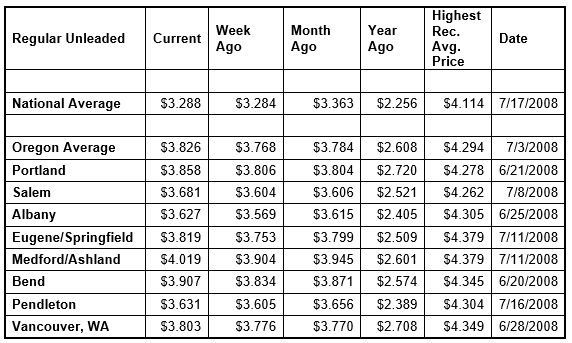
A pre-Christmas fire at the Exxon Mobil Corp plant in Baytown, Texas, is causing reduced output. Recent reporting, however, indicates the damage was to a non-refining section of the complex. The plant is the nation’s fourth-biggest oil refinery, with the capacity to process 560,500 barrels per day of crude.
Here in the Pacific Northwest, some issues at terminals in the Portland area as well as winter weather shutting down mountain passes have created tight supplies, causing retail pump prices to rise.
“In addition to the refinery and terminal issues, the Omicron variant is also influencing oil and fuel prices, as fears of the economic impact create uncertainty,” says Marie Dodds, public affairs director for AAA Oregon/Idaho. “Investors worry that the surge in COVID-19 cases due to the Omicron variant will lead to reduced future global oil consumption.”
Crude oil dropped to $68 per barrel on Dec. 20, then climbed above $75 per barrel on Dec. 27 and has remained above that benchmark since then. Crude oil prices tumbled in late November from $84 per barrel to below $70 per barrel, due to fears of a global shutdown and decreased demand for oil caused by news of the Omicron variant.
U.S. gasoline demand increased from 8.99 million b/d to 9.72 million b/d. Total domestic gasoline stocks decreased slightly by 1.5 million bbl to 222.7 million bbl last week, according to the U.S. Energy Information Administration (EIA). Growing demand and tight supply would support more significant increases in pump prices, but fluctuations in the price of crude oil have helped to limit price increases. If oil prices climb, pump prices will likely follow suit.
With the surge of the Omicron variant, travel continues to be impacted by the coronavirus pandemic. Visit AAA.com/covidmap for an interactive map with the latest travel restrictions and policies for North America. Find AAA’s latest COVID-19 information for travelers here.
Quick stats
Oregon is one of 22 states and the District of Columbia with higher prices now than a week ago. Oregon (+6 cents) has the largest weekly increase in the nation. Arizona (-4 cents) has the largest week-over-week decline.
California ($4.66) and Hawaii ($4.33) continue to have the most expensive gas prices in the country and are the only states in the nation with averages above $4 a gallon, while 39 states and the District of Columbia have averages above $3 a gallon.
The cheapest gas in the nation is in Oklahoma ($2.89) and Texas ($2.91). They are among 11 states that have averages below $3 a gallon. For the 52nd week in a row, no state has an average below $2 a gallon.
Oregon and Washington are the only two states that have higher prices now than a month ago. The national average is eight cents less and the Oregon average is four cents more than a month ago. Michigan (-17 cents) has the largest month-over-month decrease.
All 50 states and the District of Columbia have higher prices now than a year ago, and 26 states and D.C. have a current average that’s a dollar or more higher than a year ago. The national average is $1.03 more and the Oregon average is $1.22 more than a year ago. This is the sixth-largest yearly increase in the nation. California (+$1.41) has the biggest yearly increase. Ohio (+82 cents) has the smallest year-over-year increase.
West Coast
The West Coast region continues to have the most expensive pump prices in the nation with all seven states in the region in the top 10.
| Rank | Region | Price on 1/4/22 | ||
| 1 | California | $4.66 | ||
| 2 | Hawaii | $4.33 | ||
| 3 | Washington | $3.89 | ||
| 4 | Nevada | $3.84 | ||
| 5 | Oregon | $3.83 | ||
| 6 | Alaska | $3.71 | ||
| 7 | Arizona | $3.62 | ||
| 8 | Idaho | $3.57 | ||
| 9 | Pennsylvania | $3.53 | ||
| 10 | Connecticut | $3.50 |
California is the most expensive state for the 50th week in a row with Hawaii, Washington, Nevada, Oregon, Alaska, and Arizona rounding out the top seven. Oregon is fifth for the 13th week in a row.
Four of the seven states in the region are seeing week-over-week increases. Oregon (+6 cents) has the largest weekly gain in the region and the country. Arizona (-4 cents) has the largest week-over-week decline in the region and the country.
The refinery utilization rate on the West Coast decreased from 84.3% to 83.8% for the week ending December 24. The rate has ranged between 82% and 88% in the last year.
According to EIA’s latest weekly report, total gas stocks in the region fell from 28.24 million bbl to 27.39 million bbl.
Oil market dynamics
Despite demand concerns over the omicron variant of COVID-19, crude prices have increased since the EIA reported that total domestic oil stocks decreased by 3.6 million bbl last week to 420 million bbl. The current stock level is 14.9 percent lower than at the end of December 2020, contributing to domestic crude prices. This week, prices could continue to climb if EIA’s next weekly report shows another decrease in total stocks.
At the close of Friday’s formal trading session, WTI decreased by $1.78 to settle at $75.21. At the close of Monday’s formal trading session, WTI added 87 cents to close at $76.08. Today crude is trading around $77, compared to $76 a week ago. Crude prices are about $28 more than a year ago.
Drivers can find current gas prices along their route with the free AAA Mobile app for iPhone, iPad and Android. The app can also be used to map a route, find discounts, book a hotel and access AAA roadside assistance. Learn more at AAA.com/mobile.
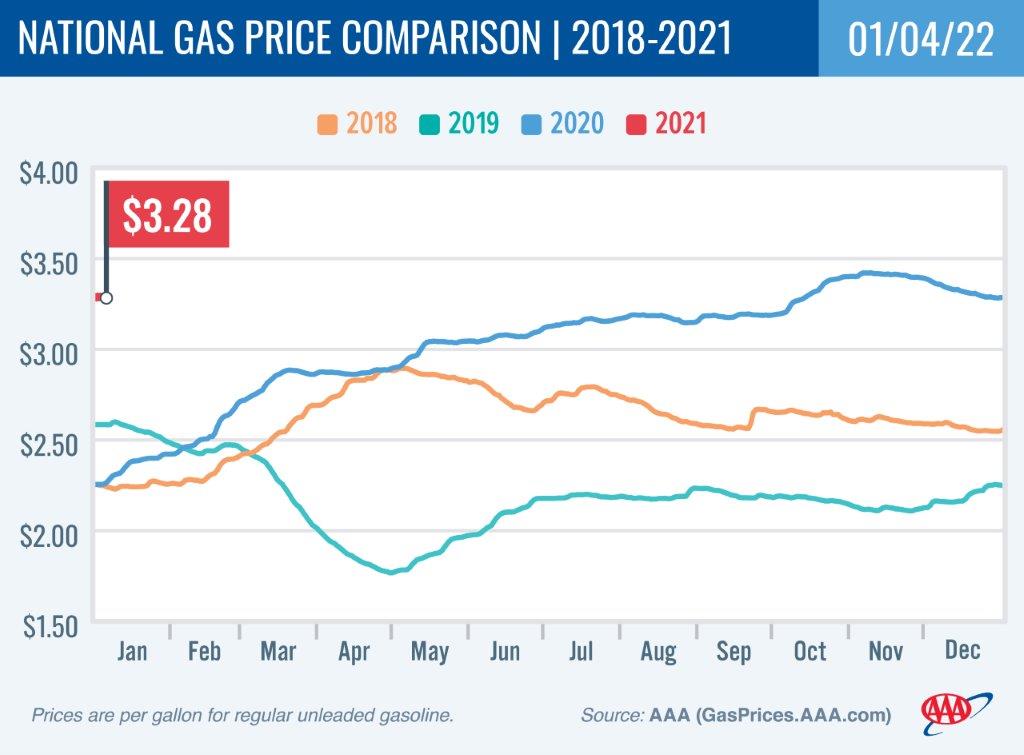
Diesel
For the week, the national average holds steady at $3.57 a gallon. Oregon’s average jumps six cents to $3.87. A year ago the national average for diesel was $2.57 and the Oregon average was $2.73.
Find current fuel prices at GasPrices.AAA.com.
AAA news releases, high resolution images, broadcast-quality video, fact sheets and podcasts are available on the AAA NewsRoom at NewsRoom.AAA.com.
Find local news releases at https://oregon.aaa.com/community/media/media-contacts.html
Fuel prices are updated daily at AAA’s Daily Fuel Gauge at AAA Gas Prices. For more info go www.AAA.com. AAA Oregon/Idaho provides more than 850,000 members with travel, insurance, financial and automotive-related services, and is an affiliate of AAA National, serving more than 62 million motorists in North America.
Updated 12/21/2022
Pump Prices Dip Ahead of Holiday Travel
AAA Projects 109 Million Americans including 1.5 Million Oregonians will take holiday trips
PORTLAND, Ore., – Demand for gasoline is surging in the U.S. leading up Christmas, but crude oil prices have fallen on concerns of the rapid spread of the Omicron variant. The lower crude prices are putting downward pressure on fuel prices. For the week, the national average for regular loses two cents to $3.30 a gallon. The Oregon average slips two cents to $3.77.
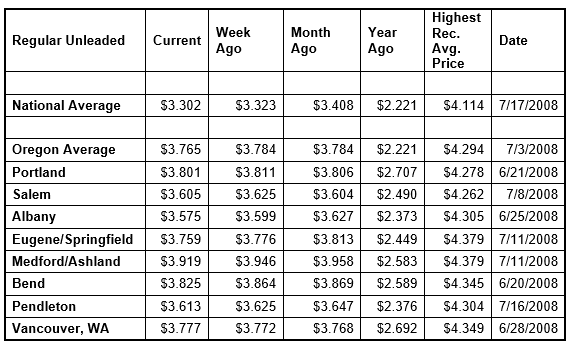
AAA projects 109 million Americans (33.2% of the population) will travel for the Christmas and New Year holidays, up 34% from 2020. This brings travel to nearly 93% of pre-pandemic levels in 2019. About 1.5 million Oregonians will pack their sleighs for a holiday trip. While nearly 92% of travelers will drive to their holiday destinations, air travel is seeing a huge bump this year, up 184% compared to 2020. With 27.7 million more people traveling for the holidays, roads and airports will be noticeably busy. Find all the details in the AAA holiday travel news release.
“Normally, a spike in demand would drive pump prices higher, but that’s been blunted by a drop in crude oil prices. Investors are concerned that the surge in COVID-19 cases due to the Omicron variant will threaten future global oil consumption,” says Marie Dodds, public affairs director for AAA Oregon/Idaho.
Crude oil dropped to $66 per barrel on Monday, down from a recent high of $72 last week. Crude oil prices tumbled in late November from $84 per barrel to below $70 per barrel, due to fears of a global shutdown and decreased demand for oil caused by news of the Omicron variant.
U.S. gasoline demand shot up from 8.96 million b/d to 9.47 million b/d. Total domestic gasoline stocks decreased by 700,000 bbl to 218.6 million bbl for the week ending December 10, according to the U.S. Energy Information Administration (EIA).
With news of the Omicron variant, travel continues to be impacted by the coronavirus pandemic. Visit AAA.com/covidmap for an interactive map with the latest travel restrictions and policies for North America. Find AAA’s latest COVID-19 information for travelers here.
Quick stats
Oregon is one of 46 states and the District of Columbia with lower prices now than a week ago. Indiana (-6 cents) has the largest weekly decline in the nation. South Carolina (+1 cent) has the largest week-over-week increase.
California ($4.66) and Hawaii ($4.34) continue to have the most expensive gas prices in the country and are the only states in the nation with averages above $4 a gallon, while 42 states and the District of Columbia have averages above $3 a gallon.
The cheapest gas in the nation is in Texas ($2.90) and Oklahoma ($2.90). They are among eight states that have averages below $3 a gallon. For the 50th week in a row, no state has an average below $2 a gallon.
All 50 states and the District of Columbia have lower prices now than a month ago. The national average is 11 cents less and the Oregon average is two cents less than a month ago. Indiana (-25 cents) has the largest month-over-month decrease. Hawaii (-1 cent) has the smallest monthly increase in the country.
All 50 states and the District of Columbia have higher prices now than a year ago, and 34 states and D.C. have a current average that’s a dollar or more higher than a year ago. The national average is $1.08 more and the Oregon average is $1.18 more than a year ago. This is the 12th-largest yearly increase in the nation. Arizona (+$1.48) has the biggest yearly increase. Iowa (+88 cents) has the smallest year-over-year increase.
West Coast
The West Coast region continues to have the most expensive pump prices in the nation with all seven states in the region in the top 10.
| Rank | Region | Price on 12/21/21 | ||
| 1 | California | $4.66 | ||
| 2 | Hawaii | $4.34 | ||
| 3 | Nevada | $3.86 | ||
| 4 | Washington | $3.86 | ||
| 5 | Oregon | $3.77 | ||
| 6 | Alaska | $3.70 | ||
| 7 | Arizona | $3.69 | ||
| 8 | Idaho | $3.61 | ||
| 9 | Pennsylvania | $3.55 | ||
| 10 | Utah | $3.55 |
California is the most expensive state for the 48th week in a row with Hawaii, Nevada, Washington, Oregon, Alaska, and Arizona rounding out the top seven. Oregon is fifth for the 11th week in a row.
Six of the seven states in the region are seeing week-over-week declines. Arizona (-4 cents) has the largest weekly decrease in the region. Hawaii (+1/2 cent) is the only state in the region with a weekly increase.
The refinery utilization rate on the West Coast decreased from 85.4% to 82.4% for the week ending December 10. The drop is due to issues at three California refineries that week. The rate has ranged between 82% and 88% for the year.
According to EIA’s latest weekly report, total gas stocks in the region rose from 26.97 million bbl to 27.21 million bbl.
Oil market dynamics
Crude prices declined last week due to growing market concerns that the omicron variant of COVID-19 will lead to a decrease in demand as governments around the globe increase measures to curb transmission rates. Additionally, crude prices declined despite EIA’s new data revealing that total domestic crude stocks decreased by 4.6 million bbl to 428.3 million bbl. The current stock level is 14.4 percent lower than mid-December 2020. For this week, crude prices could drop further if omicron concerns persist.
At the close of Friday’s formal trading session, WTI decreased by $1.52 to settle at $70.86. At the close of Monday’s formal trading session, WTI tumbled $2.63 to close at $68.23. Today crude is trading around $71, compared to $71 a week ago. Crude prices are about $19 more than a year ago.
Drivers can find current gas prices along their route with the free AAA Mobile app for iPhone, iPad and Android. The app can also be used to map a route, find discounts, book a hotel and access AAA roadside assistance. Learn more at AAA.com/mobile.
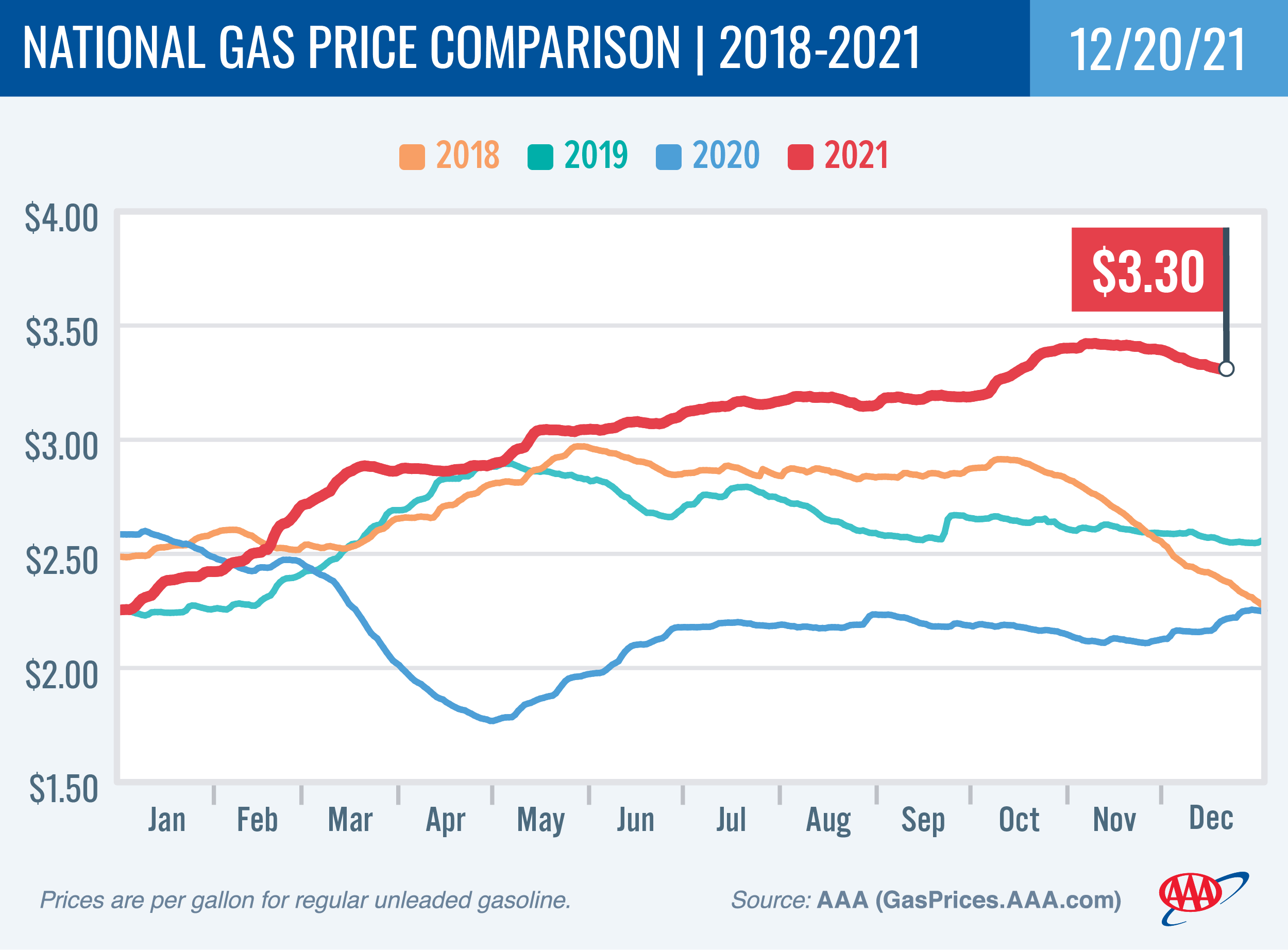
Diesel
For the week, the national average loses two cents to $3.58 a gallon. Oregon’s average holds steady at $3.81. A year ago the national average for diesel was $2.52 and the Oregon average was $2.72.
Find current fuel prices at GasPrices.AAA.com.
AAA news releases, high resolution images, broadcast-quality video, fact sheets and podcasts are available on the AAA NewsRoom at NewsRoom.AAA.com.
Find local news releases at https://oregon.aaa.com/community/media/media-contacts.html
Fuel prices are updated daily at AAA’s Daily Fuel Gauge at AAA Gas Prices. For more info go www.AAA.com. AAA Oregon/Idaho provides more than 850,000 members with travel, insurance, financial and automotive-related services, and is an affiliate of AAA National, serving more than 62 million motorists in North America.
Updated 12/14/2021
National Average Drifts Lower
Refinery issues keep West Coast prices from falling
PORTLAND, Ore., – Gas prices are drifting lower in many states but remain stubbornly high on the West Coast due to refinery issues in California which have impacted supplies in the region. For the week, the national average for regular loses three cents to $3.32 a gallon. The Oregon average holds steady at $3.78.
| Regular Unleaded | Current | Week Ago | Month Ago | Year Ago | Highest Rec. Avg. Price | Date |
| National Average | $3.323 | $3.349 | $3.413 | $2.164 | $4.114 | 7/17/2008 |
| Oregon Average | $3.784 | $3.781 | $3.781 | $2.584 | $4.294 | 7/3/2008 |
| Portland | $3.811 | $3.807 | $3.796 | $2.710 | $4.278 | 6/21/2008 |
| Salem | $3.625 | $3.614 | $3.593 | $2.489 | $4.262 | 7/8/2008 |
| Albany | $3.599 | $3.604 | $3.635 | $2.362 | $4.305 | 6/25/2008 |
| Eugene/Springfield | $3.776 | $3.793 | $3.805 | $2.445 | $4.379 | 7/11/2008 |
| Medford/Ashland | $3.946 | $3.957 | $3.946 | $2.577 | $4.379 | 7/11/2008 |
| Bend | $3.864 | $3.861 | $3.870 | $2.554 | $4.345 | 6/20/2008 |
| Pendleton | $3.625 | $3.625 | $3.656 | $2.406 | $4.304 | 7/16/2008 |
| Vancouver, WA | $3.772 | $3.765 | $3.768 | $2.687 | $4.349 | 6/28/2008 |
Issues at three California refineries over the weekend led to reduced output, which put upward pressure on prices in the West Coast region. The impacted refineries are Chevron’s 257,200-b/d Richmond refinery, Valero’s 149,000-b/d Benicia refinery, and the Wilmington section of the 147,000-b/d Phillips 66 Los Angeles refinery.
“Gas prices normally decline this time of year due to the shorter days and less robust demand. But rising crude oil prices this fall caused pump prices to climb then delayed the typical seasonal decreases,” says Marie Dodds, public affairs director for AAA Oregon/Idaho. “Now the refinery issues in California have prevented pump prices in this region from dipping as quickly as other parts of the country.”
Crude oil prices tumbled in late November from $84 per barrel to below $70 per barrel, due to fears of a global shutdown and decreased demand for oil caused by news of the Omicron variant. Crude prices have rebounded somewhat, as fears surrounding the variant have eased.
U.S. gasoline demand is relatively flat, creeping upwards from 8.8 million b/d to 8.9 million b/d. The slight increase in demand was countered by crude prices in the low $70s bbl. Total domestic gasoline stocks increased by nearly 4 million bbl to 219,304 million bbl for the week ending December 3, according to the U.S. Energy Information Administration (EIA).
With news of the Omicron variant, travel continues to be impacted by the coronavirus pandemic. Visit AAA.com/covidmap for an interactive map with the latest travel restrictions and policies for North America. Find AAA’s latest COVID-19 information for travelers here.
Quick stats
Oregon is one of two states where pump prices are flat this week, while 47 states are seeing gas prices fall week-over-week. Michigan (-5 cents) has the largest weekly decline in the nation. The District of Columbia (+2 cents) and Alaska (+6/10ths of a cent) are the only areas with weekly increases.
California ($4.68) and Hawaii ($4.33) continue to have the most expensive gas prices in the country and are the only states in the nation with averages above $4 a gallon, while 42 states and the District of Columbia have averages above $3 a gallon.
The cheapest gas in the nation is in Oklahoma ($2.89) and Texas ($2.90). They are among eight states that have averages below $3 a gallon. For the 49th week in a row, no state has an average below $2 a gallon.
Oregon is one of only four states where prices are flat month-over-month. Most states and the District of Columbia have lower prices now than a month ago. The national average is nine cents less and the Oregon average is the same as a month ago. Indiana (-23 cents) has the largest month-over-month decrease. Arizona (+7 cents) has the largest monthly increase in the country.
All 50 states and the District of Columbia have higher prices now than a year ago, and 47 states and D.C. have a current average that’s a dollar or more higher than a year ago. The national average is $1.16 more and the Oregon average is $1.20 more than a year ago. This is the 16th-largest yearly increase in the nation. Arizona (+$1.52) has the biggest yearly increase. Delaware (+96 cents) has the smallest year-over-year increase.
West Coast
The West Coast region continues to have the most expensive pump prices in the nation with all seven states in the region in the top 10.
| Rank | Region | Price on 12/14/21 | ||
| 1 | California | $4.68 | ||
| 2 | Hawaii | $4.33 | ||
| 3 | Nevada | $3.88 | ||
| 4 | Washington | $3.87 | ||
| 5 | Oregon | $3.78 | ||
| 6 | Arizona | $3.73 | ||
| 7 | Alaska | $3.72 | ||
| 8 | Idaho | $3.62 | ||
| 9 | Utah | $3.58 | ||
| 10 | Pennsylvania | $3.56 |
California is the most expensive state for the 47th week in a row with Hawaii, Nevada, Washington, Oregon, Arizona, and Alaska rounding out the top seven. Oregon is fifth for the 10th week in a row.
Arizona (-4 cents) has the largest weekly decrease in the region. Alaska (+6/10ths of a cent) has the largest weekly increase in the region. Prices are flat in Oregon and Washington.
The refinery utilization rate on the West Coast increased from 84.5% to 85.4% for the week ending December 3. However, refinery issues at three California refineries over the weekend impacted output which will be reflected in next week’s report. The rate has ranged between 82% and 88% for the year.
According to EIA’s latest weekly report, total gas stocks in the region dipped from 27.06 million bbl to 26.97 million bbl.
Oil market dynamics
Crude oil prices rose slightly last week after EIA’s weekly report showed that total domestic crude inventories decreased by 200,000 bbl to 432.9 million bbl. The current storage level is approximately 14 percent lower than last year’s storage level at this time, which is helping to keep crude prices elevated. Additionally, prices rebounded last week as optimism increased that the omicron variant of the COVID-19 virus will not have as large an impact on global energy demand as initially feared. For this week, continued optimism could help crude prices continue to rise.
At the close of Friday’s formal trading session, WTI increased 73 cents to settle at $71.67. At the close of Monday’s formal trading session, WTI fell 38 cents to close at $71.29. Today crude is trading around $70, compared to $72 a week ago. Crude prices are about $25 more than a year ago.
Drivers can find current gas prices along their route with the free AAA Mobile app for iPhone, iPad and Android. The app can also be used to map a route, find discounts, book a hotel and access AAA roadside assistance. Learn more at AAA.com/mobile.
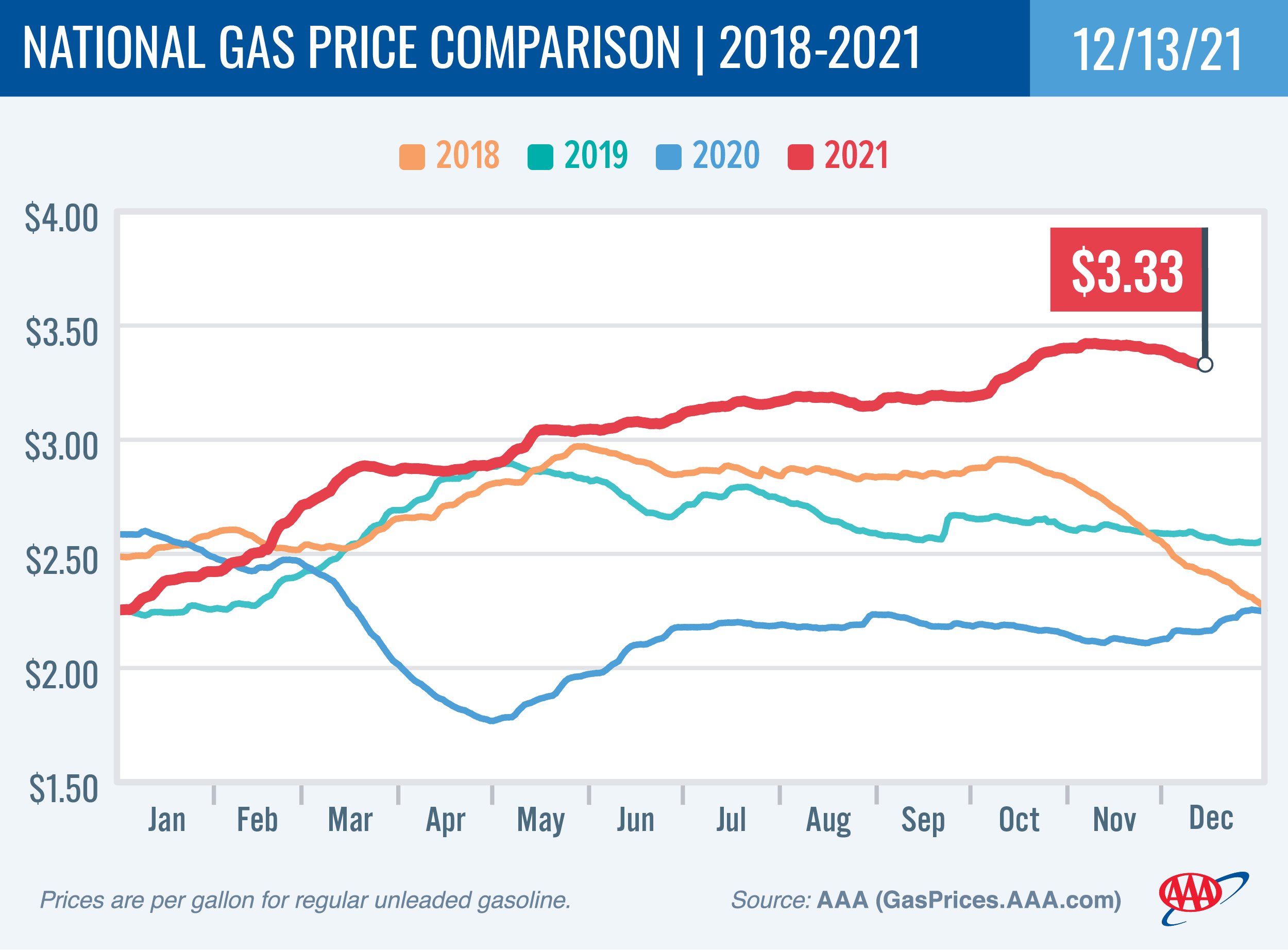
Diesel
For the week, the national average loses two cents to $3.60 a gallon. Oregon’s average dips half a cent to $3.81. A year ago the national average for diesel was $2.47 and the Oregon average was $2.73.
Find current fuel prices at GasPrices.AAA.com.
AAA news releases, high resolution images, broadcast-quality video, fact sheets and podcasts are available on the AAA NewsRoom at NewsRoom.AAA.com.
Find local news releases at https://oregon.aaa.com/community/media/media-contacts.html
Fuel prices are updated daily at AAA’s Daily Fuel Gauge at AAA Gas Prices. For more info go www.AAA.com. AAA Oregon/Idaho provides more than 850,000 members with travel, insurance, financial and automotive-related services, and is an affiliate of AAA National, serving more than 62 million motorists in North America.
Updated 12/7/2021
Gas Prices Retreat
Omicron variant, OPEC production hike, and SPR release spur lower prices for now
PORTLAND, Ore., – Pump prices continue to tick down due to lower crude oil prices, increased oil production from OPEC, and last month’s release of oil from the U.S. Strategic Petroleum Reserve. Prices have declined in all 50 states. For the week, the national average for regular falls four cents to $3.35 a gallon. The Oregon average slips a penny to $3.78.
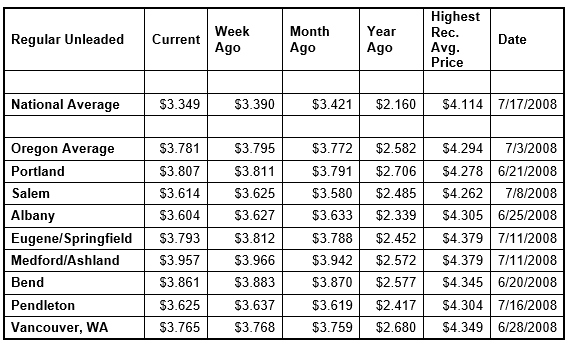
Crude oil prices fell from $84 per barrel on November 9 to below $70 per barrel on November 26, and remained below $70 until today. Fears of a possible COVID-19 global economic slowdown due to the new Omicron variant are a major driver of the lower crude oil prices, as well as last week’s decision by OPEC and its oil-producing allies not to cut oil production, and last month’s release of oil from the U.S. Strategic Petroleum Reserve.
On December 2, OPEC and its allies, a group referred to as OPEC+, announced it would stick to its plan, for now, to raise production by 400,000 b/d in January. The Biden administration had called on the cartel to increase production to tame high fuel prices.
“Drivers are getting a little relief at the pumps in time for the holidays. But gas prices still remain elevated for this time of year,” says Marie Dodds, public affairs director for AAA Oregon/Idaho.
U.S. gasoline demand is down slightly from 9.3 million b/d to 8.8 million b/d. Total domestic gasoline stocks increased by more than 4 million bbl to 215,422 million bbl for the week ending November 26, according to the U.S. Energy Information Administration (EIA). The slight decrease in demand and increase in stocks contributed to falling pump prices.
With news of the Omicron variant, travel continues to be impacted by the coronavirus pandemic. Visit AAA.com/covidmap for an interactive map with the latest travel restrictions and policies for North America. Find AAA’s latest COVID-19 information for travelers here.
Quick stats
All 50 states are seeing gas prices fall week-over-week. The District of Columbia (-12 cents) has the largest weekly decline in the nation. Arizona (-1/2 cent) has the smallest.
California ($4.69) and Hawaii ($4.34) continue to have the most expensive gas prices in the country and are the only states in the nation with averages above $4 a gallon, while 45 states and the District of Columbia have averages above $3 a gallon.
The cheapest gas in the nation is in Oklahoma ($2.92) and Texas ($2.94). They are among five states that have averages below $3 a gallon. For the 48th week in a row, no state has an average below $2 a gallon.
Oregon is one of only seven states with higher prices now than a month ago. The national average is seven cents less and the Oregon average is one cent more than a month ago. Arizona (+18 cents) has the largest month-over-month increase. Indiana (-22 cents) has the largest monthly decrease in the country.
All 50 states and the District of Columbia have higher prices now than a year ago, and 48 states and D.C. have a current average that’s a dollar or more higher than a year ago. The national average is $1.19 more and the Oregon average is $1.20 more than a year ago. This is the 20th-largest yearly increase in the nation. Arizona (+$1.56) has the biggest yearly increase. Delaware (+97 cents) has the smallest year-over-year increase.
West Coast
The West Coast region continues to have the most expensive pump prices in the nation with all seven states in the region in the top 10.
| Rank | Region | Price on 12/7/21 | ||
| 1 | California | $4.69 | ||
| 2 | Hawaii | $4.34 | ||
| 3 | Nevada | $3.91 | ||
| 4 | Washington | $3.87 | ||
| 5 | Oregon | $3.78 | ||
| 6 | Arizona | $3.77 | ||
| 7 | Alaska | $3.71 | ||
| 8 | Idaho | $3.66 | ||
| 9 | Utah | $3.62 | ||
| 10 | Pennsylvania | $3.57 |
California is the most expensive state for the 46th week in a row with Hawaii, Nevada, Washington, Oregon, Arizona, and Alaska rounding out the top seven. Oregon is fifth for the ninth week in a row.
All seven states in the region are showing small decreases for the week. California (-2 cents) has the largest weekly decrease in the region while Arizona (-1/2 cent) has the smallest weekly decrease in the region and the country.
The refinery utilization rate on the West Coast increased from nearly 83% to nearly 85% for the week ending November 26. The rate has ranged between 82% and 88% this year.
According to EIA’s latest weekly report, total gas stocks in the region rose slightly from 26.87 million bbl to 27.06 million bbl.
Oil market dynamics
Crude oil prices are on the rise again this week, but decreased last week due to uncertainty of the COVID-19 omicron variant’s impact on demand and the announcement that OPEC+ will ramp up production by 400,000 b/d in January. Additionally, EIA reported minimal draws on U.S. commercial crude oil inventories, which decreased by 900,000 bbl from the previous week to 433.1 million barrels. This week, crude oil prices could continue to fluctuate. Market watchers will keep a close eye on crude oil inventories and the impact that the omicron variant has on demand.
At the close of Friday’s formal trading session, WTI decreased by 24 cents to settle at $66.26. At the close of Monday’s formal trading session, WTI added $3.23 to close at $69.49. Today crude is trading around $72, compared to $66 a week ago. Crude prices are about $23 more than a year ago.
Drivers can find current gas prices along their route with the free AAA Mobile app for iPhone, iPad and Android. The app can also be used to map a route, find discounts, book a hotel and access AAA roadside assistance. Learn more at AAA.com/mobile.
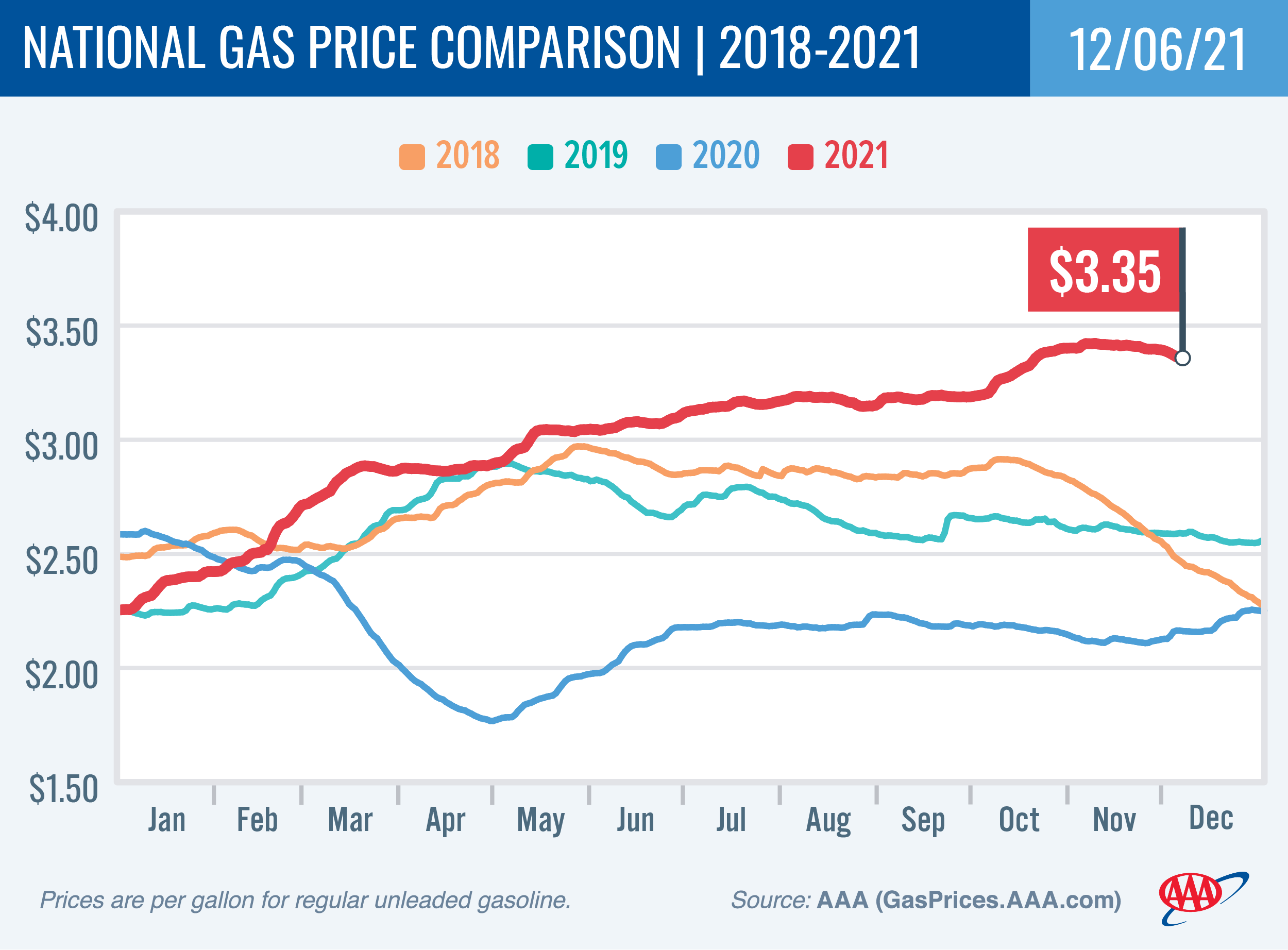
Diesel
For the week, the national average loses two cents to $3.62 a gallon. Oregon’s average dips half a cent to $3.82. A year ago the national average for diesel was $2.45 and the Oregon average was $2.72.
Find current fuel prices at GasPrices.AAA.com.
AAA news releases, high resolution images, broadcast-quality video, fact sheets and podcasts are available on the AAA NewsRoom at NewsRoom.AAA.com.
Find local news releases at https://oregon.aaa.com/community/media/media-contacts.html
Fuel prices are updated daily at AAA’s Daily Fuel Gauge at AAA Gas Prices. For more info go www.AAA.com. AAA Oregon/Idaho provides more than 850,000 members with travel, insurance, financial and automotive-related services, and is an affiliate of AAA National, serving more than 62 million motorists in North America.
Updated 11/30/2021
Crude Oil Prices Plummet on News of Omicron Variant
Will pump prices follow?
PORTLAND, Ore., – Crude oil prices have tumbled after news of the Omicron variant of the virus that causes COVID-19, and that’s expected to put some downward pressure on pump prices in the next couple weeks. For now, prices are fairly stable in most states. For the week, the national average for regular slips a penny to $3.39 a gallon. The Oregon average adds a penny to $3.79.

“Drivers should get a little relief at the pumps but it’s too soon to say if lower crude oil prices will last. For now, fears of a global economic slowdown caused by the Omicron variant are pushing crude prices lower, which should translate into cheaper gas prices in the next couple weeks,” says Marie Dodds, public affairs director for AAA Oregon/Idaho.
Crude oil prices plummeted more than $10 to $68 per barrel on Friday after news of the Omicron variant broke. Crude prices tumbled more today, falling to $66 bbl. Crude had been between about $75 and $85 bbl from Sept. 27 through Nov. 25. Crude started 2021 at $48 bbl.
California continues to set new record high prices for gasoline. The average on Nov. 27 was $4.713, which eclipsed new records set in the past couple weeks. Until this month, California’s previous record high price was $4.671 in October 2012. Severe rainstorms in Northern California impacted oil refineries in the area, leading to reduced production which has created supply issues.
U.S. gasoline demand is up slightly from 9.24 to 9.33 million b/d. Total domestic gasoline stocks decreased by 603,000 to 211 million bbl for the week ending November 19, according to the U.S. Energy Information Administration (EIA).
With news of the omicron variant and the holiday season almost here, travel continues to be impacted by the coronavirus pandemic. Visit AAA.com/covidmap for an interactive map with the latest travel restrictions and policies for North America. Find AAA’s latest COVID-19 information for travelers here.
Quick stats
All 50 states are seeing stable prices, changing by four cents or less week-over-week. Indiana (-4 cents) has the largest week-over-week decline in the nation. Arizona (+3 cents) has the largest weekly increase in the country.
California ($4.71) and Hawaii ($4.36) continue to have the most expensive gas prices in the country and are the only states in the nation with averages above $4 a gallon. All other states and the District of Columbia have averages above $3 a gallon except Oklahoma and Texas.
The cheapest gas in the nation is in Oklahoma ($2.96) and Texas ($2.98) and. For the 47th week in a row, no state has an average below $2 a gallon.
Oregon is one of 20 states with higher prices now than a month ago. The national average is one cent less and the Oregon average is one cent more than a month ago. Arizona (+26 cents) has the largest month-over-month increase. Missouri (-11 cents) has the largest monthly decrease in the country.
All 50 states and the District of Columbia have higher prices now than a year ago, and all have a current average that’s a dollar or more higher than a year ago. The national average is $1.26 more and the Oregon average is $1.21 more than a year ago. This is the 32nd-largest yearly increase in the nation. Arizona (+$1.56) has the biggest yearly increase. Delaware (+$1.00) has the smallest year-over-year increase.
West Coast
The West Coast region continues to have the most expensive pump prices in the nation with all seven states in the region in the top 10.
| Rank | Region | Price on 11/30/21 | ||
| 1 | California | $4.71 | ||
| 2 | Hawaii | $4.36 | ||
| 3 | Nevada | $3.96 | ||
| 4 | Washington | $3.88 | ||
| 5 | Oregon | $3.80 | ||
| 6 | Arizona | $3.78 | ||
| 7 | Alaska | $3.73 | ||
| 8 | Idaho | $3.68 | ||
| 9 | Utah | $3.67 | ||
| 10 | Pennsylvania | $3.59 |
California is the most expensive state for the 45th week in a row with Hawaii, Nevada, Washington, Oregon, Arizona, and Alaska rounding out the top seven. Oregon is fifth for the eighth week in a row.
Six states in the region are showing small increases for the week. Arizona (+3 cents) has the largest weekly increase while in the region while Nevada (-1cent) is the only state in the region with a weekly decline.
The refinery utilization rate on the West Coast decreased from nearly 85% to 83% for the week ending November 19. The rate has ranged from 85% to 88% much of the summer and fall after remaining between about 82% and 84% in the spring.
According to EIA’s latest weekly report, total gas stocks in the region edged lower from 27.66 million bbl to 26.87 million bbl. Decreasing stocks may put upward pressure on pump prices in the region.
Oil market dynamics
Crude prices fell Friday amid concerns about the new COVID-19 Omicron variant and the travel restrictions announced by the Biden administration. Prices fell even more today on concerns that current vaccines may not be as effective against the new strain. With little known about the new variant, it is unclear what long-term impact it may have on crude prices. Before reports of the new variant, EIA’s weekly report revealed that total domestic crude supply increased by 1 million bbl to 434 million bbl. However, prices rose last week despite President Biden’s announcement that the federal government will make available up to 32 million bbl of oil held in the U.S. Strategic Petroleum Reserve (SPR) and accelerate the timeline for the sale of an additional 18 million bbl of SPR oil, as mandated by Congress. The effort is expected to be coordinated with the release of oil from other major crude consuming countries, including China, India, Japan, South Korea, and the U.K, to help reduce the price of crude. How much of a price impact, and how long the price relief at the pump will last, depends on the total amount of oil that moves into the market after the coordinated releases around the globe. For this week, crude prices could decline further if the global market begins to see an increase in supply from the joint releases or EIA’s next report shows another increase in total domestic supply. Additionally, market watchers will keep their eye on the impact of the Omicron variant on the oil market.
At the close of Friday’s formal trading session, WTI decreased by $10.24 to settle at $68.15. At the close of Monday’s formal trading session, WTI added $1.80 to close at $69.95. Today crude is trading around $66, compared to $79 a week ago. Crude prices are about $24 more than a year ago.
Drivers can find current gas prices along their route with the free AAA Mobile app for iPhone, iPad and Android. The app can also be used to map a route, find discounts, book a hotel and access AAA roadside assistance. Learn more at AAA.com/mobile.
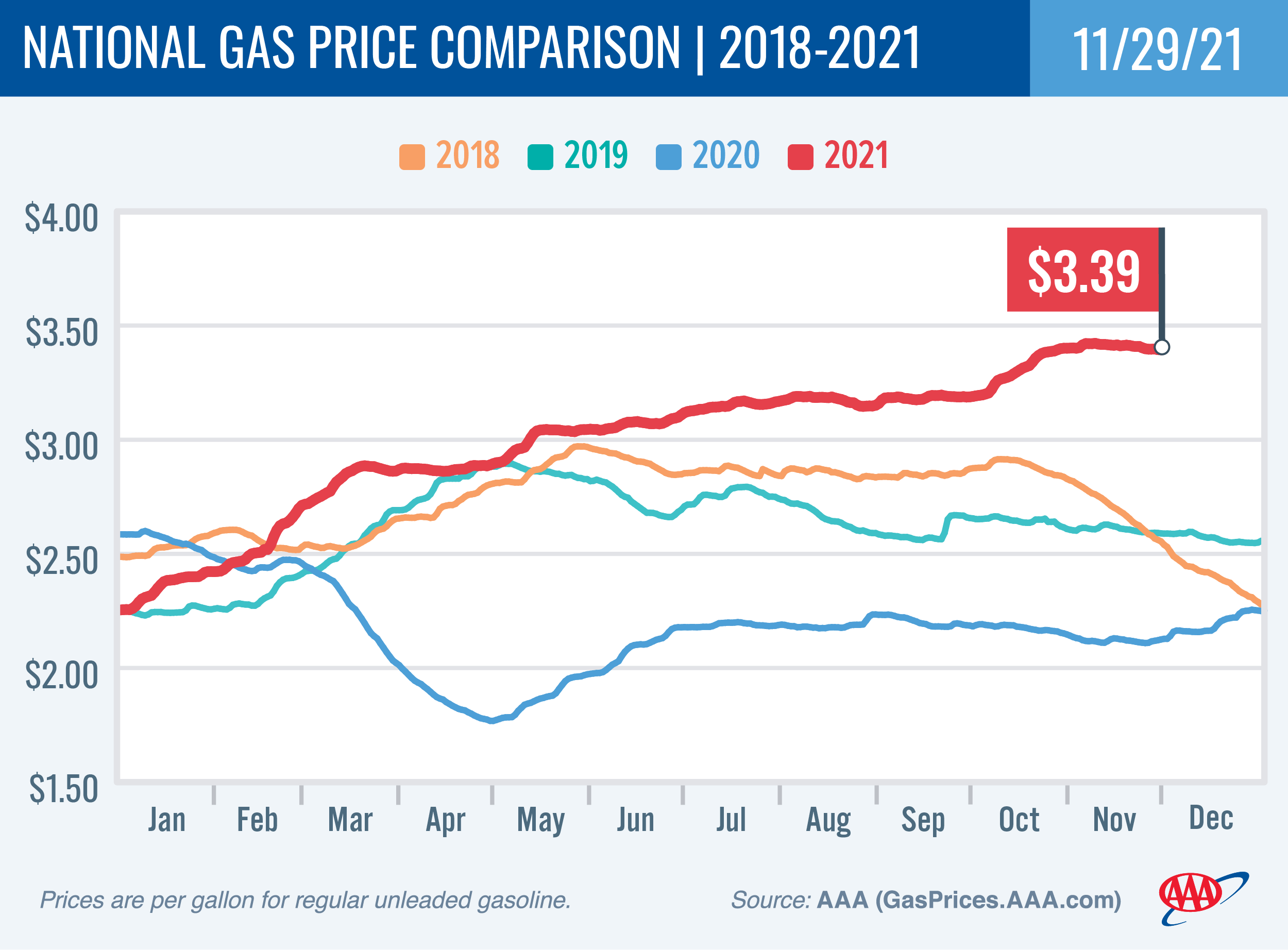
Diesel
For the week, the national average remains at $3.64 a gallon. Oregon’s average rises a cent to $3.82. A year ago the national average for diesel was $2.42 and the Oregon average was $2.73.
Find current fuel prices at GasPrices.AAA.com.
AAA news releases, high resolution images, broadcast-quality video, fact sheets and podcasts are available on the AAA NewsRoom at NewsRoom.AAA.com.
Find local news releases at https://oregon.aaa.com/community/media/media-contacts.html
Fuel prices are updated daily at AAA’s Daily Fuel Gauge at AAA Gas Prices. For more info go www.AAA.com. AAA Oregon/Idaho provides more than 850,000 members with travel, insurance, financial and automotive-related services, and is an affiliate of AAA National, serving more than 62 million motorists in North America.
Updated 11/23/2021
Gas Prices Steady for Thanksgiving Travel
Will oil release bring lower prices for the holidays?
PORTLAND, Ore., – Thanksgiving travelers will find gas prices holding relatively steady this week. Averages in 43 states including Oregon have changed by three cents or less. Lower crude oil prices are helping to put downward pressure on pump prices. For the week, the national average for regular slips a penny to $3.40 a gallon. The Oregon average remains at $3.78.
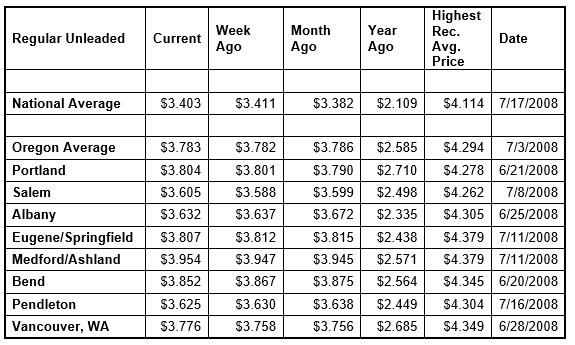
The Oregon average is the highest it’s ever been for Thanksgiving. The national average is the highest for the holiday since 2012. The expensive gas prices won’t keep people from traveling over Thanksgiving. AAA projects 53.4 million Americans including 746,000 Oregonians will travel for the Thanksgiving holiday, up 13% from 2020. About 90% will drive to their destinations. Find all the details in the AAA Thanksgiving travel news release.
President Biden today announced the U.S. and other countries would release strategic crude oil reserves in an effort to increase supply and put downward pressure on gas prices. The U.S. will release 50 million barrels and will be joined by China, India, Japan, South Korea, and the United Kingdom.
Crude oil prices moved lower in the last week, partly in anticipation of the release. For the first time since Oct. 11, crude oil prices have fallen below $80 per barrel and have remained in the mid-to upper $70 range for the last week. Fears of slowing economic activity in the U.S. and Europe due to a resurgence of COVID-19, along with the release of stockpiled oil are driving the lower prices.
“Falling crude oil prices normally translates into cheaper pump prices for drivers because the price of crude oil accounts for 50% to 60% of what consumers pay at the pumps,” says Marie Dodds, public affairs director for AAA Oregon/Idaho. “However, until global oil production ramps back up to pre-pandemic levels, the dip in crude prices may only be temporary.”
Here in the U.S. about 5% of the nation’s refineries shut down during the COVID-19 pandemic as people stayed home. And the cartel OPEC+ has not significantly boosted production. The result has been tight supplies and high prices as demand has climbed back up to pre-pandemic levels but production has not.
For the second week in a row, California continues to set new record high prices for gasoline. Today’s average is $4.705. Monday’s average was $4.706 and Sunday’s was $4.704. California’s previous record high price was $4.671 in October 2012. Severe rainstorms in Northern California impacted oil refineries in the area, leading to reduced production which has created supply issues.
Total domestic gasoline stocks decreased by 700,000 bbl to 212 million bbl last week. Gasoline demand also dropped slightly from 9.26 million b/d to 9.24 million b/d according to the U.S. Energy Information Administration (EIA). The decrease in demand, alongside stocks, has helped to steady pump prices. However, gasoline prices will likely remain elevated as long as oil prices are near or above $75 per barrel.
With Thanksgiving and the holiday season almost here, travel continues to be impacted by the coronavirus pandemic. Visit AAA.com/covidmap for an interactive map with the latest travel restrictions and policies for North America. Find AAA’s latest COVID-19 information for travelers here.
Quick stats
Oregon is one of eight states where prices are flat week-over-week, while 43 states are seeing averages change by three cents or less. Only seven states saw prices change by four cents or more. Florida (+9 cents) has the largest week-over-week gain in the nation. Michigan (-5 cents) has the largest weekly decrease in the country.
California ($4.71) and Hawaii ($4.35) continue to have the most expensive gas prices in the country and are the only states in the nation with averages above $4 a gallon. All other states and the District of Columbia have averages above $3 a gallon except Oklahoma which dropped below the $3 mark this week.
The cheapest gas in the nation is in Oklahoma ($2.97) and Texas ($3.00) and. For the 46th week in a row, no state has an average below $2 a gallon.
Oregon is one of 21 states with lower prices now than a month ago. The national average is two cents more and the Oregon average is 3/10ths of a cent less than a month ago. Arizona (+30 cents) has the largest month-over-month increase. Tennessee (-5 cents) has the largest monthly decrease in the country.
All 50 states and the District of Columbia have higher prices now than a year ago, and all have a current average that’s a dollar or more higher than a year ago. The national average is $1.29 more and the Oregon average is $1.20 more than a year ago. This is the 41st-largest yearly increase in the nation. California (+$1.53) has the biggest yearly increase. Hawaii (+$1.10) has the smallest year-over-year increase.
West Coast
The West Coast region continues to have the most expensive pump prices in the nation with all seven states in the region in the top 10.
| Rank | Region | Price on 11/23/21 | ||
| 1 | California | $4.71 | ||
| 2 | Hawaii | $4.35 | ||
| 3 | Nevada | $3.97 | ||
| 4 | Washington | $3.88 | ||
| 5 | Oregon | $3.78 | ||
| 6 | Arizona | $3.74 | ||
| 7 | Alaska | $3.72 | ||
| 8 | Utah | $3.69 | ||
| 9 | Idaho | $3.68 | ||
| 10 | Pennsylvania | $3.60 |
California is the most expensive state for the 44th week in a row with Hawaii, Nevada, Washington, Oregon, Arizona and Alaska rounding out the top seven. Oregon is fifth for the seventh week in a row.
Arizona, California, Alaska have weekly increases. Arizona (+5 cents) has the largest weekly increase in the region. Averages are basically flat in Nevada, Washington, Oregon and Hawaii.
The refinery utilization rate on the West Coast increased from 79% to nearly 85% for the week ending November 12. The rate fell after refineries in Northern California were impacted by heavy rains. The rate has ranged from 85% to 88% much of the summer and fall after remaining between about 82% and 84% in the spring.
According to EIA’s latest weekly report, total gas stocks in the region edged lower from 28.12 million bbl to 27.66 million bbl. Stocks have been declining since mid-September. Decreasing stocks may put upward pressure on pump prices in the region.
Oil market dynamics
Crude oil prices declined at the end of last week as the dollar grew in strength and market concerns about crude demand increased over growing COVID infection rates in Europe and the U.S. If social restrictions are re-imposed to curb COVID transmission, crude demand will likely decline and prices will likely follow. Additionally, crude prices decreased last week despite EIA’s weekly report showing that total domestic crude supply decreased by 2.1 million bbl to 433 million bbl. When compared to the end of November 2020, current total domestic crude supply is nearly 12 percent lower than last year.
At the close of Friday’s formal trading session, WTI decreased by $2.91 to settle at $76.10. At the close of Monday’s formal trading session, WTI added 81 cents to close at $76.75. Today crude is trading around $78, compared to $81 a week ago. Crude prices are about $35 more than a year ago.
Drivers can find current gas prices along their route with the free AAA Mobile app for iPhone, iPad and Android. The app can also be used to map a route, find discounts, book a hotel and access AAA roadside assistance. Learn more at AAA.com/mobile.
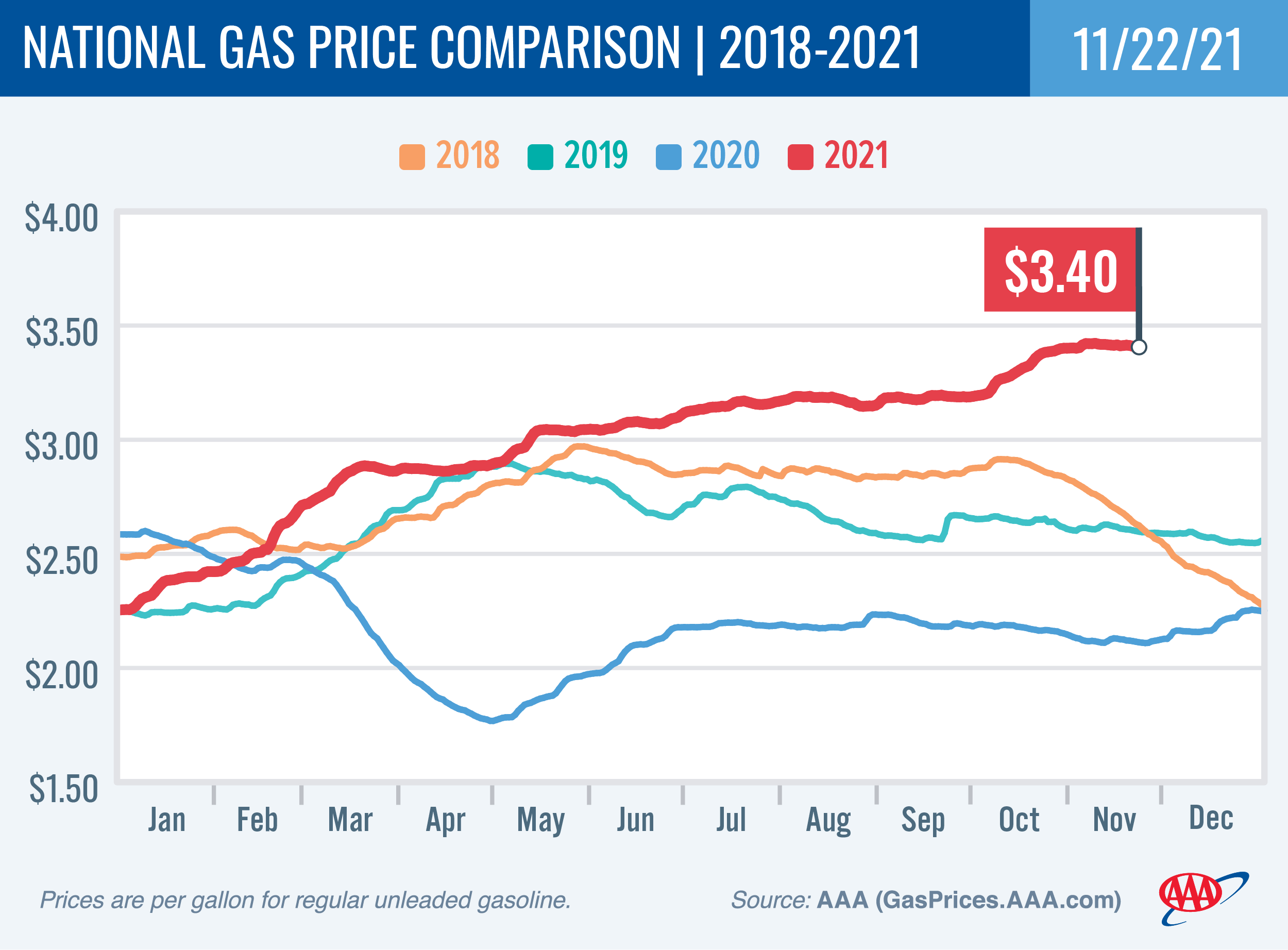
Diesel
For the week, the national average slips three-tenths of a cent to $3.64 a gallon. Oregon’s average adds one-and-a-half cents to $3.81. A year ago the national average for diesel was $2.40 and the Oregon average was $2.71.
Find current fuel prices at GasPrices.AAA.com.
AAA news releases, high resolution images, broadcast-quality video, fact sheets and podcasts are available on the AAA NewsRoom at NewsRoom.AAA.com.
Find local news releases at https://oregon.aaa.com/community/media/media-contacts.html
Fuel prices are updated daily at AAA’s Daily Fuel Gauge at AAA Gas Prices. For more info go www.AAA.com. AAA Oregon/Idaho provides more than 850,000 members with travel, insurance, financial and automotive-related services, and is an affiliate of AAA National, serving more than 62 million motorists in North America.
Updated 11/16/2021
Pump Prices Steady in Most States including Oregon but California Average Soars to Record High
PORTLAND, Ore., – Gas prices are showing little movement this week, with the averages in 43 states, including Oregon, changing by three cents or less. For the week, the national average for regular slips a penny to $3.41 a gallon. The Oregon average adds a penny to $3.78.
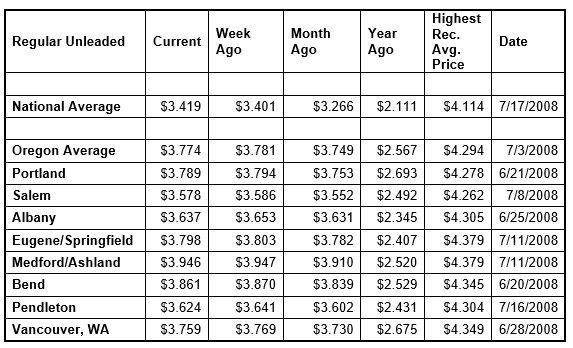
California has set record high prices for the third day in a row. Today’s average is $4.687. Monday’s average was $4.682 and Sunday’s was $4.676. California’s previous high price was $4.671 in October 2012. Severe rainstorms in Northern California have led to reduced production, creating supply issues.
Gas prices remain elevated for this time of year. The national average is at its highest price since September 2014. The Oregon average is a little lower than its year-to-date high of $3.80 reached on August 19. Demand for oil and gas has climbed back up to pre-pandemic levels but production lags behind.
“A small dip in gasoline demand in the U.S. may help spur some price relief at the pumps. However, the ongoing tight supply of crude oil and high crude prices above $80 per barrel will keep gas prices fluctuating instead of falling for at least the next few weeks,” says Marie Dodds, public affairs director for AAA Oregon/Idaho.
The high gas prices won’t keep people from traveling over Thanksgiving. AAA projects 53.4 million Americans including 746,000 Oregonians will travel for the Thanksgiving holiday, up 13% from 2020. About 90% will drive to their destinations. Find more info in the AAA Thanksgiving travel news release.
Total domestic gasoline stocks decreased by 1.6 million bbl to 212.7 million bbl last week according to the U.S. Energy Information Administration (EIA). Gasoline demand dropped from 9.5 million b/d to 9.26 million b/d. This drop coupled with an increase in the domestic crude oil supply caused downward pressure on prices. However, pump prices will likely remain elevated for consumers as long as oil prices are above $80 per barrel.
With Thanksgiving and the holidays fast approaching, travel continues to be impacted by the coronavirus pandemic. Visit AAA.com/covidmap for an interactive map with the latest travel restrictions and policies for North America. Find AAA’s latest COVID-19 information for travelers here.
Quick stats
Oregon is one of 18 states and the District of Columbia where prices are more expensive now than a week ago. Arizona (+8 cents) has the largest week-over-week gain. Illinois (-4 cents) has the largest weekly decrease in the country.
California ($4.69) and Hawaii ($4.35) continue to have the most expensive gas prices in the country and are the only states in the nation with averages above $4 a gallon. All other states and the District of Columbia have averages above $3 a gallon.
The cheapest gas in the nation is in Oklahoma ($3.01) and Texas ($3.05) and. For the 45th week in a row, no state has an average below $2 a gallon.
Oregon is one of 46 states and the District of Columbia with higher prices now than a month ago. The national average is 15 cents more and the Oregon average is 2 cents more than a month ago. This is the seventh-smallest monthly gain in the country. Arizona (+37 cents) has the largest month-over-month increase. Colorado (-4 cents) has the largest monthly decrease in the country.
All 50 states and the District of Columbia have higher prices now than a year ago, and all have a current average that’s a dollar or more higher than a year ago. The national average is $1.30 more and the Oregon average is $1.19 more than a year ago. This is the 42nd-largest yearly increase in the nation. California (+$1.51) has the biggest yearly increase. Delaware (+$1.08) has the smallest year-over-year increase.
West Coast
The West Coast region continues to have the most expensive pump prices in the nation with all seven states in the region in the top 10.
| Rank | Region | Price on 11/16/21 | ||
| 1 | California | $4.69 | ||
| 2 | Hawaii | $4.35 | ||
| 3 | Nevada | $3.98 | ||
| 4 | Washington | $3.87 | ||
| 5 | Oregon | $3.78 | ||
| 6 | Alaska | $3.71 | ||
| 7 | Utah | $3.71 | ||
| 8 | Arizona | $3.70 | ||
| 9 | Idaho | $3.69 | ||
| 10 | District of Columbia | $3.62 |
California is the most expensive state for the 43rd week in a row with Hawaii, Nevada, Washington, Oregon, and Alaska rounding out the top six. Arizona is eighth. Oregon is fifth for the sixth week in a row.
All seven states in the region have weekly increases. Arizona (+8 cents) has the largest weekly increase in the region and the country. Washington (+3/10ths of a cent) has the smallest weekly increase in the region.
The refinery utilization rate on the West Coast dropped from 81% to 791% for the week ending November 5. This is one of the lowest readings of the year. It has ranged from 85% to 88% much of the summer and fall after remaining between about 82% and 84% in the spring.
According to EIA’s latest weekly report, total gas stocks in the region edged lower from 28.59 million bbl to 28.12 million bbl. Stocks have been declining since mid-September. Decreasing stocks and a lower refinery utilization rate may put upward pressure on pump prices in the region in the next couple weeks.
Oil market dynamics
Crude oil prices declined a little last week as inflation fears weighed on the market. Additionally, prices also fell after EIA reported that the total domestic crude supply increased by 1 million bbl to 435.1 million bbl last week. However, according to EIA’s data, the total domestic crude supply is still down 11 percent compared to the previous year at this time, helping to keep elevated price pressure on crude. For this week, crude prices could decrease again if EIA’s next weekly report shows another crude inventory increase.
At the close of Friday’s formal trading session, WTI decreased by 80 cents to settle at $80.79. At the close of Monday’s formal trading session, WTI added nine cents to close at $80.88. Today crude is trading around $81, compared to $84 a week ago. Crude prices are about $41 more than a year ago.
Drivers can find current gas prices along their route with the free AAA Mobile app for iPhone, iPad and Android. The app can also be used to map a route, find discounts, book a hotel and access AAA roadside assistance. Learn more at AAA.com/mobile.
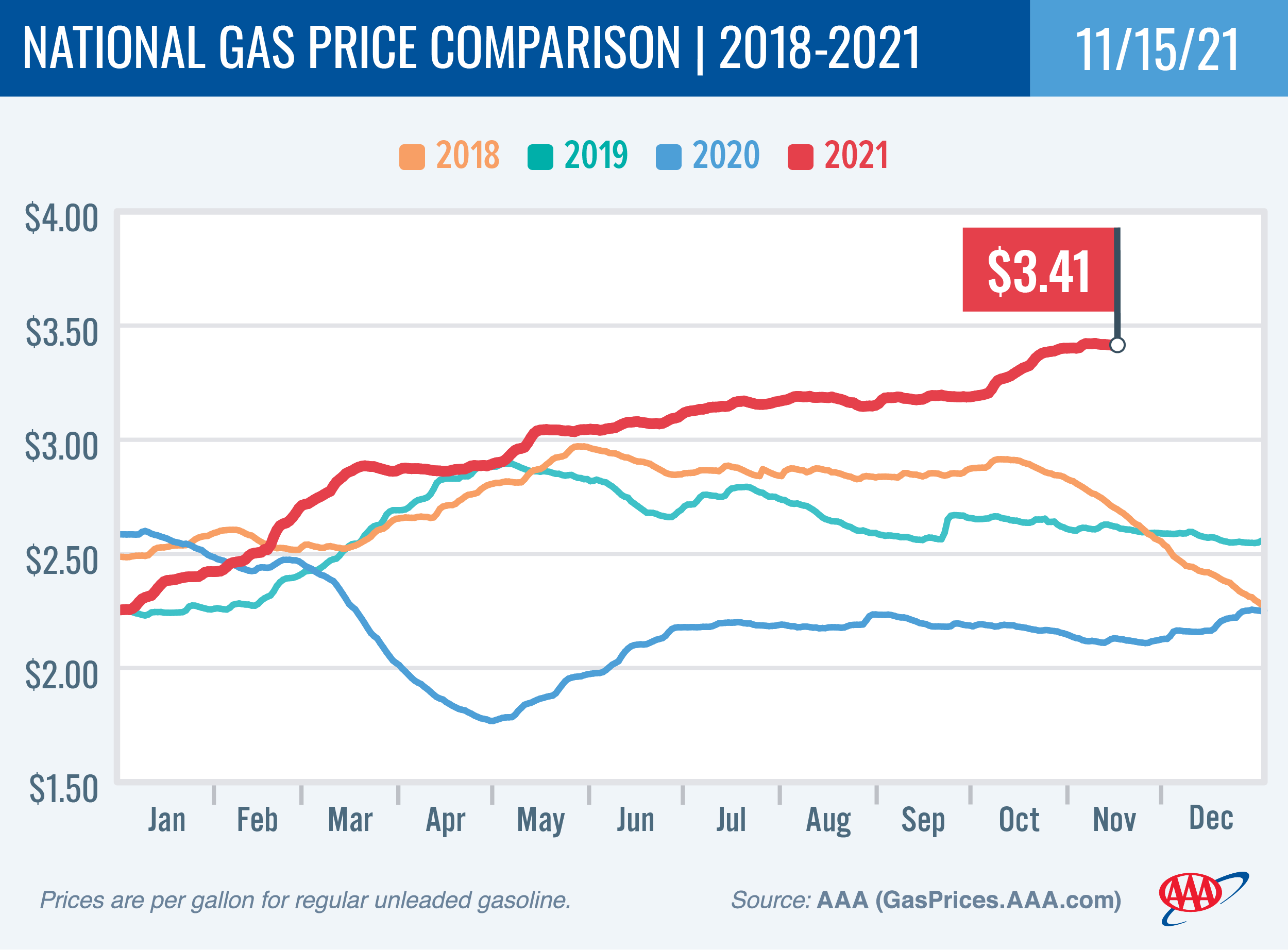
Diesel
For the week, the national average remains at $3.65 a gallon. Oregon’s average holds steady at $3.79. A year ago the national average for diesel was $2.39 and the Oregon average was $2.69.
Find current fuel prices at GasPrices.AAA.com.
AAA news releases, high resolution images, broadcast-quality video, fact sheets and podcasts are available on the AAA NewsRoom at NewsRoom.AAA.com.
Find local news releases at https://oregon.aaa.com/community/media/media-contacts.html
Fuel prices are updated daily at AAA’s Daily Fuel Gauge at AAA Gas Prices. For more info go www.AAA.com. AAA Oregon/Idaho provides more than 850,000 members with travel, insurance, financial and automotive-related services, and is an affiliate of AAA National, serving more than 62 million motorists in North America.
Updated 11/9/2021
Falling Back: Will Darker Evenings Lead to Reduced Demand for Gas?
PORTLAND, Ore., – Pump prices are fairly stable this week, with the averages in 45 states, including Oregon, changing by three cents or less. The national average has a small increase while the Oregon average has a slight decrease. For the week, the national average for regular gains two cents to $3.42 a gallon. The Oregon average slips a penny to $3.77.
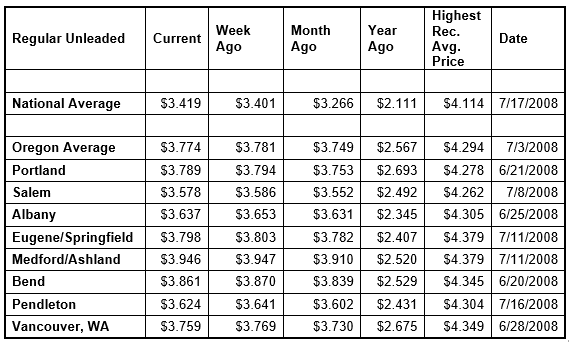
The national average is at its highest price since September 2014. The Oregon average is a little lower than its year-to-date high of $3.80 reached on August 19.
The latest decision by OPEC and its oil-producing allies to maintain their planned gradual increase in crude oil output will not help lessen supply constraints, so any relief will most likely have to come from the demand side.
“The switch to standard time and the resulting earlier sunset may lead to lower demand for gasoline. Drivers may head straight home after work instead of shopping or running errands in darkness,” says Marie Dodds, public affairs director for AAA Oregon/Idaho.
Total domestic gasoline stocks decreased by 1.5 million bbl to 214.2 million bbl last week according to the U.S. Energy Information Administration (EIA). However, gasoline demand rose from 9.32 million b/d to 9.5 million b/d. The slight increase in demand and elevated crude prices above $80 per barrel continue to put upward market pressure on pump prices.
Although COVID-19 cases in Oregon and the rest of the U.S. are decreasing, travel continues to be impacted by the pandemic. Visit AAA.com/covidmap for an interactive map with the latest travel restrictions and policies for North America. Find AAA’s latest COVID-19 information for travelers here.
Quick stats
Oregon is one of 23 states and the District of Columbia where prices are less expensive now than a week ago. Florida (-3 cents) has the largest week-over-week decline. Michigan (+16 cents) has the largest weekly increase in the country. The average in Nebraska is flat.
California ($4.63) and Hawaii ($4.34) continue to have the most expensive gas prices in the country and are the only states in the nation with averages above $4 a gallon. All other states and the District of Columbia have averages above $3 a gallon.
The cheapest gas in the nation is in Oklahoma ($3.04) and Arkansas ($3.07) and. For the 44th week in a row, no state has an average below $2 a gallon.
Oregon is one 47 states and the District of Columbia with higher prices now than a month ago. The national average is 15 cents more and the Oregon average is 2-and-a-half cents more than a month ago. This is the third-smallest monthly gain in the country. Alabama (+33 cents) has the largest month-over-month increase. Idaho (-3 cents) has the largest monthly decrease in the country. The average in Alaska is flat.
All 50 states and the District of Columbia have higher prices now than a year ago, and all have a current average that’s a dollar or more higher than a year ago. The national average is $1.31 more and the Oregon average is $1.21 more than a year ago. This is the 43rd-largest yearly increase in the nation. California (+$1.45) has the biggest yearly increase. Hawaii (+$1.10) has the smallest year-over-year increase.
West Coast
The West Coast region continues to have the most expensive pump prices in the nation with all seven states in the region in the top 10.
| Rank | Region | Price on 11/9/21 | ||
| 1 | California | $4.63 | ||
| 2 | Hawaii | $4.34 | ||
| 3 | Nevada | $3.96 | ||
| 4 | Washington | $3.87 | ||
| 5 | Oregon | $3.77 | ||
| 6 | Utah | $3.72 | ||
| 7 | Alaska | $3.71 | ||
| 8 | Idaho | $3.70 | ||
| 9 | Arizona | $3.62 | ||
| 10 | District of Columbia | $3.61 |
California is the most expensive state for the 42nd week in a row with Hawaii, Nevada, Washington, and Oregon rounding out the top five. Alaska is seventh. Arizona is ninth. Oregon is fifth for the fifth week in a row.
Three of the seven states in the region have weekly increases. Arizona (+9 cents) has the largest weekly increase in the region. Alaska (-2 cents) has the largest weekly decrease in the region.
The refinery utilization rate on the West Coast dropped from 87% to 81% for the week ending October 29. It has ranged from 85% to 88% much of the summer and fall after remaining between about 82% and 84% in the spring.
According to EIA’s latest weekly report, total gas stocks in the region edged lower from 28.66 million bbl to 28.59 million bbl.
Oil market dynamics
Although crude oil prices gained for the day on Friday due to a weakening dollar, crude prices mostly declined last week after EIA reported that total domestic crude supply increased by 3.3 million bbl to 434.1 million bbl last week. However, according to EIA’s data, the current storage level is approximately 10.4 percent lower than the same time the previous year. A tighter oil supply has helped to keep crude prices above $80 per barrel. This week, crude prices could decline again if EIA’s next weekly report shows another increase in total domestic supply.
At the close of Friday’s formal trading session, WTI increased by $2.46 to settle at $81.27. At the close of Monday’s formal trading session, WTI added 66 cents to close at $81.93. Today crude is trading around $84, same as a week ago. Crude prices are about $45 more than a year ago.
Drivers can find current gas prices along their route with the free AAA Mobile app for iPhone, iPad and Android. The app can also be used to map a route, find discounts, book a hotel and access AAA roadside assistance. Learn more at AAA.com/mobile.
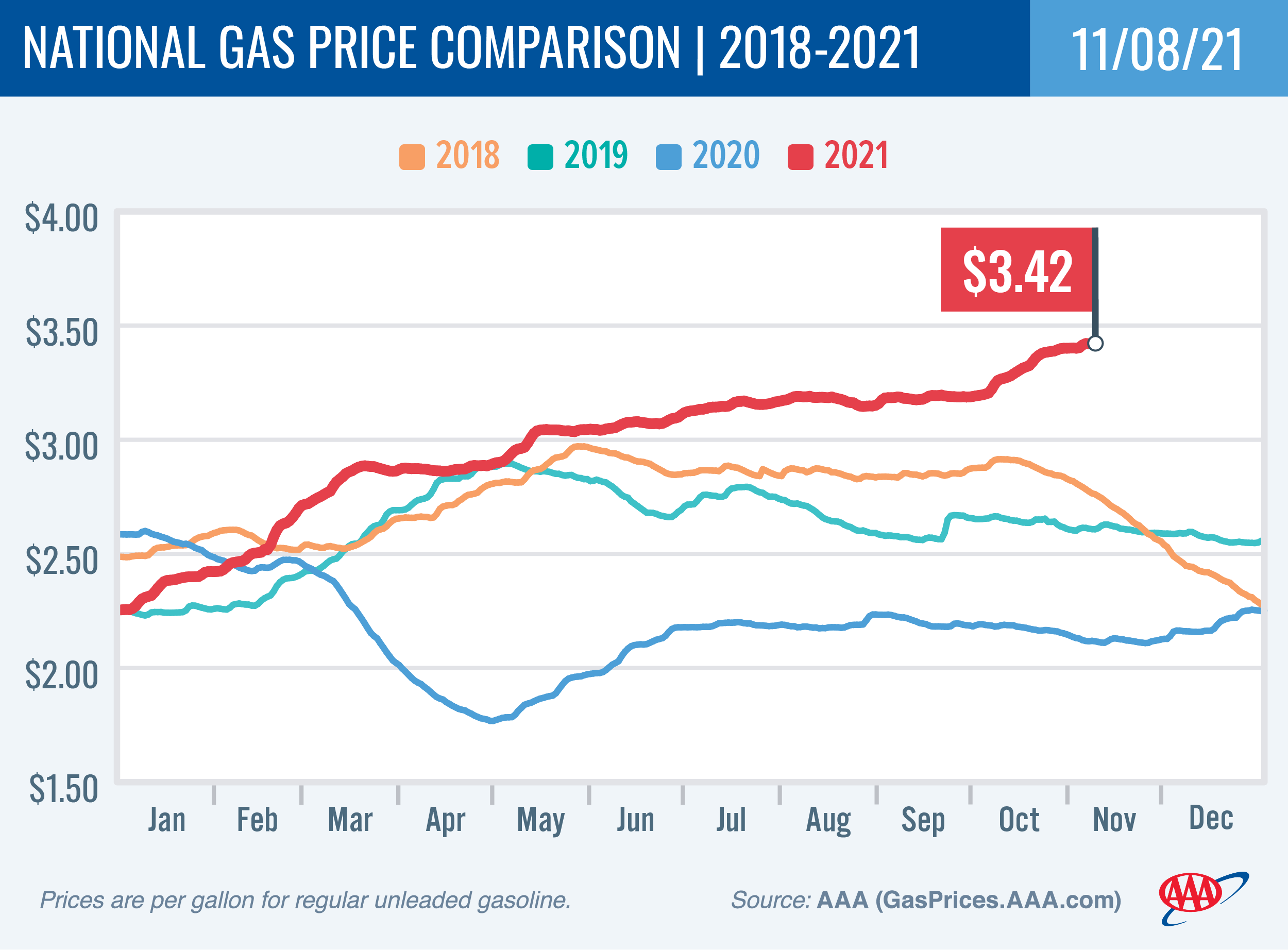
Diesel
For the week, the national average adds half a cent to $3.64 a gallon. Oregon’s average ticks up half a cent to $3.79. A year ago the national average for diesel was $2.36 and the Oregon average was $2.59.
Find current fuel prices at GasPrices.AAA.com.
AAA news releases, high resolution images, broadcast-quality video, fact sheets and podcasts are available on the AAA NewsRoom at NewsRoom.AAA.com.
Find local news releases at https://oregon.aaa.com/community/media/media-contacts.html
Fuel prices are updated daily at AAA’s Daily Fuel Gauge at AAA Gas Prices. For more info go www.AAA.com. AAA Oregon/Idaho provides more than 850,000 members with travel, insurance, financial and automotive-related services, and is an affiliate of AAA National, serving more than 62 million motorists in North America.
Updated 11/2/2021
Pump Price Increases Tap the Brakes
PORTLAND, Ore., – Gas Prices are holding steady in Oregon while the national average has its smallest weekly increase in a month. While crude oil remains above $80 per barrel, a dip in U.S. demand for gas is helping to slow pump price increases for now. For the week, the national average for regular edges up a penny to $3.40 a gallon. The Oregon average remains at $3.78.
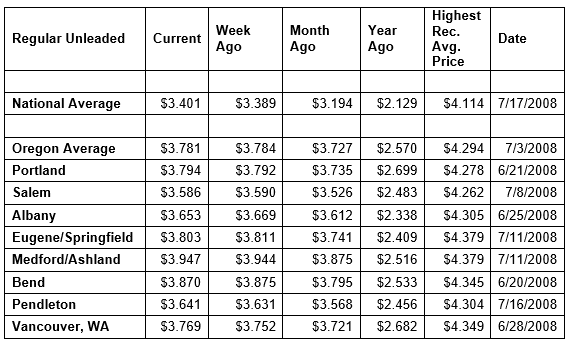
News that Iranian oil, which has not been sold globally in large quantities since 2018, may return to the world market coupled with an OPEC+ meeting on November 4 via videoconference, are increasing market volatility. The cartel is expected to maintain reduced output of oil which is keeping crude oil prices elevated at their highest prices in seven years. U.S. crude oil has remained above $80/bbl since Oct. 11. Crude started the year at about $48/bbl.
“The cost of oil accounts for 50% to 60% of the pump price, which is why gas prices have been climbing this fall, a time of year when pump prices normally decline,” says Marie Dodds, public affairs director for AAA Oregon/Idaho.
U.S. gasoline demand is down from 9.63 million b/d to 9.32 million b/d, while stocks have declined by 2 million bbl to 215.7 million bbl last week. Global oil production is still below pre-pandemic levels, which is driving the highest crude oil prices in seven years.
“The drop in demand has helped slow pump price increases, but elevated crude prices above $80 per barrel continue to put upward pressure on pump prices, which is why drivers haven’t seen relief at the pumps this fall,” adds Dodds.
Although the summer surge of COVID-19 cases in Oregon and the rest of the U.S. is waning, travel continues to be impacted by the pandemic. Visit AAA.com/covidmap for an interactive map with the latest travel restrictions and policies for North America. Find AAA’s latest COVID-19 information for travelers here.
Quick stats
Oregon is one of 46 states and the District of Columbia where prices have changed by a nickel or less in the last week. West Virginia (+7 cents) has the largest weekly increase in the country. Ohio (-3 cents) has the largest week-over-week decline.
California ($4.61) and Hawaii ($4.32) continue to have the most expensive gas prices in the country and are the only states in the nation with averages above $4 a gallon. All other states and the District of Columbia have averages above $3 a gallon.
The cheapest gas in the nation is in Oklahoma ($3.01) and Texas ($3.05) and. For the 43rd week in a row, no state has an average below $2 a gallon.
Oregon is one 47 states and the District of Columbia with higher prices now than a month ago. The national average is 21 cents more and the Oregon average is 5 cents more than a month ago. This is the fourth-smallest monthly gain in the country. Alabama (+33 cents) has the largest month-over-month increase. Idaho (-3 cents) has the largest monthly decrease in the country.
All 50 states and the District of Columbia have higher prices now than a year ago, and all have a current average that’s a dollar or more higher than a year ago. The national average is $1.27 more and the Oregon average is $1.21 more than a year ago. This is the 38th-largest yearly increase in the nation. California (+$1.43) has the biggest yearly increase. Hawaii (+$1.08) has the smallest year-over-year increase.
West Coast
The West Coast region continues to have the most expensive pump prices in the nation with every state in the region except Arizona in the top 10.
| Rank | Region | Price on 11/2/21 | ||
| 1 | California | $4.61 | ||
| 2 | Hawaii | $4.32 | ||
| 3 | Nevada | $3.95 | ||
| 4 | Washington | $3.88 | ||
| 5 | Oregon | $3.78 | ||
| 6 | Utah | $3.74 | ||
| 7 | Alaska | $3.73 | ||
| 8 | Idaho | $3.70 | ||
| 9 | District of Columbia | $3.61 | ||
| 10 | Pennsylvania | $3.57 |
California is the most expensive state for the 41st week in a row with Hawaii, Nevada, Washington, and Oregon rounding out the top five. Alaska is seventh. Arizona is 13th. Oregon is fifth for the fourth week in a row.
Five of the seven states in the region have weekly increases. Arizona (+7 cents) has the largest weekly increase in the region. Oregon (-3/10ths of a cent) and Washington (-2/10ths of a cent) have tiny weekly decreases.
The refinery utilization rate on the West Coast held steady around 87% for the week ending October 22. It has ranged from 85% to 88% much of the summer and fall after remaining between about 82% and 84% in the spring.
According to EIA’s latest weekly report, total gas stocks in the region ticked down from 28.88 million bbl to 28.66 million bbl.
Oil market dynamics
Crude prices gained on Friday and Monday due to market expectations that the Organization of the Petroleum Exporting Countries, Russia and their allies, known as OPEC+, will maintain production cuts during their meeting scheduled for this Thursday. However, crude prices took a slight step back on the week after EIA reported that total domestic crude supply increased by 4.3 million bbl to 430.8 million bbl. If EIA’s next report shows another inventory increase, crude prices could decline this week.
At the close of Friday’s formal trading session, WTI increased by 76 cents to settle at $83.57. At the close of Monday’s formal trading session, WTI added 48 cents to close at $84.05. Today crude is trading around $83, compared to $84 a week ago. Crude prices are about $48 more than a year ago.
Drivers can find current gas prices along their route with the free AAA Mobile app for iPhone, iPad and Android. The app can also be used to map a route, find discounts, book a hotel and access AAA roadside assistance. Learn more at AAA.com/mobile.
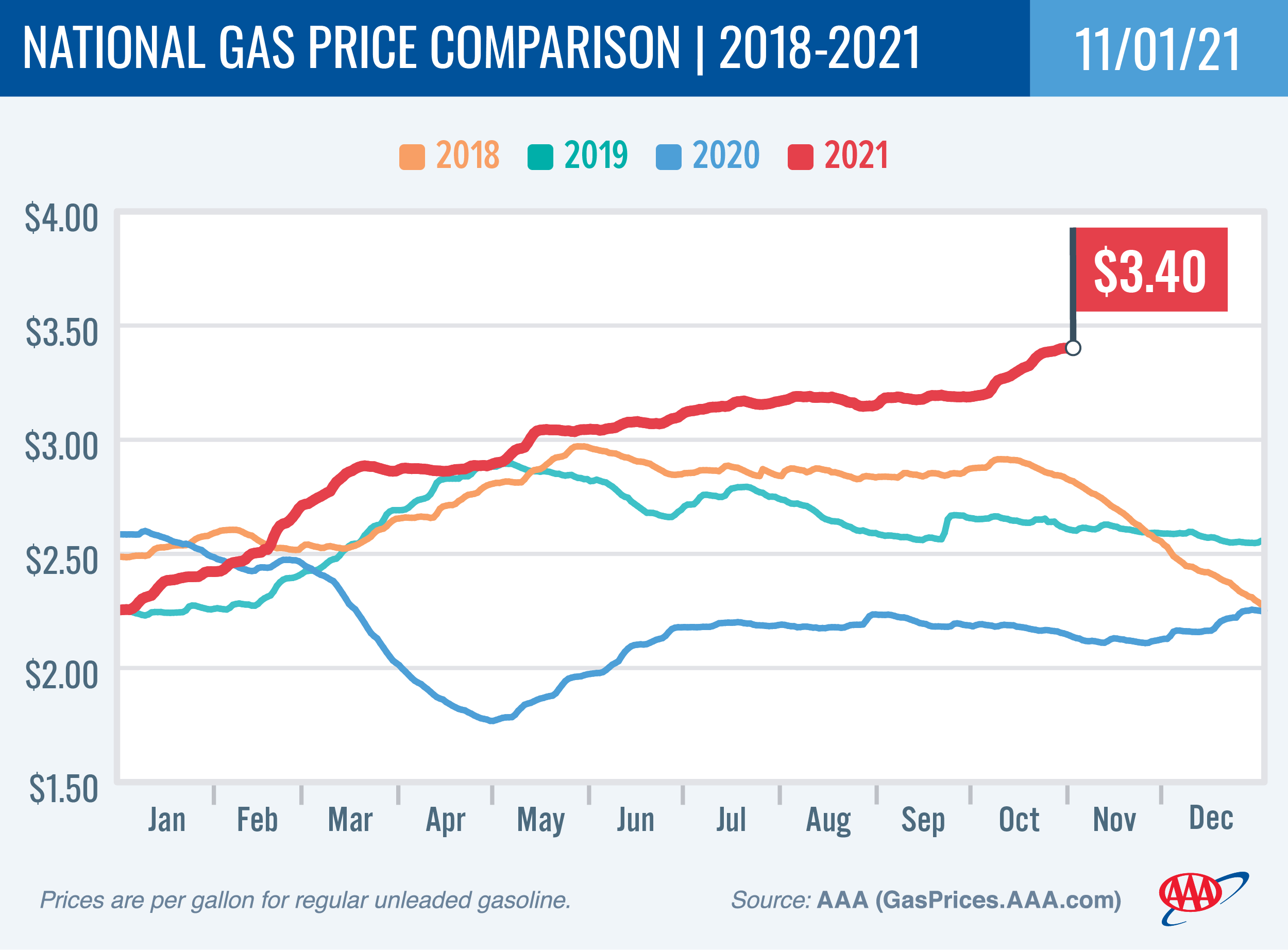
Diesel
For the week, the national average adds two cents to $3.64 a gallon. Oregon’s average ticks up half a cent to $3.78. A year ago the national average for diesel was $2.36 and the Oregon average was $2.57.
Find current fuel prices at GasPrices.AAA.com.
AAA news releases, high resolution images, broadcast-quality video, fact sheets and podcasts are available on the AAA NewsRoom at NewsRoom.AAA.com.
Find local news releases at https://oregon.aaa.com/community/media/media-contacts.html
Fuel prices are updated daily at AAA’s Daily Fuel Gauge at AAA Gas Prices. For more info go www.AAA.com. AAA Oregon/Idaho provides more than 850,000 members with travel, insurance, financial and automotive-related services, and is an affiliate of AAA National, serving more than 62 million motorists in North America.
Updated 10/26/2021
Ghastly Gas Prices Haunt Drivers at the Pumps
Prices climbing more slowly in Oregon compared to National Average
PORTLAND, Ore., – Rising gas prices are spooky this Halloween but they’re not scaring people away from driving as demand continues to climb. Pump prices have increased almost every day this month—a time of year that prices normally fall. For the week, the national average for regular jumps a nickel to $3.39 a gallon. The Oregon average ticks up a penny to $3.78.
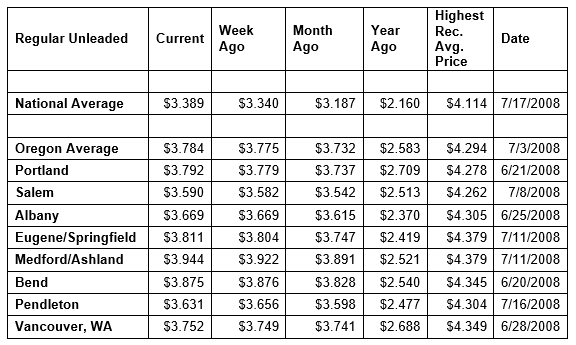
The national average is at its highest price since September 2014. The Oregon average is a little lower than its year-to-date high of $3.80 reached on August 19.
“With the U.S. economy slowly recovering from the depths of the pandemic, demand for gas is robust, but the supply is tight. In addition, crude oil prices have surged. This means drivers won’t see lower pump prices in the near future,” says Marie Dodds, public affairs director for AAA Oregon/Idaho.
U.S. gasoline demand is up from 9.19 million b/d to 9.63 million b/d, while stocks have declined by 5.4 million bbl to 217.7 million bbl last week. Global oil production is still below pre-pandemic levels, which is driving the highest crude oil prices in seven years. U.S. crude oil has remained above $80/bbl since Oct. 11. Crude started the year at about $48/bbl. Since the cost of oil accounts for 50% to 60% of the pump price, consumers will be paying more as long as crude prices remain high.
Although the summer surge of COVID-19 cases in Oregon and the rest of the U.S. is waning, travel continues to be impacted by the pandemic. Visit AAA.com/covidmap for an interactive map with the latest travel restrictions and policies for North America. Find AAA’s latest COVID-19 information for travelers here.
Quick stats
Oregon is one of 44 states and the District of Columbia with higher prices now than a week ago. Oregon has the fourth-smallest weekly gain in the nation. North Carolina (+12 cents) has the largest weekly increase in the country. Ohio (-4 cents) has the largest week-over-week decline.
California ($4.55) and Hawaii ($4.28) continue to have the most expensive gas prices in the country and are the only states in the nation with averages above $4 a gallon. All other states and the District of Columbia have averages above $3 a gallon.
The cheapest gas in the nation is in Oklahoma ($3.01) and Texas ($3.04) and. For the 42nd week in a row, no state has an average below $2 a gallon.
Oregon is one 46 states and the District of Columbia with higher prices now than a month ago. The national average is 20 cents more and the Oregon average is 5 cents more than a month ago. This is the fifth-smallest monthly gain in the country. Alabama (+33 cents) has the largest month-over-month increase. Utah (-4 cents) has the largest monthly decrease in the country.
All 50 states and the District of Columbia have higher prices now than a year ago, and all have a current average that’s a dollar or more higher than a year ago. The national average is $1.23 more and the Oregon average is $1.20 more than a year ago. This is the 32nd-largest yearly increase in the nation. Idaho (+$1.37) has the biggest yearly increase. Hawaii (+$1.04) has the smallest year-over-year increase.
West Coast
The West Coast region continues to have the most expensive pump prices in the nation with every state in the region except Arizona in the top 10.
| Rank | Region | Price on 10/26/21 | ||
| 1 | California | $4.55 | ||
| 2 | Hawaii | $4.28 | ||
| 3 | Nevada | $3.93 | ||
| 4 | Washington | $3.88 | ||
| 5 | Oregon | $3.78 | ||
| 6 | Alaska | $3.72 | ||
| 7 | Idaho | $3.71 | ||
| 8 | Utah | $3.70 | ||
| 9 | District of Columbia | $3.58 | ||
| 10 | Pennsylvania | $3.57 |
California is the most expensive state for the 40th week in a row with Hawaii, Nevada, Washington, Oregon, and Alaska rounding out the top six. Arizona is 16th. Oregon is fifth for the third week in a row.
Six of the seven states in the region have weekly increases. Arizona (+12 cents) has the largest weekly increase in the region. Alaska (-1/10th of a cent) has a tiny weekly decrease.
The refinery utilization rate on the West Coast held steady around 87% for the week ending October 15. It has ranged from 85% and 88% much of the summer after remaining between about 82% and 84% in the spring.
According to EIA’s latest weekly report, total gas stocks in the region declined from 29.55 million bbl to 28.88 million bbl.
Oil market dynamics
Crude prices took a slight step back last week due to weakness in the U.S. equity markets; however, prices increased overall after EIA’s weekly report revealed that total domestic crude inventories decreased slightly to 426.5 million bbl. The current storage level is approximately 13 percent lower than the level at this same time last year. Given supply concerns, the market could continue to push prices higher this week if EIA’s next report shows further tightening.
At the close of Friday’s formal trading session, WTI increased by $1.26 to settle at $83.76. At the close of Monday’s formal trading session, WTI remained at $83.76. Today crude is trading around $85, up from $83 a week ago. Crude prices are about $42 more than a year ago.
Drivers can find current gas prices along their route with the free AAA Mobile app for iPhone, iPad and Android. The app can also be used to map a route, find discounts, book a hotel and access AAA roadside assistance. Learn more at AAA.com/mobile.
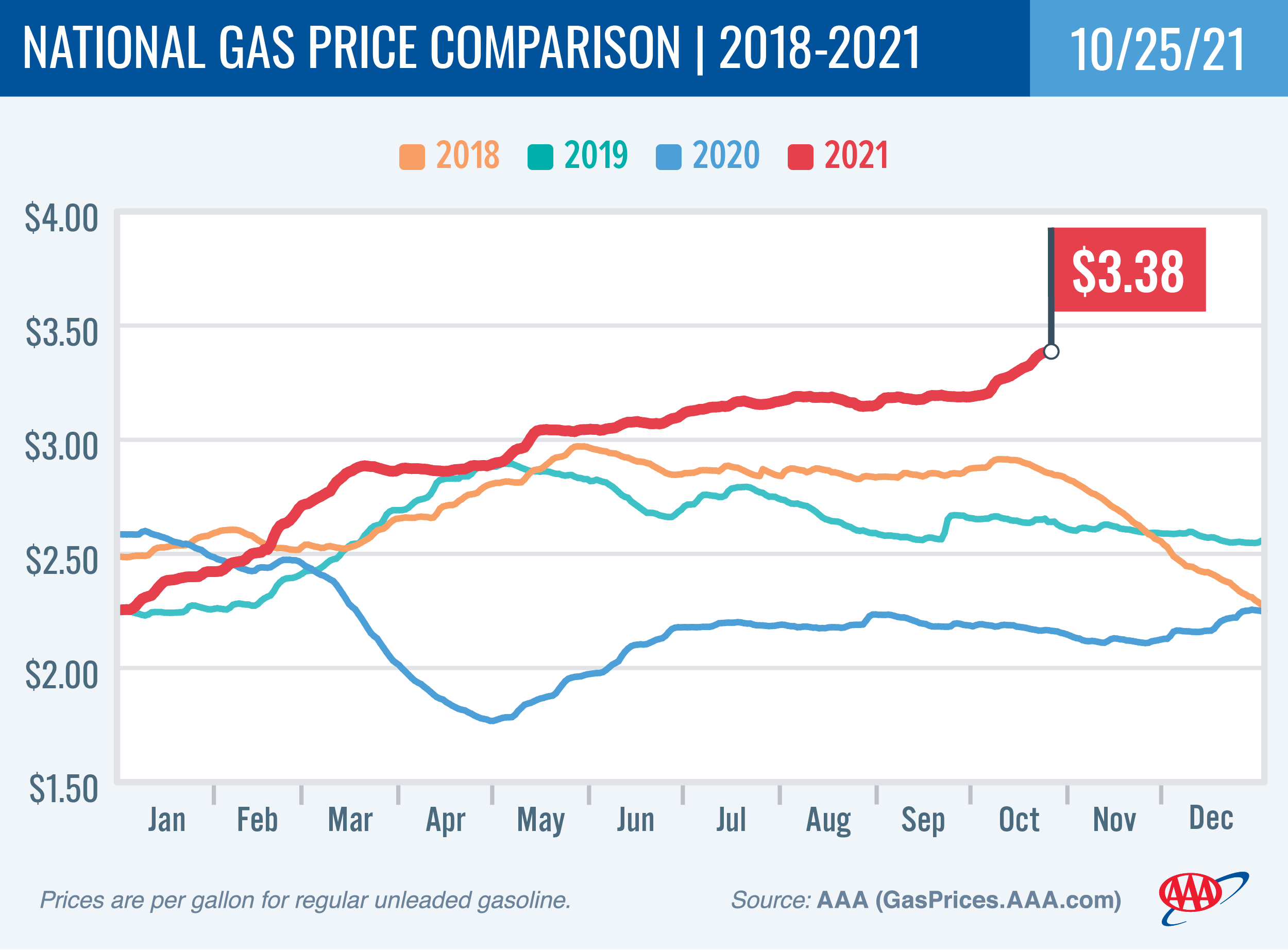
Diesel
For the week, the national average jumps a nickel to $3.61 a gallon. Oregon’s average adds three cents to $3.78. A year ago the national average for diesel was $2.37 and the Oregon average was $2.57.
Find current fuel prices at GasPrices.AAA.com.
AAA news releases, high resolution images, broadcast-quality video, fact sheets and podcasts are available on the AAA NewsRoom at NewsRoom.AAA.com.
Find local news releases at https://oregon.aaa.com/community/media/media-contacts.html
Fuel prices are updated daily at AAA’s Daily Fuel Gauge at AAA Gas Prices. For more info go www.AAA.com. AAA Oregon/Idaho provides more than 850,000 members with travel, insurance, financial and automotive-related services, and is an affiliate of AAA National, serving more than 62 million motorists in North America.
Updated 10/19/2021
Skyrocketing Crude Prices Push Pump Prices Higher
Oregon sees smaller gain than national average
PORTLAND, Ore., – The highest crude oil prices in seven years are driving increases in pump prices. U.S. crude oil climbed to more than $82 per barrel this week. Demand for gasoline has eased which should result in cheaper gas prices, but the higher crude prices are causing pump prices to rise. For the week, the national average for regular jumps six cents to $3.34 a gallon. The Oregon average adds two cents to $3.78.
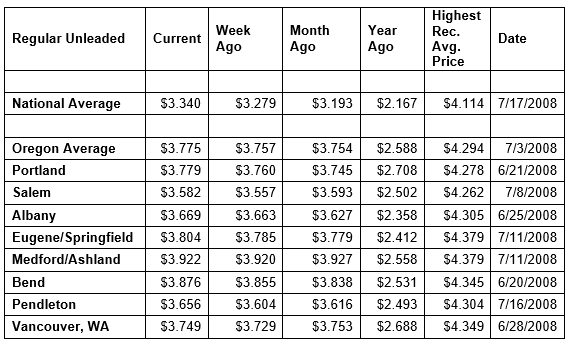
The national average is at its highest price since September 2014. The Oregon average is a little lower than its year-to-date high of $3.80 reached on August 19.
“Unfortunately, drivers won’t get relief at the pumps anytime soon due to the surging crude oil prices, as the cost of crude accounts for more than half of the price of each gallon of gas,” says Marie Dodds, public affairs director for AAA Oregon/Idaho.
Crude prices started 2021 at about $48/bbl and climbed above $80/bbl last week. Growing demand for oil as the world recovers from the COVID-19 pandemic is fueling the gains, as is the potential for a cold winter in the northern hemisphere which could worsen tight oil supplies.
Demand for gasoline in the U.S. fell from 9.43 million b/d to 9.19 million b/d, but is still some 610,000 b/d above last year, according to the latest data from the U.S. Energy Information Administration (EIA). Total domestic gasoline supply fell by 2 million bbl to 223.1 million bbl.
Although the summer surge of COVID-19 cases in Oregon and the rest of the U.S. is waning, travel continues to be impacted by the pandemic. Visit AAA.com/covidmap for an interactive map with the latest travel restrictions and policies for North America. Find AAA’s latest COVID-19 information for travelers here.
Quick stats
Oregon is one of 45 states and the District of Columbia with higher prices now than a week ago. Oregon has the sixth-smallest weekly gain in the nation. Connecticut (+13 cents) has the largest weekly increase in the country. Michigan (-2 cents) has the largest week-over-week decline.
California ($4.51) and Hawaii ($4.21) continue to have the most expensive gas prices in the country and are the only states in the nation with averages above $4 a gallon, and 45 states and the District of Columbia are at or above $3, up from 44 states and D.C. a week ago.
The cheapest gas in the nation is in Texas ($2.97) and Oklahoma ($2.99). For the 41st week in a row, no state has an average below $2 a gallon.
Oregon is one 44 states and the District of Columbia with higher prices now than a month ago. The national average is 15 cents more and the Oregon average is 1.5 cents more than a month ago. This is the smallest monthly gain in the country. The District of Columbia (+25 cents) has the largest month-over-month increase. Utah (-7 cents) has the largest monthly decrease in the country.
All 50 states and the District of Columbia have higher prices now than a year ago, and 47 states including Oregon and the District of Columbia have a current average that’s a dollar or more higher than a year ago. The national average is $1.17 more and the Oregon average is $1.19 more than a year ago. This is the 22nd-largest yearly increase in the nation. Idaho (+$1.36) has the biggest yearly increase. Delaware (+96 cents) has the smallest year-over-year increase.
West Coast
The West Coast region continues to have the most expensive pump prices in the nation with every state in the region except Arizona in the top 10.
| Rank | Region | Price on 10/19/21 | ||
| 1 | California | $4.51 | ||
| 2 | Hawaii | $4.21 | ||
| 3 | Nevada | $3.89 | ||
| 4 | Washington | $3.87 | ||
| 5 | Oregon | $3.78 | ||
| 6 | Alaska | $3.72 | ||
| 7 | Idaho | $3.72 | ||
| 8 | Utah | $3.70 | ||
| 9 | District of Columbia | $3.55 | ||
| 10 | Colorado | $3.52 |
California is the most expensive state for the 39th week in a row with Hawaii, Nevada, Washington, Oregon, and Alaska rounding out the top six. Arizona is 18th. Oregon is fifth for the second week in a row.
All seven states in the West Coast region are among the 36 states in the country that have averages above $3 a gallon.
All seven states in the region have weekly increases. Hawaii (+8 cents) has the largest weekly increase in the region. Washington (+1 cent) has the smallest..
The refinery utilization rate on the West Coast region rose from 86% to 87% for the week ending October 8. It has ranged from 85% and 88% much of the summer after remaining between about 82% and 84% in the spring.
According to EIA’s latest weekly report, total gas stocks in the region declined slightly from 30.21 million bbl to 29.55 million bbl.
Oil market dynamics
Crude oil prices increased last week despite the EIA reporting that total domestic crude inventories increased by 6.1 million bbl to 427 million bbl last week. The current storage level is nearly 13 percent lower than the level at this same time last year. Given supply concerns, the market continues to bolster prices higher because of tight supply. Prices could climb further this week if EIA’s next report shows a decline in stocks.
At the close of Friday’s formal trading session, WTI increased by 97 cents to settle at $82.28. At the close of Monday’s formal trading session, WTI rose 16 cents to settle at $82.44. Today crude is trading around $83, up from $80 a week ago. Crude prices are about $42 more than a year ago.
Drivers can find current gas prices along their route with the free AAA Mobile app for iPhone, iPad and Android. The app can also be used to map a route, find discounts, book a hotel and access AAA roadside assistance. Learn more at AAA.com/mobile.
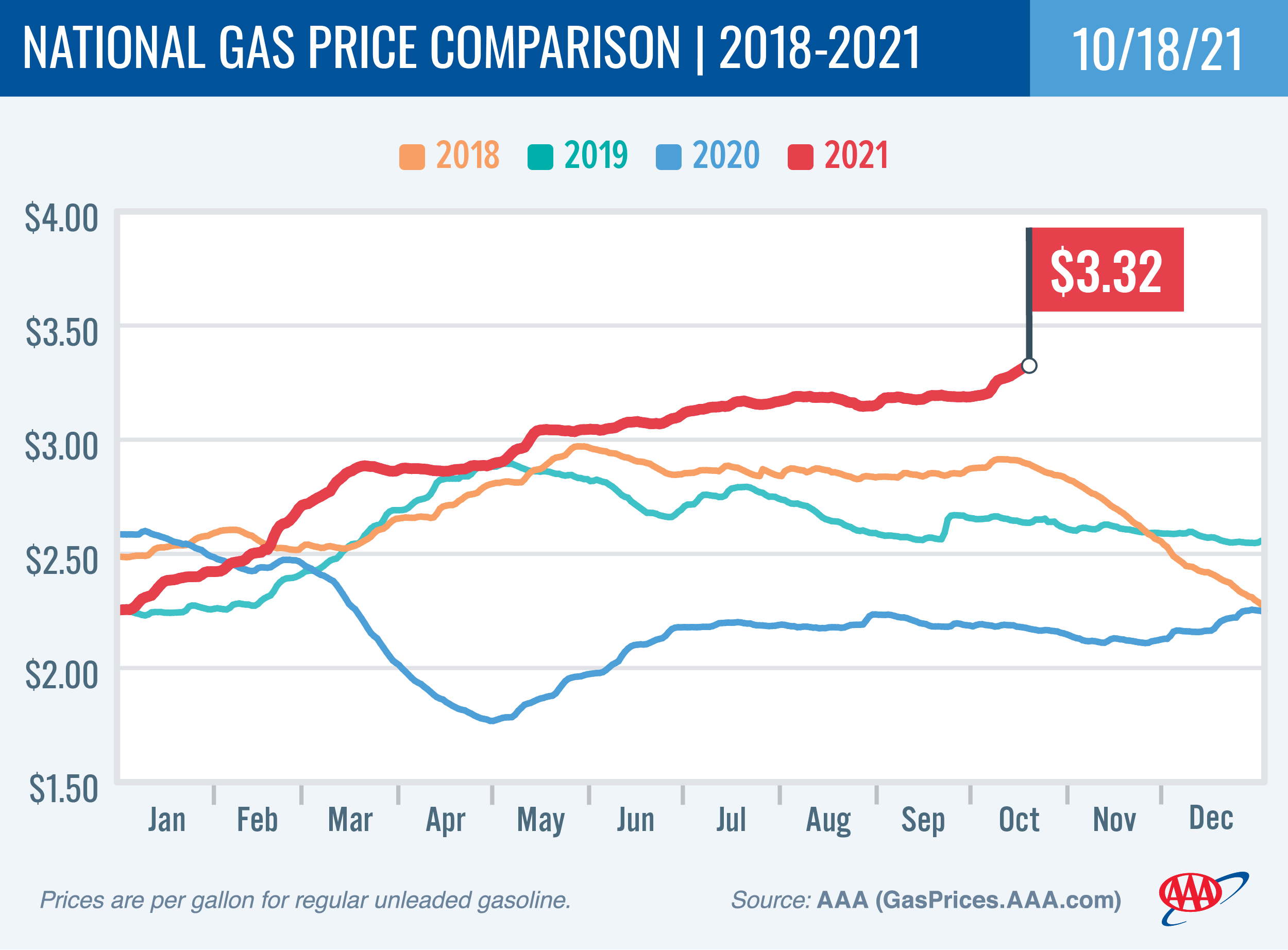
Diesel
For the week, the national average jumps eight cents to $3.56 a gallon. Oregon’s average adds three cents to $3.75. A year ago the national average for diesel was $2.38 and the Oregon average was $2.57.
Find current fuel prices at GasPrices.AAA.com.
AAA news releases, high resolution images, broadcast-quality video, fact sheets and podcasts are available on the AAA NewsRoom at NewsRoom.AAA.com.
Find local news releases at https://oregon.aaa.com/community/media/media-contacts.html
Fuel prices are updated daily at AAA’s Daily Fuel Gauge at AAA Gas Prices. For more info go www.AAA.com. AAA Oregon/Idaho provides more than 850,000 members with travel, insurance, financial and automotive-related services, and is an affiliate of AAA National, serving more than 62 million motorists in North America.
Updated 10/12/2021
National Average Surges to Highest Price in Seven Years
Oregon Average is still less than year-to-date high
The national average is at its highest price since October 2014. The Oregon average is a little lower than its year-to-date high of $3.80 reached on August 19.

“Skyrocketing crude prices are the major driver for the continued rise in gas prices this fall. Crude oil prices typically account for between 50% and 60% of the price at the pump,” says Marie Dodds, public affairs director for AAA Oregon/Idaho.
Crude prices are about twice as expensive as last October and are up about $30/bbl since the start of the year. Investors are concerned about a potential supply shortage in the coming years as the world emerges from the coronavirus pandemic.
Last week’s decision by OPEC and its oil-producing allies to not increase production further only exacerbated the upward momentum for crude oil prices. They climbed quickly following OPEC+, which comprises the Organization of the Petroleum Exporting Countries (OPEC), Russia, and their allies, choosing not to move forward with an agreement to produce 800,000 b/d in November. Instead, OPEC+ decided to maintain a previously agreed upon 400,000 b/d production increase.
Demand for gasoline in the U.S. rose from 9.40 million b/d to 9.44 million b/d—the slight increase in gas demand helped push gas prices higher. Total domestic gasoline stocks increased by 3.3 million bbl to 225.1 million bbl last week, according to the latest data from the U.S. Energy Information Administration (EIA)
Although the summer surge of COVID-19 cases in the U.S. is waning, travel will likely continue to be impacted this fall. Visit AAA.com/covidmap for an interactive map with the latest travel restrictions and policies for North America. Find AAA’s latest COVID-19 information for travelers here.
Quick stats
Oregon is one of 46 states where prices are higher this week. Oregon has the sixth-smallest weekly gain in the nation. The District of Columbia (+15 cents) has the largest weekly increase in the country. Idaho (-1 cent) has the largest week-over-week decline.
California ($4.44) and Hawaii ($4.13) continue to have the most expensive gas prices in the country and are the only states in the nation with averages above $4 a gallon, and 44 states and the District of Columbia are at or above $3, up from 38 states and D.C. a week ago.
The cheapest gas in the nation is in Mississippi ($2.92) and Texas ($2.92). For the 40th week in a row, no state has an average below $2 a gallon.
Oregon is one of only seven states with lower prices now than a month ago. The national average is 10 cents more and the Oregon average is one cent less than a month ago. Nevada (-10 cents) has the largest monthly decrease in the country. The District of Columbia (+24 cents) has the largest month-over-month increase.
All 50 states and the District of Columbia have higher prices now than a year ago, and 44 states including Oregon and the District of Columbia have a current average that’s a dollar or more higher than a year ago. The national average is $1.09 more and the Oregon average is $1.15 more than a year ago. This is the 11th-largest yearly increase in the nation. Idaho (+$1.35) has the biggest yearly increase. Delaware (+88 cents) has the smallest year-over-year increase.
West Coast
The West Coast region continues to have the most expensive pump prices in the nation with every state in the region except Arizona in the top 10.
| Rank | Region | Price on 10/12/21 | ||
| 1 | California | $4.44 | ||
| 2 | Hawaii | $4.13 | ||
| 3 | Nevada | $3.88 | ||
| 4 | Washington | $3.86 | ||
| 5 | Oregon | $3.76 | ||
| 6 | Idaho | $3.72 | ||
| 7 | Utah | $3.71 | ||
| 8 | Alaska | $3.70 | ||
| 9 | Colorado | $3.53 | ||
| 10 | Wyoming | $3.52 |
California is the most expensive state for the 38th week in a row with Hawaii, Nevada, Washington and Oregon rounding out the top five. Alaska is eighth and Arizona is 18th. Oregon rises to fifth after a week at sixth.
All seven states in the West Coast region are among the 36 states in the country that have averages above $3 a gallon.
Arizona (+8 cents) has the largest weekly increase in the region. Nevada (-1 cent) has the largest weekly decrease in the region.
The refinery utilization rate on the West Coast region rose from 84% to 86% for the week ending October 1. It has ranged from 85% and 88% much of the summer after remaining between about 82% and 84% in the spring.
According to EIA’s latest weekly report, total gas stocks in the region declined slightly to 30.21 million bbl from 32.28 million bbl.
Oil market dynamics
Crude oil prices increased last week due to the actions of OPEC+ last week and also after the U.S. Department of Energy dispelled speculation that the Biden Administration would ban crude exports or sell crude oil held in the U.S. Strategic Petroleum Reserve. The sale could have put more crude into the domestic market, but it is unlikely to have had a sustained downward impact on oil prices. Prices have increased last week despite EIA’s latest report showing that total domestic crude inventories increased by 2.4 million bbl to 420.9 million bbl last week. For this week, crude prices could continue to climb if supply tightens.
At the close of Friday’s formal trading session, WTI increased by $1.05 to settle at $79.35. At the close of Monday’s formal trading session, WTI rose $1.17 to settle at $80.52. Today crude is trading around $80, up from $79 a week ago. Crude prices are about $40 more than a year ago.
Drivers can find current gas prices along their route with the free AAA Mobile app for iPhone, iPad and Android. The app can also be used to map a route, find discounts, book a hotel and access AAA roadside assistance. Learn more at AAA.com/mobile.
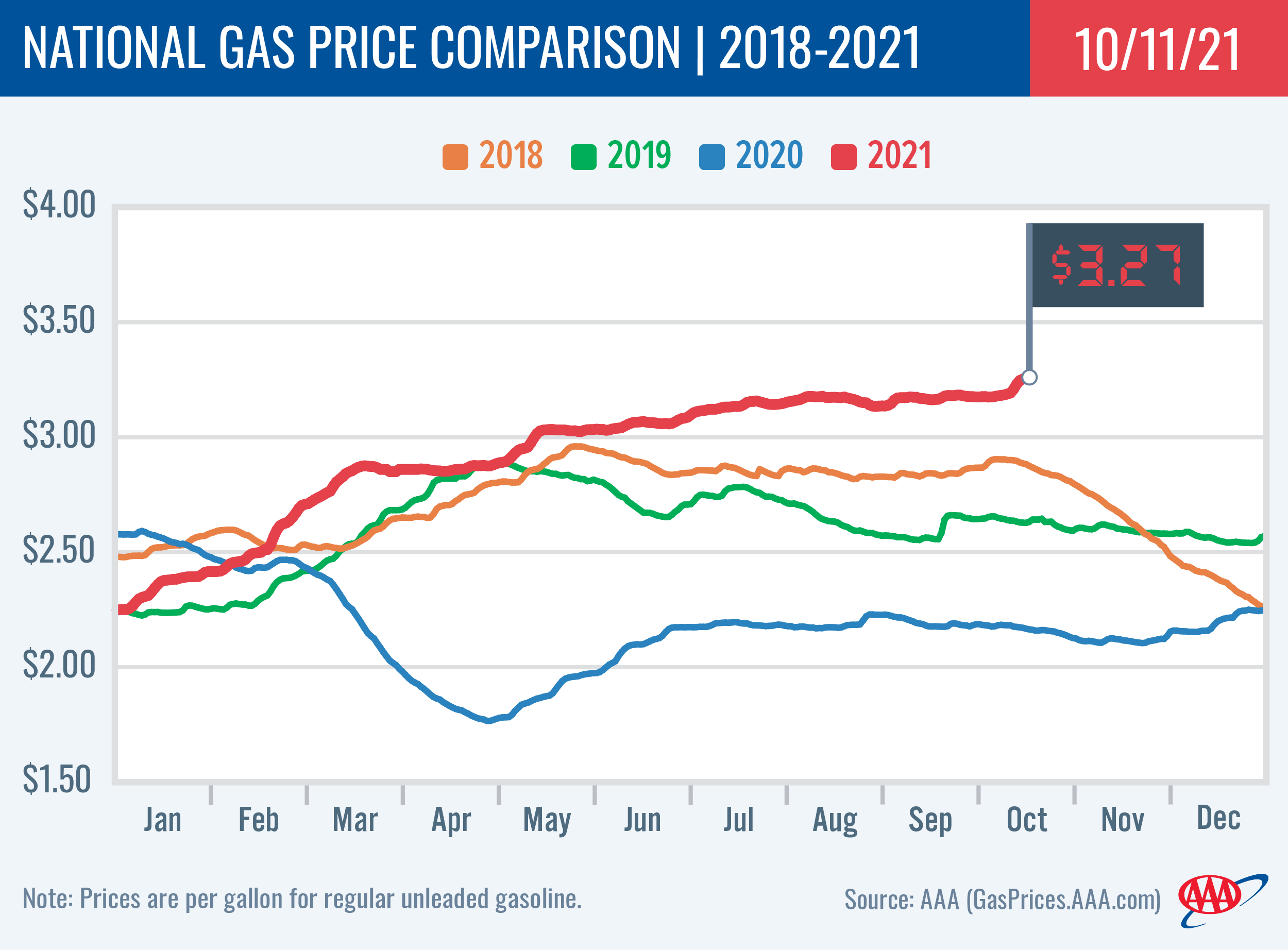
Diesel
For the week, the national average surges 12 cents to $3.48 a gallon. Oregon’s average adds three cents to $3.72. A year ago the national average for diesel was $2.38 and the Oregon average was $2.58.
Find current fuel prices at GasPrices.AAA.com.
AAA news releases, high resolution images, broadcast-quality video, fact sheets and podcasts are available on the AAA NewsRoom at NewsRoom.AAA.com.
Find local news releases at https://oregon.aaa.com/community/media/media-contacts.html
Fuel prices are updated daily at AAA’s Daily Fuel Gauge at AAA Gas Prices. For more info go www.AAA.com. AAA Oregon/Idaho provides more than 850,000 members with travel, insurance, financial and automotive-related services, and is an affiliate of AAA National, serving more than 62 million motorists in North America.
Updated 10/5/2021
High Crude Prices, Uptick in Demand keep Pump Prices High
PORTLAND, Ore., – Pump prices are remaining stubbornly high instead of falling as is usually the case during the autumn. A slight uptick in demand and high crude prices are the major factors. For the week, the national average for regular ticks up one-and-a-half cents to $3.20 a gallon. The Oregon average holds steady at $3.73.
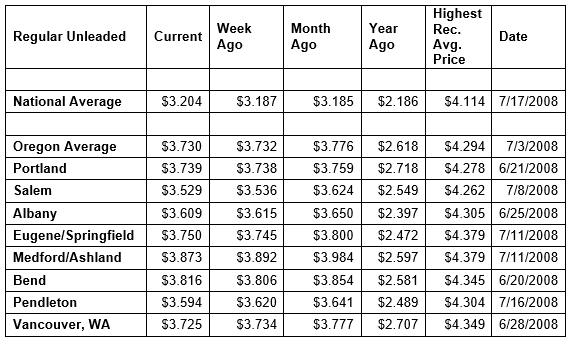
The national average is at its highest price since October 2014. The Oregon average is a little lower than its year-to-date high of $3.80 reached on August 19. Crude oil prices are at their highest prices since 2014 and up around 60% since the start of the year.
Demand for gasoline in the U.S. rose from 8.90 million b/d to 9.4 million b/d, more than a 5% increase. Total domestic gasoline stocks increased slightly by 200,000 bbl to 221.8 million bbl last week, according to new data from the U.S. Energy Information Administration (EIA). However, oil and natural gas production was lower than pre-pandemic levels during the same quarter in 2019. This tightened supply is helping keep crude prices above $75 per barrel and preventing pump prices from taking their usual seasonal dip.
“Global economic uncertainty and supply chain concerns caused by the lingering COVID-19 pandemic could be playing a role in keeping crude oil prices elevated,” says Marie Dodds, public affairs director for AAA Oregon/Idaho.
Although the summer surge of COVID-19 cases in the U.S. is waning, travel will likely continue to be impacted this fall. Visit AAA.com/covidmap for an interactive map with the latest travel restrictions and policies for North America. Find AAA’s latest COVID-19 information for travelers here. Travelers also need to monitor wildfires in the west and stay informed about closures and evacuations.
Quick stats
Oregon is one of 35 states where prices changed by two cents or less in the last week. Ohio (+12 cents) has the largest weekly increase in the country. Michigan (-4 cents) has the largest week-over-week decline.
California ($4.41) and Hawaii ($4.10) continue to have the most expensive gas prices in the country and are the only states in the nation with averages above $4 a gallon, and 38 states and the District of Columbia are at or above $3, up from 36 states and D.C. a week ago.
The cheapest gas in the nation is in Mississippi ($2.83) and Texas ($2.84). For the 39th week in a row, no state has an average below $2 a gallon.
Oregon is one of 11 states with lower prices now than a month ago. The national average is two cents more and the Oregon average is five cents less than a month ago. This is the sixth-largest monthly decrease in the nation. Nevada (-13 cents) has the largest monthly decrease in the country. Arizona (+11 cents) has the largest month-over-month increase.
All 50 states and the District of Columbia have higher prices now than a year ago, and 25 states including Oregon and the District of Columbia have a current average that’s a dollar or more higher than a year ago. The national average is $1.02 more and the Oregon average is $1.11 more than a year ago. This is the eighth-largest yearly increase in the nation. Idaho (+$1.34) has the biggest yearly increase. Delaware (+85 cents) has the smallest year-over-year increase.
West Coast
The West Coast region continues to have the most expensive pump prices in the nation with every state in the region except Arizona in the top 10.
California is the most expensive state for the 37th week in a row with Hawaii, Nevada and Washington rounding out the top four. Oregon is sixth, Alaska is eighth and Arizona is 17th. Oregon rises to sixth after 10 weeks at seventh.
| Rank | Region | Price on 10/5/21 | ||
| 1 | California | $4.41 | ||
| 2 | Hawaii | $4.10 | ||
| 3 | Nevada | $3.88 | ||
| 4 | Washington | $3.85 | ||
| 5 | Idaho | $3.73 | ||
| 6 | Oregon | $3.73 | ||
| 7 | Utah | $3.71 | ||
| 8 | Alaska | $3.69 | ||
| 9 | Colorado | $3.53 | ||
| 10 | Wyoming | $3.51 |
All seven states in the West Coast region are among the 36 states in the country that have averages above $3 a gallon.
Pump prices in the West Coast region are showing small to moderate changes of a nickel or less this week. Arizona (+5 cents) has the largest weekly increase in the region. Nevada (-2 cents) has the largest weekly decrease in the region.
The refinery utilization rate on the West Coast region fell from nearly 91% to 84% for the week ending September 24. It has ranged from 85% and 88% much of the summer after remaining between about 82% and 84% in the spring.
According to EIA’s latest weekly report, total gas stocks in the region declined to 30.28 million bbl from 32.13 million bbl. The lower refinery utilization rate and dip in stocks could put upward pressure on pump prices this week.
Oil market dynamics
Crude oil prices increased last week due to a stronger dollar and despite EIA’s recent report showing that total domestic crude inventories increased by 4.5 million bbl to 418.5 million bbl. This week, OPEC+, which comprises the Organization of the Petroleum Exporting Countries (OPEC), Russia and their allies, decided not to move forward with an agreement to produce an additional 400,000 b/d in November. The collective previously decided in July to boost crude output by 400,000 b/d each month until at least April 2022 in a push to phase out 5.8 million b/d of existing production cuts. OPEC+ met Monday via videoconference.
At the close of Friday’s formal trading session, WTI increased by 85 cents to settle at $75.88. At the close of Monday’s formal trading session, WTI rose $1.74 to settle at $77.62. Today crude is trading around $79, up from $75 a week ago. Crude prices are about $35 more than a year ago.
Drivers can find current gas prices along their route with the free AAA Mobile app for iPhone, iPad and Android. The app can also be used to map a route, find discounts, book a hotel and access AAA roadside assistance. Learn more at AAA.com/mobile.
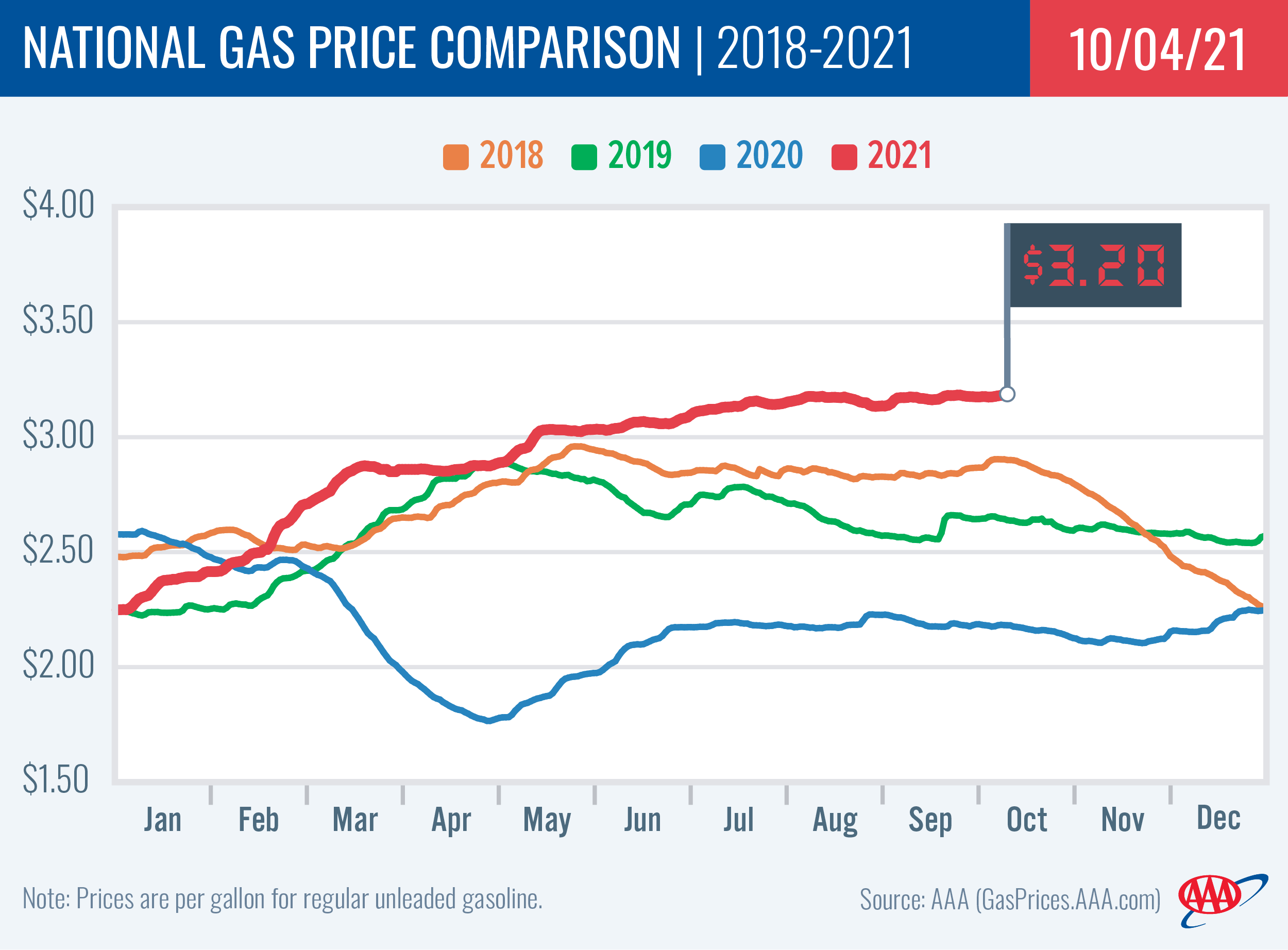
Diesel
For the week, the national average adds a nickel to $3.37 a gallon. Oregon’s average gains half a cent to $3.69. A year ago the national average for diesel was $2.39 and the Oregon average was $2.59.
Find current fuel prices at GasPrices.AAA.com.
AAA news releases, high resolution images, broadcast-quality video, fact sheets and podcasts are available on the AAA NewsRoom at NewsRoom.AAA.com.
Find local news releases at https://oregon.aaa.com/community/media/media-contacts.html
Fuel prices are updated daily at AAA’s Daily Fuel Gauge at AAA Gas Prices. For more info go www.AAA.com. AAA Oregon/Idaho provides more than 850,000 members with travel, insurance, financial and automotive-related services, and is an affiliate of AAA National, serving more than 62 million motorists in North America.
Updated 9/28/2021
Higher Oil Prices Delay Autumn Savings at the Pumps
PORTLAND, Ore., – Fall is here, but instead of taking a seasonal dip, gas prices still reflect summertime levels when demand was higher. The big culprit in keeping pump prices high is the price of crude oil, which is around $75 bbl. For the week, the national average for regular edges down half a cent to $3.19 a gallon. The Oregon average slips two cents to $3.73.

The national average is down slightly after matching a seven-year high in the prior week. The Oregon average is slowly backing off its year-to-date high of $3.80 reached on August 19.
“Drivers should see the usual autumn relief at the pumps; however it’s taking longer because of the remaining impacts from Hurricanes Ida and Nicholas,” says Marie Dodds, public affairs director for AAA Oregon/Idaho. “About 16% of crude production in the Gulf of Mexico is still shut down following the storms. In addition, investors are concerned about what higher COVID cases could do to the economy. This uncertainty is helping to keep oil prices elevated.”
Total U.S. gasoline stocks increased by 3.5 million bbl to 221.6 million bbl, according to the U.S. Energy Information Administration (EIA). Gasoline demand is low at 8.90 million b/d, helping to offset some of the upward pressure caused by higher crude oil prices. With the hurricane recovery and restoration process continuing, pump prices should stabilize. Most Louisiana refineries are running again, as witnessed by storage levels growing by 1.5 million bbl. However, high crude prices (above $72 per barrel) will contribute to gasoline prices likely remaining elevated for the next few weeks.
With the U.S. hit hard by the Delta variant, travel will likely continue to be impacted this fall. Visit AAA.com/covidmap for an interactive map with the latest travel restrictions and policies for North America. Find AAA’s latest COVID-19 information for travelers here. Travelers also need to monitor wildfires in the west and stay informed about closures and evacuations.
Quick stats
Oregon is one of 33 states and the District of Columbia with lower prices now than a week ago. Ohio (-8 cents) has the largest weekly drop in the country. Michigan (+9 cents) has the largest week-over-week gain.
California ($4.40) and Hawaii ($4.07) continue to have the most expensive gas prices in the country and are the only states in the nation with averages above $4 a gallon, and 36 states and the District of Columbia are at or above $3, up from 35 states and D.C. a week ago.
The cheapest gas in the nation is in Mississippi ($2.82) and Texas ($2.82). For the 38th week in a row, no state has an average below $2 a gallon.
Oregon is one of 13 states with lower prices now than a month ago. The national average is four cents more and the Oregon average is five cents less than a month ago. This is the fourth-largest monthly decrease in the nation. Nevada (-13 cents) has the largest monthly decrease in the country. Florida (+11 cents) has the largest month-over-month increase.
All 50 states and the District of Columbia have higher prices now than a year ago, and 20 states including Oregon and the District of Columbia have a current average that’s a dollar or more higher than a year ago. The national average is $1.00 more and the Oregon average is $1.10 more than a year ago. This is the eighth-largest yearly increase in the nation. Idaho (+$1.33) has the biggest yearly increase. Hawaii (+84 cents) has the smallest year-over-year increase.
West Coast
The West Coast region continues to have the most expensive pump prices in the nation with every state in the region except Arizona in the top 10.
| Rank | Region | Price on 9/28/21 | ||
| 1 | California | $4.40 | ||
| 2 | Hawaii | $4.07 | ||
| 3 | Nevada | $3.90 | ||
| 4 | Washington | $3.85 | ||
| 5 | Idaho | $3.75 | ||
| 6 | Utah | $3.74 | ||
| 7 | Oregon | $3.73 | ||
| 8 | Alaska | $3.69 | ||
| 9 | Colorado | $3.55 | ||
| 10 | Wyoming | $3.53 |
California is the most expensive state for the 36th week in a row with Hawaii, Nevada and Washington rounding out the top four. Oregon is seventh, Alaska is eighth and Arizona is 19th. Oregon is seventh for the 10th week in a row.
All seven states in the West Coast region are among the 36 states in the country that have averages above $3 a gallon.
Pump prices in the West Coast region are showing small changes of four cents or less this week. Nevada (-4 cents) has the largest weekly decrease in the region. Arizona (+2 cents) has the largest weekly increase in the region.
The refinery utilization rate on the West Coast region rises to nearly 91% this week up from 89% last week. It has ranged from 85% and 88% much of the summer after remaining between about 82% and 84% in the spring.
According to EIA’s latest weekly report, total gas stocks in the region are showing a healthy increase from 30.75 million bbl to 32.13 million bbl.
Oil market dynamics
Crude oil prices increased last week following the release of EIA’s recent report showing that total domestic crude inventories decreased by 3.4 million bbl to 414 million bbl. Additionally, crude prices rose after the Federal Reserve signaled it could raise interest rates in 2022 and end its bond-purchase program that has supported the economy since the start of the COVID-19 pandemic. For this week, crude prices could continue their ascent if EIA’s next report shows another weekly decline.
At the close of Friday’s formal trading session, WTI increased by 68 cents to settle at $73.98. At the close of Monday’s formal trading session, WTI rose $1.47 to settle at $75.45. Today crude is trading around $75, up from $70 a week ago. Crude prices are about $35 more than a year ago.
Drivers can find current gas prices along their route with the free AAA Mobile app for iPhone, iPad and Android. The app can also be used to map a route, find discounts, book a hotel and access AAA roadside assistance. Learn more at AAA.com/mobile.
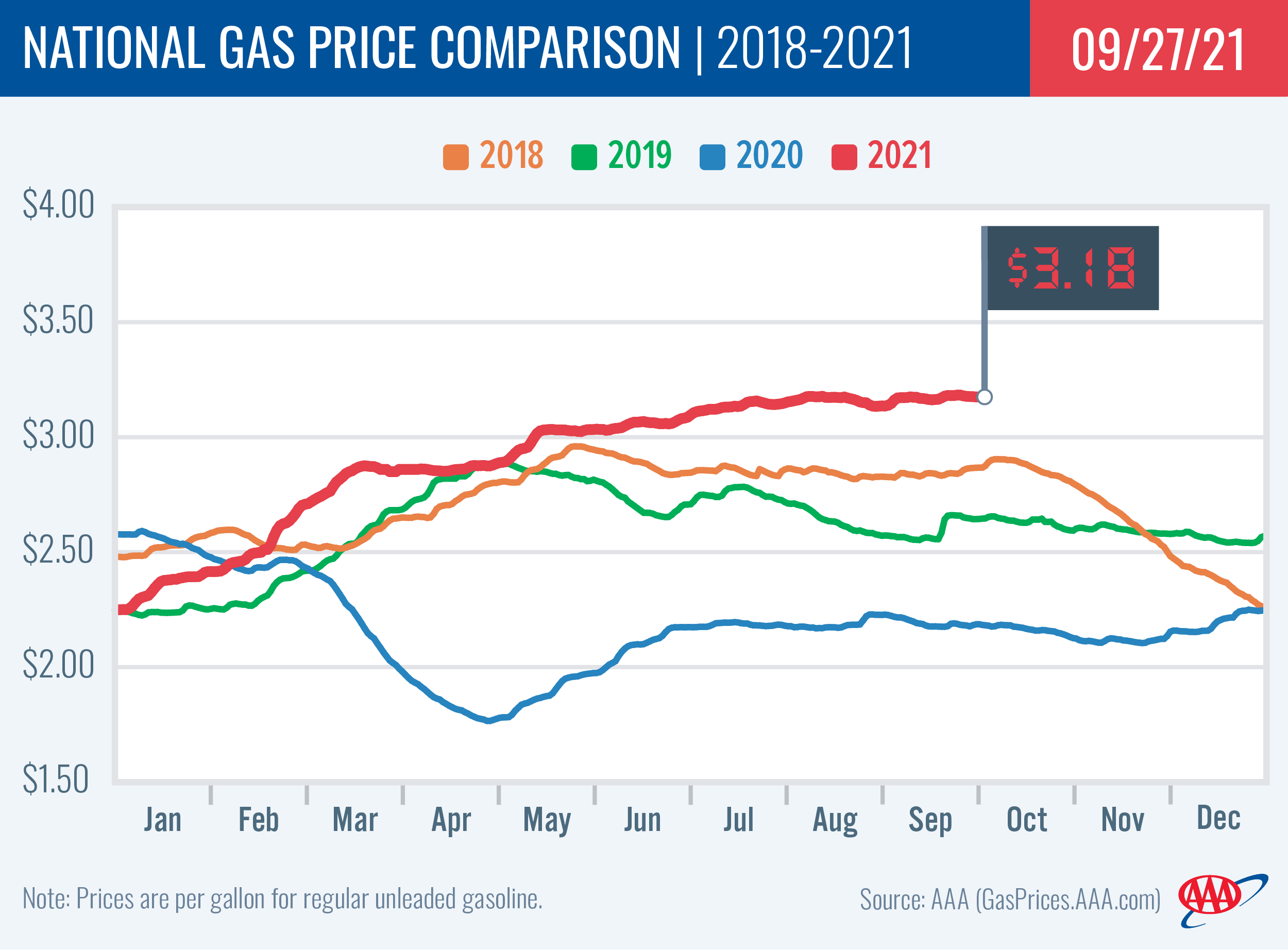
Diesel
For the week, the national average adds a penny to $3.32 a gallon. Oregon’s average loses a penny to $3.68. A year ago the national average for diesel was $2.39 and the Oregon average was $2.59.
Find current fuel prices at GasPrices.AAA.com.
AAA news releases, high resolution images, broadcast-quality video, fact sheets and podcasts are available on the AAA NewsRoom at NewsRoom.AAA.com.
Find local news releases at https://oregon.aaa.com/community/media/media-contacts.html
Fuel prices are updated daily at AAA’s Daily Fuel Gauge at AAA Gas Prices. For more info go www.AAA.com. AAA Oregon/Idaho provides more than 850,000 members with travel, insurance, financial and automotive-related services, and is an affiliate of AAA National, serving more than 62 million motorists in North America.
Updated 9/21/2021
Oregon Average Edges Lower, National Average Ticks Up
Storms still impact Gulf Coast production, refining
PORTLAND, Ore., – As is typical for the post-Labor Day period, demand for gasoline in the U.S. has dropped. However, the impact of Hurricane Ida followed by Hurricane Nichols has slowed oil production and refining. This has put upward pressure on gas prices in the affected areas, while prices on the West Coast are edging lower. For the week, the national average for regular adds one-and-a-half cents to $3.19 a gallon. The Oregon average ticks down a penny to $3.75.
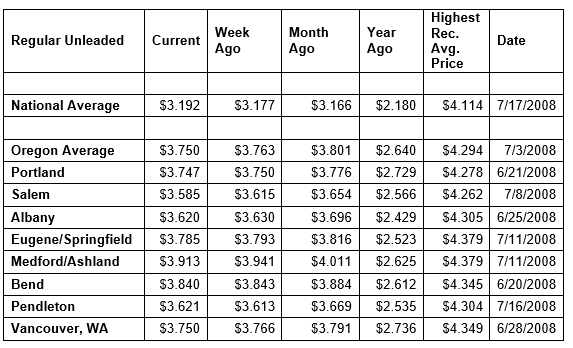
As expected this time of year, gasoline demand has fallen 8% to 8.9 million b/d, the lowest since Memorial Day, according to the U.S. Energy Information Administration.
“The seasonal drop in demand is helping gas prices fall here on the West Coast, and mitigating price increases in parts of the country still impacted by the hurricanes,” says Marie Dodds, public affairs director for AAA Oregon/Idaho. “hurricane season has been an active one so far, with 17 named storms already. Drivers can expect price fluctuations into October, especially in areas impacted by storms.”
Approximately 23% of offshore Gulf of Mexico oil production remains offline. However, most storm-affected refineries are reporting some level of restarting. Once fully back online, refinery production will help to increase domestic supply levels, which took another step back by 2 million bbl to 218 million bbl in EIA’s latest report. This is the lowest stock level since the post-Hurricane Harvey period in 2017. The tightened supply level has contributed to an increase in oil prices, which hit a high of $72 bbl last week, a level not seen since July. If the price of oil remains at this level or goes higher, it will likely result in higher prices at the pump.
With the U.S. hit hard by the Delta variant, travel will likely continue to be impacted this fall. Visit AAA.com/covidmap for an interactive map with the latest travel restrictions and policies for North America. Find AAA’s latest COVID-19 information for travelers here. Travelers also need to monitor wildfires in the west and stay informed about closures and evacuations.
Quick stats
Oregon is one of 14 states with lower prices now than a week ago. Nevada (-3 cents) has the largest weekly drop in the country. Ohio (+10 cents) has the largest week-over-week gain.
California ($4.39) and Hawaii ($4.06) continue to have the most expensive gas prices in the country and are the only states in the nation with averages above $4 a gallon, and 35 states and the District of Columbia are at or above $3, up from 33 states and D.C. a week ago.
The cheapest gas in the nation is in Texas ($2.80) and Mississippi ($2.81). For the 37th week in a row, no state has an average below $2 a gallon.
Oregon is one of 20 states with lower prices now than a month ago. The national average is three cents more and the Oregon average is five cents less than a month ago. This is the fourth-largest monthly decrease in the nation. Nevada (-12 cents) has the largest monthly decrease in the country. Ohio (+11 cents) has the largest month-over-month increase.
All 50 states and the District of Columbia have higher prices now than a year ago, and 24 states including Oregon and the District of Columbia have a current average that’s a dollar or more higher than a year ago. The national average is $1.01 more and the Oregon average is $1.11 more than a year ago. This is the 10th-largest yearly increase in the nation. Utah (+$1.33) has the biggest yearly increase. Hawaii (+83 cents) has the smallest year-over-year increase.
West Coast
The West Coast region continues to have the most expensive pump prices in the nation with every state in the region except Arizona in the top 10.
| Rank | Region | Price on 9/21/21 | ||
| 1 | California | $4.39 | ||
| 2 | Hawaii | $4.07 | ||
| 3 | Nevada | $3.94 | ||
| 4 | Washington | $3.87 | ||
| 5 | Idaho | $3.77 | ||
| 6 | Utah | $3.77 | ||
| 7 | Oregon | $3.75 | ||
| 8 | Alaska | $3.69 | ||
| 9 | Colorado | $3.57 | ||
| 10 | Wyoming | $3.55 |
California is the most expensive state for the 35th week in a row with Hawaii, Nevada and Washington rounding out the top four. Oregon is seventh, Alaska is eighth and Arizona is 20th. Oregon is seventh for the ninth week in a row.
All seven states in the West Coast region are among the 35 states in the country that have averages above $3 a gallon.
Pump prices in the West Coast region are showing small changes this week. Nevada (-3 cents) has the largest weekly decrease in the region and the country. Arizona (+1/10th of a cent) is the only state in the region with a weekly increase.
The refinery utilization rate on the West Coast region is holding steady this week at a high rate of more than 89%. It has ranged from 85% and 88% much of the summer after remaining between about 82% and 84% in the spring.
According to EIA’s latest weekly report, total gas stocks in the region have increased from 30.35 million bbl to 30.75 million bbl.
Oil market dynamics
Although crude oil prices decreased on Friday due to a stronger dollar, prices primarily increased last week due to the market reacting to impacts from Hurricanes Ida and Nicholas. Additionally, crude prices rose after EIA reported that total domestic crude inventories dropped by 6.5 million bbl to 417.4 million bbl. As crude production remains constrained and the price per barrel remains above $70, a level not seen since July, pump prices will likely remain elevated.
At the close of Friday’s formal trading session, WTI decreased by 64 cents to $71.97. At the close of Monday’s formal trading session, WTI fell $1.68 to settle at $70.29. Today crude is trading around $70, same as a week ago. Crude prices are about $29 more than a year ago.
Drivers can find current gas prices along their route with the free AAA Mobile app for iPhone, iPad and Android. The app can also be used to map a route, find discounts, book a hotel and access AAA roadside assistance. Learn more at AAA.com/mobile.
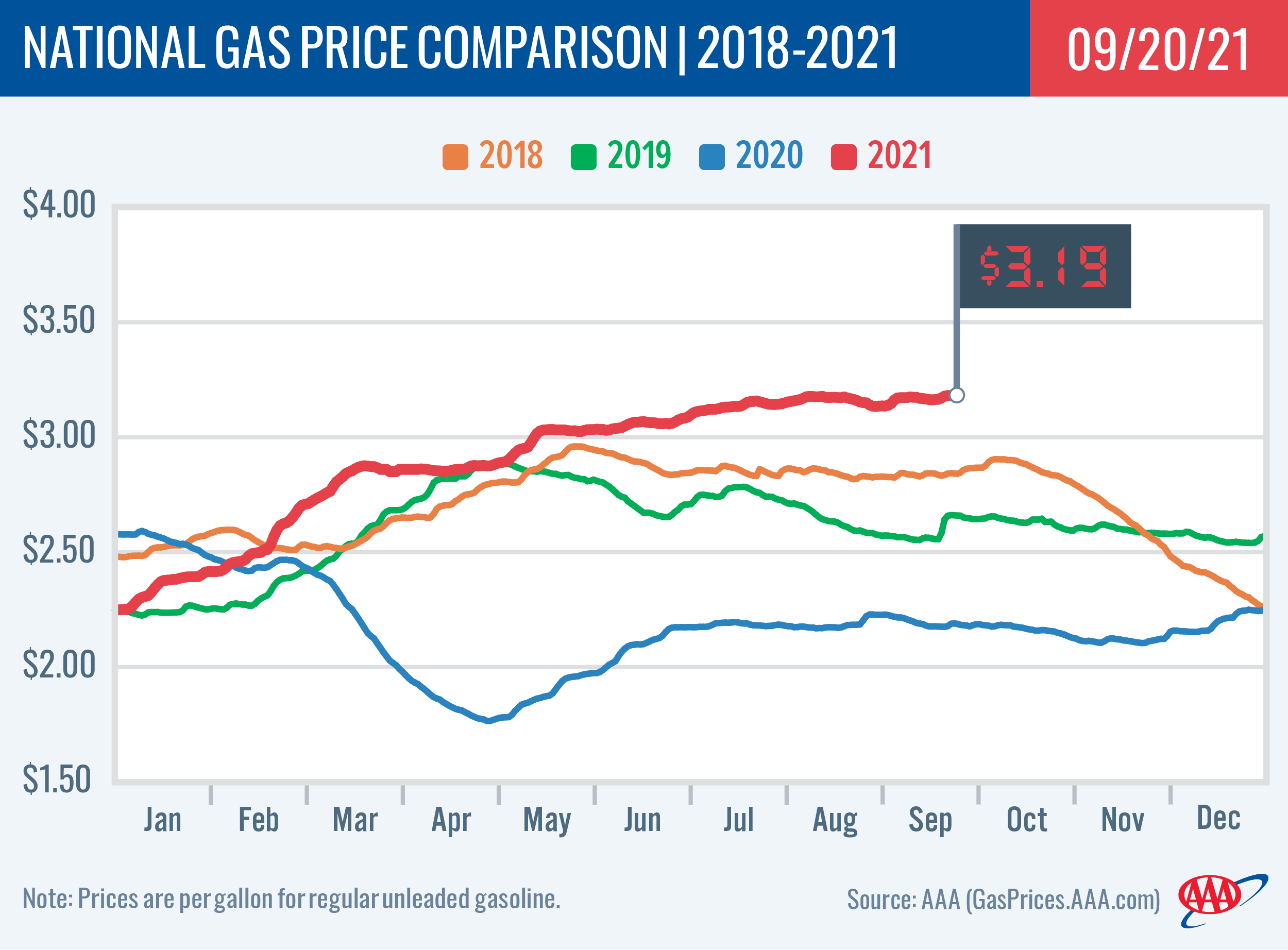
Diesel
For the week, the national average adds a penny to $3.31 a gallon. Oregon’s average loses a penny to $3.69. A year ago the national average for diesel was $2.40 and the Oregon average was $2.61.
Find current fuel prices at GasPrices.AAA.com.
AAA news releases, high resolution images, broadcast-quality video, fact sheets and podcasts are available on the AAA NewsRoom at NewsRoom.AAA.com.
Find local news releases at https://oregon.aaa.com/community/media/media-contacts.html
Fuel prices are updated daily at AAA’s Daily Fuel Gauge at AAA Gas Prices. For more info go www.AAA.com. AAA Oregon/Idaho provides more than 850,000 members with travel, insurance, financial and automotive-related services, and is an affiliate of AAA National, serving more than 62 million motorists in North America.
Updated 9/14/2021
Pump Prices Edge Lower as Summer Driving Season Ends
PORTLAND, Ore., – With the busy summer driving season in the rearview mirror, drivers are seeing a little relief at the pumps. Gasoline stocks remain impacted by Hurricane Ida as well as Nicholas which made landfall as a Category 1 hurricane in Texas early today; however, the reduction in gasoline supplies have been offset by decreased demand. For the week, the national average for regular slips a penny to $3.18 a gallon. The Oregon average also ticks down a penny to $3.76.
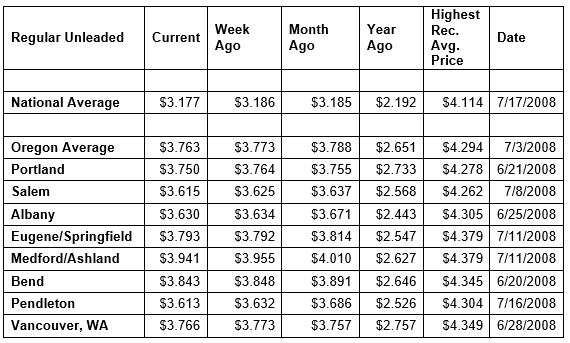
Nicholas has caused power outages to the area near the refining center in Houston, only two weeks after Hurricane Ida devastated the power grid in southeast Louisiana. The recovery from Hurricane Ida remains slow, with the latest U.S. data showing just under half of the U.S. offshore oil production in the Gulf still idle after companies shuttered production ahead of the storm. Meanwhile, refinery utilization is down almost 10%, causing gasoline stock levels to fall by 7.2 million bbl to 220 million bbl, according to the U.S. Energy Information Administration (EIA).
Stock levels are likely to remain tight until storm-affected refineries resume normal operations. While refineries are reporting progress towards restarting, the U.S. Department of Energy (DOE) said it would release an additional 1.5 million bbl of crude oil held at the U.S. Strategic Petroleum Reserve (SPR) to help ease tightened supplies brought by Hurricane Ida. This is the second such release, and the DOE said the SPR has now released a total of 3.3 million bbl of crude oil in response to the storm.
“This week pump prices could be impacted, especially in the Southeast. Timing is everything. While gasoline supplies nationwide have tightened, this is also the time of year demand starts to drop. While there may be some price fluctuations, we expect most drivers will find fairly stable pump prices when they fill up,” says Marie Dodds, public affairs director for AAA Oregon/Idaho.
Visit AAA.com/covidmap for an interactive map with the latest travel restrictions and policies for North America. Find AAA’s latest COVID-19 information for travelers here. Travelers also need to monitor wildfires in the west and stay informed about closures and evacuations.
Quick stats
Oregon is one of 26 states with lower prices now than a week ago. All states are showing small to moderate changes of six cents or less this week. Ohio (-6 cents) has the largest weekly drop in the country. Arizona (+4 cents) has the largest week-over-week gain. Averages are flat in Virginia and Maine.
California ($4.39) and Hawaii ($4.07) continue to have the most expensive gas prices in the country and are the only states in the nation with averages above $4 a gallon, and 33 states and the District of Columbia are at or above $3, down from 34 states and D.C. a week ago.
The cheapest gas in the nation is in Mississippi ($2.80) and Texas ($2.81). For the 36th week in a row, no state has an average below $2 a gallon.
Oregon is one of 30 states and the District of Columbia with lower prices now than a month ago. The national average is one cent less and the Oregon average is three cents less than a month ago. Michigan (-9 cents) has the largest monthly decrease in the country. Louisiana (+6 cents) has the largest month-over-month increase.
All 50 states and the District of Columbia have higher prices now than a year ago, and 18 states including Oregon have a current average that’s a dollar or more higher than a year ago. The national average is 99 cents more and the Oregon average is $1.11 more than a year ago. This is the ninth-largest yearly increase in the nation. Idaho (+$1.33) has the biggest yearly increase. Delaware (+75 cents) has the smallest year-over-year increase.
West Coast
The West Coast region continues to have the most expensive pump prices in the nation with every state in the region except Arizona in the top 10.
| Rank | Region | Price on 9/14/21 | ||
| 1 | California | $4.39 | ||
| 2 | Hawaii | $4.07 | ||
| 3 | Nevada | $3.97 | ||
| 4 | Washington | $3.88 | ||
| 5 | Utah | $3.79 | ||
| 6 | Idaho | $3.78 | ||
| 7 | Oregon | $3.76 | ||
| 8 | Alaska | $3.70 | ||
| 9 | Colorado | $3.59 | ||
| 10 | Wyoming | $3.56 |
California is the most expensive state for the 34th week in a row with Hawaii, Nevada and Washington rounding out the top four. Oregon is seventh, Alaska is eighth and Arizona is 20th. Oregon is seventh for the eighth week in a row.
All seven states in the West Coast region are among the 33 states in the country that have averages above $3 a gallon.
Pump prices in the West Coast region are showing small to moderate changes this week, like all other regions. Arizona (+4 cents) has the largest weekly increase in the region and the country, while Nevada (-4 cents) has the region’s biggest weekly decrease.
The refinery utilization rate has jumped in the West Coast region this week from 84% to 89%. The rate has been between 85% and 88% much of the summer after remaining between about 82% and 84% in the spring.
According to EIA’s latest weekly report, total gas stocks in the region have increased slightly from 30.09 million bbl to 30.35 million bbl.
Oil market dynamics
Crude oil prices elevated as approximately 48% of crude oil production in the Gulf Coast region is shuttered due to Hurricane Ida, according to the federal Bureau of Safety and Environmental Enforcement. As production gradually returns to normal operations, crude prices should stabilize as supply increases. Additionally, crude saw jumps last week after the EIA reported that total domestic crude inventories decreased by 1.5 million to 423.9 million bbl.
At the close of Friday’s formal trading session, WTI increased by $1.58 to settle at $69.72. At the close of Monday’s formal trading session, WTI added 73 cents to settle at $70.45. Today crude is trading around $70, compared to $68 a week ago. Crude prices are about $33 more than a year ago.
Drivers can find current gas prices along their route with the free AAA Mobile app for iPhone, iPad and Android. The app can also be used to map a route, find discounts, book a hotel and access AAA roadside assistance. Learn more at AAA.com/mobile.

Diesel
For the week, the national average holds steady at $3.29 a gallon. Oregon’s average remains at $3.70. A year ago the national average for diesel was $2.41 and the Oregon average was $2.61.
Find current fuel prices at GasPrices.AAA.com.
AAA news releases, high resolution images, broadcast-quality video, fact sheets and podcasts are available on the AAA NewsRoom at NewsRoom.AAA.com.
Find local news releases at https://oregon.aaa.com/community/media/media-contacts.html
Fuel prices are updated daily at AAA’s Daily Fuel Gauge at AAA Gas Prices. For more info go www.AAA.com. AAA Oregon/Idaho provides more than 850,000 members with travel, insurance, financial and automotive-related services, and is an affiliate of AAA National, serving more than 62 million motorists in North America.
Updated 8/31/2021
Drivers Could See Temporary Spikes following Ida and ahead of Labor Day
Demand Climbs as travelers take final summer getaways
PORTLAND, Ore., – Retail gas prices have been inching down but some areas could see temporary spikes following Hurricane Ida and ahead of the Labor Day holiday weekend. The storm has taken about 13% of U.S. refining capacity offline. Impacts should be minimal here on the West Coast. For the week, the national average for regular ticks up a penny to $3.16 a gallon. The Oregon average slips a penny to $3.78.
“Drivers will pay the most expensive prices for gas over the Labor Day holiday in seven years. Most Labor Day travelers are going by car, which has been the most popular way to travel during the coronavirus pandemic,” says Marie Dodds, public affairs director for AAA Oregon/Idaho.
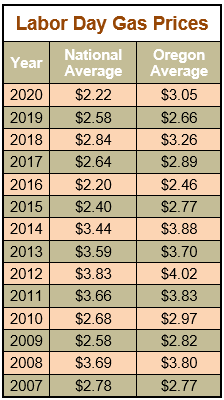
With COVID-19 cases surging in Oregon and most other states, and schools already back in session or starting soon, travel is not expected to be as robust this Labor Day as before the pandemic. For those who do choose to take a trip on the last holiday weekend of the summer, many are visiting destinations that are fairly close—about a day’s drive—from home.
Here are the top 10 destinations for Labor Day based on bookings and searches at AAA.com/travel over the past 30 days:
- Oregon coast: Lincoln City, Seaside, Newport, Florence, Cannon Beach
- Bend
- Las Vegas
- Washington: Seattle, Walla Walla
- Northern/Central California: Redding, Eureka, Sacramento, Monterey, San Luis Obispo
- Yellowstone National Park and surrounding areas including Wyoming and Montana
- Portland
- Ashland, OR
- Utah: Ogden, Moab
- Anaheim, Disneyland
Visit AAA.com/covidmap for an interactive map with the latest travel restrictions and policies for North America. Find AAA’s latest COVID-19 information for travelers here.
Travelers also need to monitor wildfires in the west and stay informed about closures and evacuations.
There were nine oil refineries in Ida’s path; at least six shut down operations ahead of the storm. Power outages are widespread across Louisiana and Mississippi. About 15% of the nation’s oil comes from the Gulf of Mexico.
“Once power is restored, it will take some time to determine the full impact of any damage Ida caused to the oil and gas industry in and near the Gulf of Mexico. Drivers can expect price fluctuations leading up the Labor Day weekend, especially in the Southeast and East Coast,” says Marie Dodds, public affairs director for AAA Oregon/Idaho.
Typically, a category 4 storm could mean three plus weeks before refineries and other facilities are inspected and return to normal operations, while offshore production is more likely to resume this week.
Gasoline demand is up slightly to nearly 9.6 million b/d, according to the U.S. Energy Information Administration. That’s the second-highest demand reading this year, trailing only the 10 million b/d reading ahead of the July 4th holiday, but still about 3% below the same week in August 2019.
Quick stats
Oregon is one of 23 states with lower prices now than a week ago. All states are showing small changes of a nickel or less this week. North Dakota (-3 cents) has the largest weekly drop in the country. Indiana (+5 cents) has the largest week-over-week gain. Averages are flat in Kansas and Montana.
California ($4.40), Hawaii ($4.07), and Nevada ($4.03) continue to have the most expensive gas prices in the country and are the only states in the nation with averages above $4 a gallon, and 31 states and the District of Columbia are at or above $3, same as a week ago.
The cheapest gas in the nation is in Texas ($2.78) and Mississippi ($2.78). For the 34th week in a row, no state has an average below $2 a gallon.
Oregon is one of 22 states with higher prices now than a month ago. The national average is one cent less and the Oregon average is five cents more than a month ago. This is the fifth-largest month-over-month increase in the nation. Colorado (+6 cents) has the largest monthly increase in the country. Delaware (-10 cents) has the largest month-over-month decrease.
All 50 states and the District of Columbia have higher prices now than a year ago, and 13 states including Oregon have a current average that’s a dollar or more higher than a year ago. The national average is 93 cents more and the Oregon average is $1.11 more than a year ago. This is the eighth-largest yearly increase in the nation. Utah (+$1.39) has the biggest yearly increase. Delaware (+69 cents) has the smallest year-over-year increase.
West Coast
The West Coast region continues to have the most expensive pump prices in the nation with every state in the region except Arizona in the top 10.
| Rank | Region | Price on 8/31/21 | ||
| 1 | California | $4.40 | ||
| 2 | Hawaii | $4.07 | ||
| 3 | Nevada | $4.03 | ||
| 4 | Washington | $3.90 | ||
| 5 | Utah | $3.82 | ||
| 6 | Idaho | $3.80 | ||
| 7 | Oregon | $3.78 | ||
| 8 | Alaska | $3.70 | ||
| 9 | Colorado | $3.62 | ||
| 10 | Wyoming | $3.59 |
California is the most expensive state for the 32nd week in a row with Hawaii, Nevada and Washington rounding out the top four. Oregon is seventh, Alaska is eighth and Arizona is 20th. Oregon is seventh for the sixth week in a row.
All seven states in the West Coast region are among the 31 states in the country that have averages above $3 a gallon.
Pump prices in the West Coast region are showing small changes this week, like most other regions. Nevada (-2 cents) has the largest weekly decline in the region, while California (+1 cent) has the biggest weekly increase.
The refinery utilization rate has increased in the West Coast region this week from 87% to 88.5%. The rate has been between 85% and 88% much of the summer after remaining between about 82% and 84% this spring.
According to EIA’s latest weekly report, total gas stocks in the region are fairly steady, going from 29.34 million bbl to 29.30 million bbl.
Oil market dynamics
Crude oil prices rose last week as production ramped down ahead of Hurricane Ida making landfall. As the storm battered the Southeast, more than 95% of oil production in the Gulf Coast region was shuttered. In addition, the federal Bureau of Safety and Environmental Enforcement reports that 288 out of 560 manned offshore platforms were evacuated; all 11 of the non-dynamically positioned rigs have been evacuated; and 10 of the 15 dynamically positioned rigs were moved out of the storm’s path as a precaution. For this week, crude prices will likely increase, at least temporarily, in response to reduced supply. However, as the storm clears and damage is assessed, production will gradually return to normal operations and help to stabilize prices as supply increases.
At the close of Friday’s formal trading session, WTI increased by $1.32 to settle at $68.74. At the close of Monday’s formal trading session, WTI added 47 cents to settle at $69.21. Today crude is trading around $69, compared to $67 a week ago. Crude prices are about $26 more than a year ago.
Drivers can find current gas prices along their route with the free AAA Mobile app for iPhone, iPad and Android. The app can also be used to map a route, find discounts, book a hotel and access AAA roadside assistance. Learn more at AAA.com/mobile.

Diesel
For the week, the national average holds steady at $3.28 a gallon. Oregon’s average ticks down a penny to $3.70. A year ago the national average for diesel was $2.43 and the Oregon average was $2.62.
Find current fuel prices at GasPrices.AAA.com.
AAA news releases, high resolution images, broadcast-quality video, fact sheets and podcasts are available on the AAA NewsRoom at NewsRoom.AAA.com.
Find local news releases at https://oregon.aaa.com/community/media/media-contacts.html
Fuel prices are updated daily at AAA’s Daily Fuel Gauge at AAA Gas Prices. For more info go www.AAA.com. AAA Oregon/Idaho provides more than 850,000 members with travel, insurance, financial and automotive-related services, and is an affiliate of AAA National, serving more than 62 million motorists in North America.
Updated 8/24/2021
Gas Demand and Pump Prices Tap the Brakes this Week
PORTLAND, Ore., – Demand for gasoline in the U.S. has declined for the last three weeks. The shrinking demand and a drop in crude oil prices are helping to put the brakes on pump price increases. For the week, the national average for regular falls three cents to $3.15 a gallon. The Oregon average slips a penny to $3.79.
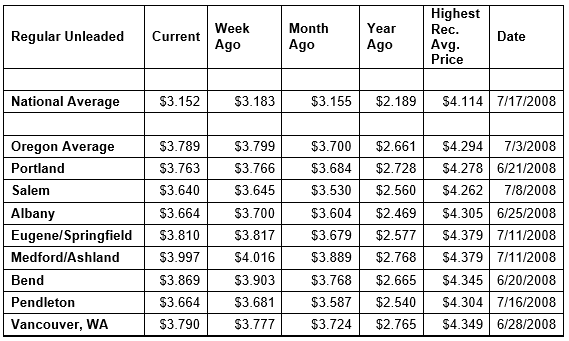
Crude oil prices saw a significant decline of $5/bbl on the week, down to $62.32/bbl at Friday’s close, the lowest price in three months. However, crude prices have rebounded somewhat to start this week. Prices declined due to market concerns that crude demand will decline as coronavirus infections increase around the globe.
Gasoline demand has fallen for three consecutive weeks with the latest reading at 9.3 million b/d, according to the U.S. Energy Information Administration. That’s a healthy pandemic demand reading, but still about 6% below the same week in August 2019. The softer demand readings have pushed gasoline stock levels over 228 million bbl.
“The downward crude price trend and softer demand could spell good news for drivers. If crude oil prices remain relatively low, drivers can expect to see relief at the pumps soon, which would be welcome after such an expensive summer at the pumps,” says Marie Dodds, public affairs director for AAA Oregon/Idaho.
With cases of COVID-19 surging across the U.S. due to the delta variant, travel and gasoline consumption are seeing impacts. Visit AAA.com/covidmap for an interactive map with the latest travel information. Find AAA’s latest COVID-19 information for travelers here.
Quick stats
Oregon is one of 49 states and the District of Columbia with lower prices now than a week ago. Ohio (-9 cents) has the largest weekly drop in the country. Georgia (+2/10ths of a cent) is the only state with a week-over-week gain.
California ($4.39), Hawaii ($4.07), and Nevada ($4.05) continue to have the most expensive gas prices in the country and are the only states in the nation with averages above $4 a gallon, and 31 states and the District of Columbia are above $3, up from 36 states and D.C. a week ago.
The cheapest gas in the nation is in Mississippi ($2.78) and Texas ($2.81). For the 33rd week in a row, no state has an average below $2 a gallon.
Oregon is one of 26 states with higher prices now than a month ago. The national average is the same and the Oregon average is nine cents more than a month ago. This is the sixth-largest month-over-month increase in the nation. Nevada (+11 cents) has the largest monthly increase in the country. Ohio (-13 cents) has the largest month-over-month decrease.
All 50 states and the District of Columbia have higher prices now than a year ago, and 13 states including Oregon have a current average that’s a dollar or more higher than a year ago. The national average is 96 cents more and the Oregon average is $1.13 more than a year ago. This is the eighth-largest yearly increase in the nation. Utah (+$1.40) has the biggest yearly increase. Kentucky (+77 cents) has the smallest year-over-year increase.
West Coast
The West Coast region continues to have the most expensive pump prices in the nation with every state in the region except Arizona in the top 10.
| Rank | Region | Price on 8/24/21 | ||
| 1 | California | $4.39 | ||
| 2 | Hawaii | $4.07 | ||
| 3 | Nevada | $4.05 | ||
| 4 | Washington | $3.90 | ||
| 5 | Utah | $3.84 | ||
| 6 | Idaho | $3.81 | ||
| 7 | Oregon | $3.79 | ||
| 8 | Alaska | $3.71 | ||
| 9 | Colorado | $3.63 | ||
| 10 | Wyoming | $3.58 |
California is the most expensive state for the 31st week in a row with Hawaii, Nevada and Washington rounding out the top four. Oregon is seventh, Alaska is eighth and Arizona is 20th. Oregon is seventh for the fifth week in a row.
All seven states in the West Coast region are among the 31 states in the country that have averages above $3 a gallon.
Pump prices in the West Coast region are showing small decreases this week, like most other regions. Hawaii (-2 cents) has the largest weekly decline in the region, while Alaska (-7/10ths of a cent) has the smallest.
The refinery utilization rate has increased slightly in the West Coast region this week to 87%. The rate has been between 85% and 88% much of the summer after remaining between about 82% and 84% this spring.
According to EIA’s latest weekly report, total gas stocks in the region are steady, going from 29.32 million bbl to 29.34 million bbl.
Oil market dynamics
Crude oil prices last week had their biggest declines in nine months but have risen to start this week. Market concerns persist that crude demand may not rebound this year as expected due to surging coronavirus infection rates around the world. Price decreases occurred despite EIA’s latest report showing that total domestic crude stocks decreased by 3.3 million bbl to 435.5 million bbl last week. To start this week, crude oil prices rose more than 5% Monday as investors bought crude at its lower prices.
At the close of Friday’s formal trading session, WTI decreased by $1.37 to settle at $62.32. At the close of Monday’s formal trading session, WTI jumped $3.50 to settle at $65.64. Today crude is trading around $67, compared to $66 a week ago. Crude prices are about $23 more than a year ago.
Drivers can find current gas prices along their route with the free AAA Mobile app for iPhone, iPad and Android. The app can also be used to map a route, find discounts, book a hotel and access AAA roadside assistance. Learn more at AAA.com/mobile.
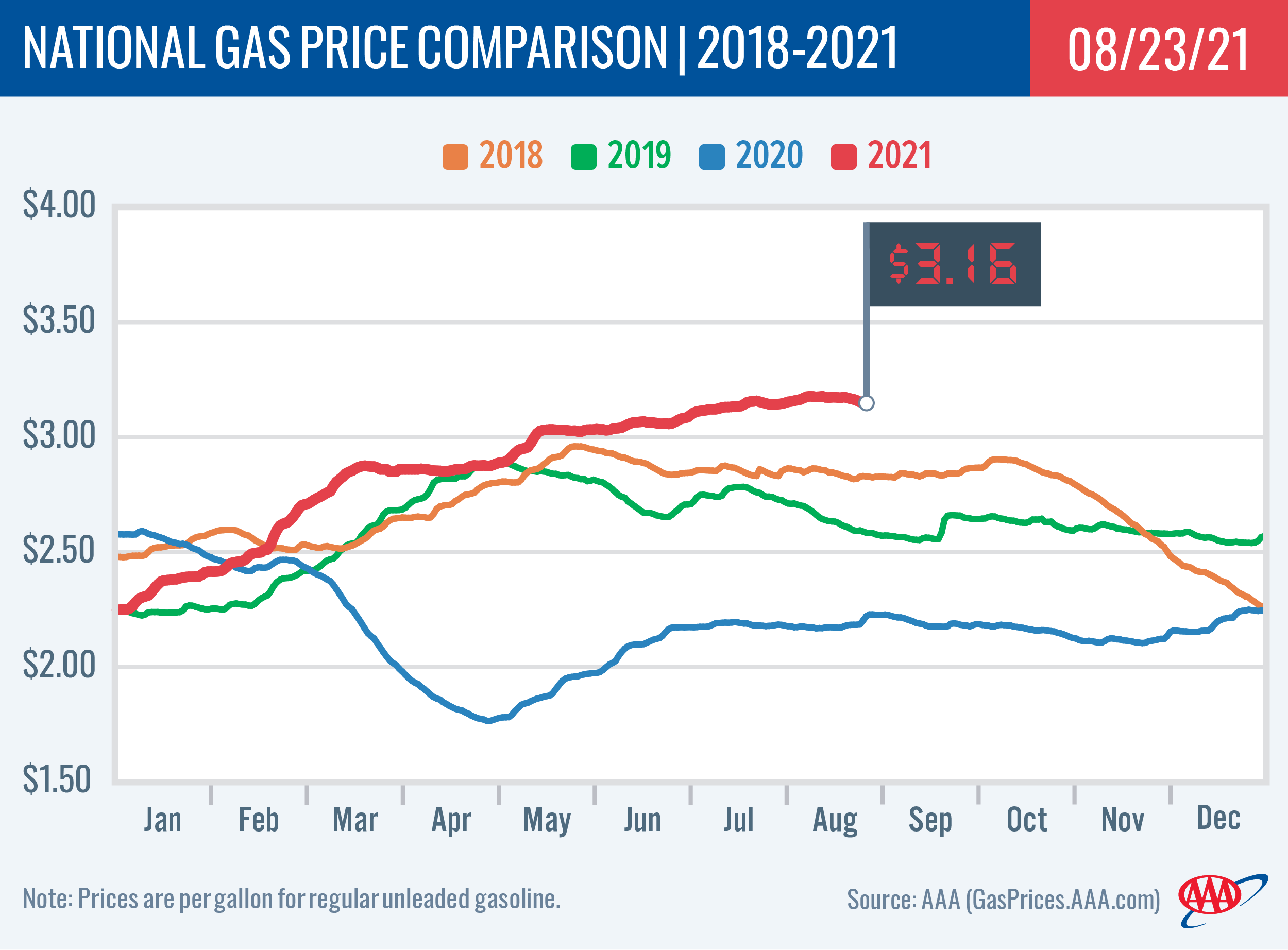
Diesel
For the week, the national average dips a penny to $3.28 a gallon. Oregon’s average slips half a cent to $3.71. A year ago the national average for diesel was $2.42 and the Oregon average was $2.61.
Find current fuel prices at GasPrices.AAA.com.
AAA news releases, high resolution images, broadcast-quality video, fact sheets and podcasts are available on the AAA NewsRoom at NewsRoom.AAA.com.
Find local news releases at https://oregon.aaa.com/community/media/media-contacts.html
Fuel prices are updated daily at AAA’s Daily Fuel Gauge at AAA Gas Prices. For more info go www.AAA.com. AAA Oregon/Idaho provides more than 850,000 members with travel, insurance, financial and automotive-related services, and is an affiliate of AAA National, serving more than 62 million motorists in North America.
Updated 8/17/2021
Gas Demand and Supply Dip, Pump Prices Remain Elevated
Oregon Average has Largest Weekly Jump in the Nation at 3.5 Cents
PORTLAND, Ore., – Both supply and demand for gasoline in the U.S. have dipped, helping to stabilize the national average and minimize movement in pump prices. However, prices are climbing in half of all states, including Oregon. For the week, the national average for regular remains at $3.18 a gallon. The Oregon average gains three-and-a-half cents to $3.80. This is the largest weekly increase in the country.
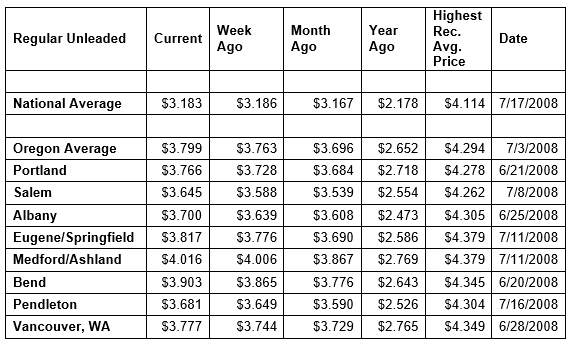
Demand and supply of gasoline in the U.S. have both decreased. Demand fell from 9.78 million b/d to 9.43 million b/d last week, according to the latest report from the U.S. Energy Information Administration (EIA). The latest demand measurement is 500,000 b/d lower than the rate at this time in 2019, signaling that summer gas demand is likely softening as the school year starts and concerns about transmission of COVID-19 grow as infection rates continue to increase. Additionally, total domestic gas stocks declined by 1.3 million bbl to 227.5 million bbl.
Although the drop in demand has helped to minimize pump price increases, elevated crude prices continue to keep pump prices high as the end of summer draws near.
“During the run-up to Labor Day weekend, pump prices will likely continue to fluctuate due to high crude prices. However, gas demand typically drops considerably after the final holiday weekend of summer, bringing much needed relief to drivers when they fill-up this fall,” says Marie Dodds, public affairs director for AAA Oregon/Idaho.
With cases of COVID-19 surging across the U.S. due to the delta variant, travel and gasoline consumption are seeing impacts. Visit AAA.com/covidmap for an interactive map with the latest travel information. Find AAA’s latest COVID-19 information for travelers here.
Quick stats
Oregon is one of 25 states with higher prices now than a week ago, and Oregon (+3.5 cents) has the largest weekly increase in the country. Michigan (-4 cents) has the biggest week-over-week decline. Averages in New York and the District of Columbia are flat.
California ($4.41) and Hawaii ($4.09) continue to have the most expensive gas prices in the country. This week Nevada ($4.06) joins California and Hawaii as the only states in the nation with averages above $4 a gallon, and 36 states and the District of Columbia are above $3, up from 35 states and D.C. a week ago.
The cheapest gas in the nation is in Mississippi ($2.79) and Louisiana ($2.84). For the 32nd week in a row, no state has an average below $2 a gallon.
Oregon is one of 36 states and the District of Columbia with higher prices now than a month ago. The national average is two cents more and the Oregon average is 10 cents more than a month ago. This is the sixth-largest month-over-month increase in the nation. Nevada (+20 cents) has the largest monthly increase in the country. Ohio (-10 cents) has the largest month-over-month decrease.
All 50 states and the District of Columbia have higher prices now than a year ago, and 18 states including Oregon and the District of Columbia have a current average that’s a dollar or more higher than a year ago. The national average is $1.01 more and the Oregon average is $1.15 more than a year ago. This is the eighth-largest yearly increase in the nation. Nevada (+$1.41) has the biggest yearly increase. Delaware (+78 cents) has the smallest year-over-year increase.
West Coast
The West Coast region continues to have the most expensive pump prices in the nation with every state in the region except Arizona in the top 10.
| Rank | Region | Price on 8/17/21 | ||
| 1 | California | $4.41 | ||
| 2 | Hawaii | $4.09 | ||
| 3 | Nevada | $4.06 | ||
| 4 | Washington | $3.90 | ||
| 5 | Utah | $3.86 | ||
| 6 | Idaho | $3.81 | ||
| 7 | Oregon | $3.80 | ||
| 8 | Alaska | $3.71 | ||
| 9 | Colorado | $3.64 | ||
| 10 | Wyoming | $3.60 |
California is the most expensive state for the 30th week in a row with Hawaii, Nevada and Washington rounding out the top four. Oregon is seventh, Alaska is eighth and Arizona is 20th. Oregon is seventh for the fourth week in a row.
All seven states in the West Coast region are among the 35 states in the country, along with D.C., that have averages above $3 a gallon.
Pump prices in the West Coast region are showing more upward movement than other regions this week. Oregon (+3.5 cents) and Alaska (+3 cents) have the largest weekly increases in the region and the nation. Hawaii (-1/2 cent) is the only state in the region with a week-over-week decline.
The refinery utilization rate has increased slightly in the West Coast region this week to nearly 87%. The rate has been between 85% and 88% much of the summer after remaining between about 82% and 84% this spring.
According to EIA’s latest weekly report, total gas stocks in the region fell from 30.08 million bbl to 29.32 million bbl last week. This could put additional upward pressure on prices in the region this week.
Oil market dynamics
Crude oil prices declined last week and to start this week due to market concerns that crude demand may not rebound this year as anticipated due to surging coronavirus infection rates across the globe. Price decreases occurred despite EIA’s latest report showing that total domestic crude stocks decreased nominally to 438.8 million bbl. For this week, crude prices could decline further if market concerns persist over increasing COVID-19 infection rates.
At the close of Friday’s formal trading session, WTI decreased by 65 cents to settle at $68.44. At the close of Monday’s formal trading session, WTI fell $1.15 to settle at $67.29. Today crude is trading around $66, compared to $68 a week ago. Crude prices are about $25 more than a year ago.
Drivers can find current gas prices along their route with the free AAA Mobile app for iPhone, iPad and Android. The app can also be used to map a route, find discounts, book a hotel and access AAA roadside assistance. Learn more at AAA.com/mobile.
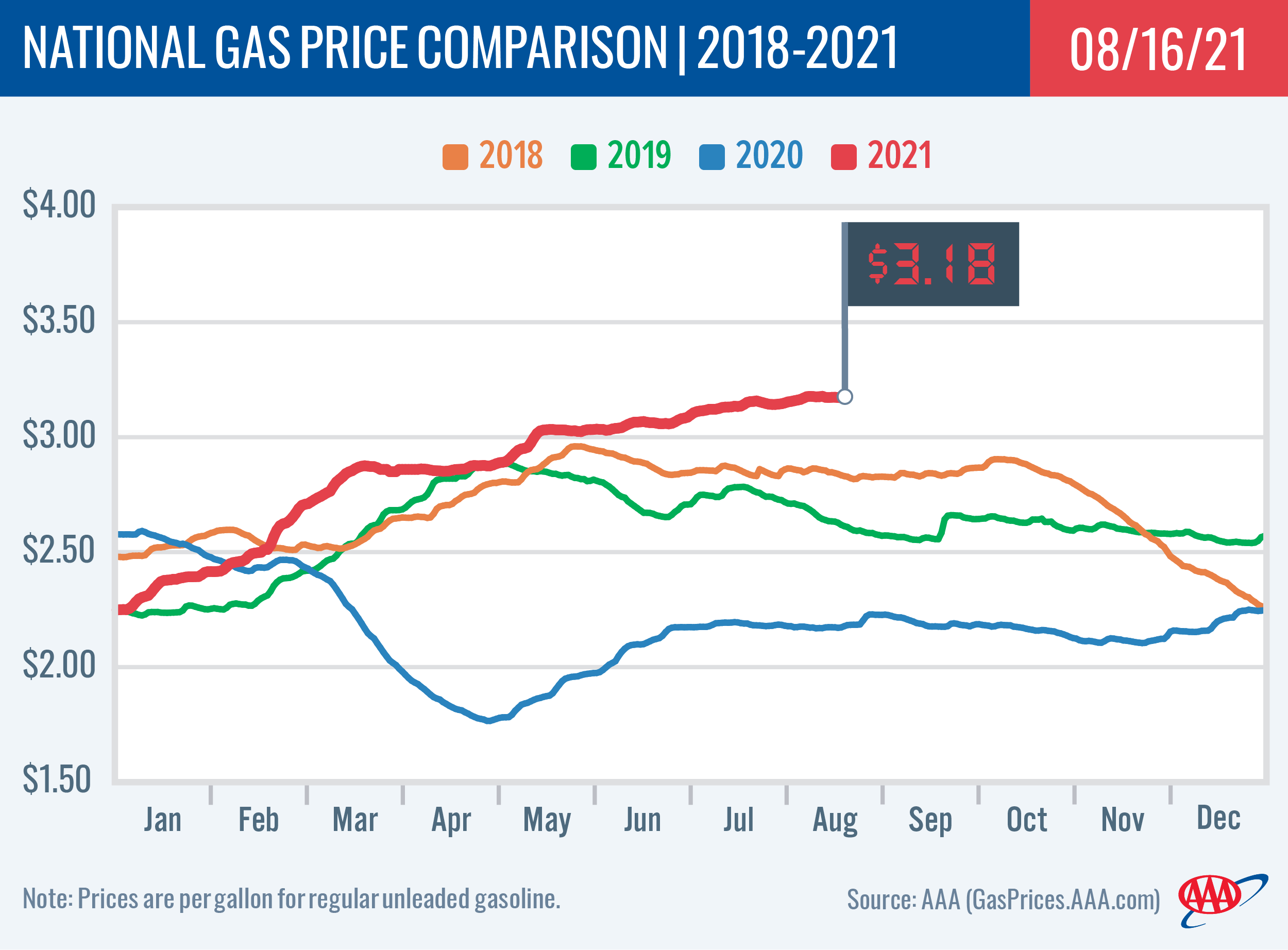
Diesel
For the week, the national average holds steady at $3.29 a gallon. Oregon’s average gains three cents to $3.72. A year ago the national average for diesel was $2.42 and the Oregon average was $2.61.
Find current fuel prices at GasPrices.AAA.com.
AAA news releases, high resolution images, broadcast-quality video, fact sheets and podcasts are available on the AAA NewsRoom at NewsRoom.AAA.com.
Find local news releases at https://oregon.aaa.com/community/media/media-contacts.html
Fuel prices are updated daily at AAA’s Daily Fuel Gauge at AAA Gas Prices. For more info go www.AAA.com. AAA Oregon/Idaho provides more than 850,000 members with travel, insurance, financial and automotive-related services, and is an affiliate of AAA National, serving more than 62 million motorists in North America.
Updated 8/10/2021
Crude, Pump Prices Fluctuate but Remain High
PORTLAND, Ore., – Pump prices are fluctuating across the country with states seeing as much as a five-cent jump to a seven-cent decrease. In Oregon, prices are not showing as much movement. For the week, the national average for regular ticks up half a cent to $3.19 a gallon. The Oregon average adds two cents to $3.76.
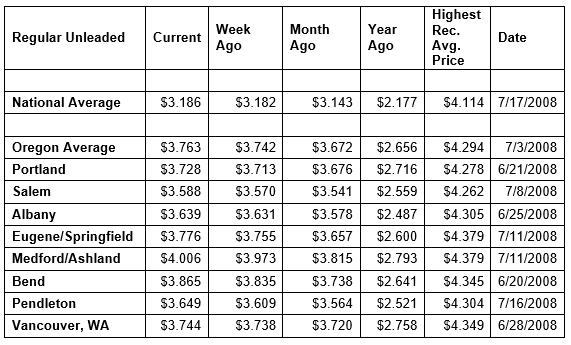
Crude oil prices dropped below $70/bbl at the end of last week and remain below that threshold to start this week due to market concerns about the delta variant, growing COVID case numbers around the world, and the possibility of potential restrictions. While crude is a little cheaper, Oregon gas prices will likely remain high in August.
The fluctuation in gas prices across the country is partly due to an increase in demand for gasoline with a decrease in stocks. The latest report from the U.S. Energy Information Administration (EIA) shows strong demand at nearly 9.8 million b/d, up from 9.3 million b/d the previous week. At this time in 2019, demand was at about 9.6 million b/d.
“We continue to see very robust gasoline demand for the peak summer driving season. The latest demand numbers are 2% higher than the same time period in 2019, while gasoline stocks are about 1% lower,” says Marie Dodds, public affairs director for AAA Oregon/Idaho. “Even with falling crude oil prices, Oregon gas prices are poised to main high in August.”
AAA members can save at the pump by joining the Fuel Rewards at Shell program at AAA.com/Shell. Members save 30 cents per gallon on their first fill-up when they join between now and August 31, 2021. As part of the Fuel Rewards program, AAA Members earn Gold Status ongoing and save five cents per gallon every day on each individual gas purchase of up to 20 gallons from participating Shell stations with no minimum fill ups.
With cases of COVID-19 surging across the U.S., that could have an impact on travel and gasoline consumption. Visit AAA.com/covidmap for an interactive map with the latest travel information. Find AAA’s latest COVID-19 information for travelers here.
Quick stats
Oregon is one of 31 states with higher prices now than a week ago. Colorado (+5 cents) has the largest weekly increase in the country. Delaware (-7 cents) has the biggest week-over-week decline. Averages in Arizona and the District of Columbia are flat.
California ($4.39) and Hawaii ($4.09) continue to have the most expensive gas prices in the country and are the only states with averages above $4 a gallon, and 35 states and the District of Columbia are above $3, up from 34 states and D.C. a week ago.
The cheapest gas in the nation is in Mississippi ($2.79) and Louisiana ($2.82). For the 31st week in a row, no state has an average below $2 a gallon.
Oregon is one of 48 states and the District of Columbia with higher prices now than a month ago. The national average is four cents more and the Oregon average is nine cents more than a month ago. This is the 10th-largest month-over-month increase in the nation. Nevada (+26 cents) has the largest monthly increase in the country. West Virginia (-2 cents) has the largest month-over-month decrease.
All 50 states and the District of Columbia have higher prices now than a year ago, and 21 states including Oregon and the District of Columbia have a current average that’s a dollar or more higher than a year ago. The national average is $1.01 more and the Oregon average is $1.11 more than a year ago. This is the eighth-largest yearly increase in the nation. Utah (+$1.41) has the biggest yearly increase. Delaware (+78 cents) has the smallest year-over-year increase. Compared to a year ago, gas prices are significantly more as travel restrictions were in place due to the coronavirus pandemic.
West Coast
The West Coast region continues to have the most expensive pump prices in the nation with every state in the region except Arizona in the top 10.
| Rank | Region | Price on 8/10/21 | ||
| 1 | California | $4.39 | ||
| 2 | Hawaii | $4.09 | ||
| 3 | Nevada | $4.05 | ||
| 4 | Washington | $3.88 | ||
| 5 | Utah | $3.87 | ||
| 6 | Idaho | $3.81 | ||
| 7 | Oregon | $3.76 | ||
| 8 | Alaska | $3.68 | ||
| 9 | Colorado | $3.64 | ||
| 10 | Wyoming | $3.58 |
California is the most expensive state for the 29th week in a row with Hawaii, Nevada and Washington rounding out the top four. Oregon is seventh, Alaska is eighth and Arizona is 21st. Oregon is seventh for the third week in a row.
All seven states in the West Coast region are among the 35 states in the country, along with D.C., that have averages above $3 a gallon.
Pump prices in the West Coast region are showing little movement this week. Alaska (+2 cents) and Oregon (+2 cents) have the largest weekly increases in the region. The average in Arizona is flat.
The refinery utilization rate has increased slightly in the West Coast region this week to nearly 86%. The rate has been between 85% and 88% much of the summer after remaining between about 82% and 84% this spring.
According to EIA’s latest weekly report, total gas stocks in the region rose to 30.08 million bbl from 30.02 million bbl last week. This may help moderate pump prices in the region this week.
Oil market dynamics
Crude oil prices tumbled last week due to a stronger dollar and market concerns about the impact of new coronavirus infections on demand for crude. Crude prices also declined after the EIA’s latest report showed that total domestic crude stocks increased by 3.6 million bbl to 439.2 million bbl. For this week, crude prices could decrease further if the market continues to worry that crude demand will decline as restrictions are imposed to halt transmission of COVID-19.
At the close of Friday’s formal trading session, WTI decreased by 81 cents to settle at $68.28. At the close of Monday’s formal trading session, WTI fell $1.80 to settle at $66.48. Today crude is trading around $68, compared to $71 a week ago. Crude prices are about $25 more than a year ago.
Drivers can find current Oregon gas prices along their route with the free AAA Mobile app for iPhone, iPad and Android. The app can also be used to map a route, find discounts, book a hotel and access AAA roadside assistance. Learn more at AAA.com/mobile.

Diesel
For the week, the national average adds half a cent to $3.29 a gallon. Oregon’s average gains three cents to $3.69. A year ago the national average for diesel was $2.43 and the Oregon average was $2.62.
Find current fuel prices at GasPrices.AAA.com.
AAA news releases, high resolution images, broadcast-quality video, fact sheets and podcasts are available on the AAA NewsRoom at NewsRoom.AAA.com.
Find local news releases at https://oregon.aaa.com/community/media/media-contacts.html
Fuel prices are updated daily at AAA’s Daily Fuel Gauge at AAA Gas Prices. For more info go www.AAA.com. AAA Oregon/Idaho provides more than 850,000 members with travel, insurance, financial and automotive-related services, and is an affiliate of AAA National, serving more than 62 million motorists in North America.
Updated 8/3/2021
Oregonians paying 43 cents more per gallon since May
PORTLAND, Ore., – Pump prices have steadily climbed in the last three months and Oregonians are paying, on average, 43 cents more per gallon since early May. Nationally, drivers are paying an average of 28 cents more since early May. The beginning of August will likely be as expensive as July. For the week, the national average for regular adds two cents to $3.18 a gallon. The Oregon average rises three cents to $3.74.

The Oregon average was $3.31 three months ago on May 3, while the national average was $2.90.
“Pump prices in August could prove to be even more expensive if crude oil prices rise,” says Marie Dodds, public affairs director for AAA Oregon/Idaho. “An increase in global crude production is expected this month as OPEC (Organization of the Petroleum Exporting Countries) has said they will increase their crude output. However, even with the additional supply, global demand could outpace global supply and keep prices high.”
Demand for gasoline in the U.S. remains high at about 9.3 million barrels per day, just slightly lower than the 9.6 million barrels per day consumed in July 2019, prior to the pandemic.
With most states seeing the number of COVID-19 cases rising, that could have an impact on travel and consumption. Visit AAA.com/covidmap for an interactive map with the latest travel information. Find AAA’s latest COVID-19 information for travelers here.
Quick stats
Oregon is one of 48 states and the District of Columbia with higher prices now than a week ago. All increases are six cents or less. Nevada (+6 cents) and Montana (+6 cents) have the largest weekly increases in the country. West Virginia (-1/2 cent) and Ohio (-4/10ths of a cent) are the only two states with weekly declines.
California ($4.38) and Hawaii ($4.09) continue to have the most expensive gas prices in the country and are the only states with averages above $4 a gallon, and 34 states and the District of Columbia are above $3, up from 31 states and D.C. a week ago.
The cheapest gas in the nation is in Mississippi ($2.79) and Louisiana ($2.82). For the 30th week in a row, no state has an average below $2 a gallon.
Oregon is one of 47 states and the District of Columbia with higher prices now than a month ago. The national average is six cents more and the Oregon average is 10 cents more than a month ago. This is the ninth-largest month-over-month increase in the nation. Idaho (+31 cents) has the largest monthly increase in the country. Ohio (-3 cents) has the largest month-over-month decrease.
All 50 states and the District of Columbia have higher prices now than a year ago, and 18 states including Oregon have a current average that’s a dollar or more higher than a year ago. The national average is $1.00 more and the Oregon average is $1.08 more than a year ago. This is the ninth-largest yearly increase in the nation. Utah (+$1.51) has the biggest yearly increase. Arizona (+78 cents) has the smallest year-over-year increase. Compared to a year ago, gas prices are significantly more as travel restrictions were in place due to the coronavirus pandemic.
West Coast
The West Coast region continues to have the most expensive pump prices in the nation with every state in the region except Arizona in the top 10.
| Rank | Region | Price on 8/3/21 | ||
| 1 | California | $4.38 | ||
| 2 | Hawaii | $4.09 | ||
| 3 | Nevada | $4.02 | ||
| 4 | Utah | $3.88 | ||
| 5 | Washington | $3.86 | ||
| 6 | Idaho | $3.80 | ||
| 7 | Oregon | $3.74 | ||
| 8 | Alaska | $3.66 | ||
| 9 | Colorado | $3.59 | ||
| 10 | Wyoming | $3.55 |
California is the most expensive state for the 28th week in a row with Hawaii and Nevada rounding out the top three. Washington is fifth, Oregon is seventh, Alaska is eighth and Arizona is 21st. Oregon is seventh for the second week in a row.
All seven states in the West Coast region are among the 34 states in the country, along with D.C., that have averages above $3 a gallon.
Like most other states, the states in the West Coast region are seeing small to moderate changes in pump prices this week. Nevada (+6 cents) has the largest weekly increase in the region and the country. Arizona (+3/10ths of a cent) has the smallest week-over-week increase.
The refinery utilization rate has held steady in the West Coast region this week at about 85%. The rate has been between 87% and 88% much of the summer after remaining between about 82% and 84% this spring.
According to EIA’s latest weekly report, total gas stocks in the region rose from 29.67 million bbl to 30.02 million bbl last week. This may help moderate pump prices in the region this week.
Oil market dynamics
A weaker dollar helped to push crude prices higher last week, while market concerns surrounding demand recovery continued to grow. Crude prices were also bolstered after the Energy Information Administration’s (EIA) latest report showed that total domestic crude stocks declined by 4.1 million bbl to 435.6 million bbl. For this week, crude prices could climb higher if EIA’s next weekly report shows another decline in total domestic crude supply.
At the close of Friday’s formal trading session, WTI increased by 33 cents to settle at $73.95. At the close of Monday’s formal trading session, WTI fell $2.69 to settle at $71.26. Today crude is trading around $71, compared to $71 a week ago. Crude prices are about $31 more than a year ago.
Drivers can find current Oregon gas prices along their route with the free AAA Mobile app for iPhone, iPad and Android. The app can also be used to map a route, find discounts, book a hotel and access AAA roadside assistance. Learn more at AAA.com/mobile.
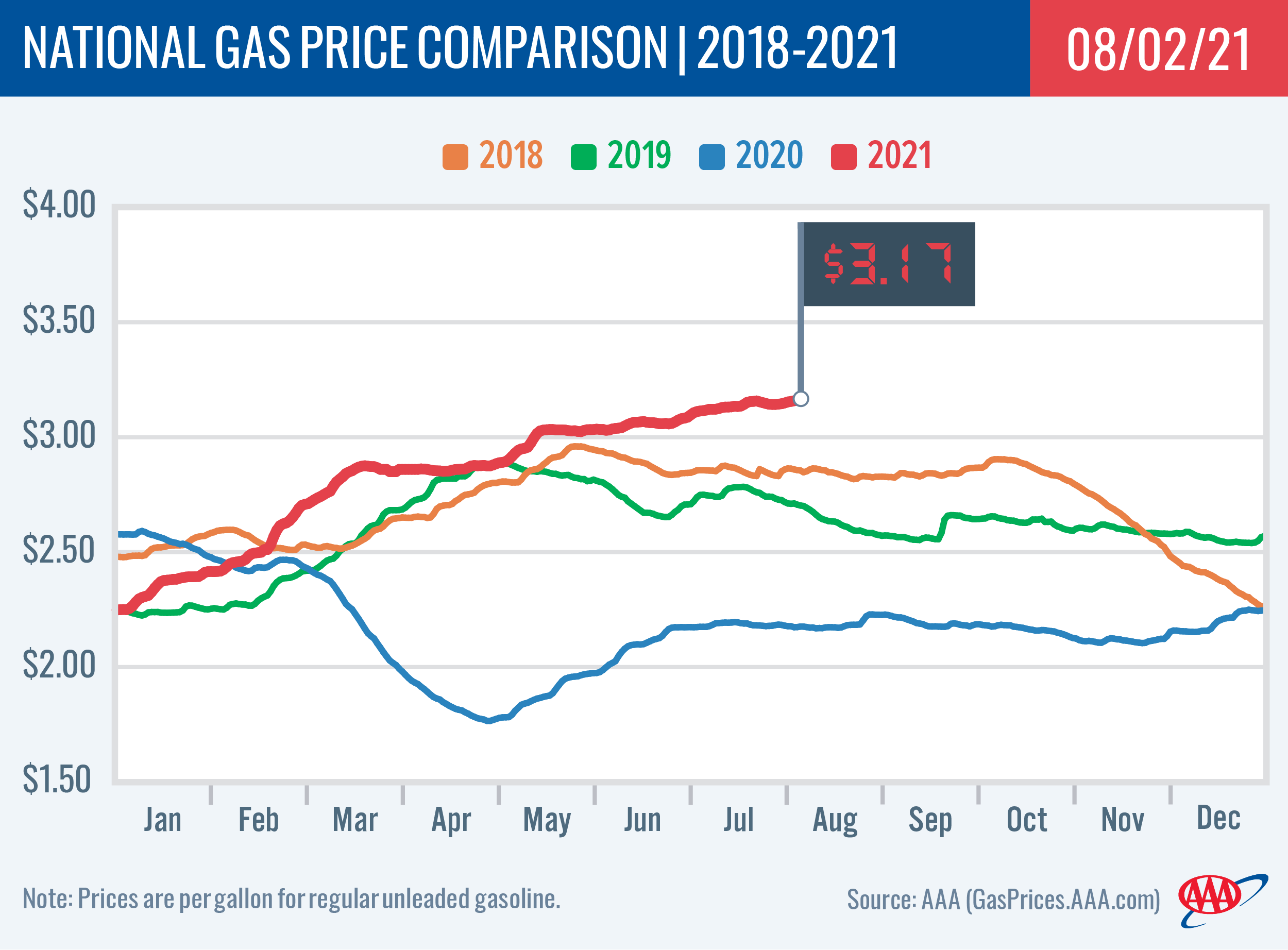
Diesel
For the week, the national average increases two cents to $3.29 a gallon. Oregon’s average gains four cents to $3.65. A year ago the national average for diesel was $2.43 and the Oregon average was $2.62.
Find current fuel prices at GasPrices.AAA.com.
AAA news releases, high resolution images, broadcast-quality video, fact sheets and podcasts are available on the AAA NewsRoom at NewsRoom.AAA.com.
Find local news releases at https://oregon.aaa.com/community/media/media-contacts.html
Fuel prices are updated daily at AAA’s Daily Fuel Gauge at AAA Gas Prices. For more info go www.AAA.com. AAA Oregon/Idaho provides more than 850,000 members with travel, insurance, financial and automotive-related services, and is an affiliate of AAA National, serving more than 62 million motorists in North America.
July Oregon Gas Price News
Updated 7/27/2021
Pump Price Hikes Ease
PORTLAND, Ore., – Retail gas prices are showing little movement this week, with most states, including Oregon, seeing their averages changing by a nickel or less. But it’s too early to say if prices are close to peaking for the summer. For the week, the national average for regular edges down a penny to $3.16 a gallon. The Oregon average ticks up a penny to $3.71.
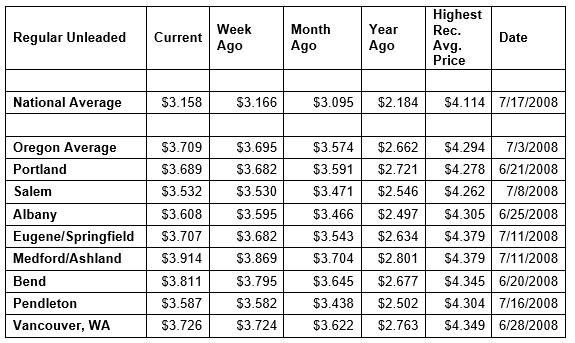
Factors helping pump prices settle are stable supply and demand numbers. U.S. gasoline demand remained relatively flat on the week at nearly 9.3 million b/d according to the latest report from the U.S. Energy Information Administration (EIA). Stocks are also relatively flat on the week at 236.4 million bbl.
At this point, it is too early to say if cheaper pump prices are on the way. Part of the unknown is due to fluctuating crude prices, which dropped to a low of $66/bbl last Monday, but were back over $70/bbl by the end of the week and have remained above $70 to start this week. Prices initially dropped following news from the Organization of the Petroleum Exporting Countries (OPEC) that they have reached a deal to increase production in August. However, that promise has been compromised by concerns about the rise in COVID case numbers and how that could negatively affect global demand.
“For pump prices to trend cheaper, OPEC will need to follow through with their production increases, crude oil will need to sell consistently at lower prices and the market will need to adjust to the potential resurgence of COVID cases,” says Marie Dodds, public affairs director for AAA Oregon/Idaho. “If all of this happens, Oregon gas prices could be less expensive in August.”
With most states seeing the number of COVID-19 cases rising, that could have an impact on travel. Visit AAA.com/covidmap for an interactive map with the latest travel information. Find AAA’s latest COVID-19 information for travelers here.
Quick stats
Oregon is one of 46 states and the District of Columbia where prices changed by a nickel or less. Idaho (+8 cents) has the largest weekly increase in the country. Ohio (-6 cents) has the largest weekly decline. The averages in Virginia and Washington are flat week-over-week.
California ($4.33) and Hawaii ($4.08) continue to have the most expensive gas prices in the country and are the only states with averages above $4 a gallon, and 31 states and the District of Columbia are above $3, down from 32 states and D.C. a week ago.
The cheapest gas in the nation is in Mississippi ($2.78) and Louisiana ($2.81). For the 29th week in a row, no state has an average below $2 a gallon.
All 50 states and the District of Columbia have higher prices now than a month ago. The national average is six cents more and the Oregon average is 14 cents more than a month ago. This is the eighth-largest month-over-month increase in the nation. Utah (+40 cents) has the largest monthly increase in the country. Indiana (+4/10ths of a cent) has the smallest.
All 50 states and the District of Columbia have higher prices now than a year ago, and 12 states including Oregon have a current average that’s a dollar or more higher than a year ago. The national average is 97 cents more and the Oregon average is $1.04 more than a year ago. This is the ninth-largest yearly increase in the nation. Utah (+$1.59) has the biggest yearly increase. Delaware (+74 cents) has the smallest year-over-year increase. Compared to a year ago, gas prices are significantly more as travel restrictions were in place due to the coronavirus pandemic.
West Coast
The West Coast region continues to have the most expensive pump prices in the nation with every state in the region except Arizona in the top 10.
| Rank | Region | Price on 7/27/21 | ||
| 1 | California | $4.33 | ||
| 2 | Hawaii | $4.08 | ||
| 3 | Nevada | $3.96 | ||
| 4 | Utah | $3.87 | ||
| 5 | Washington | $3.84 | ||
| 6 | Idaho | $3.75 | ||
| 7 | Oregon | $3.71 | ||
| 8 | Alaska | $3.64 | ||
| 9 | Colorado | $3.54 | ||
| 10 | Wyoming | $3.50 |
California is the most expensive state for the 27th week in a row with Hawaii and Nevada rounding out the top three. Washington is fifth, Oregon is seventh, Alaska is eighth and Arizona is 19th. Oregon falls to seventh after two weeks at sixth.
All seven states in the West Coast region are among the 31 states in the country, along with D.C., that have averages above $3 a gallon.
Like most other states, the states in the West Coast region are seeing small changes in pump prices this week. Oregon (+1 cent) has the largest weekly increase in the region. Arizona (-1 cent) has the largest week-over-week decline. The average in Washington is flat.
The refinery utilization rate has decreased in the West Coast region, falling from 87% to 85% this week. The rate has been between 87% and 88% this summer after remaining between about 82% and 84% this spring.
According to EIA’s latest weekly report, total gas stocks in the region rose to 29.67 million bbl from 28.99 million bbl last week. This may help moderate pump prices in the region this week barring any glitches in supplies.
Oil market dynamics
Although crude prices tumbled last week to $66 per barrel due to market concerns that the spread of the COVID-19 Delta variant will slow potential economic growth and demand, market concern about the ongoing pandemic reversed by the end of the week and pushed crude prices higher. Prices increased despite the Energy Information Administration reporting that total domestic crude inventories rose by 2.1 million bbl to 439.7 million bbl and plans by OPEC to increase production next month. For this week, crude prices could decline if market concerns about demand grow.
At the close of Friday’s formal trading session, WTI increased by 16 cents to settle at $72.07. At the close of Monday’s formal trading session, WTI slipped 16 cents to settle at $71.91. Today crude is trading around $71, compared to $67 a week ago. Crude prices are about $31 more than a year ago.
Drivers can find current Oregon gas prices along their route with the free AAA Mobile app for iPhone, iPad and Android. The app can also be used to map a route, find discounts, book a hotel and access AAA roadside assistance. Learn more at AAA.com/mobile.
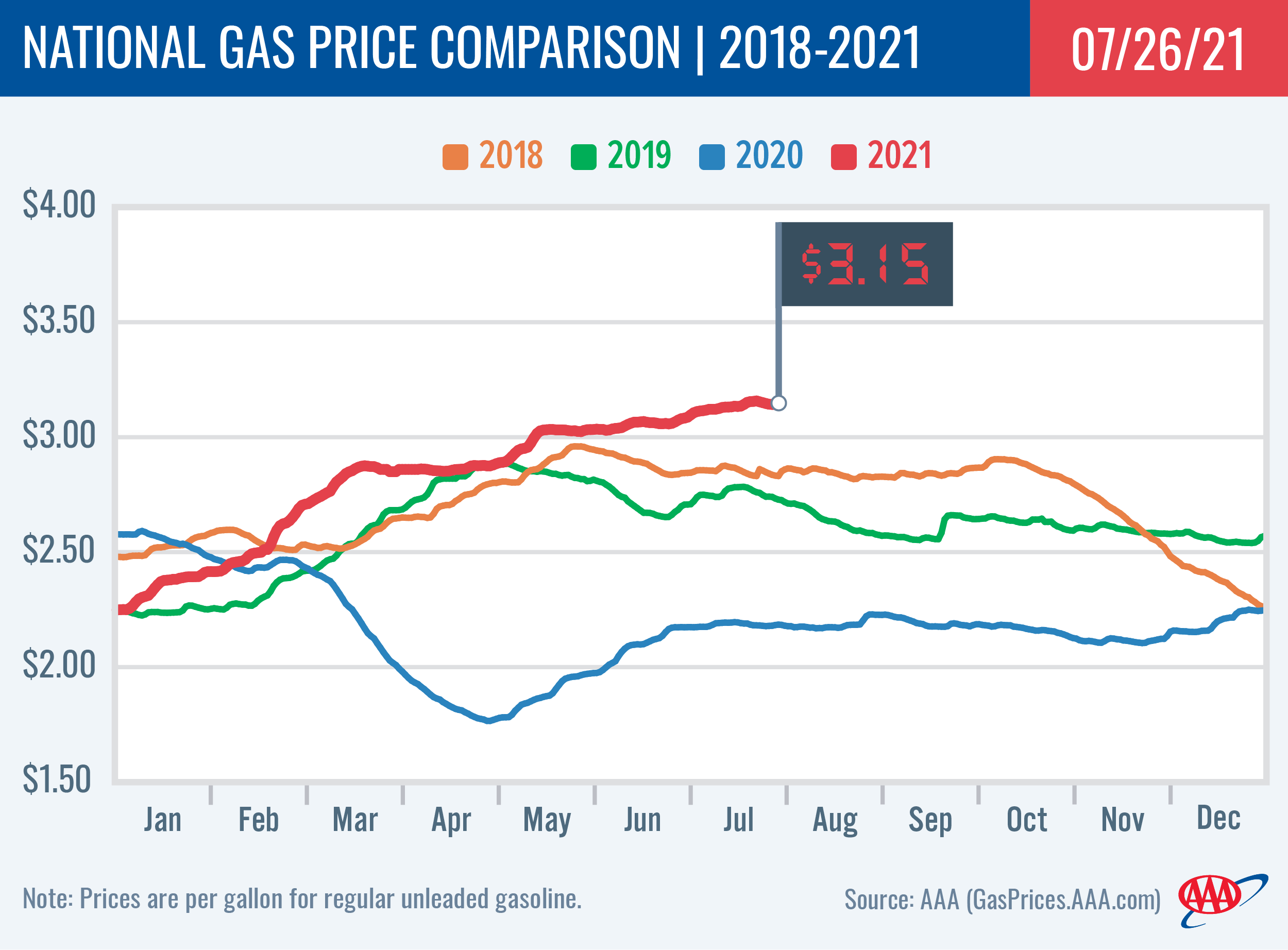
Diesel
For the week, the national average remains at $3.27 a gallon. Oregon’s average gains three cents to $3.61. A year ago the national average for diesel was $2.43 and the Oregon average was $2.62.
Find current fuel prices at GasPrices.AAA.com.
AAA news releases, high resolution images, broadcast-quality video, fact sheets and podcasts are available on the AAA NewsRoom at NewsRoom.AAA.com.
Find local news releases at https://oregon.aaa.com/community/media/media-contacts.html
Fuel prices are updated daily at AAA’s Daily Fuel Gauge at AAA Gas Prices. For more info go www.AAA.com. AAA Oregon/Idaho provides more than 850,000 members with travel, insurance, financial and automotive-related services, and is an affiliate of AAA National, serving more than 62 million motorists in North America.
Updated 7/20/2021
Cruel Summer at Gas Pumps
Oregon average jumps 27 cents, national average 12 cents since Memorial Day
PORTLAND, Ore., – Pump prices continue to climb, although the rate of increase is slowing down. Oregon and most other states have weekly increases of less than a nickel. For the week, the national average for regular ticks up two cents to $3.17 a gallon. The Oregon average also adds two cents to $3.70.
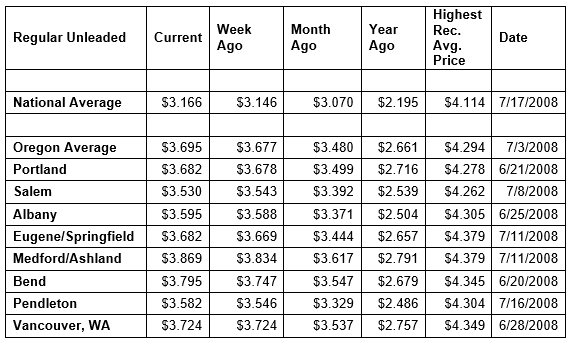
Prices have jumped since Memorial Day. The Oregon average has shot up 27 cents since then, while the national average has climbed 12 cents since the holiday. This summer pump prices are the highest they’ve been in seven years. At this time in July in 2014, the national average was $3.57 and the Oregon average was $3.95.
One of the major drivers of more expensive Oregon gas prices this summer is high crude oil prices. However, crude prices plunged to start this week, falling $5 per barrel to $66/bbl. This summer crude has been fluctuating from a high of $75/bbl down to $71/bbl. Rising COVID-19 cases around the world, plus news from the Organization of the Petroleum Exporting Countries (OPEC) that they have reached a deal to increase production in August, have sent crude prices below $70/bbl. Regardless, AAA expects higher pump prices to be the norm throughout the summer.
“It’s a cruel summer at the gas pumps with prices at their highest in seven years,” says Marie Dodds, public affairs director for AAA Oregon/Idaho. “However, the expensive prices aren’t keeping drivers from filling up as demand for gas in the U.S. remains strong, at more than 9 million barrels a day.”
While gas demand dipped to 9.28 million b/d from 10 million b/d last week, in the U.S. Energy Information Administration’s (EIA) latest report, the rate is strong for summer. The EIA report also shows gasoline stocks increased by 1 million bbl to 236.5 million. The jump in supply and drop in demand mitigated fluctuation in pump prices this week.
As pump prices continue to increase, AAA members can save at the pump by joining the Fuel Rewards at Shell program at AAA.com/Shell. Members save 30 cents per gallon on their first fill-up when they join between now and August 31, 2021. As part of the Fuel Rewards program, AAA Members earn Gold Status ongoing and save five cents per gallon every day on each individual gas purchase of up to 20 gallons from participating Shell stations with no minimum fill ups.
With most states seeing increases in COVID-19 cases this week, that could have an impact on travel. Visit AAA.com/covidmap for an interactive map with the latest travel information. Find AAA’s latest COVID-19 information for travelers here.
Quick stats
Oregon is one of 42 states with higher prices week-over-week. Only seven states have a weekly increase of a nickel or more. Ohio (+10 cents) has the largest weekly increase in the country. Indiana (-4 cents) has the largest weekly decline. The average in Rhode Island is the same as a week ago.
California ($4.32) and Hawaii ($4.08) continue to have the most expensive gas prices in the country and are the only states with averages above $4 a gallon, and 32 states and the District of Columbia are above $3, up from 30 states and D.C. a week ago.
The cheapest gas in the nation is in Mississippi ($2.78) and Louisiana ($2.82). For the 28th week in a row, no state has an average below $2 a gallon.
All 50 states and the District of Columbia have higher prices now than a month ago. The national average is 10 cents more and the Oregon average is 22 cents more than a month ago. This is the seventh-largest month-over-month increase in the nation. Utah (+44 cents) has the largest monthly increase in the country. North Carolina (+2 cents) has the smallest.
All 50 states and the District of Columbia have higher prices now than a year ago, and 12 states including Oregon have a current average that’s a dollar or more higher than a year ago. The national average is 97 cents more and the Oregon average is $1.03 more than a year ago. This is the 10th-largest yearly increase in the nation. Utah (+$1.52) has the biggest yearly increase. Delaware (+78 cents) has the smallest year-over-year increase. Compared to a year ago, gas prices are significantly more as travel restrictions were in place due to the coronavirus pandemic.
West Coast
The West Coast region continues to have the most expensive pump prices in the nation with every state in the region except Arizona in the top 10.
| Rank | Region | Price on 7/20/21 | ||
| 1 | California | $4.32 | ||
| 2 | Hawaii | $4.08 | ||
| 3 | Nevada | $3.89 | ||
| 4 | Washington | $3.84 | ||
| 5 | Utah | $3.79 | ||
| 6 | Oregon | $3.70 | ||
| 7 | Idaho | $3.67 | ||
| 8 | Alaska | $3.65 | ||
| 9 | Colorado | $3.53 | ||
| 10 | Wyoming | $3.45 |
California is the most expensive state for the 26th week in a row with Hawaii, Nevada, and Washington rounding out the top four. Oregon is sixth, Alaska is eighth and Arizona is 20th. Oregon is sixth most expensive for the second week in a row.
All seven states in the West Coast region are among the 32 states in the country, along with D.C., that have averages above $3 a gallon.
States in the West Coast region are seeing small increases in pump prices this week. Hawaii (+3 cents has the largest weekly increase in the region. Arizona (+1 cent) and California (+1 cent) have the smallest week-over-week increases.
The refinery utilization rate has increased in the West Coast region after holding steady for much of April and May. It’s been between 87% and 88% this summer after remaining between about 82% and 84% this spring.
According to EIA’s latest weekly report, total gas stocks in the region rose slightly from 28.94 million bbl to 28.99 million bbl last week.
Oil market dynamics
Crude oil prices plunged $5 per barrel Monday, the worst day since March, due to due major factors: the agreement from OPEC+ to boost production by 400,000 barrels a day in August, and rising cases of COVID-19 around the world which could again lead to lower demand for crude. Last week, crude prices fluctuated at the end of the day Friday because of a stronger dollar, but declined on the week due to supply concerns and tension between Saudi Arabia and the United Arab Emirates that prevented OPEC and its allies from reaching a deal to increase crude production. However, under the compromise, OPEC+ will increase daily crude production. The increase is expected to help lower crude prices, assuming it is not met with higher demand. Crude prices could decline more this week due to pandemic concerns and in anticipation of the production increase.
At the close of Friday’s formal trading session, WTI increased by 16 cents to settle at $71.81. At the close of Monday’s formal trading session, WTI plunged $5.39 to settle at $66.42. Today crude is trading around $67, compared to $75 a week ago. Crude prices are about $26 more than a year ago.
Drivers can find current Oregon gas prices along their route with the free AAA Mobile app for iPhone, iPad and Android. The app can also be used to map a route, find discounts, book a hotel and access AAA roadside assistance. Learn more at AAA.com/mobile.
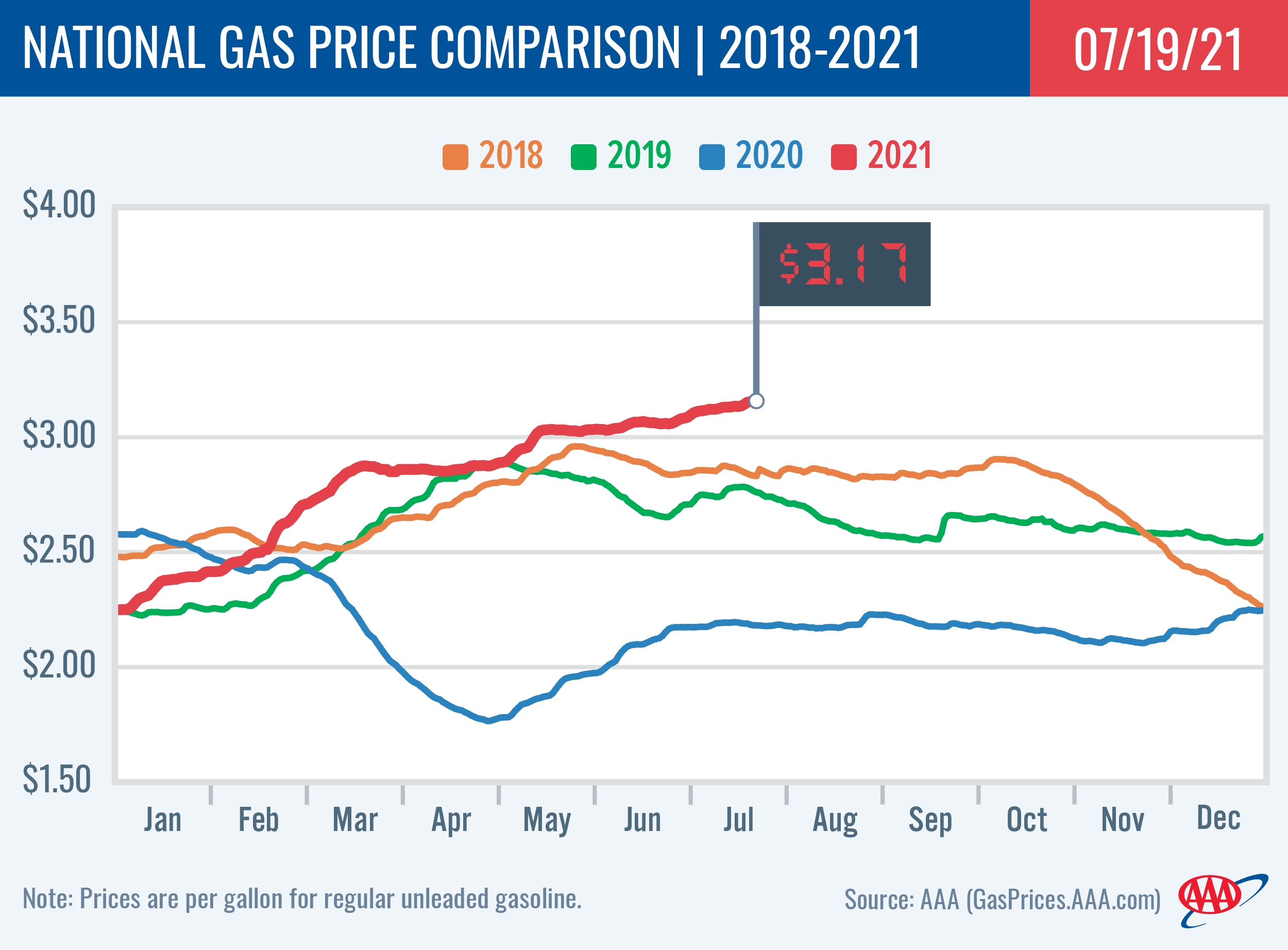
Diesel
For the week, the national average adds a penny to $3.27 a gallon. Oregon’s average gains two cents to $3.58. A year ago the national average for diesel was $2.43 and the Oregon average was $2.62.
Find current fuel prices at GasPrices.AAA.com.
AAA news releases, high resolution images, broadcast-quality video, fact sheets and podcasts are available on the AAA NewsRoom at NewsRoom.AAA.com.
Find local news releases at https://oregon.aaa.com/community/media/media-contacts.html
Fuel prices are updated daily at AAA’s Daily Fuel Gauge at AAA Gas Prices. For more info go www.AAA.com. AAA Oregon/Idaho provides more than 850,000 members with travel, insurance, financial and automotive-related services, and is an affiliate of AAA National, serving more than 62 million motorists in North America.
Updated 7/13/2021
Gasoline Demand Soars to Record High
Pump prices climb as road trip season kicks into high gear
PORTLAND, Ore., – Demand for gasoline in the U.S. is at a record high of 10 million b/d. The surge in demand along with higher crude oil prices are sending pump prices higher in all but seven states. For the week, the national average for regular edges up a penny to $3.15 a gallon. The Oregon average adds three cents to $3.68.
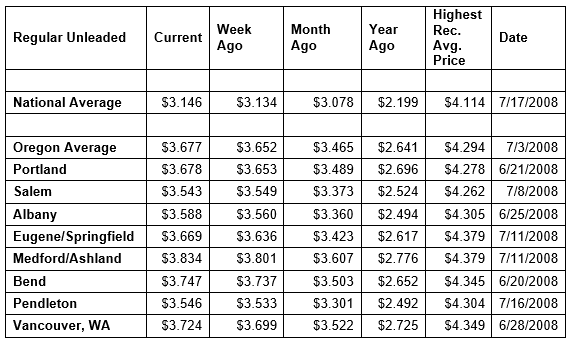
Gasoline demand jumped by nearly 1 million b/d, driving down gasoline supplies by 6.1 million bbl to 235,000 million bbl, for the week ending July 2, according to the latest report from U.S. Energy Information Administration (EIA). The demand reading only partially reflects Independence Day holiday weekend travel. The previous high was more than 9.9 million b/d in August 2019.
The price of crude oil, which fluctuated last week following OPEC’s failure to reach an agreement on production increases, continues to be a dominant factor in determining how high prices will go this summer. Last week ended with higher crude prices than the start, though still under $75/bbl. AAA believes those prices have the potential to increase this week, which will only lead to more expensive pump prices, especially amid robust demand.
“Peak summer driving season is in full swing. Most states including Oregon are fully re-open with pandemic-related restrictions lifted. Americans are returning to normal activities and hitting the road for summer travel. Most drivers are paying about a dollar more a gallon than last summer to fill up,” says Marie Dodds, public affairs director for AAA Oregon/Idaho.
As pump prices continue to increase, AAA members can save at the pump by joining the Fuel Rewards at Shell program at AAA.com/Shell. Members save 30 cents per gallon on their first fill-up when they join between now and August 31, 2021. As part of the Fuel Rewards program, AAA Members earn Gold Status ongoing and save five cents per gallon every day on each individual gas purchase of up to 20 gallons from participating Shell stations with no minimum fill ups.
Visit AAA.com/covidmap for an interactive map with the latest travel information. Find AAA’s latest COVID-19 information for travelers here.
Quick stats
Oregon is one of 43 states and the District of Columbia with higher prices week-over-week. Eight states have a weekly increase of a nickel or more. Utah (+16 cents) has the largest weekly increase in the country. Ohio (-5 cents) has the largest weekly decline.
California ($4.31) and Hawaii ($4.05) continue to have the most expensive gas prices in the country and are the only states with averages above $4 a gallon, and 30 states and the District of Columbia are above $3, up from 29 states and D.C. a week ago.
The cheapest gas in the nation is in Mississippi ($2.77) and Louisiana ($2.80). For the 27th week in a row, no state has an average below $2 a gallon.
Oregon is one of 47 states and the District of Columbia with higher prices now than a month ago. The national average is seven cents more and the Oregon average is 21 cents more than a month ago. This is the seventh-largest month-over-month increase in the nation. Utah (+37 cents) has the largest monthly increase in the country. Ohio (-3 cents) has the largest monthly decline.
All 50 states and the District of Columbia have higher prices now than a year ago, and 10 states including Oregon have a current average that’s a dollar or more higher than a year ago. The national average is 95 cents more and the Oregon average is $1.04 more than a year ago. This is the ninth-largest yearly increase in the nation. Utah (+$1.45) has the biggest yearly increase. Maryland (+75 cents) has the smallest year-over-year increase. Compared to a year ago, gas prices are significantly more as travel restrictions were in place due to the coronavirus pandemic.
West Coast
The West Coast region continues to have the most expensive pump prices in the nation with every state in the region except Arizona in the top 10.
| Rank | Region | Price on 7/13/21 | ||
| 1 | California | $4.31 | ||
| 2 | Hawaii | $4.05 | ||
| 3 | Washington | $3.84 | ||
| 4 | Nevada | $3.80 | ||
| 5 | Utah | $3.74 | ||
| 6 | Oregon | $3.68 | ||
| 7 | Alaska | $3.63 | ||
| 8 | Idaho | $3.60 | ||
| 9 | Colorado | $3.49 | ||
| 10 | Wyoming | $3.40 |
California is the most expensive state for the 25th week in a row with Hawaii, Washington, and Nevada rounding out the top four. Oregon is sixth, Alaska is seventh and Arizona is 20th. After 18 weeks in fifth place, Oregon slips to sixth most expensive.
All seven states in the West Coast region are among the 30 states in the country, along with D.C., that have averages above $3 a gallon.
States in the West Coast region are seeing moderate to small increases in pump prices this week. Alaska (+5 cents has the largest weekly increase in the region. California (+1 cent) and Arizona (+1 cent) have the smallest week-over-week increases.
The refinery utilization rate has increased in the West Coast region after holding steady for much of April and May. It’s at 88% after remaining between about 82% and 84% this spring.
According to EIA’s latest weekly report, total gas stocks in the region decreased to 28.94 million bbl from 29.38 million bbl last week.
Oil market dynamics
Crude prices declined early last week due to a stronger dollar and market concerns about excess crude supply. However, prices increased following the release of EIA’s report that showed total domestic crude inventories decreased by 6.9 million bbl to 445.5 million bbl. If EIA’s next weekly report shows another decline in total domestic crude inventories, prices could climb further this week.
At the close of Friday’s formal trading session, WTI increased by $1.62 cents to settle at $74.56. At the close of Monday’s formal trading session, WTI slipped 46 cents to settle at $74.10. Today crude is trading around $75, compared to $73 a week ago. Crude prices are about $34 more than a year ago.
Drivers can find current Oregon gas prices along their route with the free AAA Mobile app for iPhone, iPad and Android. The app can also be used to map a route, find discounts, book a hotel and access AAA roadside assistance. Learn more at AAA.com/mobile.
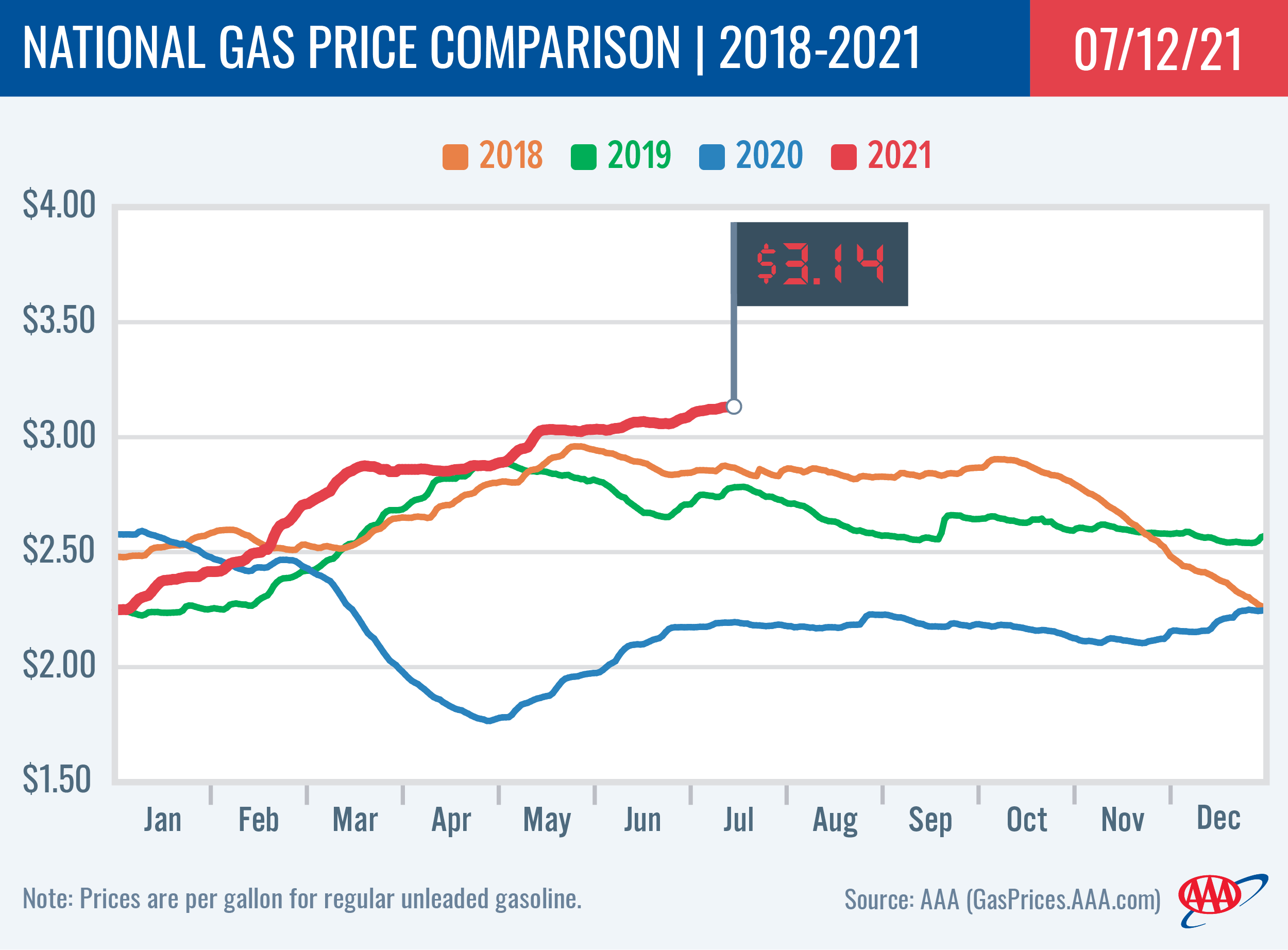
Diesel
For the week, the national average adds a penny to $3.26 a gallon. Oregon’s average climbs three cents to $3.56. A year ago the national average for diesel was $2.44 and the Oregon average was $2.63.
Find current fuel prices at GasPrices.AAA.com.
AAA news releases, high resolution images, broadcast-quality video, fact sheets and podcasts are available on the AAA NewsRoom at NewsRoom.AAA.com.
Find local news releases at https://oregon.aaa.com/community/media/media-contacts.html
Fuel prices are updated daily at AAA’s Daily Fuel Gauge at AAA Gas Prices. For more info go www.AAA.com. AAA Oregon/Idaho provides more than 850,000 members with travel, insurance, financial and automotive-related services, and is an affiliate of AAA National, serving more than 62 million motorists in North America.
June Oregon Gas Price News
Updated 6/29/2021
Independence Day Pump Prices Most Expensive since 2014
AAA Projects 4th of July Travel Boom with Second-Highest Volume on Record
PORTLAND, Ore., – Oregon gas prices are at their highest prices of the year and still climbing leading up to the Independence Day holiday weekend. Road trippers will pay the highest pump prices for the holiday in seven years. For the week, the national average for regular gains four cents to $3.11 a gallon. The Oregon average shoots up a dime to $3.59.
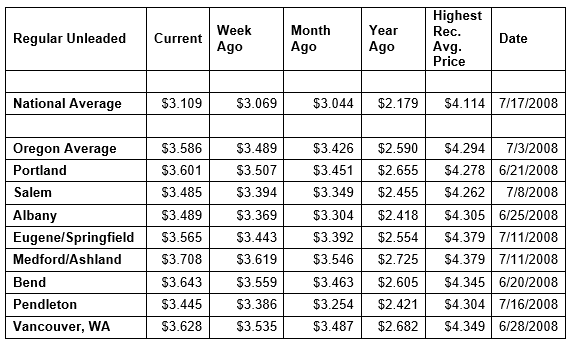
AAA says the travel volume for the 4th of July holiday is back up to pre-pandemic levels with more than 47.7 million including 597,000 Oregonians taking a trip. This will be the second-highest Independence Day travel volume on record, trailing only 2019.
More than 91% of Independence Day travelers will drive to their destinations as road trips continue to dominate this summer. In all, 43.6 million Americans will go by car including 512,000 Oregonians, the highest on record for the holiday.
Find all the details and graphics in the AAA Independence Day travel news release.

While it is typical to see the gas price rise ahead of a holiday, especially during the peak summer driving season, pump price increases as of late have been noticeable. The national average has climbed seven cents and the Oregon average 16 cents in the last month.
The rising pump prices are the result of three factors: confidence in worldwide vaccination rollout, global oil demand spikes, and the easing of travel restrictions leading to optimism for leisure travel. Last week, crude oil sold at $74/bbl, the highest price in nearly three years.
“Drivers can expect little relief at the pumps following the 4th of July holiday. With crude oil prices likely to continue climbing, Oregon gas prices are most likely to see increases through the end of summer,” says Marie Dodds, public affairs director for AAA Oregon/Idaho.
Demand for gasoline in the U.S. continues to trend higher while stocks are declining. Demand increased from 9.36 million b/d to 9.44 million b/d, while total domestic gas stocks decreased by 3 million bbl to 240 million bbl., according to the latest data from the U.S. Energy Information Administration.
Demand continues to be up significantly from a year ago when it was 8.6 million b/d. Many states had travel restrictions and Americans were driving less due to COVID-19.
Visit AAA.com/covidmap for an interactive map with the latest travel restrictions and policies for North America. Find AAA’s latest COVID-19 information for travelers here.
Quick stats
Oregon is one of 48 states and the District of Columbia with higher prices week-over-week. Oregon is one of 22 states with a weekly increase of a nickel or more. Indiana (+11 cents) has the largest weekly increase in the country. Ohio (-1 cent) has the largest weekly decline.
California ($4.28) and Hawaii ($4.01) continue to have the most expensive gas prices in the country. This week Hawaii joins California as the only states with averages above $4 a gallon, and 26 states and the District of Columbia are above $3, up from 20 states and D.C. a week ago.
The cheapest gas in the nation is in Mississippi ($2.74) and Louisiana ($2.75). For the 25th week in a row, no state has an average below $2 a gallon.
Oregon is one of 41 states and the District of Columbia with higher prices now than a month ago. The national average is seven cents more and the Oregon average is 16 cents more than a month ago. This is the sixth-largest month-over-month increase in the nation. Colorado (+28 cents) has the largest monthly increase in the country. Maryland (-3 cents) has the largest monthly decline.
All 50 states and the District of Columbia have higher prices now than a year ago, and seven states have a current average that’s a dollar or more higher than a year ago. The national average is 93 cents more and the Oregon average is 99 cents more than a year ago. This is the ninth-largest yearly increase in the nation. Utah (+$1.26) has the biggest yearly increase. Pennsylvania (+77 cents) has the smallest year-over-year increase. Compared to a year ago, gas prices are very expensive as travel restrictions were in place due to the coronavirus pandemic.
West Coast
The West Coast region continues to have the most expensive pump prices in the nation with every state in the region except Arizona in the top 10.
| Rank | Region | Price on 6/29/21 | ||
| 1 | California | $4.28 | ||
| 2 | Hawaii | $4.01 | ||
| 3 | Washington | $3.74 | ||
| 4 | Nevada | $3.72 | ||
| 5 | Oregon | $3.59 | ||
| 6 | Utah | $3.52 | ||
| 7 | Alaska | $3.48 | ||
| 8 | Idaho | $3.41 | ||
| 9 | Colorado | $3.40 | ||
| 10 | Illinois | $3.32 |
California is the most expensive state for the 23rd week in a row with Hawaii, Washington, Nevada, and Oregon round out the top five. Alaska is seventh. Arizona is 18th. Oregon is fifth for the 17th week in a row.
All seven states in the West Coast region are among the 26 states in the country, along with D.C., that have averages above $3 a gallon.
States in the West Coast region are seeing relatively large increases in pump prices this week. Washington (+10 cents) and Oregon (+10 cents) have the largest weekly increases in the region. Arizona (+1 cent) has the smallest week-over-week increase.
The refinery utilization rate has increased in the West Coast region after holding steady for much of April and May. It’s at 88% after remaining between about 82% and 84% this spring.
According to EIA’s latest weekly report, total gas stocks in the region increased to 29.47 million bbl from 29.42 million bbl last week.
Oil market dynamics
Crude prices increased last week due to optimism that vaccine rollout will continue to help crude demand recover. In fact, the price of crude crossed the $74 per barrel threshold and prices have not been at this level since October 2018. Additionally, crude prices were bolstered by EIA’s latest report revealing that total domestic crude supplies decreased by 7.6 million bbl to 459.1 million bbl. For this week, another reduction in domestic crude supply could push prices up further after EIA’s next weekly report is released.
At the close of Friday’s formal trading session, WTI increased 75 cents to settle at $74.05. At the close of Monday’s formal trading session, WTI fell $1.14 to settle at $72.91. Today crude is trading around $73, compared to $73 a week ago. Crude prices are about $34 more than a year ago.
Drivers can find current Oregon gas prices along their route with the free AAA Mobile app for iPhone, iPad and Android. The app can also be used to map a route, find discounts, book a hotel and access AAA roadside assistance. Learn more at AAA.com/mobile.
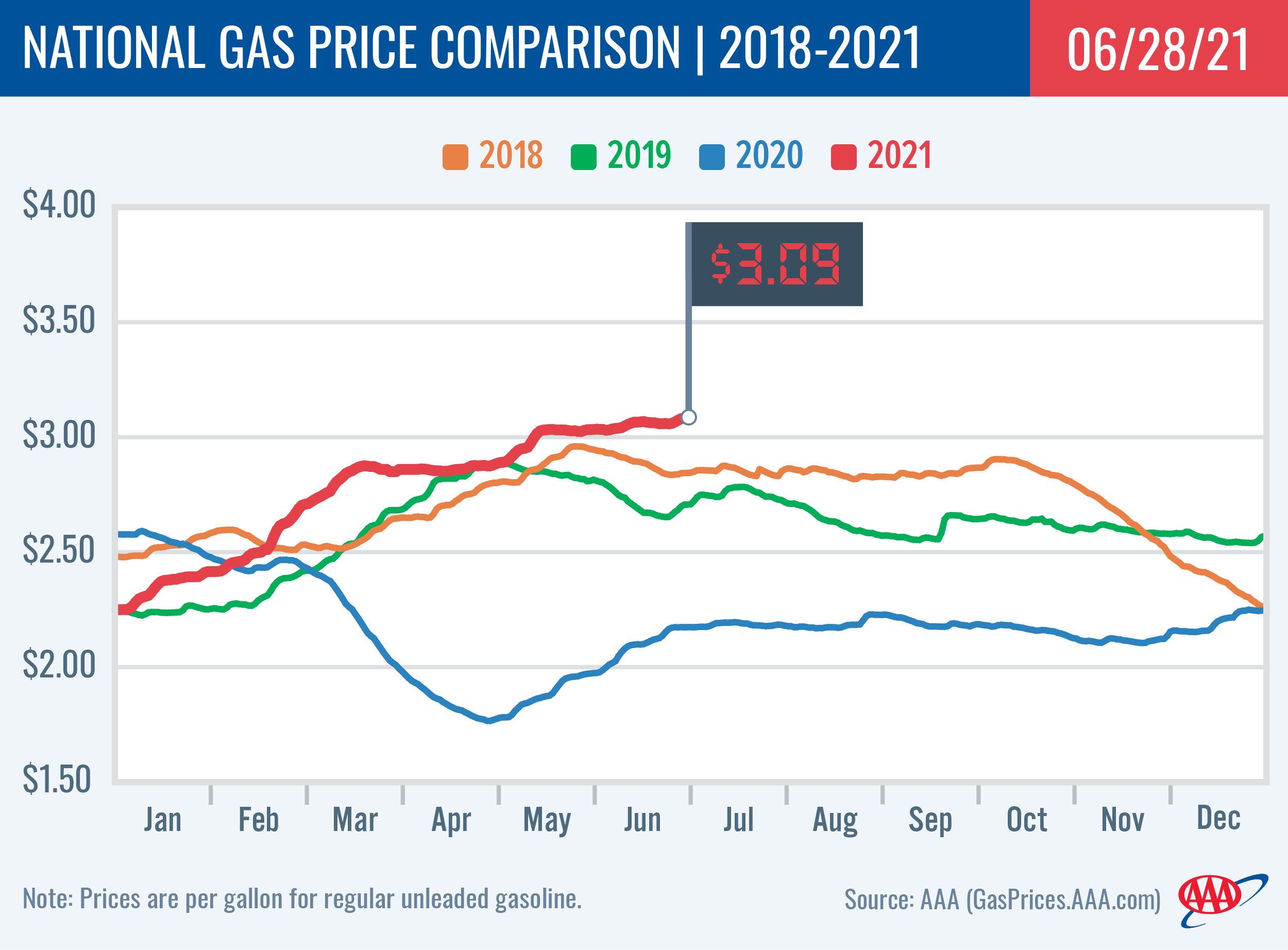
Diesel
For the week, the national average adds two cents to $3.24 a gallon. Oregon’s average jumps seven cents to $3.49. A year ago the national average for diesel was $2.44 and the Oregon average was $2.60.
Find current fuel prices at GasPrices.AAA.com.
AAA news releases, high resolution images, broadcast-quality video, fact sheets and podcasts are available on the AAA NewsRoom at NewsRoom.AAA.com.
Find local news releases at https://oregon.aaa.com/community/media/media-contacts.html
Fuel prices are updated daily at AAA’s Daily Fuel Gauge at AAA Gas Prices. For more info go www.AAA.com. AAA Oregon/Idaho provides more than 850,000 members with travel, insurance, financial and automotive-related services, and is an affiliate of AAA National, serving more than 62 million motorists in North America.
Updated 6/22/2021
Increasing Gasoline Stocks keep Pump Prices in Check
Oregon is one of 44 states where the average changed by three cents or less this week
PORTLAND, Ore., – Growing gasoline stocks in the U.S. are helping to keep gas prices mostly stable in Oregon and across the country. Pump prices either held steady or changed by less than three cents in 44 states including Oregon. For the week, the national average for regular dips a penny to $3.07 a gallon. The Oregon average ticks up two cents to $3.49.

Total gasoline stocks in the U.S. sit at 242.9 million bbl, which is a 9 million bbl surplus compared to the same week in June 2019, according to Energy Information Administration (EIA) data. Stock levels have increased in line with refinery utilization rates, which are up to the highest rate since January 2020.
Demand for gasoline is also trending higher. In EIA’s latest report, demand increased by nearly 1 million b/d to 9.3 million b/d. Demand continues to be up significantly from a year ago when it was 7.9 million b/d. Many states had travel restrictions and Americans were staying home due to COVID-19.
“Despite growing demand, most drivers aren’t seeing skyrocketing pump prices due to rising stock levels, which have shot up over the last four weeks,” says Marie Dodds, public affairs director for AAA Oregon/Idaho.
Last week, crude oil jumped to $72/bbl, but decreased by $2/bbl at Friday’s close. If crude prices trend at this or a lower price point for a sustained period, that would help to minimize jumps at the pumps through the rest of June.
Visit AAA.com/covidmap for an interactive map with the latest travel restrictions and policies for North America. Find AAA’s latest COVID-19 information for travelers here.
Quick stats
Oregon is one of 24 states where prices are higher week-over-week. Most increases are small — only two states have averages that have climbed more than a nickel. Colorado (+7 cents) has the largest weekly increase in the country. Michigan (-5 cents) has the largest weekly decline.
California ($4.24) and Hawaii ($3.98) continue to have the most expensive gas prices in the country. California is the only state with an average above $4 a gallon, and 20 states and the District of Columbia are above $3, up from 19 states and D.C. a week ago.
The cheapest gas in the nation is in Louisiana ($2.72) and Mississippi ($2.72). For the 24th week in a row, no state has an average below $2 a gallon.
Oregon is one of 34 states and the District of Columbia with higher prices now than a month ago. The national average is three cents more and the Oregon average is eight cents more than a month ago. This is the eighth-largest month-over-month increase in the nation. Colorado (+22 cents) has the largest monthly increase in the country. South Carolina (-10 cents) has the largest monthly decline.
All 50 states and the District of Columbia have higher prices now than a year ago, and six states have a current average that’s a dollar or more higher than a year ago. The national average is 94 cents more and the Oregon average is 91 cents more than a year ago. This is the 28th-largest yearly increase in the nation. California (+$1.19) has the biggest yearly increase. Maryland (+80 cents) has the smallest year-over-year increase. Compared to a year ago, gas prices are very expensive as last spring was prime quarantine time across the country.
West Coast
The West Coast region continues to have the most expensive pump prices in the nation with every state in the region except Arizona in the top 10.
| Rank | Region | Price on 6/22/21 | ||
| 1 | California | $4.24 | ||
| 2 | Hawaii | $3.98 | ||
| 3 | Nevada | $3.67 | ||
| 4 | Washington | $3.64 | ||
| 5 | Oregon | $3.49 | ||
| 6 | Utah | $3.42 | ||
| 7 | Alaska | $3.39 | ||
| 8 | Colorado | $3.32 | ||
| 9 | Illinois | $3.32 | ||
| 10 | Idaho | $3.31 |
California is the most expensive state for the 23rd week in a row and is the only state in the nation with an average above $4 per gallon. Hawaii, Nevada, Washington, and Oregon round out the top five. Alaska is seventh. Arizona is 16th. Oregon is fifth for the 16th week in a row.
All seven states in the West Coast region are among the 20 states in the country, along with D.C., that have averages above $3 a gallon.
States in the West Coast region are seeing relatively small changes in pump prices this week, like most other states. Alaska (+2 cents) and Oregon (+2 cents) have the largest weekly increases in the region. Hawaii (+1 cent) has the smallest week-over-week increase. Arizona (-1/2 cent) is the only state in the region with a weekly decline.
The refinery utilization rate has increased in the West Coast region after holding steady for much of April and May. It’s at 87% after remaining between about 82% and 84% this spring.
According to EIA’s latest weekly report, total gas stocks in the region increased from 29.19 million bbl to 29.42 million bbl last week. This should help keep pump prices fairly steady in the region this week.
Oil market dynamics
Although a stronger dollar helped to limit price gains at the end of the week, crude prices fluctuated last week, between $70 and $72/bbl, due to optimism that vaccine rollout will continue to help crude demand recover. Additionally, EIA’s latest report, revealing that total domestic crude supplies decreased by 7.4 million bbl to 466.7 million bbl last week, helped to bolster crude prices. For this week, crude prices jumped to start the week and prices could continue to climb, especially if EIA’s next weekly report shows another decline in total domestic crude supply.
At the close of Friday’s formal trading session, WTI increased 60 cents to settle at $71.64. At the close of Monday’s formal trading session, WTI shot up $2.02 to settle at $73.66. Today crude is trading around $73, compared to $72 a week ago. Crude prices are about $34 more than a year ago.
Drivers can find current Oregon gas prices along their route with the free AAA Mobile app for iPhone, iPad and Android. The app can also be used to map a route, find discounts, book a hotel and access AAA roadside assistance. Learn more at AAA.com/mobile.
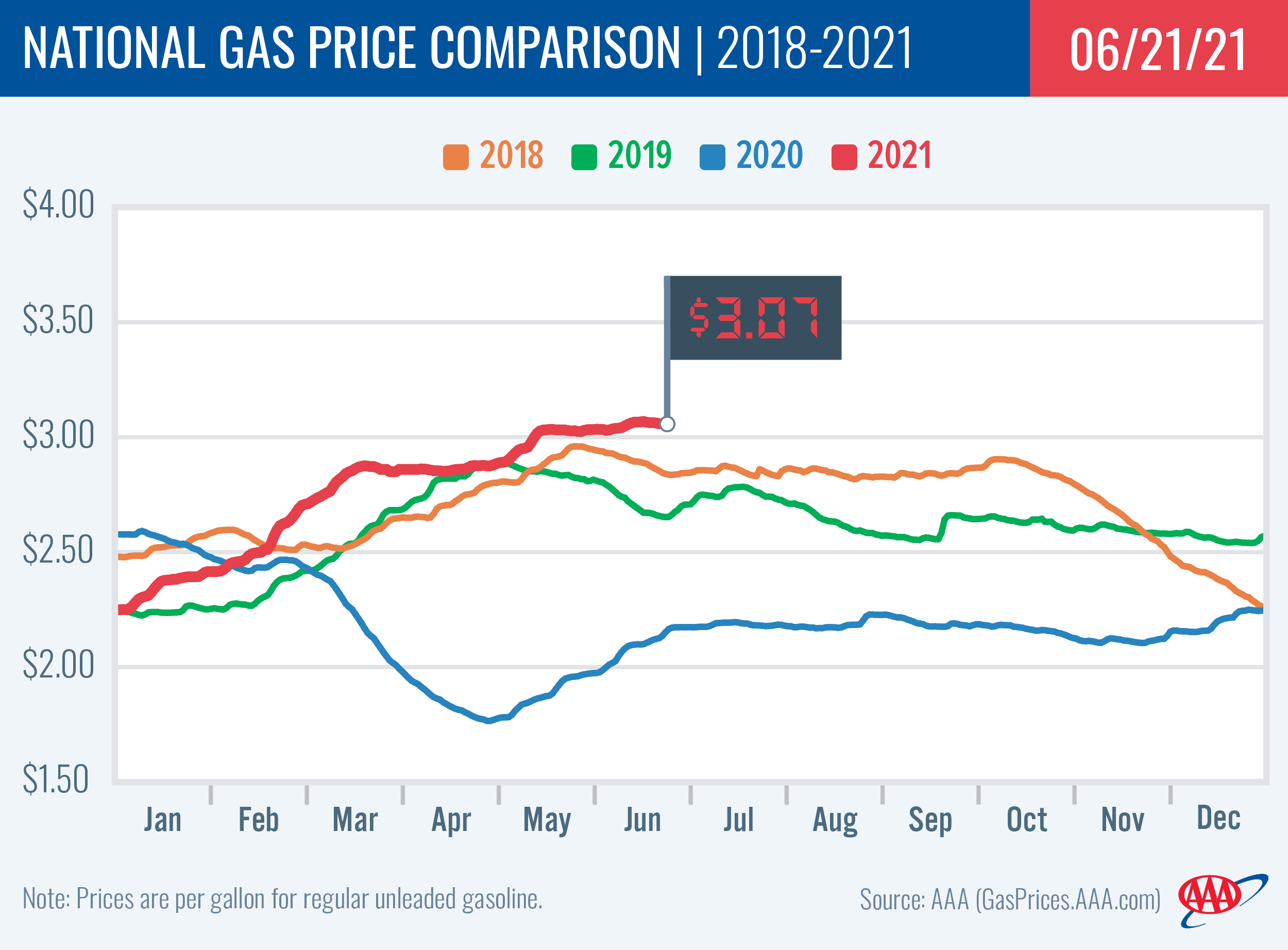
Diesel
For the week, the national average gains half a cent to $3.22 a gallon. Oregon’s average adds two cents to $3.42. A year ago the national average for diesel was $2.43 and the Oregon average was $2.60.
Find current fuel prices at GasPrices.AAA.com.
AAA news releases, high resolution images, broadcast-quality video, fact sheets and podcasts are available on the AAA NewsRoom at NewsRoom.AAA.com.
Find local news releases at https://oregon.aaa.com/community/media/media-contacts.html
Fuel prices are updated daily at AAA’s Daily Fuel Gauge at AAA Gas Prices. For more info go www.AAA.com. AAA Oregon/Idaho provides more than 850,000 members with travel, insurance, financial and automotive-related services, and is an affiliate of AAA National, serving more than 62 million motorists in North America.
Updated 6/8/2021
Another Week of Small Changes in Pump Prices
Oregon is one of 41 states where the average changed by three cents or less
PORTLAND, Ore., – Retail gas prices are showing minimal movement again this week with pump prices changing by three cents or less in 41 states including Oregon. For the week, the national average for regular adds one-and-a-half cents to $3.06 a gallon. The Oregon average gains two cents to $3.45.
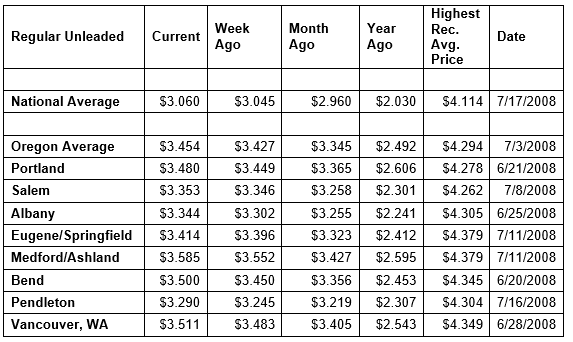
Pump prices are poised to fluctuate in the coming week due to rising crude oil prices along with a drop in demand and increase in supply.
Demand for gasoline in the U.S. fell from 9.5 million b/d to 9.2 million b/d for the week ending May 28 according to the U.S. Energy Information Administration (EIA). Total gasoline stocks increased to nearly 234 million bbl as U.S. refinery utilization jumped to 88.7%—the highest rate since February 2020. The next report will likely see demand jump since it will reflect Memorial Day holiday weekend travel.
Demand continues to be up significantly from a year ago when it was 7.5 million b/d. Many states were under lockdowns and Americans were staying home due to COVID-19.
Last week, crude prices increased to their highest price point ($69/bbl) in 2.5 years. Since crude accounts for more than 50% of the price at the pump, when it goes up, so does the price drivers pay. What is promising is that crude may not sustain at this level. The Organization of the Petroleum Exporting Countries (OPEC), and its allies including Russia, announced last week they still plan to gradually increase crude production in July. If they do increase production, this could lead to a decrease in crude oil prices, which is good news for motorists.
“Drivers can expect pump prices to fluctuate over the next few weeks, depending on supply, demand, the price of crude, and U.S. refinery utilization rates,” says Marie Dodds, public affairs director for AAA Oregon/Idaho.
Visit AAA.com/covidmap for an interactive map with the latest travel restrictions and policies for North America. Find AAA’s latest COVID-19 information for travelers here.
Quick stats
Oregon is one of 41 states and the District of Columbia where prices are higher week-over-week. Most increases are relatively small—all but three states have increases of a nickel or less. Indiana (+9 cents) has the largest weekly increase in the country. Michigan (-3 cents) has the largest weekly decline.
California ($4.22) and Hawaii ($3.95) continue to have the most expensive gas prices in the country. California is the only state with an average above $4 a gallon, and 20 states and the District of Columbia are above $3, up from 18 states and D.C. a week ago.
The cheapest gas in the nation can be found in Louisiana ($2.71) and Mississippi ($2.72). For the 22nd week in a row, no state has an average below $2 a gallon.
All 50 states and the District of Columbia have higher prices now than a month ago. The national average is 10 cents more and the Oregon average is 11 cents more than a month ago. This is the 19th-largest month-over-month increase in the nation. Colorado (+18 cents) has the largest monthly increase in the country. South Dakota (+4 cents) has the smallest monthly increase.
All 50 states and the District of Columbia have higher prices now than a year ago, and 31 states and the District of Columbia have a current average that’s a dollar or more higher than a year ago. The national average is $1.03 more and the Oregon average is 96 cents more than a year ago. This is the 12th -smallest yearly increase in the nation. California (+$1.27) has the biggest yearly increase. Hawaii (+78 cents) has the smallest year-over-year increase. Compared to a year ago, gas prices are very expensive as last spring was prime quarantine time across the country.
West Coast
The West Coast region continues to have the most expensive pump prices in the nation with every state in the region except Arizona in the top 10.
| Rank | Region | Price on 6/8/21 | ||
| 1 | California | $4.22 | ||
| 2 | Hawaii | $3.95 | ||
| 3 | Nevada | $3.66 | ||
| 4 | Washington | $3.61 | ||
| 5 | Oregon | $3.45 | ||
| 6 | Utah | $3.38 | ||
| 7 | Alaska | $3.35 | ||
| 8 | Illinois | $3.32 | ||
| 9 | Idaho | $3.28 | ||
| 10 | District of Columbia | $3.20 |
California is the most expensive state for the 21st week in a row and is the only state in the nation with an average above $4 per gallon. Hawaii, Nevada, Washington, and Oregon round out the top five. Alaska is seventh. Arizona is 13th. Oregon is fifth for the 14th week in a row.
All seven states in the West Coast region are among the 20 states in the country, along with D.C., that have averages above $3 a gallon.
States in the West Coast region are seeing relatively small changes in pump prices this week, like most other states. Alaska (+3 cents) has the largest weekly increase in the region. Arizona (+2/10ths of a cent) has the smallest.
One reason pump prices have been consistently climbing in most of the West Coast region is that the refinery utilization rate has held steady between about 82% and 84% since early April, while demand has climbed.
According to EIA’s latest weekly report, total gas stocks in the region increased from 29.17 million bbl to 29.36 million bbl last week. This should help keep pump prices fairly steady in the region this week.
Oil market dynamics
OPEC’s efforts to hold its production agreement in place bolstered crude oil prices last week. The move could help reduce pump prices later this summer, but the amount of the price reduction will depend on how well OPEC and its allies adhere to their agreement and if the additional production is not met with higher demand. OPEC and its allies will meet again on July 1 to review their production agreement.
At the close of Friday’s formal trading session, WTI increased by 81 cents to settle at $69.62. At the close of Monday’s formal trading session, WTI decreased by 39 cents to settle at $69.23. Today crude is trading around $69, compared to $68 a week ago. Crude prices are about $30 more than a year ago.
Drivers can find current Oregon gas prices along their route with the free AAA Mobile app for iPhone, iPad and Android. The app can also be used to map a route, find discounts, book a hotel and access AAA roadside assistance. Learn more at AAA.com/mobile.
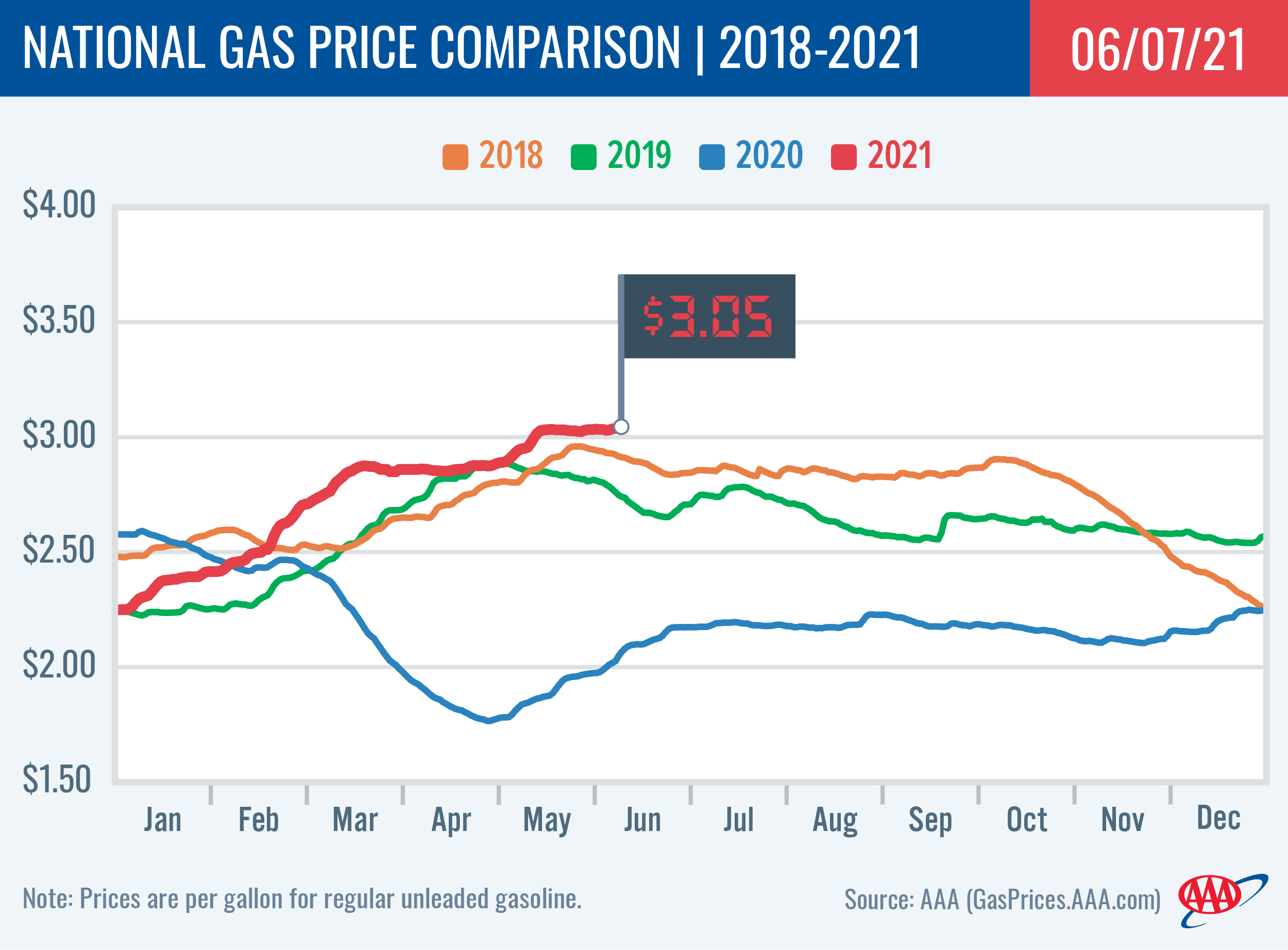
Diesel
For the week, the national average gains a penny to $3.20 a gallon. Oregon’s average adds three cents to $3.39. A year ago the national average for diesel was $2.41 and the Oregon average was $2.57.
Find current fuel prices at GasPrices.AAA.com.
AAA news releases, high resolution images, broadcast-quality video, fact sheets and podcasts are available on the AAA NewsRoom at NewsRoom.AAA.com.
Find local news releases at https://oregon.aaa.com/community/media/media-contacts.html
Fuel prices are updated daily at AAA’s Daily Fuel Gauge at AAA Gas Prices. For more info go www.AAA.com. AAA Oregon/Idaho provides more than 850,000 members with travel, insurance, financial and automotive-related services, and is an affiliate of AAA National, serving more than 62 million motorists in North America.
Updated 6/1/2021
Minimal Movement in Pump Prices over Holiday Weekend
Demand Spike may Push Prices Higher
PORTLAND, Ore., – Gas prices were mostly stable leading up the Memorial Day weekend with the majority of states seeing only small changes. However, prices may not stay steady due to a spike in demand. For the week, the national average for regular adds a penny to $3.05 a gallon. The Oregon average gains two cents to $3.43.
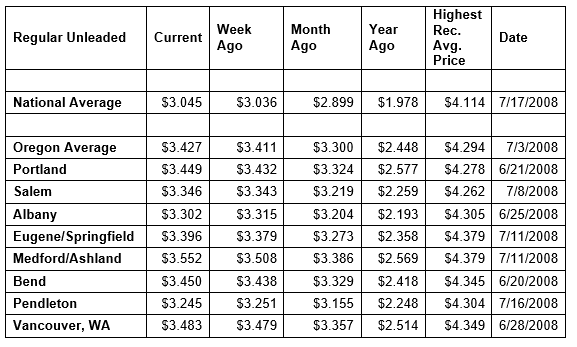
Demand for gasoline in the U.S. surged to 9.4 million b/d for the week ending May 21. This is the highest reported number since early March 2020 and up nearly 30% over the same week last year, according to the U.S. Energy Information Administration (EIA). indicating motorists are filling up more frequently.
“The spike in demand shows that drivers are filling up more frequently. Gasoline supply and demand levels are looking more like typical summer numbers as demand has steadily jumped week-over-week since the end of April while supply has declined. The increasing demand and shrinking supply combined with more expensive crude oil prices mean gas prices are likely to fluctuate through June,” says Marie Dodds, public affairs director for AAA Oregon/Idaho.
Demand for gasoline is up significantly from a year ago when many states were under lockdowns and Americans were staying home due to COVID-19.
Visit AAA.com/covidmap for an interactive map with the latest travel restrictions and policies for North America. Find AAA’s latest COVID-19 information for travelers here.
Quick stats
Oregon is one of 43 states and the District of Columbia where prices changed by three cents or less in the last week. Michigan (+9 cents) has the largest weekly increase in the country. Oklahoma (-4 cents) has the largest weekly decline.
California ($4.20) and Hawaii ($3.93) continue to have the most expensive gas prices in the country. California is the only state with an average above $4 a gallon, and 18 states and the District of Columbia are above $3, up from 17 states and D.C. a week ago.
The cheapest gas in the nation can be found in Louisiana ($2.70) and Mississippi ($2.71). For the 21st week in a row, no state has an average below $2 a gallon.
All 50 states and the District of Columbia have higher prices now than a month ago. The national average is 15 cents more and the Oregon average is 13 cents more than a month ago. This is the 26th-largest month-over-month increase in the nation. Michigan (+24 cents) has the largest monthly increase in the country. Oklahoma (+5 cents) has the smallest monthly increase.
All 50 states and the District of Columbia have higher prices now than a year ago, and 35 states and the District of Columbia have a current average that’s a dollar or more higher than a year ago. The national average is $1.07 more and the Oregon average is 98 cents more than a year ago. This is the 12th -smallest yearly increase in the nation. California (+$1.30) has the biggest yearly increase. Hawaii (+77 cents) has the smallest year-over-year increase. Compared to a year ago, gas prices are very expensive as last spring was prime quarantine time across the country.
West Coast
The West Coast region continues to have the most expensive pump prices in the nation with every state in the region except Arizona in the top 10.
| Rank | Region | Price on 6/1/21 | ||
| 1 | California | $4.20 | ||
| 2 | Hawaii | $3.93 | ||
| 3 | Nevada | $3.63 | ||
| 4 | Washington | $3.58 | ||
| 5 | Oregon | $3.43 | ||
| 6 | Utah | $3.35 | ||
| 7 | Alaska | $3.32 | ||
| 8 | Illinois | $3.27 | ||
| 9 | Idaho | $3.25 | ||
| 10 | District of Columbia | $3.17 |
California is the most expensive state for the 20th week in a row and is the only state in the nation with an average above $4 per gallon. Hawaii, Nevada, Washington, and Oregon round out the top five. Alaska is seventh. Arizona is 13th. Oregon is fifth for the 13th week in a row.
All seven states in the West Coast region are among the 18 states in the country, along with D.C., that have averages above $3 a gallon.
States in the West Coast region are seeing relatively small changes in pump prices this week, like most other states. California (+4 cents) has the largest weekly increase in the region. Arizona (-1 cent) is the only state in the region with a week-over-week decrease.
One reason pump prices have been consistently climbing in most of the West Coast region is that the refinery utilization rate has held steady between about 82% and 83% since early April, while demand has climbed.
According to EIA’s latest weekly report, total gas stocks in the region decreased from 29.37 million bbl to 29.17 million bbl last week. This will put some upward pressure on pump prices in the region this week.
Oil market dynamics
Although crude prices ended the day down on Friday due to market liquidation at the end of the month, crude prices gained on the week after the Energy Information Administration’s weekly report showed that total domestic crude inventories decreased by 1.7 million bbl to 484.3 million bbl. However, last week’s price gains were limited by market concerns that increasing coronavirus infections around the world could reduce crude consumption this year. For this week, crude prices could climb further if EIA’s next report shows another decline in crude stocks.
At the close of Friday’s formal trading session, WTI decreased by 53 cents to settle at $66.32. Markets were closed Monday in observance of Memorial Day. Today crude is trading around $67, compared to $66 a week ago. Crude prices are about $33 more than a year ago.
Drivers can find current Oregon gas prices along their route with the free AAA Mobile app for iPhone, iPad and Android. The app can also be used to map a route, find discounts, book a hotel and access AAA roadside assistance. Learn more at AAA.com/mobile.

Diesel
For the week, the national average gains a penny to $3.19 a gallon. Oregon’s average adds two cents to $3.35. A year ago the national average for diesel was $2.41 and the Oregon average was $2.56.
Find current fuel prices at GasPrices.AAA.com.
AAA news releases, high resolution images, broadcast-quality video, fact sheets and podcasts are available on the AAA NewsRoom at NewsRoom.AAA.com.
Find local news releases at https://oregon.aaa.com/community/media/media-contacts.html
Fuel prices are updated daily at AAA’s Daily Fuel Gauge at AAA Gas Prices. For more info go www.AAA.com. AAA Oregon/Idaho provides more than 850,000 members with travel, insurance, financial and automotive-related services, and is an affiliate of AAA National, serving more than 62 million motorists in North America.
May Oregon Gas Price News
Updated 5/25/2021
Memorial Day Travelers in Oregon to Pay Highest Pump Prices in Two Years;
National Gas Price Average is at Highest Price in Seven Years
PORTLAND, Ore., – Pump prices are stabilizing following the Colonial Pipeline cyberattack, but prices are likely to fluctuate leading up the Memorial Day holiday weekend. Travelers in Oregon will find gas prices at their highest for the holiday since 2019 while the national gas price average will be the highest since 2014. For the week, the national average for regular ticks down half a cent to $3.04 a gallon. The Oregon average adds two cents to $3.41.
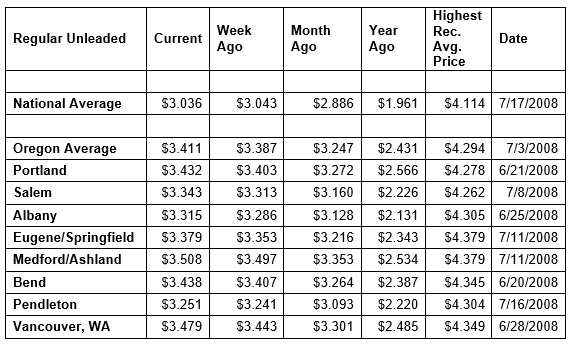
AAA expects 37 million Americans including 485,000 Oregonians to travel for the holiday weekend, an increase of 60% compared to last year when much of the nation was under stay-at-home orders due to COVID-19. Nearly 93% of Memorial Day travelers will drive to their destinations. Find details in the AAA Memorial Day travel news release.
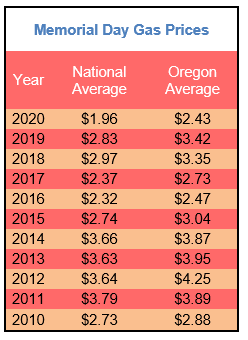
“We’re seeing a huge pent-up demand for travel, and the significant increase in Memorial Day travel is a strong indication that travel will continue to rebound all summer long,” says Marie Dodds, public affairs director for AAA Oregon/Idaho.
While the Colonial Pipeline is back in operation and deliveries are in progress, some stations in the southeast continue to experience supply strain. This is likely to extend into the holiday weekend, but drivers will be able to fill up. The West Coast saw minimal impacts from the closure of the Colonial Pipeline.
“Holiday road trippers in all areas may come across some gas stations with low fuel supply in popular travel destinations, such as beaches, mountains or national parks. However, markets are not expected to be without fuel, like we saw in the wake of the pipeline shutdown,” adds Dodds.
AAA offers these road trip tips for Memorial Day travelers:
- Make a good BET before hitting the road: get your battery, engine and tires checked.
- Consider refueling when your gas tank level hits ¼ of a tank.
- Fill up before arriving at your vacation destination. Gas prices are likely to be cheaper outside of popular travel destinations.
- Use your AAA app (AAA.com/mobile) to find the closest gas station on your route. You can always call ahead to confirm their pumps are flowing.
- Bring an emergency roadside kit. Include a mobile phone and car charger, first-aid kit, blankets, drinking water, a flashlight with extra batteries, a basic toolkit, warning flares and jumper cables. Also pack extra snacks or meals, water, and pet food as well as face coverings and cleaning supplies, including disinfecting wipes.
Demand for gasoline increased from 8.80 to 9.22 million b/d, for the week ending May 14 according to the U.S. Energy Information Administration (EIA). This is up from a year ago when demand was at 6.79 million b/d when states enacted lockdowns and travel restrictions and Americans were quarantining due to COVID-19.
Visit AAA.com/covidmap for an interactive map with the latest travel restrictions and policies for North America. Find AAA’s latest COVID-19 information for travelers here.
Quick stats
Oregon is one of 24 states and the District of Columbia with higher prices now than a week ago. All states and D.C. are showing small changes of four cents or less this week. Hawaii (+4 cents) has the largest weekly increase in the country. Indiana (- 3 cents) has the largest weekly decline.
California ($4.17) and Hawaii ($3.91) continue to have the most expensive gas prices in the country. California is the only state with an average above $4 a gallon, and 17 states and the District of Columbia are above $3, same as a week ago.
The cheapest gas in the nation can be found in Mississippi ($2.72) and Louisiana ($2.72). For the 20th week in a row, no state has an average below $2 a gallon.
All 50 states and the District of Columbia have higher prices now than a month ago. The national average is 15 cents more and the Oregon average is 16 cents more than a month ago. This is the 14th-largest month-over-month increase in the nation. North Carolina (+28 cents) has the largest monthly increase in the country. South Dakota (+6 cents) has the smallest monthly increase.
All 50 states and the District of Columbia have higher prices now than a year ago, and 34 states and the District of Columbia have a current average that’s a dollar or more higher than a year ago. The national average is $1.08 more and the Oregon average is 98 cents more than a year ago. This is the 12th-smallest yearly increase in the nation. California (+$1.30) has the biggest yearly increase. Hawaii (+73 cents) has the smallest year-over-year increase. Compared to a year ago, gas prices are very expensive as last spring was prime quarantine time across the country.
West Coast
The West Coast region continues to have the most expensive pump prices in the nation with every state in the region except Arizona in the top 10.
| Rank | Region | Price on 5/25/21 | ||
| 1 | California | $4.17 | ||
| 2 | Hawaii | $3.91 | ||
| 3 | Nevada | $3.61 | ||
| 4 | Washington | $3.56 | ||
| 5 | Oregon | $3.41 | ||
| 6 | Utah | $3.35 | ||
| 7 | Alaska | $3.30 | ||
| 8 | Idaho | $3.24 | ||
| 9 | Illinois | $3.22 | ||
| 10 | District of Columbia | $3.17 |
California is the most expensive state for the 19th week in a row and is the only state in the nation with an average above $4 per gallon. Hawaii, Nevada, Washington, and Oregon round out the top five. Alaska is seventh. Arizona is 12th. Oregon is fifth for the 12th week in a row.
All seven states in the West Coast region are among the 17 states in the country, along with D.C., that have averages above $3 a gallon.
States in the West Coast region are seeing small changes in pump prices this week. Hawaii (+4 cents) has the largest weekly increase in the region and the country. Arizona (-1 cent) is the only state in the region with a week-over-week decrease.
One reason pump prices have been consistently climbing in most of the West Coast region is that the refinery utilization rate has held steady between about 82% and 83% since early April, while demand has climbed.
According to EIA’s latest weekly report, total gas stocks in the region decreased from 30.40 million bbl to 29.37 million bbl last week. This will put some upward pressure on pump prices in the region this week.
Oil market dynamics
Crude prices rose on Friday due in part to a stronger dollar but declined for the week. Oil prices declined as the market remains concerned that increasing coronavirus infections around the world could reduce crude consumption this year. Additionally, new market concerns about inflation and the Energy Information Administration’s (EIA) weekly report revealing that total domestic crude inventories increased by 1.3 million bbl to 486 million bbl helped to reduce crude prices last week. To start this week, crude prices shot up on Monday on news that nuclear sanctions may not be lifted on Iran, meaning Iranian oil would not come into the markets.
At the close of Friday’s formal trading session, WTI increased by $1.64 to settle at $63.58. At the close of Monday’s formal trading session, WTI added $2.47 to settle at $66.05. Today crude is trading around $66, same as a week ago. Crude prices are about $33 more than a year ago.
Drivers can find current Oregon gas prices along their route with the free AAA Mobile app for iPhone, iPad and Android. The app can also be used to map a route, find discounts, book a hotel and access AAA roadside assistance. Learn more at AAA.com/mobile.
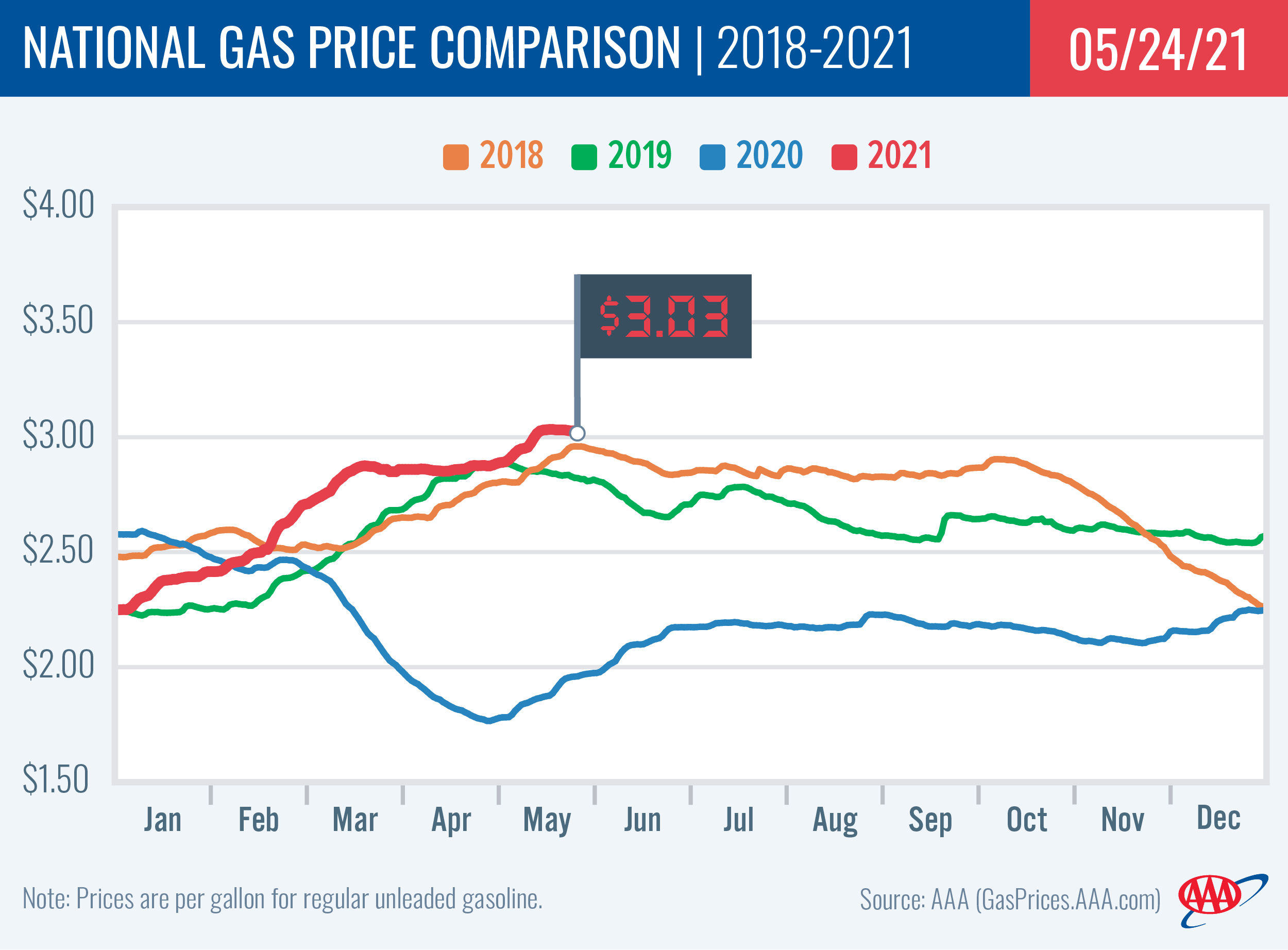
Diesel
For the week, the national average gains a penny to $3.18 a gallon. Oregon’s average adds a penny to $3.33. A year ago the national average for diesel was $2.41 and the Oregon average was $2.57.
Find current fuel prices at GasPrices.AAA.com.
AAA news releases, high resolution images, broadcast-quality video, fact sheets and podcasts are available on the AAA NewsRoom at NewsRoom.AAA.com.
Find local news releases at https://oregon.aaa.com/community/media/media-contacts.html
Fuel prices are updated daily at AAA’s Daily Fuel Gauge at AAA Gas Prices. For more info go www.AAA.com. AAA Oregon/Idaho provides more than 850,000 members with travel, insurance, financial and automotive-related services, and is an affiliate of AAA National, serving more than 62 million motorists in North America.
Updated 5/18/2021
Tight Supplies Continue in Southeast; West Coast sees Typical Price Hikes
PORTLAND, Ore., – Gas price spikes are easing in the Southeast and East Coast regions that were impacted by the shutdown of the Colonial Pipeline. Some states saw prices shoot up by 21 cents in a matter of days. With the pipeline back in operation and supply slowly being restored, gas prices in these states and the national average are starting to show increases that are more typical for this time of year. For the week, the national average for regular climbs six cents to $3.04 a gallon. The Oregon average gains three cents to $3.39. (This is the seventh-smallest weekly increase in the nation.)
The national gas price average is at its most expensive since November 2014. The Oregon average is at its highest price since June 2019. The national average was expected to flirt with $3 a gallon leading up to Memorial Day weekend due to increased demand, but the shutdown of the Colonial Pipeline caused prices to spike weeks ahead of the holiday.
“The West Coast saw minimal impacts from the closure of the Colonial Pipeline. The Southeast will continue to experience tight supplies this week as terminals and gas stations are refueled, and prices will continue to fluctuate leading up the Memorial Day weekend,” says Marie Dodds, public affairs director for AAA Oregon/Idaho.
AAA projects a significant rebound in the number of Americans planning to travel this Memorial Day holiday weekend with 37 million Americans including 485,000 Oregonians expected to travel 50 miles or more from home. This is up 60% from last year which fell during the early phase of the coronavirus pandemic. Find details in the AAA Memorial Day travel news release.
Demand decreased slightly to 8.80 from 8.86 million b/d, for the week ending May 7 according to the U.S. Energy Information Administration (EIA). This is up from a year ago when demand was at 7.4 million b/d when states enacted lockdowns and travel restrictions and Americans were quarantining due to COVID-19.
Visit AAA.com/covidmap for an interactive map with the latest travel restrictions and policies for North America. Find AAA’s latest COVID-19 information for travelers here.
Quick stats
Oregon is one of 48 states and the District of Columbia with higher prices now than a week ago. North Carolina (+20 cents) and South Carolina (+20 cents) have the largest weekly increases in the country. These states were greatly impacted by the Colonial Pipeline outage. Alaska (+1/2 cent) has the smallest weekly increase. Oregon (+3 cents) has the 43rd-largest increase in the nation. Indiana (-2 cents) and Michigan (-1 cent) are the only two states with week-over-week declines.
California ($4.14) and Hawaii ($3.87) continue to have the most expensive gas prices in the country. California is the only state with an average above $4 a gallon, and 17 states and the District of Columbia are above $3, up from 15 states and D.C. a week ago.
The cheapest gas in the nation can be found in Louisiana ($2.72) and Mississippi ($2.73). For the 19th week in a row, no state has an average below $2 a gallon.
All 50 states and the District of Columbia have higher prices now than a month ago. The national average is 17 cents more and the Oregon average is 16 cents more than a month ago. This is the 26th-largest month-over-month increase in the nation. Delaware (+32 cents) has the largest monthly increase in the country. South Dakota (+6 cents) has the smallest monthly increase.
All 50 states and the District of Columbia have higher prices now than a year ago and 46 states have a current average that’s a dollar or more higher than a year ago. The national average is $1.16 more and the Oregon average is $1.00 more than a year ago. This is the sixth-smallest yearly increase in the nation. Utah (+$1.34) has the biggest yearly increase. Hawaii (+70 cents) has the smallest year-over-year increase. Compared to a year ago, gas prices are very expensive as last spring was prime quarantine time across the country.
West Coast
The West Coast region continues to have the most expensive pump prices in the nation with every state in the region except Arizona in the top 10.
| Rank | Region | Price on 5/18/21 | ||
| 1 | California | $4.14 | ||
| 2 | Hawaii | $3.87 | ||
| 3 | Nevada | $3.59 | ||
| 4 | Washington | $3.54 | ||
| 5 | Oregon | $3.39 | ||
| 6 | Utah | $3.36 | ||
| 7 | Alaska | $3.29 | ||
| 8 | Illinois | $3.25 | ||
| 9 | Idaho | $3.23 | ||
| 10 | Pennsylvania | $3.15 |
California is the most expensive state for the 18th week in a row and is the only state in the nation with an average above $4 per gallon. Hawaii, Nevada, Washington, and Oregon round out the top five. Alaska is seventh. Arizona is 12th. Oregon is fifth for the 11th week in a row.
All seven states in the West Coast region are among the 17 states in the country, along with D.C., that have averages above $3 a gallon.
States in the West Coast region are seeing smaller increases in pump prices than other parts of the country, in part because of our geographic separation from states that were impacted by the shutdown of the Colonial Pipeline. Hawaii (+4 cents) has the largest weekly increase in the region. Arizona (+3 cents) has the smallest weekly increase in the region.
One reason pump prices have been consistently climbing in the West Coast region is that the refinery utilization rate has held steady between about 82% and 83% since early April, while demand has climbed.
According to EIA’s latest weekly report, total gas stocks in the region increased from 30.20 million bbl to 30.40 million bbl last week. This will help keep pump price increases moderate in the region this week.
Oil market dynamics
Crude prices rose last week on market optimism that crude demand will recover, despite an uptick in coronavirus infection rates in some countries. Prices could continue to climb this week if the market remains optimistic as vaccines continue to roll out. Additionally, prices increased after the Energy Information Administration’s (EIA) latest weekly report revealed that total domestic crude oil inventory decreased by 400,000 bbl to 484.7 million bbl. If EIA’s next report shows another decrease in total domestic crude supply, crude prices could increase further.
At the close of Friday’s formal trading session, WTI increased by $1.55 to settle at $65.37. At the close of Monday’s formal trading session, WTI added 90 cents to settle at $66.27. Today crude is trading around $66, compared to $65 a week ago. Crude prices are about $37 more than a year ago.
Drivers can find current Oregon gas prices along their route with the free AAA Mobile app for iPhone, iPad and Android. The app can also be used to map a route, find discounts, book a hotel and access AAA roadside assistance. Learn more at AAA.com/mobile.
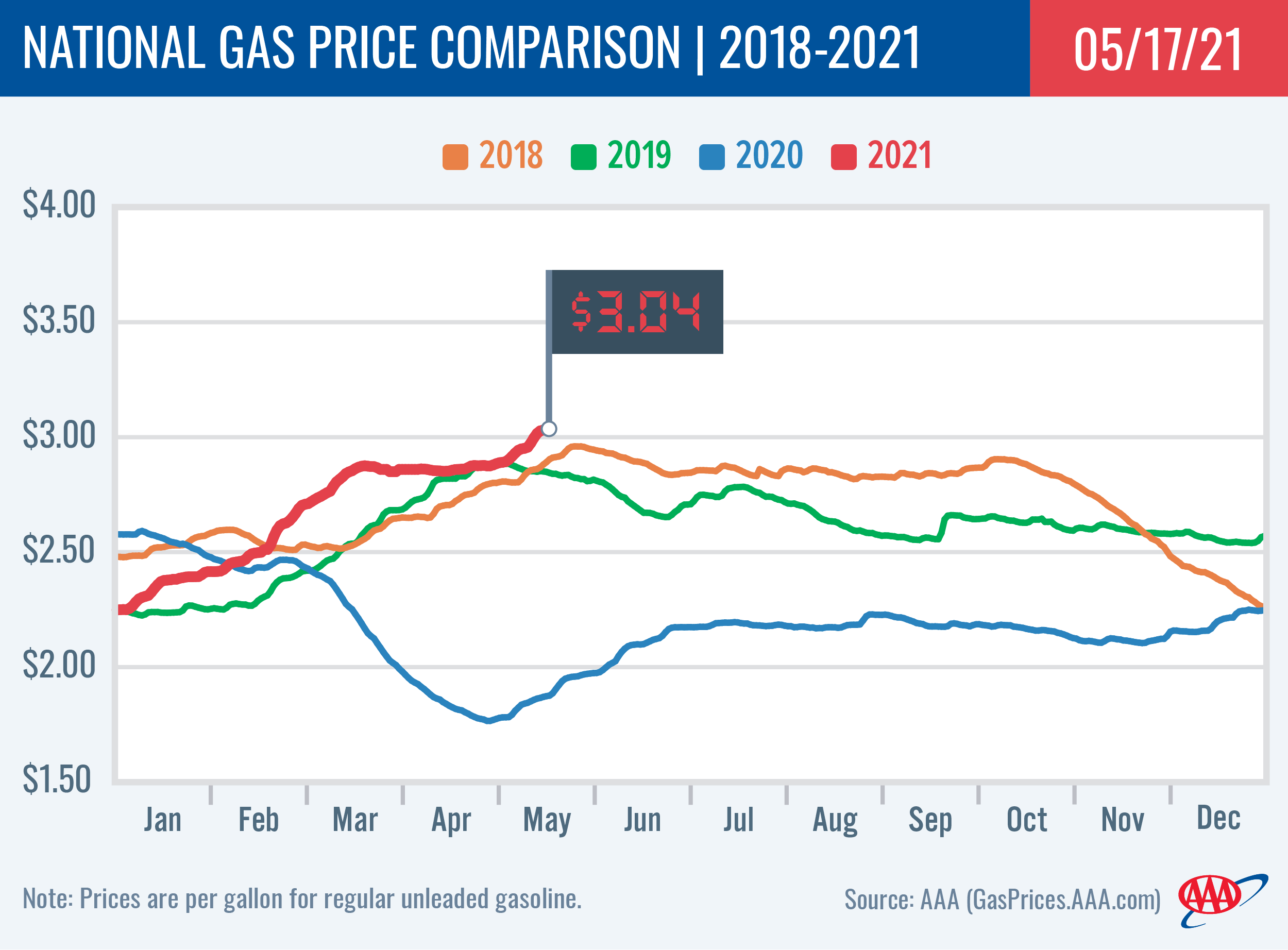
Diesel
For the week, the national average jumps a nickel to $3.17 a gallon. Oregon’s average adds three cents to $3.32. A year ago the national average for diesel was $2.41 and the Oregon average was $2.56.
Find current fuel prices at GasPrices.AAA.com.
AAA news releases, high resolution images, broadcast-quality video, fact sheets and podcasts are available on the AAA NewsRoom at NewsRoom.AAA.com.
Find local news releases at https://oregon.aaa.com/community/media/media-contacts.html
Fuel prices are updated daily at AAA’s Daily Fuel Gauge at AAA Gas Prices. For more info go www.AAA.com. AAA Oregon/Idaho provides more than 850,000 members with travel, insurance, financial and automotive-related services, and is an affiliate of AAA National, serving more than 62 million motorists in North America.
Updated 5/11/2021
Major Pipeline Closure Sends Pump Prices Higher on East Coast;
West Coast sees smaller impacts
PORTLAND, Ore., – Retail gas prices are climbing this week, especially on the East Coast, in reaction to the closure of the Colonial Pipeline which delivers approximately 45% of all fuel to the East Coast. Over the weekend, the Colonial Pipeline announced it was the victim of a cybersecurity attack and, as a precaution, shut down the pipeline, which runs from Texas to New York Harbor. For the week, the national average for regular jumps eight cents to $2.99 a gallon. The Oregon average adds four cents to $3.35.
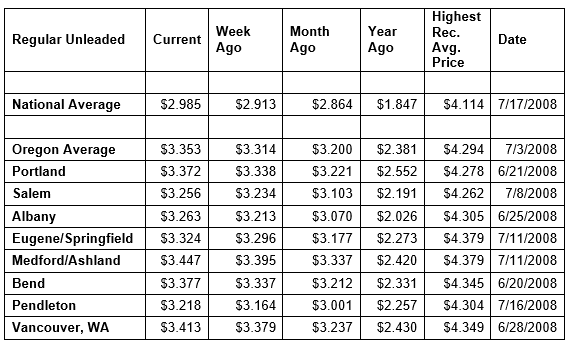
The national gas price average is at its most expensive since November 2014. The Oregon average is at its highest price since June 2019.
“This shutdown has implications on both gasoline supply and prices, but the impact varies by region. The West Coast is one area seeing little impact. Areas including Mississippi, Tennessee and the east coast from Georgia into Delaware are most likely to experience limited fuel availability and price increases. Prices could climb in these states from three to seven cents a gallon this week,” says Marie Dodds, public affairs director for AAA Oregon/Idaho.
At this time, some lateral lines have reopened, but there is no firm timeline of when the mainline, including the gasoline line, will be operational. The Colonial operations team says the goal is to restore service by the end of the week. The company will provide updates as restoration efforts progress.
The longer the pipeline is offline, the larger the impact on the East Coast. However, foreign gasoline imports and other pipelines can supplement Northeastern supply.
While there is sufficient gasoline supply in the U.S. (235.8 million bbl), other pipelines and the Department of Transportation’s temporary hours-of-service exemption for tanker trucks transporting gasoline and other fuels, will be able to ease the strain, but not resolve the issues caused by the pipeline interruption. Once the pipeline is up and running, there could still be residual delays as it takes about 15 to 18 days for fuel to flow from Texas to New York.
AAA urges drivers not to panic-buy gasoline. Wait to fill up until you have about a quarter-tank of fuel. Here are tips on how to conserve fuel:
- Plan ahead to accomplish multiple errands in one trip, and whenever possible avoid high-traffic times of day.
- If you own more than one car, use the most fuel-efficient model that meets the needs of any given trip.
- Remove unnecessary and bulky items from your car. Minimize your use of roof racks and remove special carriers when not in use. It takes more fuel to accelerate a heavier car, and the reduction in fuel economy is greater for small cars than for larger models.
- Minimize your use of air conditioning. Even at highway speeds, open windows have less effect on fuel economy than the engine power required to operate the air conditioning compressor.
- In warm weather, park in the shade or use a windshield sunscreen to lessen heat buildup inside the car. This reduces the need for air conditioning (and thus fuel) to cool down the car.
- Keep tires inflated at the proper pressure. Use the figures on the tire information decal on the driver’s door jamb — not the one molded into the tire’s sidewall. Under-inflated tires reduce fuel economy and can be a safety hazard.
If drivers in other parts of the country see low to no fuel in certain markets, that is due to delayed deliveries stemming from a shortage of fuel truck drivers, not the Colonial Pipeline. These situations are temporary and are not shortages.
Memorial Day impact on gas prices
Pump prices were already expected to have upward movement this month due to spikes in demand, especially approaching Memorial Day.
Demand decreased slightly to 8.86 from 8.87 million b/d, for the week ending April 30 according to the U.S. Energy Information Administration (EIA). This is up significantly from a year ago when demand was at 6.7 million b/d when states enacted lockdowns and travel restrictions and Americans were quarantining due to COVID-19.
Visit AAA.com/covidmap for an interactive map with the latest travel restrictions and policies for North America. Find AAA’s latest COVID-19 information for travelers here.
Quick stats
All 50 states and the District of Columbia have higher prices now than a week ago. Georgia (+17 cents) has the largest weekly increase in the country. North Dakota (+3 cents) has the smallest. Oregon (+4 cents) has the 42nd largest increase in the nation.
California ($4.11) and Hawaii ($3.83) continue to have the most expensive gas prices in the country. California is the only state with an average above $4 a gallon, and 15 states and the District of Columbia are above $3, up from 11 states and D.C. a week ago.
The cheapest gas in the nation can be found in Mississippi ($2.64) and Louisiana ($2.66). For the 18th week in a row, no state has an average below $2 a gallon.
All 50 states and the District of Columbia have higher prices now than a month ago. The national average is 12 cents more and the Oregon average is 15 cents more than a month ago. This is the 12th-largest month-over-month increase in the nation. Delaware (+21 cents) has the largest monthly increase in the country. Arizona (+4 cents) has the smallest monthly increase.
All 50 states and the District of Columbia have higher prices now than a year ago and 43 states have a current average that’s a dollar or more higher than a year ago. The national average is $1.14 more and the Oregon average is 97 cents more than a year ago. This is the seventh-smallest yearly increase in the nation. Idaho (+$1.38) has the biggest yearly increase. Hawaii (+68 cents) has the smallest year-over-year increase. Compared to a year ago, gas prices are very expensive as last spring was prime quarantine time across the country.
West Coast
The West Coast region continues to have the most expensive pump prices in the nation with every state in the region in the top 10.
| Rank | Region | Price on 5/11/21 | ||
| 1 | California | $4.11 | ||
| 2 | Hawaii | $3.83 | ||
| 3 | Nevada | $3.54 | ||
| 4 | Washington | $3.52 | ||
| 5 | Oregon | $3.35 | ||
| 6 | Alaska | $3.28 | ||
| 7 | Utah | $3.27 | ||
| 8 | Illinois | $3.21 | ||
| 9 | Idaho | $3.19 | ||
| 10 | Arizona | $3.12 |
California is the most expensive state for the 18th week in a row and is the only state in the nation with an average above $4 per gallon. Hawaii, Nevada, Washington, Oregon, and Alaska round out the top six. Arizona is 10th. Oregon is fifth for the 10th week in a row.
All seven states in the West Coast region are among the 11 states in the country, along with D.C., that have averages above $3 a gallon.
States in the West Coast region are seeing larger smaller increases in pump prices than other parts of the country. Arizona (+7 cents) has the largest weekly increase in the region. Hawaii (+4 cents) has the smallest weekly increase in the region.
One reason pump prices have been consistently climbing in the West Coast region is that the refinery utilization rate has held steady at about 82 percent since early April, while demand has climbed.
According to EIA’s latest weekly report, total gas stocks in the region show a decline to 30.20 million bbl from 30.95 million bbl last week. This will continue to send prices higher in the region this week.
Oil market dynamics
Crude prices rose last week on market optimism that crude demand will recover, despite an uptick in coronavirus infection rates. Prices could continue to climb this week if the market remains optimistic as vaccines continue to rollout. Additionally, prices increased after the Energy Information Administration’s (EIA) latest weekly report revealed that total domestic crude oil inventory dropped by 8 million bbl to 485.1 million bbl. If EIA’s next report shows another decrease in total domestic crude supply, crude prices could climb further this week.
At the close of Friday’s formal trading session, WTI increased by 19 cents to settle at $64.90. At the close of Monday’s formal trading session, WTI added two cents to settle at $64.92. Today crude is trading around $65, same as a week ago. Crude prices are about $40 more than a year ago.
Drivers can find current Oregon gas prices along their route with the free AAA Mobile app for iPhone, iPad and Android. The app can also be used to map a route, find discounts, book a hotel and access AAA roadside assistance. Learn more at AAA.com/mobile.
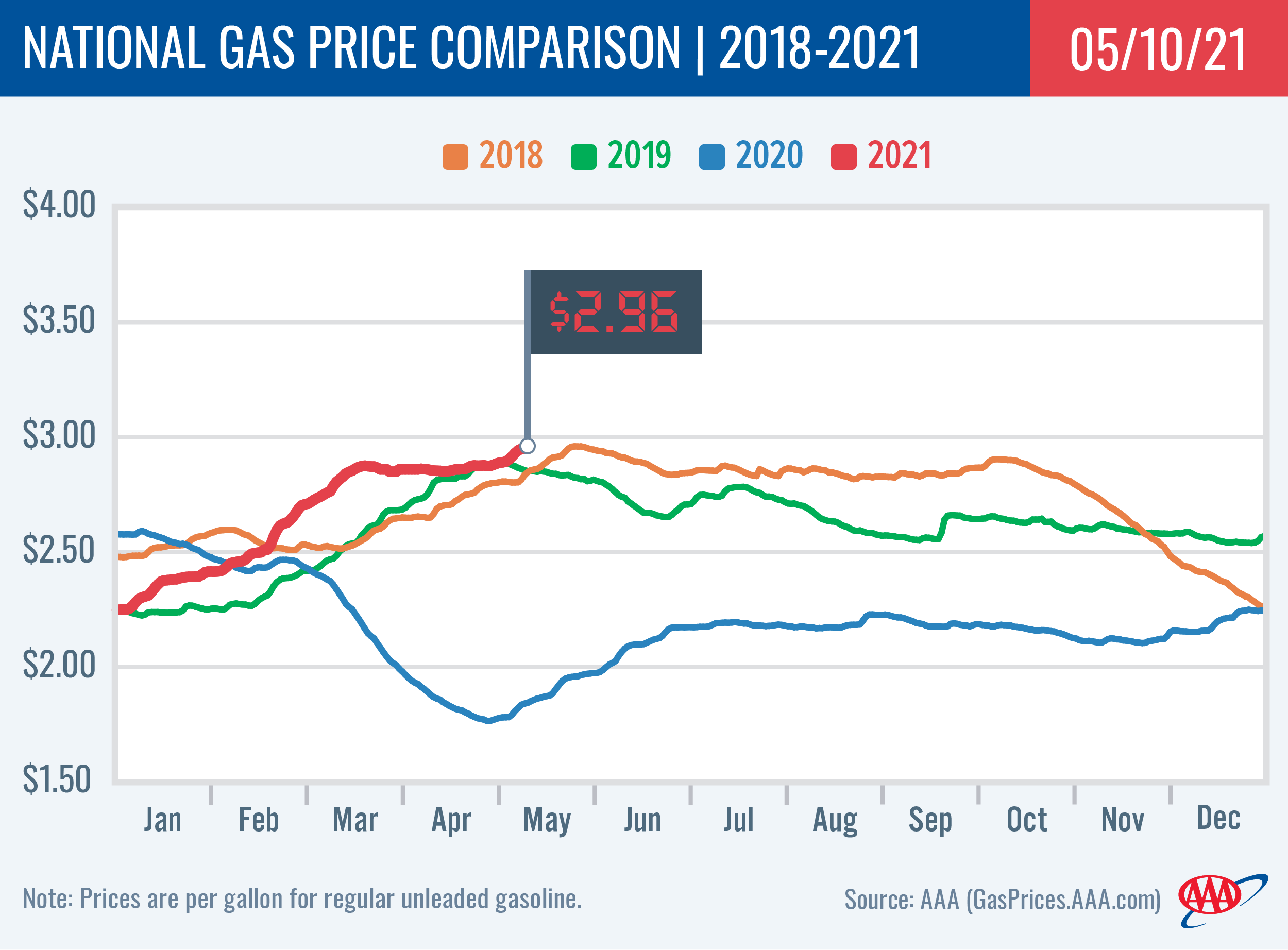
Diesel
For the week, the national average rises four cents to $3.13 a gallon. Oregon’s average adds three cents to $3.28. A year ago the national average for diesel was $2.42 and the Oregon average was $2.57.
Find current fuel prices at GasPrices.AAA.com.
AAA news releases, high resolution images, broadcast-quality video, fact sheets and podcasts are available on the AAA NewsRoom at NewsRoom.AAA.com.
Find local news releases at https://oregon.aaa.com/community/media/media-contacts.html
Fuel prices are updated daily at AAA’s Daily Fuel Gauge at AAA Gas Prices. For more info go www.AAA.com. AAA Oregon/Idaho provides more than 850,000 members with travel, insurance, financial and automotive-related services, and is an affiliate of AAA National, serving more than 62 million motorists in North America.
Updated 5/4/2021
Pump Price Jumps Expected in May
PORTLAND, Ore., – Retail gas prices are likely to jump this month as we see spikes in demand, especially approaching Memorial Day. This week, several West Coast states are already seeing pump prices rise faster than other parts of the country. For the week, the national average for regular climbs three cents to $2.91 a gallon. The Oregon average jumps six cents to $3.31.
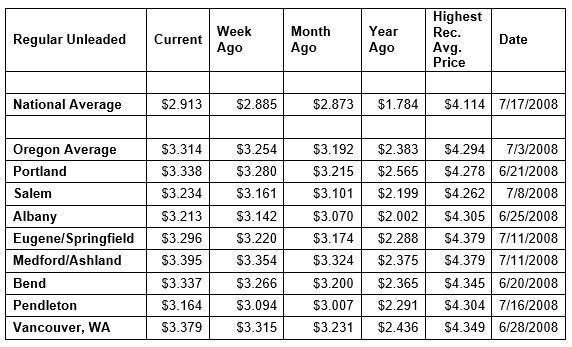
Gas prices and supply and demand for gas are similar to May 2019. The national average ended May 2019 at $2.83 a gallon and the Oregon average ended May 2019 at $3.42.
Gasoline stocks are seeing a small increase of 100,000 bbl to reach the 135 million bbl mark. This is the highest supply rate since the end of February and an 8.3 million bbl surplus compared to the same time two years ago. While supply increased, demand saw a decrease of 3% to 8.87 million b/d, for the week ending April 23 according to the U.S. Energy Information Administration (EIA).
Last April, demand fell to 5.5 million b/d when states enacted lockdowns and travel restrictions and Americans were quarantining due to COVID-19.
“Compared to May 2019, U.S. gasoline demand is down only 4% and gas prices are on average within about a dime of what we were paying two years ago,” says Marie Dodds, public affairs director for AAA Oregon/Idaho.
Visit AAA.com/covidmap for an interactive map with the latest travel restrictions and policies for North America. Find AAA’s latest COVID-19 information for travelers here.
Summer Fuel Supply
Last week, media reports surfaced that a shortage of fuel tank truck drivers may impact gasoline availability this summer. As gasoline demand increases, gas stations are working to adjust delivery schedules to keep pace. However, deliveries may be delayed in a small number of markets this summer causing select stations to see low to no fuel at some pumps for short periods, one or two days.
“With road trips expected to be popular this summer, some summer travel destinations including coastal areas and mountains may see some pumps affected. It is important to understand this is not a market-wide impact, as fuel can be found at other stations within a market,” says Dodds. “There’s no gas supply shortage in the U.S.; there’s plenty of gasoline supply across the country. Rather, it’s a matter of delivery delays.
Central and Southern Oregon were two areas impacted by temporary and limited gasoline outages last month. In all the markets where this occurred, it was contained within a brand/chain at a select number of pumps. As a rule of thumb in general, AAA recommends that drivers consider filling up when their fuel level hits a quarter of a tank.
Quick Stats
Oregon is one of 48 states and Washington D.C. where prices are higher now than a week ago. Oregon is one of nine states where prices have climbed a nickel or more in the last week. Indiana (+8 cents) has the largest weekly increase in the nation. Oregon (+6 cents) has the sixth-largest weekly increase in the country. Ohio (-4 cents) and Arizona (-2/10ths of a cent) are the only two states with week-over-week declines.
California ($4.05) and Hawaii ($3.80) continue to have the most expensive gas prices in the country. California is the only state with an average above $4 a gallon, and 11 states and the District of Columbia are above $3, same as a week ago.
The cheapest gas in the nation can be found in Mississippi ($2.57) and Texas ($2.59). For the 17th week in a row, no state has an average below $2 a gallon.
Oregon is one of 42 states and the District of Columbia with higher prices now than a month ago. The national average is four cents more and the Oregon average is 12 cents more than a month ago. This is the fourth-largest month-over-month increase in the nation. Nevada (+17 cents) has the largest monthly increase in the country. Arizona (-4 cents) has the biggest monthly decline.
All 50 states and the District of Columbia have higher prices now than a year ago and 39 states have a current average that’s a dollar or more higher than a year ago. The national average is $1.13 more and the Oregon average is 93 cents more than a year ago. This is the seventh-smallest yearly increase in the nation. Michigan (+$1.36) has the biggest yearly increase. Hawaii (+64 cents) has the smallest year-over-year increase. Compared to a year ago, gas prices are very expensive as last spring was prime quarantine time across the country.
West Coast
The West Coast region continues to have the most expensive pump prices in the nation with every state in the region in the top 10.
| Rank | Region | Price on 5/4/21 | ||
| 1 | California | $4.05 | ||
| 2 | Hawaii | $3.80 | ||
| 3 | Nevada | $3.50 | ||
| 4 | Washington | $3.49 | ||
| 5 | Oregon | $3.31 | ||
| 6 | Alaska | $3.24 | ||
| 7 | Utah | $3.23 | ||
| 8 | Illinois | $3.16 | ||
| 9 | Idaho | $3.15 | ||
| 10 | Arizona | $3.05 |
California is the most expensive state for the 17th week in a row and is the only state in the nation with an average above $4 per gallon. Hawaii, Nevada, Washington, Oregon, and Alaska round out the top six. Arizona is 10th. Oregon is fifth for the ninth week in a row.
All seven states in the West Coast region are among the 11 states in the country, along with D.C., that have averages above $3 a gallon.
States in the West Coast region are seeing larger weekly changes in pump prices than most other parts of the country. Alaska (+7 cents) and Washington (+7 cents) have the largest weekly increases in the region. Arizona (-2/10ths of a cent) has the largest decrease in the region, and is one of only states in the country with a weekly decline.
One reason pump prices are mostly climbing in the West Coast region is a stable refinery utilization rate amid increasing demand. Refinery utilization in this region has held steady at about 82 percent for the last month, putting upward pressure on prices.
According to EIA’s latest weekly report, total gas stocks in the region show a decline to 30.95 million bbl from 31.65 million bbl last week. This will continue to send prices higher in the region this week.
Oil market dynamics
Although prices ended last week with a decrease on Friday, supported by a strong dollar, the price of crude increased by nearly $1.50 per barrel on the week. Increased market optimism that crude demand will recover, despite surging coronavirus infection rates in Asia, helped to lift prices. Prices could continue to climb this week if the market remains optimistic. Additionally, prices increased last week after the Organization of the Petroleum Exporting Countries (OPEC+) and its allies, including Russia, recommended leaving in place a recent agreement to gradually increase crude production by at least 2.1 million b/d in May and June. At the next OPEC+ meeting on June 1, the cartel will determine crude output levels for July and August.
At the close of Friday’s formal trading session, WTI decreased by $1.43 to settle at $63.58. At the close of Monday’s formal trading session, WTI added 91 cents to settle at $64.49. Today crude is trading around $65, compared to $62 a week ago. Crude prices are about $45 more than a year ago.
Drivers can find current Oregon gas prices along their route with the free AAA Mobile app for iPhone, iPad and Android. The app can also be used to map a route, find discounts, book a hotel and access AAA roadside assistance. Learn more at AAA.com/mobile.
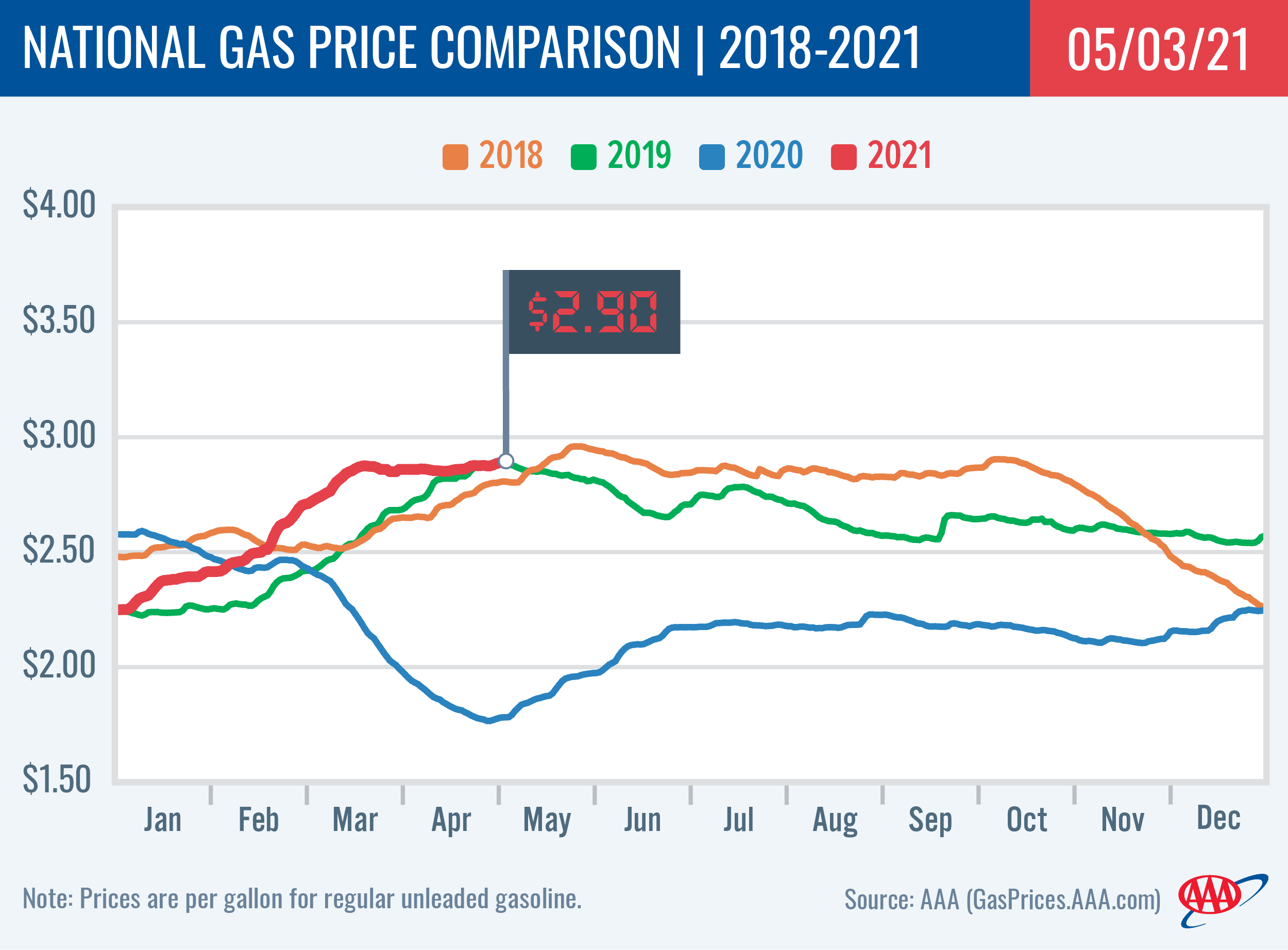
Diesel
For the week, the national average rises a penny to $3.09 a gallon. Oregon’s average adds three cents to $3.26. A year ago the national average for diesel was $2.43 and the Oregon average was $2.58.
Find current fuel prices at GasPrices.AAA.com.
AAA news releases, high resolution images, broadcast-quality video, fact sheets and podcasts are available on the AAA NewsRoom at NewsRoom.AAA.com.
Find local news releases at https://oregon.aaa.com/community/media/media-contacts.html
Fuel prices are updated daily at AAA’s Daily Fuel Gauge at AAA Gas Prices. For more info go www.AAA.com. AAA Oregon/Idaho provides more than 850,000 members with travel, insurance, financial and automotive-related services, and is an affiliate of AAA National, serving more than 62 million motorists in North America.
April Oregon Gas Price News
Updated 4/27/2021
U.S. Demand Jumps to Second-Highest Level since March 2020
PORTLAND, Ore., – Demand for gasoline in the U.S. is up to its second-highest measurement since mid-March 2020, and the highest spring reading in two years. The jump in demand is putting upward pressure on pump prices, but the increases in most states, including Oregon, are small. For the week, the national average for regular ticks up a penny to $2.89 a gallon. The Oregon average gains two cents to $3.25.
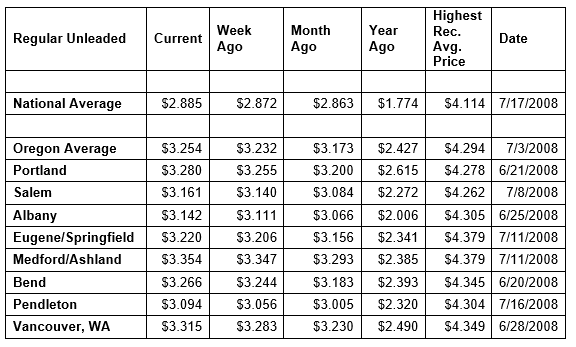
U.S. gasoline demand is at 9.1 million b/d for the week ending April 16. This is the second-highest measurement in more than a year since before the coronavirus pandemic. The latest demand reading is the highest spring number in two years and is only about 3% below the same week in 2019. The highest reading in the last year came last August when demand reached nearly 9.2 million b/d, according to the U.S. Energy Information Administration (EIA). Last April, demand fell to 5.5 million b/d when states enacted lockdowns and travel restrictions and Americans were quarantining due to COVID-19.
Both demand and supply have steadily increased in the past five weeks, but weekly gasoline supply builds are trending less substantial. On the week, supply only saw a 100,000 bbl build to 234.9 million bbl, most likely due to high consumer demand.
“Pump prices are showing some upward movement due to the jump in demand combined with the small increase in supply. Relatively cheaper crude oil prices and strong refinery utilization are keeping pump price increases fairly small in most states,” says Marie Dodds, public affairs director for AAA Oregon/Idaho.
Crude oil prices are mostly less than $63/bbl, and stable and strong refinery utilization of 85% are contributing factors keeping pump price jumps incremental. On the week, 35 state averages increased with the majority seeing only one to three cent jumps.
Visit AAA.com/covidmap for an interactive map with the latest travel restrictions and policies for North America. Find AAA’s latest COVID-19 information for travelers here.
Oregon is one of 39 states and Washington D.C. where prices have changed three cents or less in the last week. Ohio (+11 cents) has the largest weekly increase. Indiana (-4 cents) has the biggest week-over-week decline. Averages in 11 states held steady.
California (just under $4.00) and Hawaii ($3.77) continue to have the most expensive gas prices in the country. In all, 11 states and the District of Columbia are above $3, up from 10 states and D.C. a week ago.
The cheapest gas in the nation can be found in Mississippi ($2.57) and Texas ($2.58). For the 16th week in a row, no state has an average below $2 a gallon.
Oregon is one of 33 states with higher prices now than a month ago. The national average is two cents more and the Oregon average is eight cents more than a month ago. This is the 11th-largest month-over-month increase in the nation. Ohio (+21 cents) has the largest monthly increase in the country. Florida (-9 cents) has the biggest monthly decline.
All 50 states have higher prices now than a year ago and 33 states have a current average that’s a dollar or more higher than a year ago. The national average is $1.11 more and the Oregon average is 83 cents more than a year ago. This is the fourth-smallest yearly increase in the nation. Wisconsin (+$1.54) has the biggest yearly increase. Hawaii (+59 cents) has the smallest year-over-year increase.
Compared to a year ago, gas prices are very expensive as mid-April 2020 was prime quarantine time across the country. While gas prices are more than last year at this time, they are similar to April 2019. The national average for April 2019 was $2.80 and the Oregon average was $3.26.
West Coast
The West Coast region continues to have the most expensive pump prices in the nation with every state in the region in the top 10.
| Rank | Region | Price on 4/27/21 | ||
| 1 | California | $4.00 | ||
| 2 | Hawaii | $3.77 | ||
| 3 | Nevada | $3.46 | ||
| 4 | Washington | $3.42 | ||
| 5 | Oregon | $3.25 | ||
| 6 | Utah | $3.17 | ||
| 7 | Alaska | $3.17 | ||
| 8 | Idaho | $3.13 | ||
| 9 | Illinois | $3.08 | ||
| 10 | Arizona | $3.05 |
California is the most expensive state for the 16th week in a row, with Hawaii, Nevada, Washington, and Oregon rounding out the top five. Alaska is seventh. Arizona is 10th. Oregon is fifth for the eighth week in a row.
All seven states in the West Coast region are among the 11 states in the country, along with D.C., that have averages above $3 a gallon.
Like the rest of the nation, pump prices are showing relatively small changes for the week. Washington (+3.5 cents) has the largest weekly increase in the region. Arizona (-1 cent) has the largest week-over-week decline in the region.
According to EIA’s latest weekly report, total gas stocks in the region show a small increase to 31.65 million bbl from 31.53 million bbl last week. This should help keep pump prices fairly stable in the region this week.
Oil market dynamics
Although prices ended last week with an increase on Friday, supported by a weak dollar, the price of crude took a step back by approximately a dollar on the week. Growing market concern that surging coronavirus infection rates in Asia may derail expectations for crude demand recovery helped to reduce prices. Additionally, EIA’s latest weekly report revealed that total domestic crude inventory increased by 600,000 bbl to 493 million bbl, contributing to downward pressure on crude prices. If market concerns persist this week, crude prices could end the week lower again.
At the close of Friday’s formal trading session, WTI increased by 71 cents to settle at $62.14. At the close of Monday’s formal trading session, WTI lost 23 cents to settle at $61.91. Today crude is trading around $62, compared to $62 a week ago. Crude prices are about $45 more than a year ago.
Drivers can find current Oregon gas prices along their route with the free AAA Mobile app for iPhone, iPad and Android. The app can also be used to map a route, find discounts, book a hotel and access AAA roadside assistance. Learn more at AAA.com/mobile.
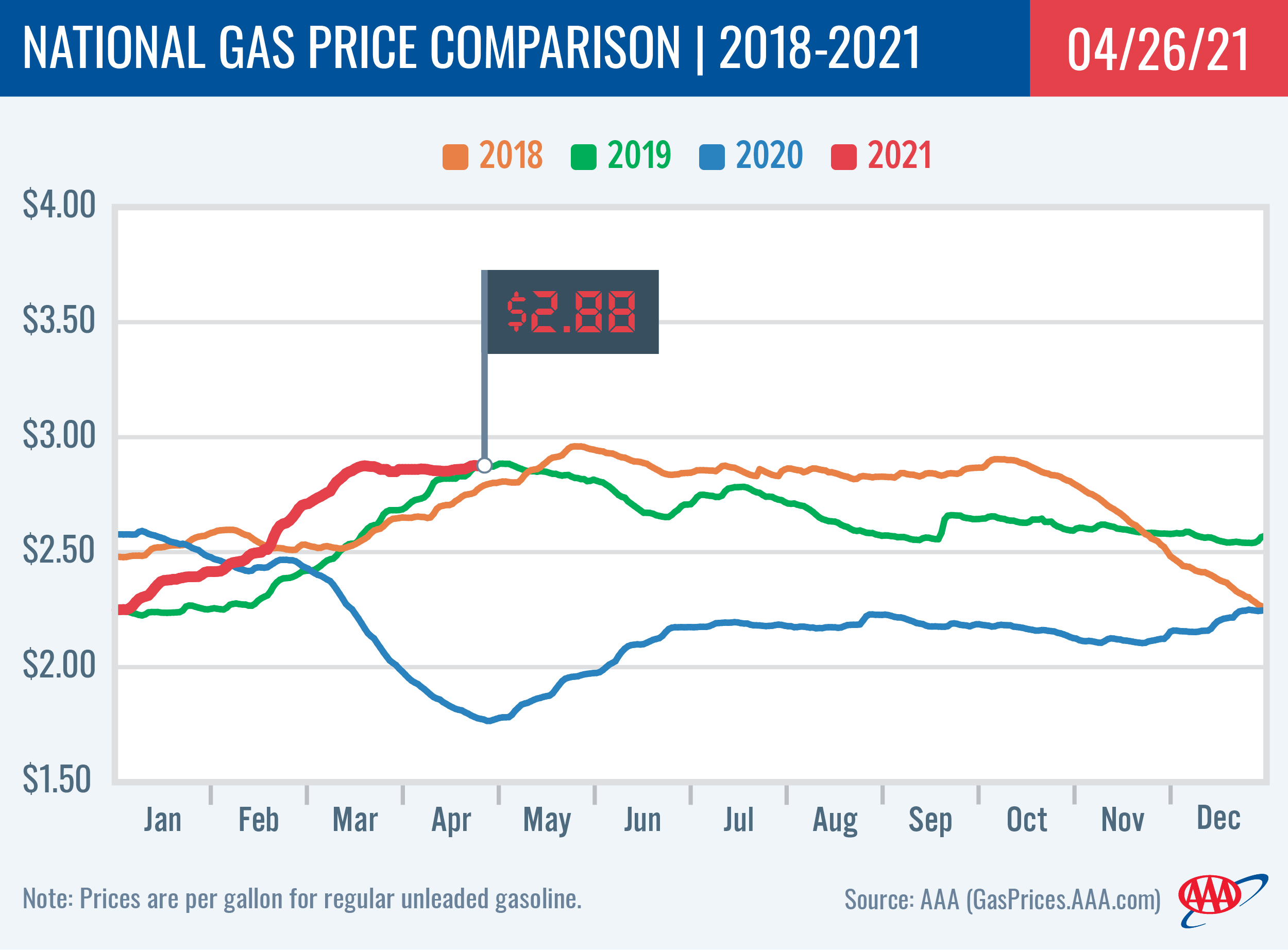
Diesel
For the week, the national average remains at $3.08 a gallon. Oregon’s average holds steady at $3.23. A year ago the national average for diesel was $2.46 and the Oregon average was $2.63.
Find current fuel prices at GasPrices.AAA.com.
AAA news releases, high resolution images, broadcast-quality video, fact sheets and podcasts are available on the AAA NewsRoom at NewsRoom.AAA.com.
Find local news releases at https://oregon.aaa.com/community/media/media-contacts.html
Fuel prices are updated daily at AAA’s Daily Fuel Gauge at AAA Gas Prices. For more info go www.AAA.com. AAA Oregon/Idaho provides more than 850,000 members with travel, insurance, financial and automotive-related services, and is an affiliate of AAA National, serving more than 62 million motorists in North America.
Updated 4/20/2021
Gas Prices Show Little Movement Despite Jump in Demand
PORTLAND, Ore., – Demand for gasoline is up to its highest level in more than a year but pump prices are seeing little movement. In the last week, prices have changed by three cents or less in most states including Oregon. For the week, the national average for regular edges up a penny to $2.87 a gallon. The Oregon average adds three cents to $3.23.
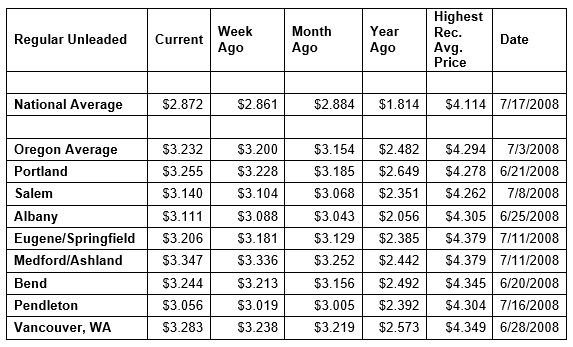
U.S. gasoline demand is at 8.9 million b/d for the week ending April 9—the highest measurement in more than a year since before the coronavirus pandemic, according to the U.S. Energy Information Administration (EIA). Last April, demand fell to 5.5 million b/d when states enacted lockdowns and travel restrictions and Americans were quarantining due to COVID-19.
Refinery utilization is nearly back to pre-pandemic levels. At 85%, refinery operations are at their fullest capacity since the week of March 23, 2020, according to EIA data. Should this positive utilization trend continue, it could help to offset increases in demand and help the national average stay under $3 a gallon.
“With the current high refinery utilization rate and building gasoline stocks in the last month, drivers have benefited from mostly flat gas prices. However, crude oil prices are seeing some upward movement this week which could make for small increases at the pumps in the next couple of weeks,” says Marie Dodds, public affairs director for AAA Oregon/Idaho.
Visit AAA.com/covidmap for an interactive map with the latest travel restrictions and policies for North America. Find AAA’s latest COVID-19 information for travelers here.
Oregon is one of 45 states and Washington D.C. where prices have changed three cents or less in the last week. Indiana (+8 cents) has the largest weekly increase. Florida (-2 cents) has the biggest week-over-week decline. Averages in 17 states held steady.
California ($3.97) and Hawaii ($3.75) continue to have the most expensive gas prices in the country. In all, 10 states and the District of Columbia are above $3, same as a week ago.
The cheapest gas in the nation can be found in Mississippi ($2.58) and Texas ($2.58). For the 15th week in a row, no state has an average below $2 a gallon.
Oregon is one of 17 states with higher prices now than a month ago. The national average is a penny less and the Oregon average is eight cents more than a month ago. This is the sixth-largest month-over-month increase in the nation. Hawaii (+14 cents) has the largest monthly increase in the country. Delaware (-10 cents) has the biggest monthly decline.
All 50 states have higher prices now than a year ago and 28 states have a current average that’s a dollar or more higher than a year ago. The national average is $1.06 more and the Oregon average is 75 cents more than a year ago. This is the third-smallest yearly increase in the nation. Wisconsin (+$1.52) has the biggest yearly increase. Hawaii (+55 cents) has the smallest year-over-year increase.
Compared to a year ago, gas prices are very expensive as mid-April 2020 was prime quarantine time across the country. While gas prices are more than last year at this time, they are similar to April 2019. The national average for April 2019 was $2.80 and the Oregon average was $3.26.
West Coast
The West Coast region continues to have the most expensive pump prices in the nation with every state in the region in the top 10.
| Rank | Region | Price on 4/20/21 | ||
| 1 | California | $3.97 | ||
| 2 | Hawaii | $3.75 | ||
| 3 | Nevada | $3.42 | ||
| 4 | Washington | $3.39 | ||
| 5 | Oregon | $3.23 | ||
| 6 | Alaska | $3.15 | ||
| 7 | Utah | $3.15 | ||
| 8 | Idaho | $3.09 | ||
| 9 | Illinois | $3.07 | ||
| 10 | Arizona | $3.06 |
California is the most expensive state for the 15th week in a row, with Hawaii, Nevada, Washington, Oregon, and Alaska rounding out the top six. Arizona is 10th. Oregon is fifth for the seventh week in a row.
All seven states in the West Coast region are among the 10 states in the country, along with D.C., that have averages above $3 a gallon.
Some states in the West Coast region show larger changes in pump prices for the week compared to other states. Washington (+5 cents) has the largest weekly increase in the region. Arizona (-1.5 cents) has the largest week-over-week decline in the region.
According to EIA’s latest weekly report, total gas stocks in the region show a healthy increase to 31.53 million bbl from 30.88 million bbl last week. This should help keep pump prices stable or even lead to small decreases in the region this week.
Oil market dynamics
Last week, the price of crude gained more than $3.80 per barrel. Continuing market optimism that crude demand may increase more than expected due to increasing vaccine rollouts helped to lift prices. Additionally, EIA’s weekly report revealed that total domestic crude inventory decreased by 5.9 million bbl to 492.4 million bbl, contributing to price increases. If crude prices continue to rise and remain high, pump prices will likely follow suit.
At the close of Friday’s formal trading session, WTI decreased 30 cents to settle at $63.13. At the close of Monday’s formal trading session, WTI added 25 cents to settle at $63.38. Today crude is trading around $62, compared to $60 a week ago. Crude prices are about $45 more than a year ago.
Drivers can find current Oregon gas prices along their route with the free AAA Mobile app for iPhone, iPad and Android. The app can also be used to map a route, find discounts, book a hotel and access AAA roadside assistance. Learn more at AAA.com/mobile.

Diesel
For the week, the national average remains at $3.08 a gallon. Oregon’s average rises two cents to $3.23. A year ago the national average for diesel was $2.50 and the Oregon average was $2.69.
Find current fuel prices at GasPrices.AAA.com.
AAA news releases, high resolution images, broadcast-quality video, fact sheets and podcasts are available on the AAA NewsRoom at NewsRoom.AAA.com.
Find local news releases at https://oregon.aaa.com/community/media/media-contacts.html
Fuel prices are updated daily at AAA’s Daily Fuel Gauge at AAA Gas Prices. For more info go www.AAA.com. AAA Oregon/Idaho provides more than 850,000 members with travel, insurance, financial and automotive-related services, and is an affiliate of AAA National, serving more than 62 million motorists in North America.
Updated 4/13/2021
Gas Price Increases Hit the Brakes
PORTLAND, Ore., – Production increases of gasoline and a dip in crude oil prices are helping to put the brakes on rising pump prices. Most states including Oregon are seeing pump prices hold fairly steady or even decline. For the week, the national average for regular ticks down a penny to $2.86 a gallon. The Oregon average remains at $3.20.
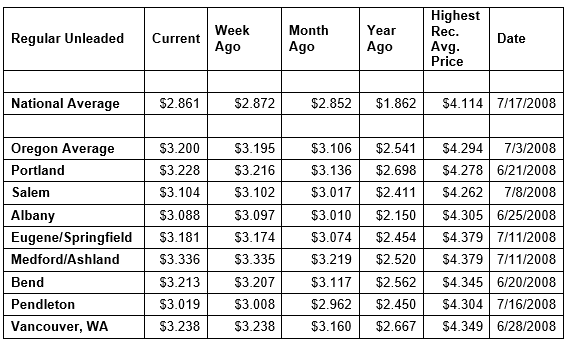
Refinery utilization is at its highest measurement this year: 84%. This strong utilization rate helped contribute to the addition of 4 million bbl of gasoline, pushing overall supply levels to 234.5 million bbl for the week ending April 2, according to the latest report from the U.S. Energy Information Administration (EIA).
“Gas prices zoomed up in March and consumers are finally seeing some stability at the pumps. Cheaper crude prices should help to keep gas price fluctuations to a minimum this week,” says Marie Dodds, public affairs director for AAA Oregon/Idaho.
For the first time in nearly two months, crude oil prices last week held below $60/bbl for five straight days. The cheaper price is a positive indicator for more stability in gas prices as crude accounts for nearly 60% of the price at the pump.
Demand for gas has dropped slightly to 8.7 million b/d. That measurement is well above the 5.5 million b/d recorded one year ago, but still significantly lower than the 9.8 million b/d seen in early April 2019. AAA expects April demand to remain below levels from 2019, but see stout increases from a year ago, when many Americans were quarantining due to COVID-19.
Visit AAA.com/covidmap for an interactive map with the latest travel restrictions and policies for North America. Find AAA’s latest COVID-19 information for travelers here.
Oregon is one of 44 states and Washington D.C. where prices have changed less than two cents in the last week. Ohio (-7 cents) has the largest weekly decrease. Hawaii (+3 cents) has the biggest week-over-week increase.
California ($3.94) and Hawaii ($3.74) continue to have the most expensive gas prices in the country. In all, 10 states and the District of Columbia are above $3, same as a week ago.
The cheapest gas in the nation is in Texas ($2.58) and Mississippi ($2.58). For the 14th week in a row, no state has an average below $2 a gallon.
Oregon is one of 28 states with higher prices now than a month ago, and six states have double-digit monthly increases. The national average is a penny more and the Oregon average is nine cents more than a month ago. This is the seventh-largest month-over-month increase in the nation. Hawaii (+19 cents) has the largest monthly increase in the country. Delaware (-8 cents) has the biggest monthly decline.
All 50 states have higher prices now than a year ago and 22 states have a current average that’s a dollar or more higher than a year ago. The national average is $1.00 more and the Oregon average is 66 cents more than a year ago. This is the third-smallest yearly increase in the nation. Wisconsin (+$1.41) has the biggest yearly increase. Hawaii (+49 cents) has the smallest year-over-year increase.
West Coast
The West Coast region continues to have the most expensive pump prices in the nation with every state in the region in the top 10.
| Rank | Region | Price on 4/13/21 | ||
| 1 | California | $3.94 | ||
| 2 | Hawaii | $3.74 | ||
| 3 | Nevada | $3.37 | ||
| 4 | Washington | $3.34 | ||
| 5 | Oregon | $3.20 | ||
| 6 | Utah | $3.16 | ||
| 7 | Alaska | $3.14 | ||
| 8 | Arizona | $3.08 | ||
| 9 | Idaho | $3.07 | ||
| 10 | Illinois | $3.06 |
California is the most expensive state for the 14th week in a row, with Hawaii, Nevada, Washington, and Oregon rounding out the top five. Alaska is seventh and Arizona is eighth. Oregon is fifth for the sixth week in a row.
All seven states in the West Coast region are among the 10 states in the country, along with D.C., that have averages above $3 a gallon.
Like the rest of the country, prices in the West Coast region show minor changes this week. Hawaii (+3 cents) has the largest weekly increase in the region and the nation. Arizona (-1 cent) has the largest week-over-week decline in the region.
According to EIA’s latest weekly report, total gas stocks in the region decreased from 31.43 million bbl to 30.88 million bbl last week. This could cause pump prices to rise if there are disruptions in supply in the region this week.
Oil market dynamics
After hitting a 12-month high of $66/bbl last month, crude oil prices have been on the decline. While last Monday saw a low of $58.65, prices fluctuated minimally throughout the week, but never hit $60/bbl. A build in U.S. gasoline supply amid mixed feelings about ongoing COVID-19 concerns, despite vaccination optimism, contributed to the lower prices.
At the close of Friday’s formal trading session, WTI decreased nearly 30 cents to settle at $59.32. At the close of Monday’s formal trading session, WTI added 38 cents to settle at $59.70. Today crude is trading around $60, compared to $59 a week ago. Crude prices are about $37 more than a year ago.
Drivers can find current Oregon gas prices along their route with the free AAA Mobile app for iPhone, iPad and Android. The app can also be used to map a route, find discounts, book a hotel and access AAA roadside assistance. Learn more at AAA.com/mobile.
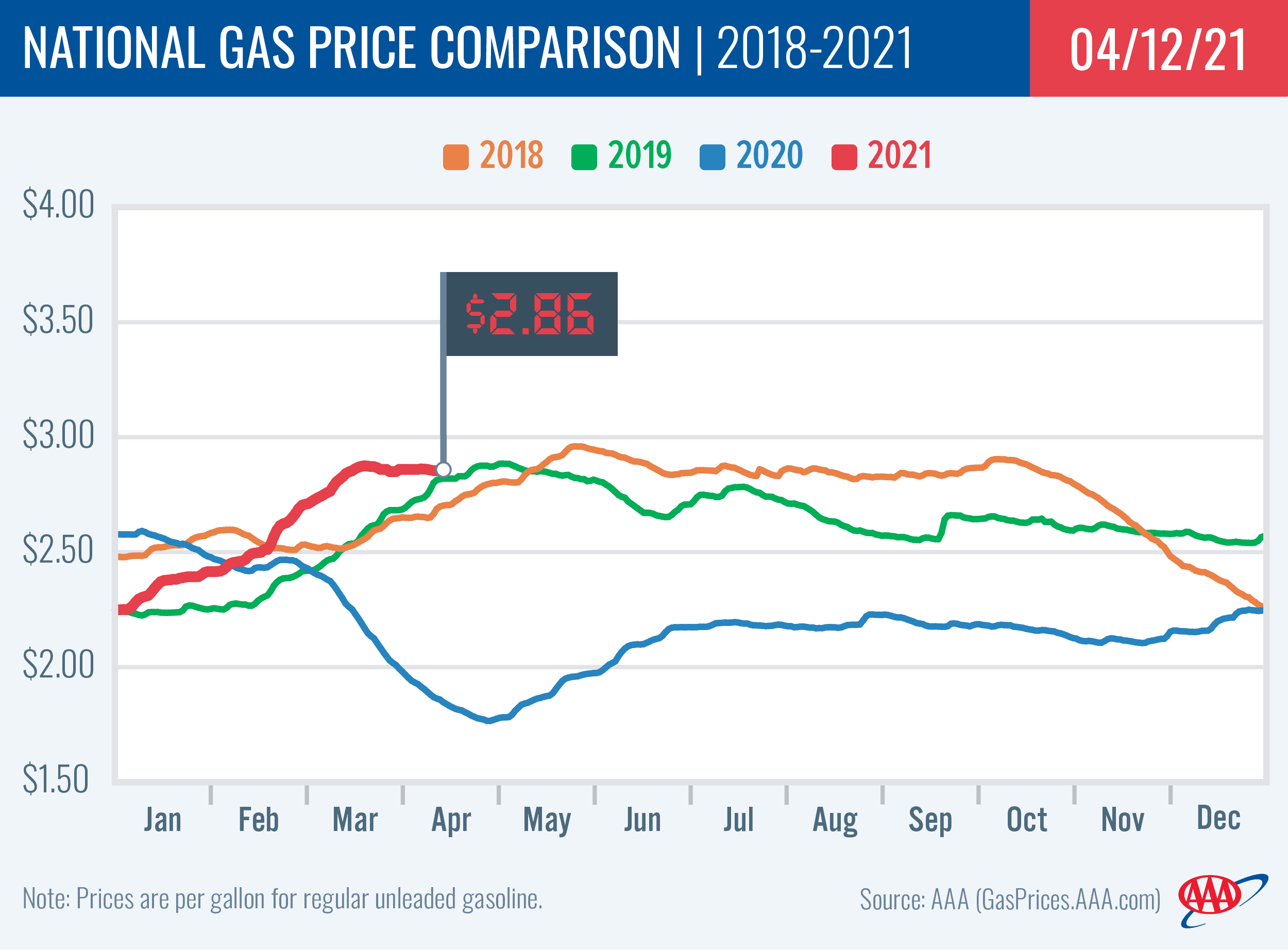
Diesel
For the week, the national average slips a penny to $3.08 a gallon. Oregon’s average remains at $3.21. A year ago the national average for diesel was $2.53 and the Oregon average was $2.74.
Find current fuel prices at GasPrices.AAA.com.
AAA news releases, high resolution images, broadcast-quality video, fact sheets and podcasts are available on the AAA NewsRoom at NewsRoom.AAA.com.
Find local news releases at https://oregon.aaa.com/community/media/media-contacts.html
Fuel prices are updated daily at AAA’s Daily Fuel Gauge at AAA Gas Prices. For more info go www.AAA.com. AAA Oregon/Idaho provides more than 840,000 members with travel, insurance, financial and automotive-related services, and is an affiliate of AAA National, serving more than 61 million motorists in North America.
Updated 4/6/2021
Gasoline Demand Jumps, Prices Fairly Steady for Now
PORTLAND, Ore., – Demand for gasoline in the U.S. continues to climb and is up nearly 4% from the previous week. Averages in all 50 states are seeing fluctuations of a nickel or less. For the week, the national average holds steady at $2.87 a gallon. The Oregon average edges up a penny to $3.20.
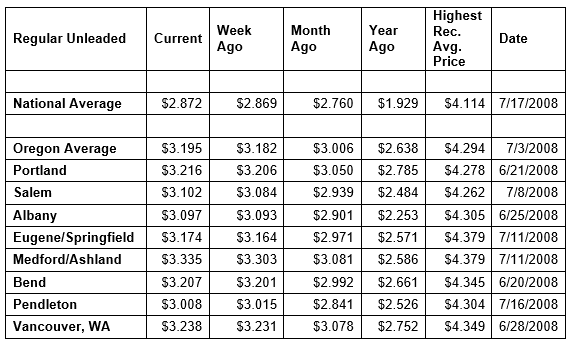
Demand for gasoline is near pre-COVID-19 levels. The latest weekly reading from the U.S. Energy Information Administration (EIA) shows demand at 8.9 million b/d. Demand was at 9.7 million b/d in mid-March last year before states put lockdowns and travel restrictions in place to slow the spread of the virus. In April of last year, demand plummeted to just 5 million b/d.
“Demand is expected to continue to rise this spring as COVID-19 vaccinations become more widely available and the weather gets warmer. This will lead to fluctuation at the pumps for the coming weeks,” says Marie Dodds, public affairs director for AAA Oregon/Idaho.
Because of the jump in demand, gasoline supplies tightened to 230.5 million bbl, the lowest level this year, according to the EIA.
Oregon dealt with some gas outages over the past week with some stations in Central and Southern Oregon temporarily running out of certain grades of gasoline. Deliveries were delayed due to some logistical issues. Maintenance along a refined products pipeline from Portland to Eugene prevented shippers from sending gas along that route. And shippers were unable to send gasoline via barge from Portland to Pasco, Washington, due to damage at the Dalles Dam navigation lock. Repairs were finished last week.
One factor that may help to keep the national gas price average below $3 per gallon is the price of crude, which accounts for nearly 60% of the price at the pump. After hitting a 12-month high of $66/bbl last month, crude has been priced mostly at the $60/bbl mark recently. If it stays relatively low, even with demand increasing, it will contribute to less frequent pump price jumps. However, at the end of last week, crude started to see higher movement following a production announcement by Organization of the Petroleum Exporting Countries Plus (OPEC+).
Visit AAA.com/covidmap for an interactive map with the latest travel restrictions and policies for North America. Find AAA’s latest COVID-19 information for travelers here.
Oregon is one of 21 states with higher prices now than a week ago, but all increases are relatively small—a nickel or less. Ohio (+5 cents) has the largest weekly increase. Florida (-3 cents) has the largest weekly decline. The averages in all 50 states and the District of Columbia have changed by less than a nickel this week.
California ($3.92) and Hawaii ($3.70) continue to have the most expensive gas prices in the country. In all, 10 states and the District of Columbia are above $3, same as a week ago.
The cheapest gas in the nation can be found in Mississippi ($2.58) and Texas ($2.59). For the 13th week in a row, no state has an average below $2 a gallon.
Oregon is one of 48 states and the District of Columbia with higher prices now than a month ago, and 27 states and D.C. have double-digit monthly increases. The national average is 11 cents more and the Oregon average is 19 cents more than a month ago. This is the seventh-largest month-over-month increase in the nation. Utah (+45 cents) has the largest monthly increase in the country. Nebraska (+1 cent) has the smallest. Delaware (-1 cent) and Pennsylvania (-3/10ths of a cent) are the only two states with monthly declines.
All 50 states have higher prices now than a year ago and all have double-digit increases. The national average is 94 cents more and the Oregon average is 57 cents more than a year ago. This is the second-smallest yearly increase in the nation. Wisconsin (+$1.30 cents) has the biggest yearly increase. Hawaii (+40 cents) has the smallest year-over-year increase.
West Coast
The West Coast region continues to have the most expensive pump prices in the nation with every state in the region in the top 10.
| Rank | Region | Price on 4/6/21 | ||
| 1 | California | $3.92 | ||
| 2 | Hawaii | $3.70 | ||
| 3 | Nevada | $3.33 | ||
| 4 | Washington | $3.33 | ||
| 5 | Oregon | $3.20 | ||
| 6 | Utah | $3.16 | ||
| 7 | Alaska | $3.13 | ||
| 8 | Arizona | $3.09 | ||
| 9 | Illinois | $3.08 | ||
| 10 | Idaho | $3.07 |
California is the most expensive state for the 13th week in a row, with Hawaii, Nevada, Washington, and Oregon rounding out the top five. Alaska is seventh and Arizona is eighth. Oregon is fifth for the fifth week in a row.
All seven states in the West Coast region are among the 10 states in the country, along with D.C., that have averages above $3 a gallon.
Like the rest of the country, prices show moderate changes in the West Coast region this week. Hawaii (+4 cents) has the largest weekly increase in the region. Arizona (-1 cent) has the largest week-over-week decline in the region.
According to EIA’s latest weekly report, total gas stocks in the region increased from 30.73 million bbl to 31.43 million bbl last week. This could help stabilize prices in the region this week.
Oil market dynamics
Crude oil prices saw gains at the end of the week following the OPEC+ announcement that they will modestly increase production by 350,000 bbl starting in May. The production increase is less than the market expected, but enough to send crude oil prices higher. Oil prices fell Monday on investor concern that rising COVID-19 cases will slow a rebound in demand for oil and fuel. Prices are likely to continue to fluctuate this week, but not spike.
At the close of last week’s formal trading session, WTI increased $2.29 to settle at $61.45. At the close of Monday’s formal trading session, WTI fell $2.80 to settle at $58.65. Today crude is trading around $59, compared to $61 a week ago. Crude prices are about $30 more than a year ago.
Drivers can find current Oregon gas prices along their route with the free AAA Mobile app for iPhone, iPad and Android. The app can also be used to map a route, find discounts, book a hotel and access AAA roadside assistance. Learn more at AAA.com/mobile.
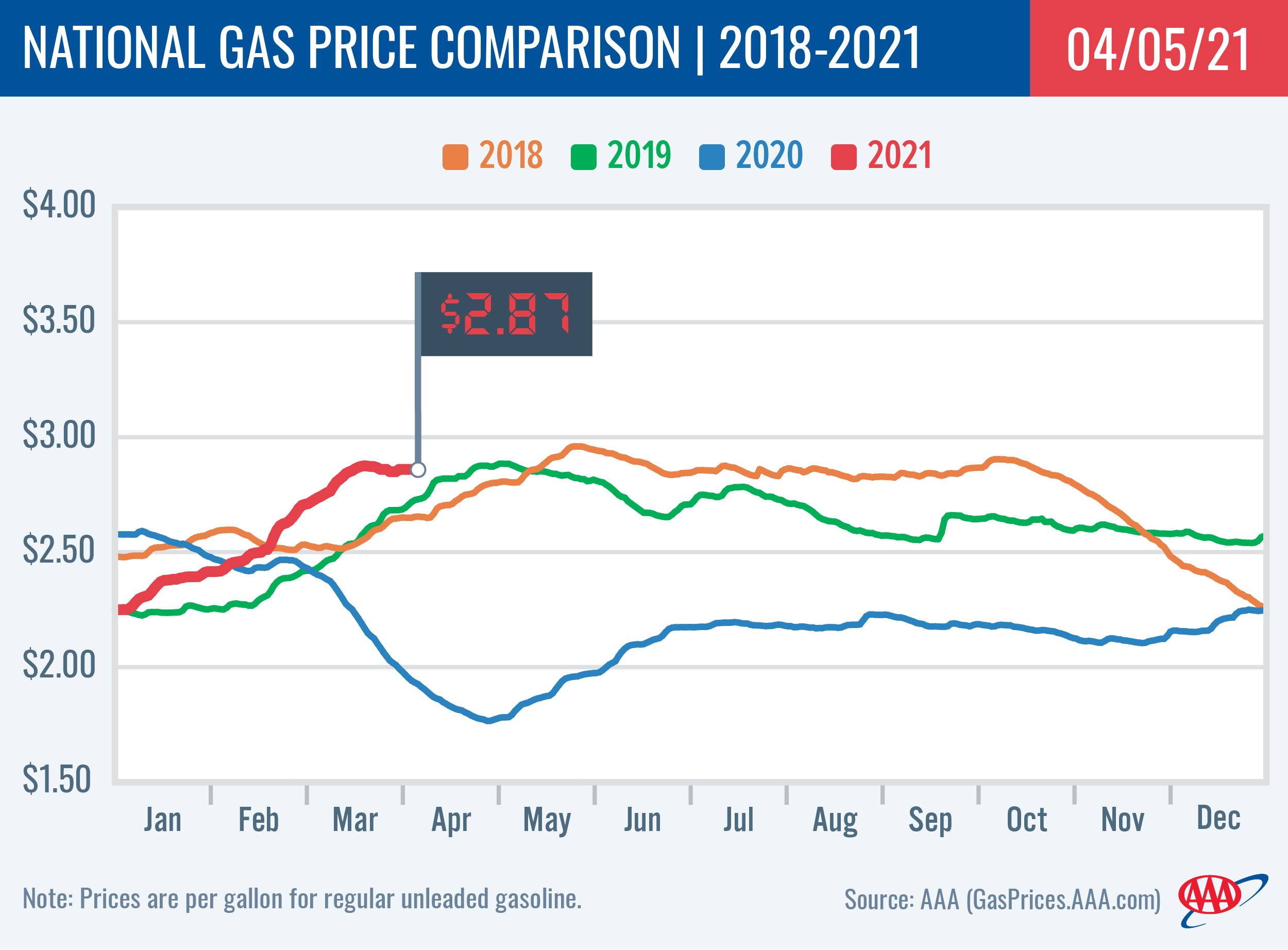
Diesel
For the week, the national average slips a penny to $3.09 a gallon. Oregon’s average ticks up half a cent to $3.21. A year ago the national average for diesel was $2.57 and the Oregon average was $2.83.
Find current fuel prices at GasPrices.AAA.com.
AAA news releases, high resolution images, broadcast-quality video, fact sheets and podcasts are available on the AAA NewsRoom at NewsRoom.AAA.com.
Find local news releases at https://oregon.aaa.com/community/media/media-contacts.html
Fuel prices are updated daily at AAA’s Daily Fuel Gauge at AAA Gas Prices. For more info go www.AAA.com. AAA Oregon/Idaho provides more than 840,000 members with travel, insurance, financial and automotive-related services, and is an affiliate of AAA National, serving more than 61 million motorists in North America.
March Oregon Gas Price News
Updated 3/30/2021
National Average has First Week-over-week Decline since November;
Oregon Average has Small Increase
PORTLAND, Ore., – For the second week in a row, we’re not seeing dramatic increases in pump prices. Growing supplies and cheaper crude oil are helping gas prices stabilize or even decrease in some areas. For the week, the national average for regular edges down a penny to $2.87 a gallon. The Oregon average adds two cents to $3.18.
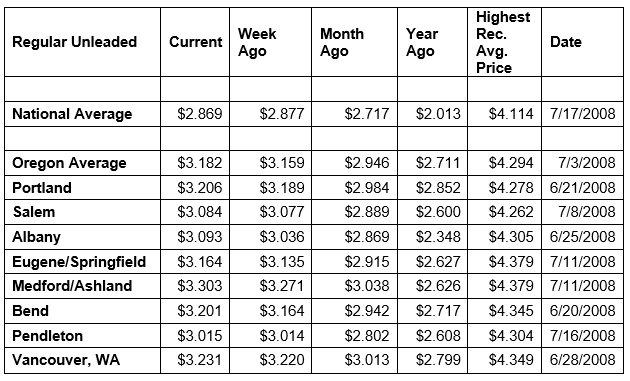
This is the first time since November that the national average has a week-over-week decline.
“Rising gasoline stock levels and declining crude prices mean less expensive gas prices could be coming but it’s too early to call it a trend just yet,” says Marie Dodds, public affairs director for AAA Oregon/Idaho. “For now, though, it looks like most areas won’t see big weekly jumps in pump prices unless we have a disruption in supplies.”
Gasoline stocks saw a moderate increase with a build of 200,000 b/d. However, refinery utilization hit 82% indicating we could see a larger build in stocks this week, a factor that could help keep pump prices in check.
Lower crude oil prices are also putting some downward pressure on pump prices. Crude averaged about $60/bbl last week, down from $63/bbl the previous week and $65/bbl the week before that.
Demand for gas is increasing. The U.S. Energy Information Administration (EIA) reports that demand was up by 174,000 b/d to 8.6 million b/d last week. That reading is just 222,000 b/d short of levels one year ago, when demand started to dip as states put lockdowns and travel restrictions in place to halt the spread of COVID-19. If demand continues to increase, prices could follow.
Visit AAA.com/covidmap for an interactive map with the latest travel restrictions and policies for North America. Find AAA’s latest COVID-19 information for travelers here.
Oregon is one of 13 states with higher prices now than a week ago. Ohio (+8 cents) has the largest weekly increase. Delaware (-6 cents) has the largest weekly decline.
California ($3.90) and Hawaii ($3.66) continue to have the most expensive gas prices in the country. In all, 10 states and the District of Columbia are above $3, down from 11 states and D.C. a week ago.
The cheapest gas in the nation can be found in Mississippi ($2.59) and South Carolina ($2.60). For the 12th week in a row, no state has an average below $2 a gallon.
All 50 states and the District of Columbia have higher prices now than a month ago and 37 states and D.C. have double-digit monthly increases. The national average is 15 cents more and the Oregon average is 24 cents more than a month ago. This is the eighth-largest month-over-month increase in the nation. Utah (+65 cents) has the largest monthly increase in the country. Indiana (+1 cent) has the smallest.
All 50 states have higher prices now than a year ago and all have double-digit increases. The national average is 86 cents more and the Oregon average is 47 cents more than a year ago. This is the 50th-largest yearly increase in the nation. Wisconsin (+$1.10 cents) has the biggest yearly increase. Hawaii (+30 cents) has the smallest year-over-year increase.
West Coast
The West Coast region continues to have the most expensive pump prices in the nation with every state in the region in the top 10.
| Rank | Region | Price on 3/30/21 | ||
| 1 | California | $3.90 | ||
| 2 | Hawaii | $3.66 | ||
| 3 | Washington | $3.33 | ||
| 4 | Nevada | $3.31 | ||
| 5 | Oregon | $3.18 | ||
| 6 | Utah | $3.15 | ||
| 7 | Alaska | $3.12 | ||
| 8 | Arizona | $3.10 | ||
| 9 | Idaho | $3.05 | ||
| 10 | Illinois | $3.05 |
Prices show moderate changes in the West Coast region this week. Hawaii (+5 cents) has the largest weekly increase in the region. Arizona (-1 cent) has the largest week-over-week decline in the region.
According to EIA’s latest weekly report, total gas stocks in the region decreased from 31.34 million bbl to 30.76 million bbl last week. This could put some upward pressure on prices in the region this week.
Oil market dynamics
Crude prices fluctuated throughout last week from a low of $57.76 to a high of $61.55 in reaction to world news, including concerns of new European Union lock downs and tight vaccination supplies throughout local economies. Also affecting the price of crude was news Thursday of a stranded container ship, which continued to block the Suez Canal, a major international oil-supply route. The ship was finally freed on Monday. While ships started to re-route last week, some oil deliveries were delayed. This has had limited impact here as U.S. oil production should be able to keep stateside supply balanced and in turn, prices stable.
At the close of Friday’s formal trading session, WTI increased to settle at $60.97. At the close of Monday’s formal trading session, WTI added 59 cents to settle at $61.56. Today crude is trading around $61, compared to $58 a week ago. Crude prices are about $40 more than a year ago.
Drivers can find current Oregon gas prices along their route with the free AAA Mobile app for iPhone, iPad and Android. The app can also be used to map a route, find discounts, book a hotel and access AAA roadside assistance. Learn more at AAA.com/mobile.
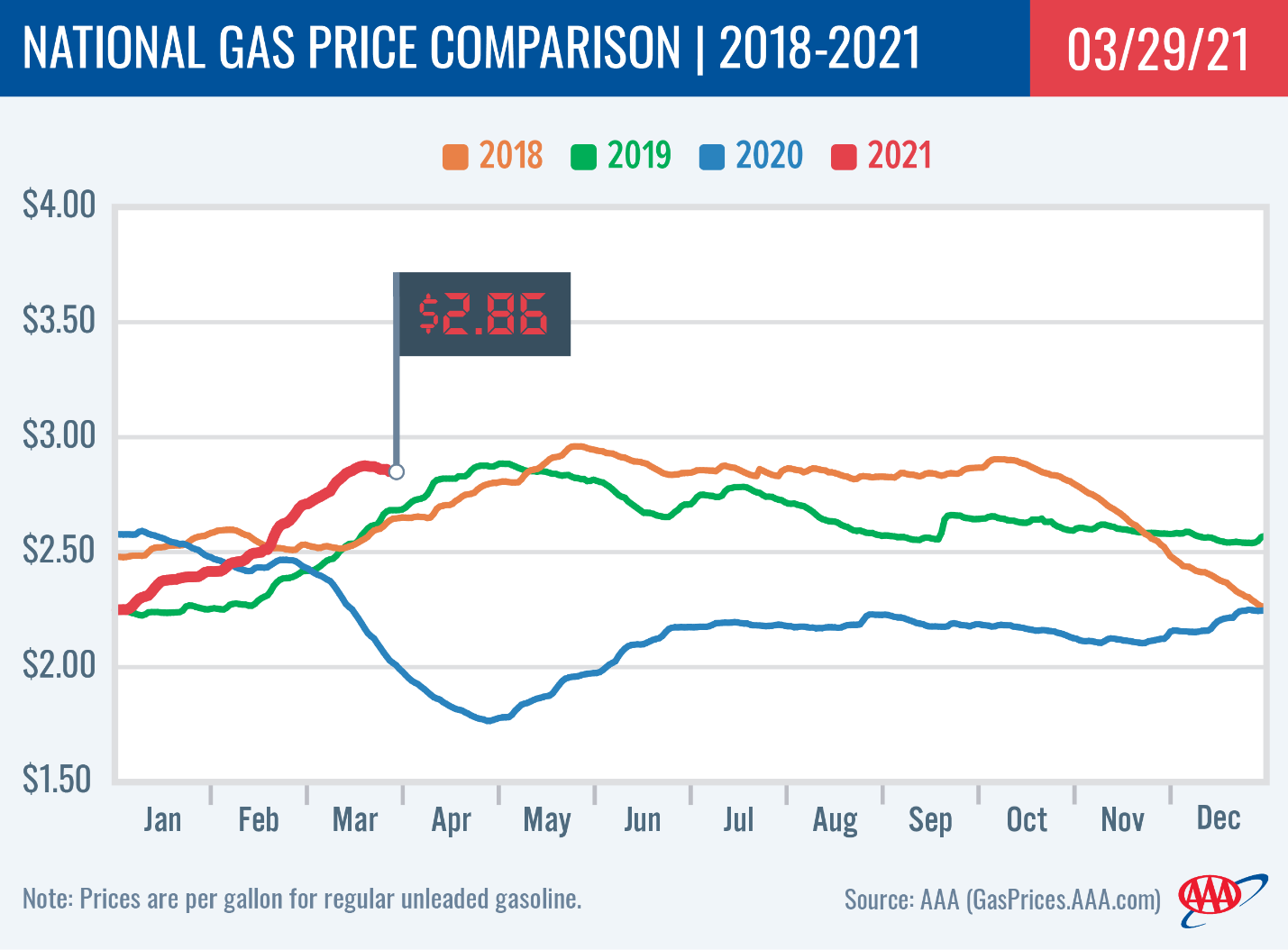
Diesel
For the week, the national average slips a penny to $3.10 a gallon. Oregon’s average gains two cents to $3.20. A year ago the national average for diesel was $2.61 and the Oregon average was $2.89.
Find current fuel prices at GasPrices.AAA.com.
AAA news releases, high resolution images, broadcast-quality video, fact sheets and podcasts are available on the AAA NewsRoom at NewsRoom.AAA.com.
Find local news releases at https://oregon.aaa.com/community/media/media-contacts.html
Fuel prices are updated daily at AAA’s Daily Fuel Gauge at AAA Gas Prices. For more info go www.AAA.com. AAA Oregon/Idaho provides more than 840,000 members with travel, insurance, financial and automotive-related services, and is an affiliate of AAA National, serving more than 61 million motorists in North America.
Updated 3/23/2021
Pump Price Increases Slow Down
PORTLAND, Ore., – After several weeks of pump prices rising almost every day, gas prices are showing some signs of stability. The rate of increase is slowing down in most states and other states are seeing weekly declines, due to a dip in demand, growing supplies and lower crude oil prices. For the week, the national average for regular ticks up half a cent to $2.88 a gallon. The Oregon average climbs three cents to $3.16. These increases follow jumps of eight and nine cents, respectively, last week.
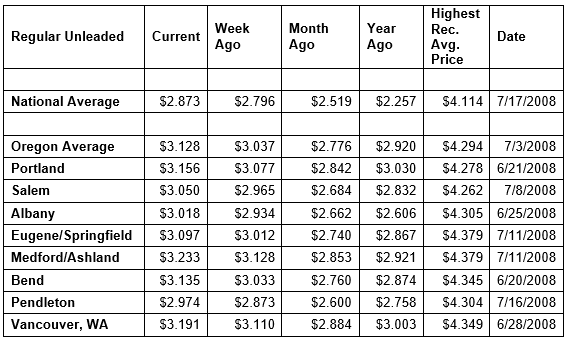
The national average is at its highest price since May 2019. The Oregon average is at its highest price since December 2019.
“The slower rate of increases doesn’t mean gas prices have peaked for the season, but it is a positive sign for consumers,” says Marie Dodds, public affairs director for AAA Oregon/Idaho. “Drivers can still expect fluctuation at the pumps. However, large jumps are not likely for most of us, barring unexpected events.”
Demand for gas has decreased from 8.7 million b/d to 8.4 million b/d according to the latest weekly report from the U.S. Energy Information Administration. Supply has increased from 231.6 million bbl to 232 million bbl. While still one of the lowest levels of 2021, the increase in supply is promising especially alongside increasing refinery utilization rates, which jumped from 69% to 76%. That is just 7 percentage points away from utilization levels before February’s Texas winter storm.
Further aiding the more modest jumps at the pump in the last week is the lower price of crude oil. Crude averaged around $63/bbl, down $2/bbl from the previous week’s average of $65/bbl.
Demand for gasoline will likely increase again this spring and summer, as more Americans get the COVID-19 vaccine, and return to more normal activities such as school, work and vacations.
Visit AAA.com/covidmap for an interactive map with the latest travel restrictions and policies for North America. Find AAA’s latest COVID-19 information for travelers here.
Oregon is one of 31 states and the District of Columbia with higher prices now than a week ago. Oregon is one of 22 states where the weekly increase is three cents or less. Utah (+17 cents) has the largest weekly increase. Michigan (-7 cents) has the largest weekly decline.
California ($3.88) and Hawaii ($3.61) continue to have the most expensive gas prices in the country. In all, 12 states are above $3, up from 10 states a week ago.
The cheapest gas in the nation can be found in Mississippi ($2.61) and Texas ($2.63). For the 11th week in a row, no state has an average below $2 a gallon.
All 50 states and the District of Columbia have higher prices now than a month ago and all but two states have a double-digit monthly increase. The national average is 23 cents more and the Oregon average is 29 cents more than a month ago. This is the 16th-largest month-over-month increase in the nation. Utah (+70 cents) has the largest monthly increase in the country. Ohio (+1 cent) has the smallest.
All 50 states have higher prices now than a year ago and all have double-digit increases. The national average is 75 cents more and the Oregon average is 33 cents more than a year ago. This is the 50th-largest yearly increase in the nation. Oklahoma (+96 cents) has the biggest yearly increase. Hawaii (+16 cents) has the smallest year-over-year increase.
West Coast
The West Coast region continues to have the most expensive pump prices in the nation with every state in the region in the top 10.
| Rank | Region | Price on 3/23/21 | ||
| 1 | California | $3.88 | ||
| 2 | Hawaii | $3.61 | ||
| 3 | Washington | $3.32 | ||
| 4 | Nevada | $3.30 | ||
| 5 | Oregon | $3.16 | ||
| 6 | Utah | $3.16 | ||
| 7 | Alaska | $3.12 | ||
| 8 | Arizona | $3.11 | ||
| 9 | Illinois | $3.06 | ||
| 10 | District of Columbia | $3.06 |
California is the most expensive state for the 11th week in a row, with Hawaii, Washington, Nevada, and Oregon rounding out the top five. Alaska is seventh and Arizona is eighth. Oregon is fifth for the third week in a row.
All seven states in the West Coast region are among the 12 states in the country that have averages above $3 a gallon.
Prices increased in every state in the West Coast region this week. Hawaii (+5 cents) has the largest weekly increase in the region. Arizona (+1 cent) has the smallest week-over-week increase in the region.
According to EIA’s latest weekly report, total gas stocks in the region decreased from 31.63 million bbl to 31.34 million bbl last week. This could put some upward pressure on prices in the region this week.
Oil market dynamics
Crude prices rose slightly Monday but have fallen today as investors are concerned about another COVID-19 wave across Europe. Although the price of crude increased Friday after Saudi Arabia reported a drone attack on an oil facility that caused a fire but no injuries or damage, crude prices declined last week due to market concern that demand may stumble as some countries restart coronavirus restrictions to curb growing infection rates. The decrease in crude prices was also supported by EIA reporting that total crude inventories increased by 2.4 million bbl to 500.8 million bbl. For this week, crude prices may decline further if demand concerns persist.
At the close of Friday’s formal trading session, WTI increased by $1.42 cents to settle at $61.42. At the close of Monday’s formal trading session, WTI added 13 cents to settle at $61.55. Today crude is trading around $59, compared to $65 a week ago. Crude prices are about $39 more than a year ago.
Drivers can find current Oregon gas prices along their route with the free AAA Mobile app for iPhone, iPad and Android. The app can also be used to map a route, find discounts, book a hotel and access AAA roadside assistance. Learn more at AAA.com/mobile.
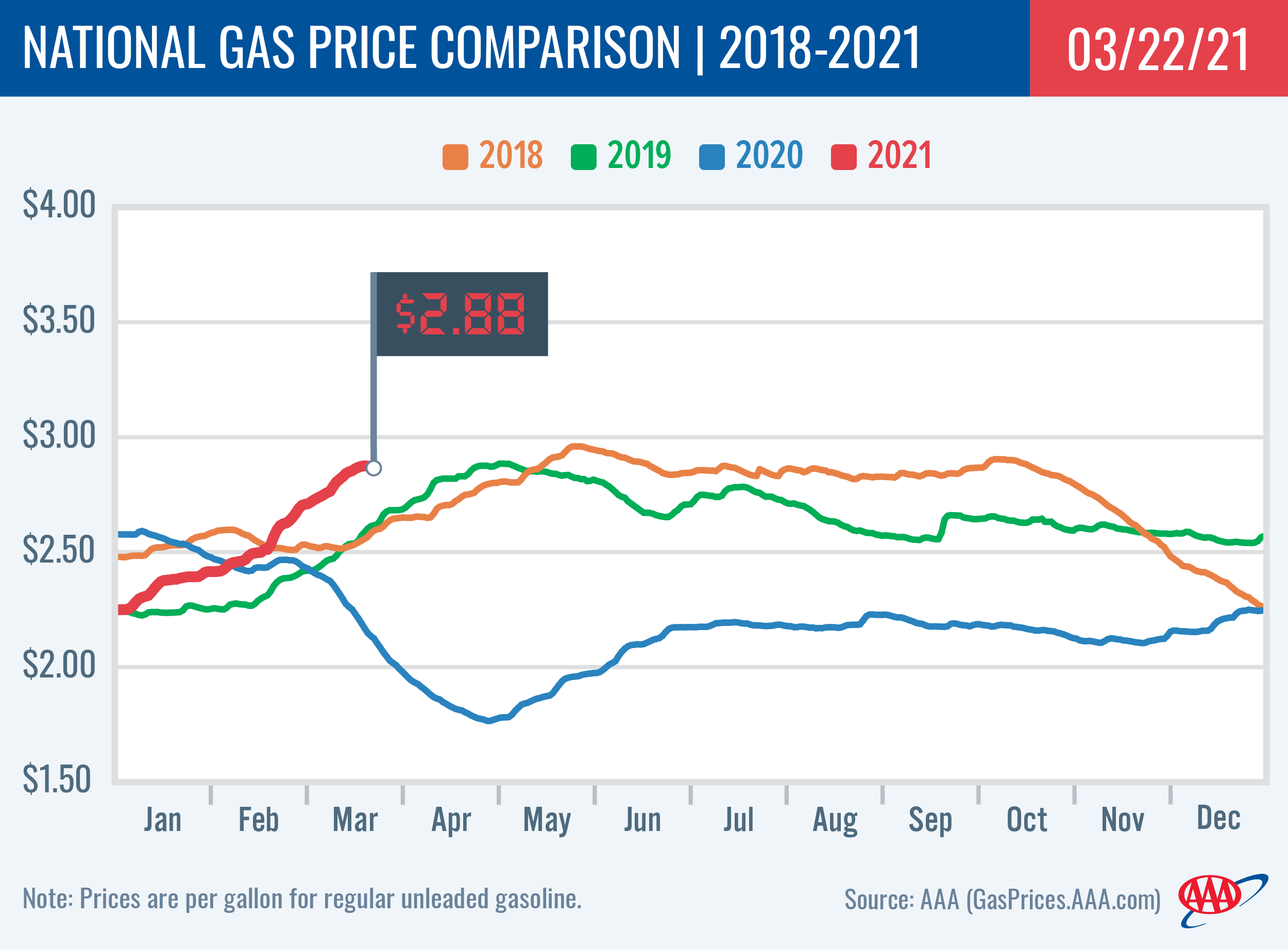
Diesel
For the week, the national average adds two cents to $3.11 a gallon. Oregon’s average rises four cents to $3.19. A year ago the national average for diesel was $2.67 and the Oregon average was $2.99.
Find current fuel prices at GasPrices.AAA.com.
AAA news releases, high resolution images, broadcast-quality video, fact sheets and podcasts are available on the AAA NewsRoom at NewsRoom.AAA.com.
Find local news releases at https://oregon.aaa.com/community/media/media-contacts.html
Fuel prices are updated daily at AAA’s Daily Fuel Gauge at AAA Gas Prices. For more info go www.AAA.com. AAA Oregon/Idaho provides more than 840,000 members with travel, insurance, financial and automotive-related services, and is an affiliate of AAA National, serving more than 61 million motorists in North America.
Updated 3/16/2021
Oregonians paying 13% More at the Pumps since mid-February
PORTLAND, Ore., – Following last month’s winter storm in Texas, the Oregon average has jumped 13% and the national average 14%, and this week 16 states are seeing double-digit increases. For the week, the national average for regular rises eight cents to $2.87 a gallon. The Oregon average jumps nine cents to $3.13.
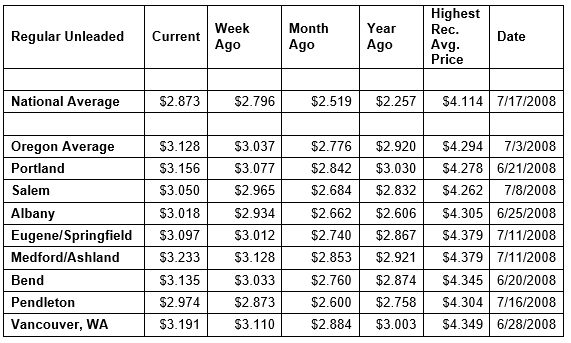
The national average is at its highest price since May 2019. The Oregon average is at its highest price since December 2019.
Prices will continue to increase this week, especially following the U.S. Energy Information Administration’s (EIA) latest weekly reports showing a second week of major decline in gasoline stocks and a substantial increase in U.S. demand.
“With increased demand and tighter gasoline supplies, we are looking at more expensive pump prices with little relief in the weeks ahead,” says Marie Dodds, public affairs director for AAA Oregon/Idaho.
For the week ending March 5, the EIA reports gas stocks decreased by nearly 12 million bbl to 231.6 million bbl, as demand increased from 8.15 million b/d to 8.73 million b/d. That demand measurement is the highest since the end of November 2020, which coincidentally was the same month we saw stocks as low as they are today.
Amid tightening supply and increasing demand, the good news is that the price of crude, which accounts for more than half of the price at the pump, showed signs of stability on the week fluctuating between $64–$66/bbl. If crude sustains at this level, especially as refinery utilization increases, the jumps at the pump are likely not to be so substantial by April.
One reason for the increased demand for gasoline is that several states are easing or eliminating COVID-related mandates and restrictions. Visit AAA.com/covidmap for an interactive map with the latest travel restrictions and policies for North America. Find AAA’s latest COVID-19 information for travelers here.
Oregon is one of 49 states and the District of Columbia with higher prices now than a week ago, and 16 states are seeing double-digit increases. Utah (+26 cents) has the largest weekly increase. Ohio (+1 cent) has the smallest weekly increase. Indiana (-1/2 cent) is the only two state with a weekly decrease.
While California ($3.86) and Hawaii ($3.56) started the year above the $3 per gallon mark, several other states have now followed suit: Washington ($3.28), Nevada ($3.23), Oregon ($3.04), Arizona ($3.10), Illinois ($3.09), Alaska ($3.07), District of Columbia ($3.05) and Pennsylvania ($3.04). In all, 10 states are above $3, up from seven states a week ago.
The cheapest gas in the nation can be found in Mississippi ($2.58) and Louisiana ($2.61). For the 10th week in a row, no state has an average below $2 a gallon.
All 50 states and the District of Columbia have higher prices now than a month ago and every state has a double-digit monthly increase. The national average is 35 cents more and the Oregon average is also 35 cents more than a month ago. This is the 30th-largest month-over-month increase in the nation. Utah (+61 cents) has the largest monthly increase in the country. Hawaii (+19 cents) has the smallest.
All 50 states have higher prices now than a year ago. The national average is 62 cents more and the Oregon average is 21 cents more than a year ago. This is the 50th-largest yearly increase in the nation. Illinois (+78 cents) has the biggest yearly increase. Hawaii (+4 cents) has the smallest year-over-year increase.
West Coast
The West Coast region continues to have the most expensive pump prices in the nation with every state in the region in the top 10.
| Rank | Region | Price on 3/16/21 | ||
| 1 | California | $3.86 | ||
| 2 | Hawaii | $3.56 | ||
| 3 | Washington | $3.28 | ||
| 4 | Nevada | $3.23 | ||
| 5 | Oregon | $3.13 | ||
| 6 | Arizona | $3.10 | ||
| 7 | Illinois | $3.09 | ||
| 8 | Alaska | $3.07 | ||
| 9 | District of Columbia | $3.05 | ||
| 10 | Pennsylvania | $3.04 |
California is the most expensive state for the 10th week in a row, with Hawaii, Washington, Nevada, Oregon, and Arizona rounding out the top six. Oregon is fifth for the second week in a row. Alaska is eighth.
As mentioned above, California, Hawaii, Washington, Nevada, Oregon, Arizona, and Alaska are seven of the 10 states in the nation with averages at or above $3 a gallon.
Prices increased in every state in the West Coast region this week, just like the rest of the country. California (+9 cents) has the largest weekly increase in the region. Hawaii (+5 cents) has the smallest week-over-week increase in the region.
According to EIA’s latest weekly report, total gas stocks in the region decreased from 32.04 million bbl to 31.63 million bbl last week. This will likely put upward pressure on prices in the region this week.
Oil market dynamics
Crude prices remain at their highest prices in nearly two years. Although the price of crude decreased on Friday, due to a stronger dollar, crude prices rose earlier last week to $66/bbl with market optimism about crude demand recovery. Crude prices increased despite EIA’s latest weekly report revealing that crude inventories increased by 13.8 million bbl to 498.4 million bbl. For this week, crude prices declined slightly Monday as market-watchers were concerned about increasing COVID-19 cases and new lockdowns in Europe.
At the close of Friday’s formal trading session, WTI decreased by 41 cents to settle at $65.61. At the close of Monday’s formal trading session, WTI lost 22 cents to settle at $65.39. Today crude is trading around $64, compared to $64 a week ago. Crude prices are about $34 more than a year ago.
Drivers can find current Oregon gas prices along their route with the free AAA Mobile app for iPhone, iPad and Android. The app can also be used to map a route, find discounts, book a hotel and access AAA roadside assistance. Learn more at AAA.com/mobile.

Diesel
For the week, the national average climbs seven cents to $3.09 a gallon. Oregon’s average rises eight cents to $3.15. A year ago the national average for diesel was $2.74 and the Oregon average was $3.07.
Find current fuel prices at GasPrices.AAA.com.
AAA news releases, high resolution images, broadcast-quality video, fact sheets and podcasts are available on the AAA NewsRoom at NewsRoom.AAA.com.
Find local news releases at https://oregon.aaa.com/community/media/media-contacts.html
Fuel prices are updated daily at AAA’s Daily Fuel Gauge at AAA Gas Prices. For more info go www.AAA.com. AAA Oregon/Idaho provides more than 840,000 members with travel, insurance, financial and automotive-related services, and is an affiliate of AAA National, serving more than 61 million motorists in North America.
Updated 3/9/2021
Crude and Gas Prices Continue to Surge as Stocks Tighten
PORTLAND, Ore., – Every state average for regular gasoline has climbed by double-digits since February resulting in 1 in 10 gas stations in the nation with pump prices that are $3 a gallon or more. Pump prices are surging due to the highest crude oil prices in nearly two years and refinery utilization at a record low. For the week, the national average for regular climbs seven cents to $2.80 a gallon. The Oregon average also adds seven cents to $3.04.
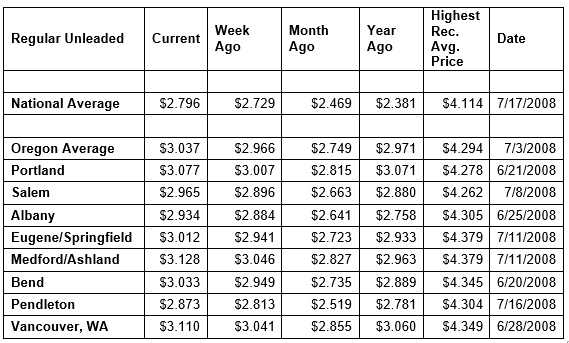
The Oregon average was last at $3 a gallon in January 2020. The last time we saw the national average flirt with $3 was nearly three years ago in May 2018. At that time, crude was averaging about $71 per barrel.
The national average is at its highest price since June 2019. The Oregon average is at its highest price since December 2019.
“With crude oil prices back on the rise, we could see the national average climb towards $2.95 and the Oregon average to $3.25 this spring with some relief by early summer,” says Marie Dodds, public affairs director for AAA Oregon/Idaho.
The Energy Information Administration’s (EIA) report for the week ending February 26 shows refinery capacity at 56%, which is the lowest rate recorded by the agency. It is also 12 percentage points below last week and 18 percentage points lower than a year ago. EIA data also points to a decrease in gasoline stocks down to 243.4 million bbl, which is 3.5% below levels at the end of February 2020.
Demand for gasoline is showing moderate increases, but still lags behind 2020 levels due to the coronavirus pandemic. The EIA reports demand at 8.1 million barrels per day for the week, compared to 9.2 million barrels for the same week in 2020, which was just before state lockdowns and working/school from home started.
“With refinery utilization at a record low, gasoline supplies tightening, demand modestly increasing and crude prices on the rise, cheap pump prices are in the rear view mirror for the immediate future,” adds Dodds.
Visit AAA.com/covidmap for an interactive map with the latest travel restrictions and policies for North America. Find AAA’s latest COVID-19 information for travelers here.
Oregon is one of 48 states and the District of Columbia with higher prices now than a week ago and seven states are seeing double-digit increases. Utah (+21 cents) has the largest weekly increase. West Virginia (+1 cent) has the smallest weekly increase. Indiana (-1 cent) and Ohio (-2/10ths of a cent) are the only two states with a weekly decrease.
While California ($3.70) and Hawaii ($3.48) started the year above the $3 per gallon mark, a handful of other states have now followed suit: Washington ($3.19), Nevada ($3.12), Oregon ($3.04), Arizona ($3.02) and Pennsylvania ($3.01). In all, seven states are above $3, up from four states a week ago. $3.04)
The cheapest gas in the nation can be found in Mississippi ($2.47) and Louisiana ($2.51). For the ninth week in a row, no state has an average below $2 a gallon.
All 50 states and the District of Columbia have higher prices now than a month ago and every state has a double-digit monthly increase. The national average is 33 cents more and the Oregon average is 29 cents more than a month ago. This is the 38th-largest month-over-month increase in the nation. Arizona (+58 cents) has the largest monthly increase in the country. Hawaii (+17 cents) has the smallest.
Oregon is one 49 states with higher prices now than a year ago. The national average is 42 cents more and the Oregon average is seven cents more than a year ago. This is the 49th-largest yearly increase in the nation. Iowa (+56 cents) has the biggest yearly increase. Hawaii (-3 cents) is the only state with a year-over-year decline.
West Coast
The West Coast region continues to have the most expensive pump prices in the nation with every state in the region in the top 10.
| Rank | Region | Price on 3/9/21 | ||
| 1 | California | $3.76 | ||
| 2 | Hawaii | $3.51 | ||
| 3 | Washington | $3.19 | ||
| 4 | Nevada | $3.12 | ||
| 5 | Oregon | $3.04 | ||
| 6 | Arizona | $3.02 | ||
| 7 | Pennsylvania | $3.01 | ||
| 8 | Alaska | $3.00 | ||
| 9 | Illinois | $2.95 | ||
| 10 | District of Columbia | $2.94 |
California is the most expensive state for the ninth week in a row, with Hawaii, Washington, Nevada, Oregon, and Arizona rounding out the top six. Oregon rises to fifth after spending the last seven weeks at sixth. Alaska is eighth.
As mentioned above, California, Hawaii, Washington, Nevada, Oregon and Arizona are six of the seven states in the nation with averages at or above $3 a gallon.
Prices increased in every state in the West Coast region this week, just like the rest of the country. Alaska (+10 cents) has the largest weekly increase in the region. Arizona (+3 cents) has the smallest week-over-week increase in the region.
According to EIA’s latest weekly report, total gas stocks in the region decreased slightly from 32.64 million bbl to 32.04 million bbl last week. This will likely put upward pressure on prices in the region this week.
Oil market dynamics
Crude prices remain at their highest prices in nearly two years. At the end of last week, OPEC+ announced the decision to add only about 170,000 barrels per day to world markets in April. The industry had been expecting a production increase of about 1.5 million barrels per day in April, with more oil released in May, June, and beyond. This decision sent crude oil surging to the highest price point since April 2019. For this week, prices may continue to increase if the market remains optimistic about crude demand as COVID-19 vaccines become more widespread.
At the close of Friday’s formal trading session, WTI increased by $2.26 to settle at $66.09. At the close of Monday’s formal trading session, WTI lost $1.04 to settle at $65.05. Today crude is trading around $64, compared to $61 a week ago. Crude prices are about $24 more than a year ago.
Drivers can find current Oregon gas prices along their route with the free AAA Mobile app for iPhone, iPad and Android. The app can also be used to map a route, find discounts, book a hotel and access AAA roadside assistance. Learn more at AAA.com/mobile.
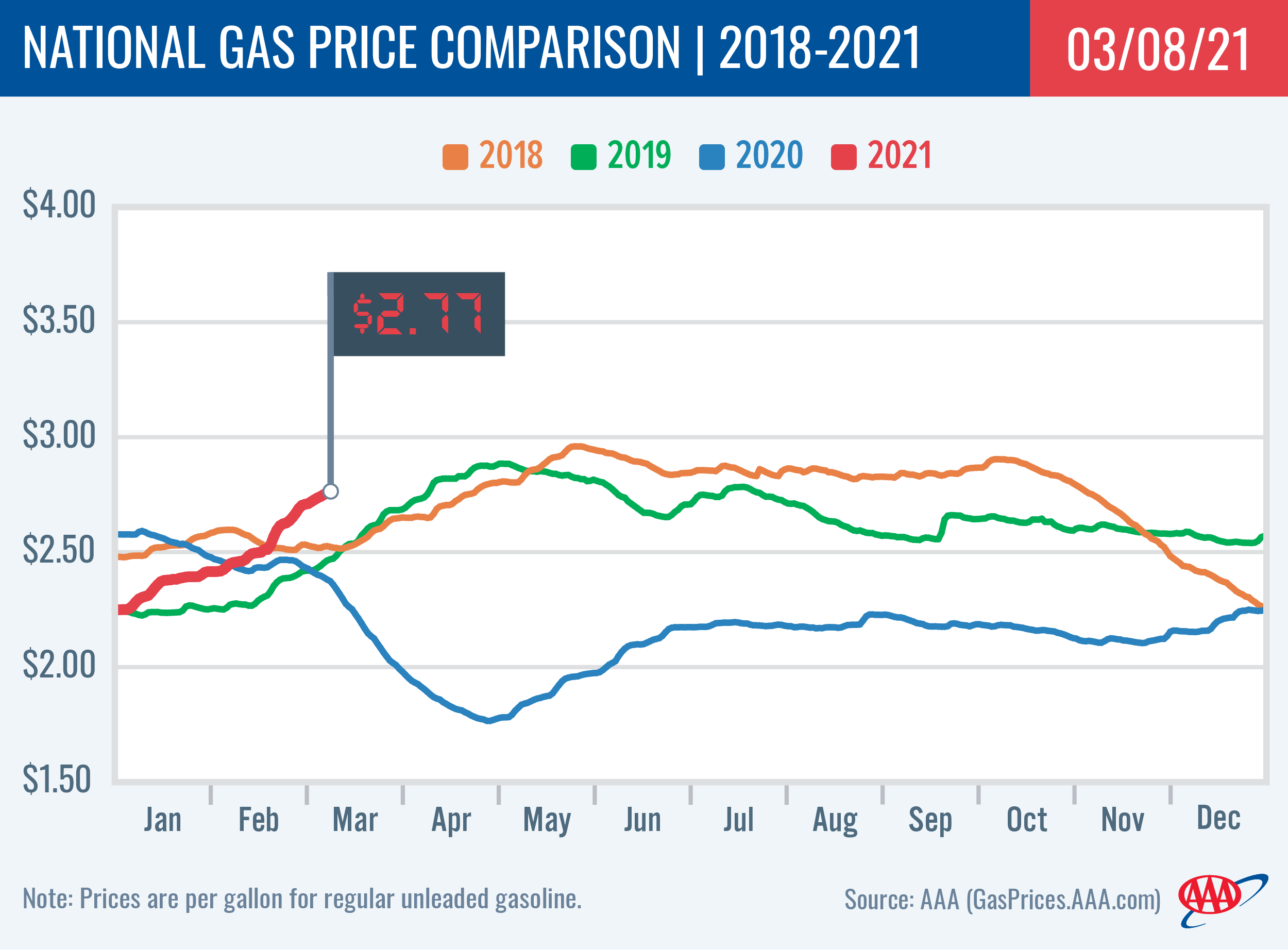
Diesel
For the week, the national average climbs seven cents to $3.02 a gallon. Oregon’s average rises six cents to $3.07. A year ago the national average for diesel was $2.81 and the Oregon average was $3.13.
Find current fuel prices at GasPrices.AAA.com.
AAA news releases, high resolution images, broadcast-quality video, fact sheets and podcasts are available on the AAA NewsRoom at NewsRoom.AAA.com.
Find local news releases at https://oregon.aaa.com/community/media/media-contacts.html
Fuel prices are updated daily at AAA’s Daily Fuel Gauge at AAA Gas Prices. For more info go www.AAA.com. AAA Oregon/Idaho provides more than 840,000 members with travel, insurance, financial and automotive-related services, and is an affiliate of AAA National, serving more than 61 million motorists in North America.
Updated 3/2/2021
March Fuel Prices: In like a Lion but Out like a Lamb?
PORTLAND, Ore., – Gas Prices continue to shoot up and are at the highest levels since before the coronavirus pandemic. The skyrocketing prices are the result of climbing crude prices and the February winter storm that took more than two dozen U.S. refineries offline. For the week, the national average for regular shoots up 13 cents to $2.73 a gallon. The Oregon average jumps nine cents to $2.97.
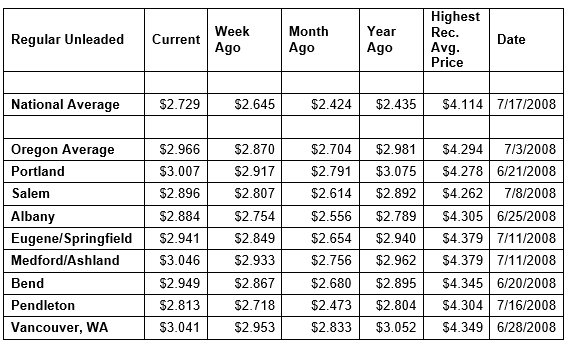
The national average is at its highest price since August 2019. The Oregon average is at its highest price since last March.
“March may bring the most expensive pump prices of 2021. AAA says drivers can expect gas prices to continue rising this month, adding at least another five to 15 cents until refinery operations are stable,” says Marie Dodds, public affairs director for AAA Oregon/Idaho. “While March is roaring in like a lion, it could go out like a lamb. We could see some relief at the pumps as the 26 refineries that were shut down due to last month’s severe winter weather resume normal operations, especially if crude oil prices show signs of stability.”
Crude oil prices have been near $60 per barrel for the last three weeks. Investors believe improving global economies due to the rollout of the coronavirus vaccine will cause demand for oil to pick up. Some major banks and traders suggest crude will rise to the $70s in the coming months. Higher crude prices translate into higher pump prices because crude oil accounts for more than 50% of the price at the pump.
Visit AAA.com/covidmap for an interactive map with the latest travel restrictions and policies for North America. Find AAA’s latest COVID-19 information for travelers here.
All 50 states and the District of Columbia have higher prices now than a week ago and 14 states are seeing double-digit increases. Arizona (+24 cents) has the largest weekly increase. Delaware (+3 cents) has the smallest weekly increase.
While California ($3.70) and Hawaii ($3.48) started the year above the $3 per gallon mark, a couple other states have followed suit: Washington ($3.11) and Nevada ($3.04). In all, four states are above $3, up from three states a week ago.
The cheapest gas in the nation can be found in Mississippi ($2.39) and Louisiana ($2.43). For the eighth week in a row, no state has an average below $2 a gallon.
All 50 states and the District of Columbia have higher prices now than a month ago and every state has a double-digit monthly increase. The national average is 31 cents more and the Oregon average is 26 cents more than a month ago. This is the 40th-largest month-over-month increase in the nation. Arizona (+56 cents) has the largest monthly increase in the country. Hawaii (+15 cents) has the smallest.
Oregon is one of only three states with lower prices now than a year ago. The national average is 29 cents more and the Oregon average is 2 cents less than a year ago. This is the smallest of the three yearly drops in the nation. Hawaii (-9 cents) has the largest year-over-year decline. Iowa (+45 cents) has the biggest yearly increase.
West Coast
The West Coast region continues to have the most expensive pump prices in the nation with every state in the region in the top 10.
| Rank | Region | Price on 3/2/21 | ||
| 1 | California | $3.70 | ||
| 2 | Hawaii | $3.48 | ||
| 3 | Washington | $3.11 | ||
| 4 | Nevada | $3.04 | ||
| 5 | Arizona | $2.99 | ||
| 6 | Oregon | $2.97 | ||
| 7 | Pennsylvania | $2.95 | ||
| 8 | Alaska | $2.90 | ||
| 9 | Illinois | $2.90 | ||
| 10 | District of Columbia | $2.87 |
California is the most expensive state for the eighth week in a row, with Hawaii, Washington, Nevada, Arizona and Oregon rounding out the top six. Oregon is sixth for the seventh week in a row. Alaska is eighth.
As mentioned above, California, Hawaii, Washington and Nevada are the only states in the nation with averages at or above $3 a gallon.
Prices increased in every state in the West Coast region this week, just like the rest of the country. Arizona (+24 cents) has the largest weekly increase in the region and the nation. Hawaii (+5 cents) has the smallest week-over-week increase in the region.
According to EIA’s latest weekly report, total gas stocks in the region increased slightly from 32.62 million bbl to 32.64 million bbl last week. This may help moderate pump price increases in the region this week.
Oil market dynamics
Crude prices remain at their highest prices in about a year. Although a stronger dollar and market concerns regarding interest rates pushed crude prices lower to end last week, prices increased more than $2 earlier in the week—up to $63.22—due to growing market optimism that as vaccines become more available, crude demand will recover. Crude prices rose mid-week despite the EIA’s latest report revealing that total domestic crude inventories increased by 1.3 million bbl last week, bringing the supply level to 463 million bbl. For this week, crude prices could rise if EIA’s next weekly report shows a decrease in total stocks.
At the close of Friday’s formal trading session, WTI decreased by $2.03 to settle at $61.50. At the close of Monday’s formal trading session, WTI lost 86 cents to settle at $60.64. Today crude is trading around $61, same as a week ago. Crude prices are about $16 more than a year ago.
Drivers can find current Oregon gas prices along their route with the free AAA Mobile app for iPhone, iPad and Android. The app can also be used to map a route, find discounts, book a hotel and access AAA roadside assistance. Learn more at AAA.com/mobile.
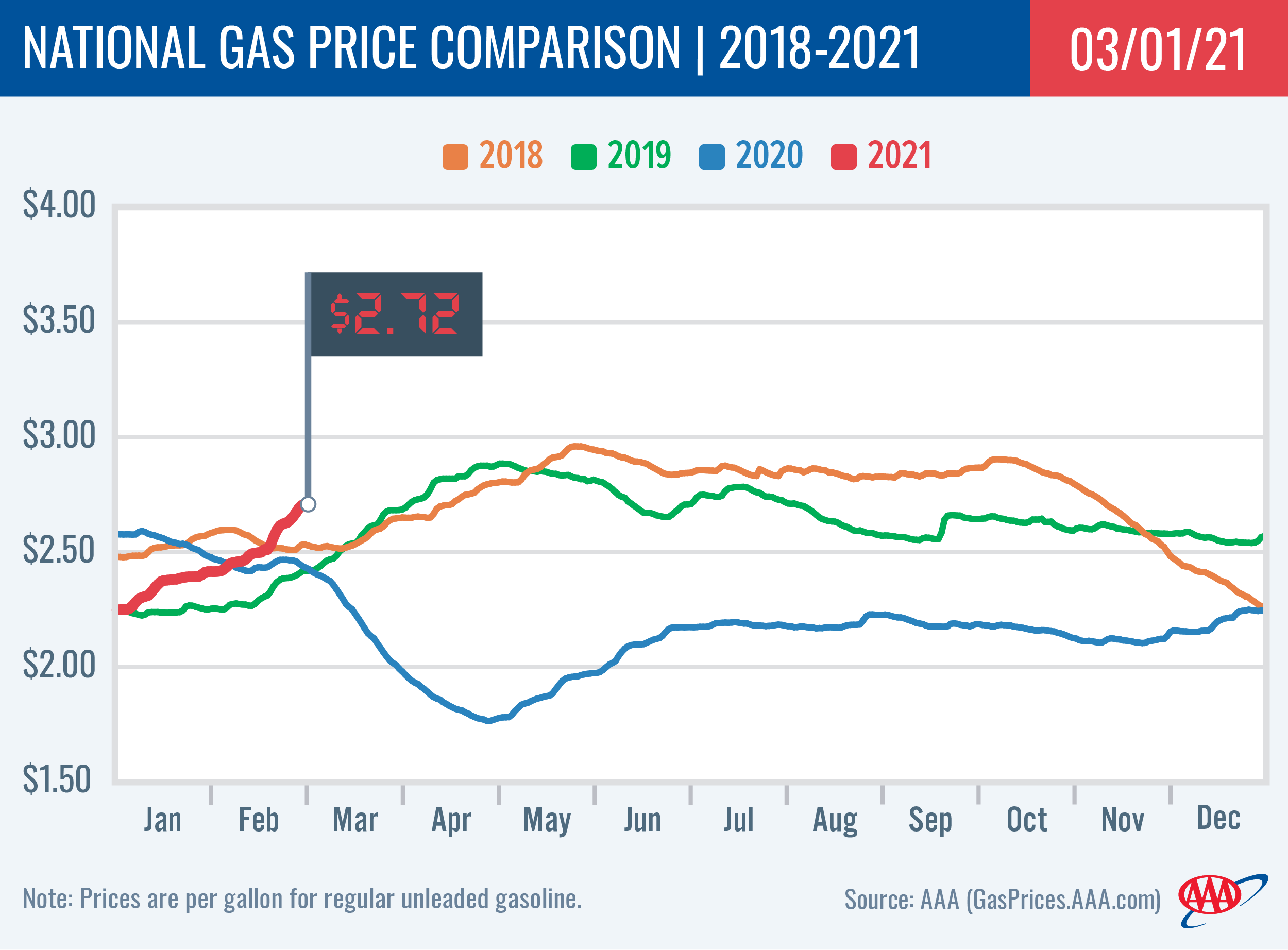
Diesel
For the week, the national average climbs nine cents to $2.95 a gallon. Oregon’s average also jumps nine cents to $3.01. A year ago the national average for diesel was $2.85 and the Oregon average was $3.15.
Find current fuel prices at GasPrices.AAA.com.
AAA news releases, high resolution images, broadcast-quality video, fact sheets and podcasts are available on the AAA NewsRoom at NewsRoom.AAA.com.
Find local news releases at https://oregon.aaa.com/community/media/media-contacts.html
Fuel prices are updated daily at AAA’s Daily Fuel Gauge at AAA Gas Prices. For more info go www.AAA.com. AAA Oregon/Idaho provides more than 840,000 members with travel, insurance, financial and automotive-related services, and is an affiliate of AAA National, serving more than 61 million motorists in North America.
February Oregon Gas Price News
Updated 2/23/2021
Highest Crude Prices in One Year, Record Cold Fuel Spikes at the Pumps
PORTLAND, Ore., – Drivers are filling up to some of the most expensive pump prices in about a year. Crude oil prices have climbed above $60 per barrel—the highest price in more than a year. With the shutdown of Gulf Coast and some Mid-West refineries due to last week’s severe winter weather, gasoline supplies have tightened and gas prices have skyrocketed. For the week, the national average for regular shoots up 13 cents to $2.65 a gallon. The Oregon average jumps nine cents to $2.87.
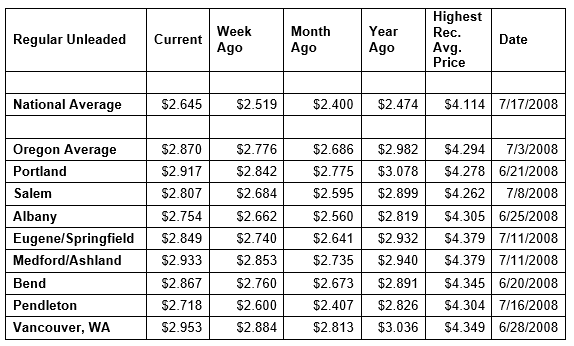
The national average is at its highest price since October 2019. The Oregon average is at its highest price since last March.
Refinery outages were reported last week in Texas, Louisiana, Oklahoma, Arkansas, Tennessee, and Kansas.
“When close to 40% of U.S. crude production is offline because refineries are closed, drivers will feel pain at the pumps until operations resume,” says Marie Dodds, public affairs director for AAA Oregon/Idaho. “The encouraging news is the nearly two dozen impacted refiners are expected to restart operations this week, if they haven’t already. So we expect regular gasoline deliveries to resume and impacted stations will be re-fueled.”
Rising crude oil prices are also driving higher gas prices. Crude climbed above $60 per barrel last week, which is close to the high price for all of 2020 of $63.27/bbl (seen on January 6, 2020). Investors believe improving global economies due to the rollout of the coronavirus vaccine will cause demand for oil to pick up. Some major banks and traders suggest crude will rise to the $70s in the coming months.
With the price of crude consistently increasing, so have gas prices because crude oil accounts for more than 50% of the price at the pump.
Gas prices are likely to be volatile because of the higher crude oil prices and until crude production is back to normal levels. Motorists can expect these more expensive prices to stick around, but large spikes are likely to subside. AAA believes the national average could climb to $2.80 a gallon this spring. The Oregon average will likely surpass $3 a gallon.
The U.S. Energy Information Administration (EIA) reports gasoline stocks sit at 257 million bbl. Just 2 million bbl short of year-ago, stock levels are relatively healthy. That will allow ample supply to get to impacted areas. EIA’s latest demand measurement of 8.4 million b/d is the highest reported since early November of last year. However, AAA expects that number to be lower in this Wednesday’s report as last week’s winter storm took motorists off the road.
Visit AAA.com/covidmap for an interactive map with the latest travel restrictions and policies for North America. Find AAA’s latest COVID-19 information for travelers here.
All 50 states and the District of Columbia have higher prices now than a week ago and 36 states are seeing double-digit increases. Arizona (+23 cents) has the largest weekly increase. Montana (+5 cents) has the smallest weekly increase.
After 36 weeks, Washington ($3.01) joins California ($3.59) and Hawaii ($3.43) as the only states in the nation with averages at or above $3 a gallon.
The cheapest gas in the nation can be found in Mississippi ($2.30) and Louisiana ($2.34). For the seventh week in a row, no state has an average below $2 a gallon.
All 50 states and the District of Columbia have higher prices now than a month ago. Every state except Hawaii has a double-digit monthly increase. The national average is 25 cents more and the Oregon average is 18 cents more than a month ago. This is the 46th-largest month-over-month increase in the nation. Michigan (+35 cents) has the largest monthly increase in the country. Hawaii (+9 cents) has the smallest.
Oregon is one of only nine states with lower prices now than a year ago. The national average is 17 cents more and the Oregon average is 11 cents less than a year ago. This is the third-largest yearly drop in the nation. Hawaii (-15 cents) has the largest year-over-year decline. Iowa (+32 cents) has the biggest yearly increase.
West Coast
The West Coast region continues to have the most expensive pump prices in the nation with every state in the region except Arizona in the top 10.
| Rank | Region | Price on 2/23/21 | ||
| 1 | California | $3.59 | ||
| 2 | Hawaii | $3.43 | ||
| 3 | Washington | $3.01 | ||
| 4 | Pennsylvania | $2.91 | ||
| 5 | Nevada | $2.90 | ||
| 6 | Oregon | $2.87 | ||
| 7 | Illinois | $2.83 | ||
| 8 | District of Columbia | $2.82 | ||
| 9 | Alaska | $2.81 | ||
| 10 | New Jersey | $2.77 |
California is the most expensive state for the seventh week in a row, with Hawaii and Washington rounding out the top three. Nevada is fifth, Oregon is sixth for the sixth week in a row. Alaska is ninth and Arizona is 11th.
As mentioned above, California, Hawaii and Washington are the only states in the nation with averages at or above $3 a gallon.
Prices increased in every state in the West Coast region this week. Arizona (+23 cents) has the largest weekly increase in the region and the nation. Hawaii (+6 cents) has the smallest week-over-week increase in the region.
According to EIA’s latest weekly report, total gas stocks in the region decreased slightly from 32.86 million bbl to 32.62 million bbl last week. This may put additional upward pressure on pump prices in the region this week.
Oil market dynamics
Crude prices are at their highest level in about a year. Crude prices took a step back last week but then rebounded to start this week. There were market concerns last week that crude demand may not rebound as expected, but prices did push higher earlier in the week due to supply and delivery impacts from the winter storm. Crude prices were also bolstered by EIA’s latest weekly report revealing that total domestic crude inventories dropped by 7.3 million bbl, bringing the supply level to 461.8 million bbl. For this week, crude prices rose after investors and traders made predictions that crude prices will likely climb into the $70s as the coronavirus vaccine gets rolled out and life begins to return to normal. Prices will likely rise if EIA’s next weekly report shows another decrease in total stocks, but price gains could be limited again if demand concerns persist.
At the close of Friday’s formal trading session, WTI decreased by $1.28 to settle at $59.24. At the close of Monday’s formal trading session, WTI increased by $2.25 to settle at $61.49. Today crude is trading around $61, compared to $60 a week ago. Crude prices are about $8 more than a year ago.
Drivers can find current Oregon gas prices along their route with the free AAA Mobile app for iPhone, iPad and Android. The app can also be used to map a route, find discounts, book a hotel and access AAA roadside assistance. Learn more at AAA.com/mobile.
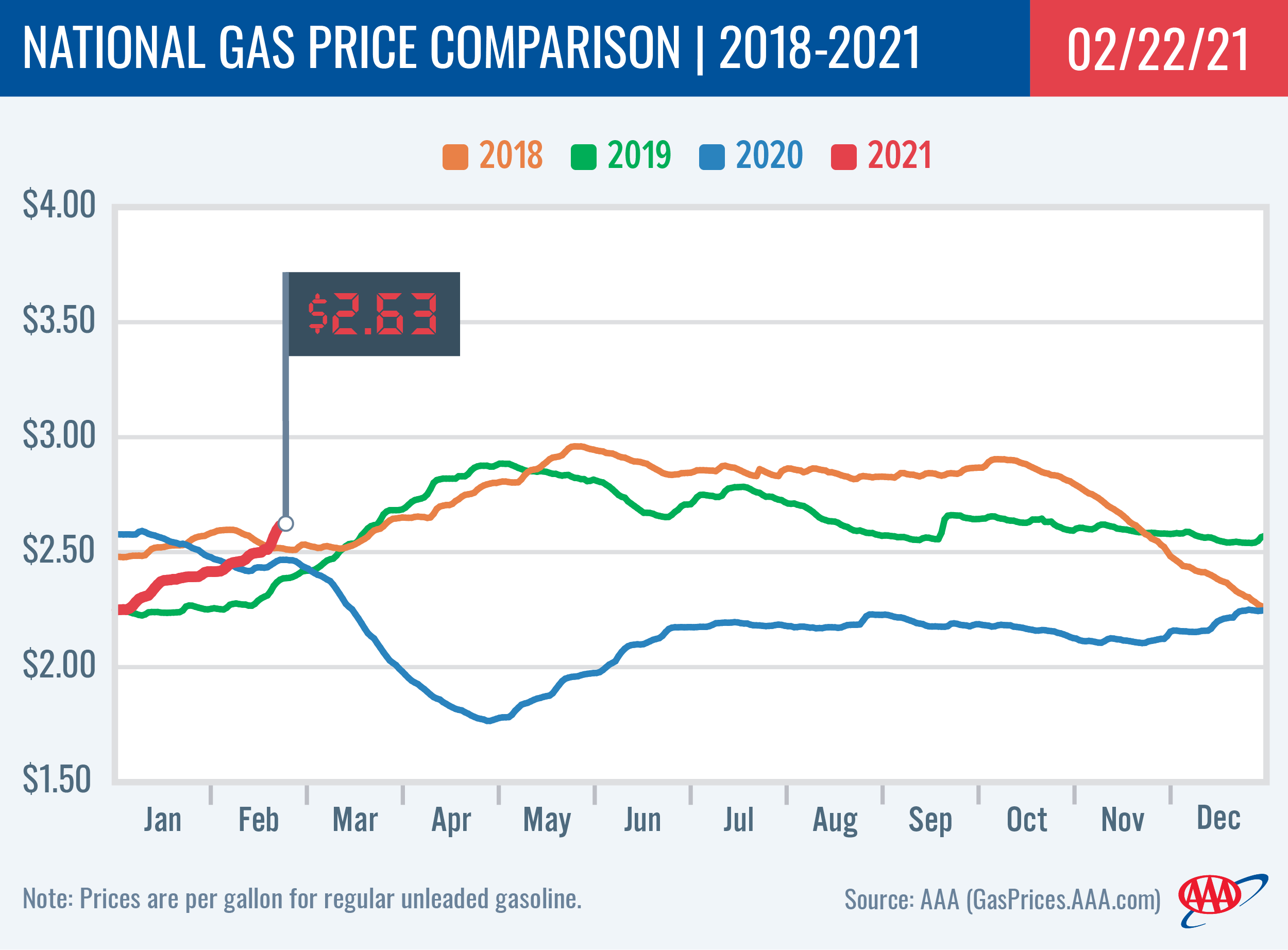
Diesel
For the week, the national average climbs eight cents to $2.86 a gallon. Oregon’s average jumps nine cents to $2.92. A year ago the national average for diesel was $2.88 and the Oregon average was $3.16.
Find current fuel prices at GasPrices.AAA.com.
AAA news releases, high resolution images, broadcast-quality video, fact sheets and podcasts are available on the AAA NewsRoom at NewsRoom.AAA.com.
Find local news releases at https://oregon.aaa.com/community/media/media-contacts.html
Fuel prices are updated daily at AAA’s Daily Fuel Gauge at AAA Gas Prices. For more info go www.AAA.com. AAA Oregon/Idaho provides more than 840,000 members with travel, insurance, financial and automotive-related services, and is an affiliate of AAA National, serving more than 61 million motorists in North America.
Updated 2/16/2021
High Crude Prices, Severe Winter Weather Send Pump Prices Higher
PORTLAND, Ore., – Crude oil prices have climbed near $60 per barrel—the highest price in more than a year. The rising crude prices along with extreme winter weather across much of the country are putting upward pressure on retail gas prices, despite relatively low demand for gasoline. For the week, the national average for regular jumps a nickel to $2.52 a gallon. The Oregon average rises three cents to $2.78.
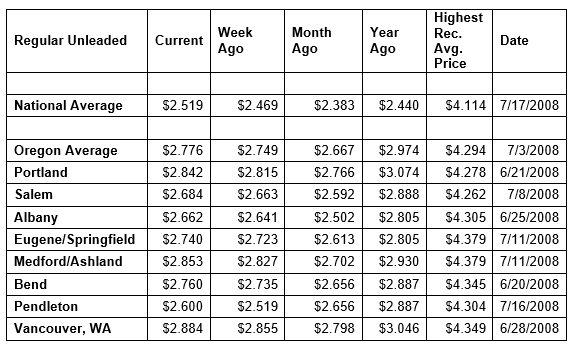
The national average is at its highest price since January of last year. The Oregon average is at its highest price since last March.
At the end of last week, crude oil prices reached $59.47/bbl. This is only about $4 less than last year’s most expensive price of $63.27/bbl (seen on January 6, 2020). Since the end of November, the price of crude has increased as much as $5/bbl a week, meaning we could see 2021 crude oil prices top 2020 prices as early as this week.
With the price of crude consistently increasing, so have gas prices because crude oil accounts for more than 50% of the price at the pump.
The extreme winter weather across much of the country is also causing gas prices to rise in some areas due to decreases in production and delivery challenges. The impact is most noticeable in oil-producing states such as Texas where record cold and power outages have taken crude production offline. So far, the Southwest region has at least 2 million b/d of refining capacity off-line and has shuttered approximately 1 million b/d of crude production in the region. This is causing gas prices to rise in the region and beyond. The average for regular in Texas has increased a nickel this week.
“Spiking crude oil prices, not demand, is the major driver behind the pump price increases so far in 2021,” says Marie Dodds, public affairs director for AAA Oregon/Idaho. “If demand grows, that will further fuel pump price increases.”
U.S. gasoline demand has averaged 7.7 million b/d since January. The last time it measured below 8 million b/d during the first six weeks of the year was 2001.
Just how expensive gas will get this year is largely dependent on crude price and demand. The price of crude is still $10 to $12/bbl less than when the national average was last near $3/gallon in 2018. In order for prices to be that expensive again this spring or summer, AAA believes that a major spike in demand, returning to normal peak driving season levels, and crude sustaining at very high prices will be required.
Visit AAA.com/covidmap for an interactive map with the latest travel restrictions and policies for North America. Find AAA’s latest COVID-19 information for travelers here.
Oregon is one of 48 states and the District of Columbia with higher prices now than a week ago. Indiana (+11 cents) has the largest weekly increase. Florida (- 2 cents) has the largest weekly decline.
For the 36th week in a row, California ($3.48) and Hawaii ($3.37) are the only two states in the nation with an average at or above $3 a gallon.
The cheapest gas in the nation can be found in Mississippi ($2.17) and Texas ($2.22). For the sixth week in a row, no state has an average below $2 a gallon.
All 50 states and the District of Columbia have higher prices now than a month ago. The national average is 14 cents more and the Oregon average is 11 cents more than a month ago. This is the 40th-largest month-over-month increase in the nation. Idaho (+20 cents) has the largest monthly increase in the country. Delaware (+2 cents) has the smallest.
Oregon is one of 14 states with lower prices now than a year ago. The national average is eight cents more and the Oregon average is 20 cents less than a year ago. This is the fourth-largest yearly drop in the nation. Arizona (-27 cents) has the largest year-over-year decline. Delaware (+24 cents) has the biggest yearly increase.
West Coast
The West Coast region continues to have the most expensive pump prices in the nation with every state in the region except Arizona in the top 10.
| Rank | Region | Price on 2/16/21 | ||
| 1 | California | $3.48 | ||
| 2 | Hawaii | $3.37 | ||
| 3 | Washington | $2.92 | ||
| 4 | Nevada | $2.83 | ||
| 5 | Pennsylvania | $2.81 | ||
| 6 | Oregon | $2.78 | ||
| 7 | Illinois | $2.71 | ||
| 8 | Alaska | $2.70 | ||
| 9 | New Jersey | $2.68 | ||
| 10 | District of Columbia | $2.67 |
California is the most expensive state for the sixth week in a row, with Hawaii, Washington, and Nevada rounding out the top four. Oregon is sixth for the fifth week in a row. Alaska is eighth and Arizona is 15th.
As mentioned above, California and Hawaii are the only two states in the nation with an average at or above $3 a gallon.
Prices increased in every state in the West Coast region this week. Arizona (+7 cents) has the largest weekly increase in the region. Hawaii (+2 cents) has the largest week-over-week increase in the region.
According to EIA’s latest weekly report, total gas stocks in the region decreased from 33.71 million bbl to 32.86 million bbl last week. This may put additional upward pressure on pump prices in the region this week.
Oil market dynamics
Crude oil prices are at their highest prices in over a year. The rise in crude prices occurred after the Energy Information Administration’s weekly report revealed that total domestic crude inventories decreased by 6.6 million bbl to 469 million bbl, while total refinery crude utilization increased slightly from 82.3% to 83% last week. If supplies continue to tighten, as utilization increases, crude prices could continue to climb this week.
Moreover, record cold and icy weather in the Southwest has taken 2 million b/d of refining capacity off-line and shuttered approximately 1 million b/d of crude production in the region. The closures are expected to put pressure on pump prices in the region and could send domestic crude prices higher this week.
At the close of Friday’s formal trading session, WTI increased by $1.23 to settle at $59.47, which is the highest settlement price since January 2020. The New York Stock Exchange and Nasdaq were closed yesterday in observance of President’s Day. Today crude is trading around $60, compared to $58 a week ago. Crude prices are about $8 more than a year ago.
Drivers can find current Oregon gas prices along their route with the free AAA Mobile app for iPhone, iPad and Android. The app can also be used to map a route, find discounts, book a hotel and access AAA roadside assistance. Learn more at AAA.com/mobile.

Diesel
For the week, the national average jumps seven cents to $2.78 a gallon. Oregon’s average adds three cents to $2.83. A year ago the national average for diesel was $2.89 and the Oregon average was $3.17.
Find current fuel prices at GasPrices.AAA.com.
AAA news releases, high resolution images, broadcast-quality video, fact sheets and podcasts are available on the AAA NewsRoom at NewsRoom.AAA.com.
Find local news releases at https://oregon.aaa.com/community/media/media-contacts.html
Fuel prices are updated daily at AAA’s Daily Fuel Gauge at AAA Gas Prices. For more info go www.AAA.com. AAA Oregon/Idaho provides more than 840,000 members with travel, insurance, financial and automotive-related services, and is an affiliate of AAA National, serving more than 61 million motorists in North America.
Updated 2/9/2021
No Love at the Pumps this February; Gas Prices Continue to Climb
PORTLAND, Ore., – Gas prices are rising in Oregon and just about every other state this week due to higher crude oil prices and the market’s growing optimism that demand will increase as more people receive COVID-19 vaccinations. For the week, the national average for regular jumps a nickel to $2.47 a gallon. The Oregon average also adds a nickel to $2.75.
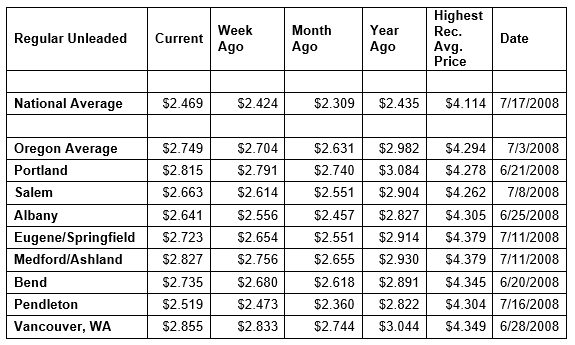
The national average is at its highest price since February of last year. The Oregon average is at its highest price since last March.
Crude oil prices are back at levels last seen in January 2020, prior to the coronavirus pandemic. Prices rose to $56/bbl last week following the Organization of the Petroleum Exporting Countries’ (OPEC) decision to keep their production cuts unchanged—a decision influenced by the ongoing impact of the pandemic on gasoline demand. Typically, it can take a few weeks before pump prices see the impact of more expensive crude, and with crude accounting for more than 50% of the retail price, increases are no doubt going to continue.
“Consumers can expect to keep paying more to fill up this month, potentially up to 10 cents more a gallon, depending on how high crude oil prices go,” says Marie Dodds, public affairs director for AAA Oregon/Idaho. “If demand grows, that will further fuel pump price increases.”
Gas prices continued to climb this past week despite a drop in gasoline demand. According to the latest U.S. Energy Information Administration (EIA) measurements, demand declined from 7.83 million b/d to 7.77 million b/d. A year ago, demand was 8.9 million b/d. Gasoline demand remains relatively low due to the coronavirus pandemic.
Visit AAA.com/covidmap for an interactive map with the latest travel restrictions and policies for North America. Find AAA’s latest COVID-19 information for travelers here.
Oregon is one of 48 states and the District of Columbia with higher prices now than a week ago. Michigan (+11 cents) has the largest weekly increase. Delaware (- 1 cent) is the only state with a weekly decline. The average is Maryland is flat.
For the 35th week in a row, California ($3.45) and Hawaii ($3.35) are the only two states in the nation with an average at or above $3 a gallon.
The cheapest gas in the nation can be found in Mississippi ($2.15) and Texas ($2.17). For the fifth week in a row, no state has an average below $2 a gallon.
All 50 states and the District of Columbia have higher prices now than a month ago. The national average is 16 cents more and the Oregon average is 12 cents more than a month ago. This is the 41st-largest month-over-month increase in the nation. Michigan (+32 cents) has the largest monthly increase in the country. Delaware (+2 cents) has the smallest.
Oregon is one of 18 states with lower prices now than a year ago. This past Saturday, February 6, was the first time in 340 days the national average was more expensive than a year ago. Currently, the national average is three cents more and the Oregon average is 23 cents less than a year ago. This is the fourth-largest yearly drop in the nation. Arizona (-35 cents) has the largest year-over-year decline. Delaware (+26 cents) has the biggest yearly increase.
West Coast
The West Coast region continues to have the most expensive pump prices in the nation with every state in the region except Arizona in the top 10.
| Rank | Region | Price on 2/9/21 | ||
| 1 | California | $3.45 | ||
| 2 | Hawaii | $3.35 | ||
| 3 | Washington | $2.88 | ||
| 4 | Nevada | $2.79 | ||
| 5 | Pennsylvania | $2.76 | ||
| 6 | Oregon | $2.75 | ||
| 7 | District of Columbia | $2.65 | ||
| 8 | Illinois | $2.65 | ||
| 9 | Alaska | $2.65 | ||
| 10 | New Jersey | $2.62 |
California is the most expensive state for the fifth week in a row, with Hawaii, Washington, and Nevada rounding out the top four. Oregon is sixth for the fourth week in a row. Alaska is ninth and Arizona is 20th.
As mentioned above, California and Hawaii are the only two states in the nation with an average at or above $3 a gallon.
Prices increased in every state in the West Coast region this week. Oregon (+5 cents) has the largest weekly increase in the region. Hawaii (-2 cents) has the smallest week-over-week increase in the region.
According to EIA’s latest weekly report, total gas stocks in the region increased from 33.60 million bbl to 33.71 million bbl last week. This may help moderate pump price increases in the region this week.
Oil market dynamics
Crude oil prices are at their highest prices since January of 2020. Crude prices rose last week after OPEC and its production reduction agreement partners met to review compliance with their agreement to collectively reduce crude production by 7.2 million b/d. The group decided to hold the cuts steady and expects output to remain low this year since demand is forecasted to be lower than expected in 2021, due to ongoing crude demand concerns as the pandemic continues.
Crude prices were also bolstered by the U.S. Energy Information Administration’s (EIA) latest report showing that total domestic crude inventories dropped by 1 million bbl to 475.7 million bbl. For this week, crude prices may continue to climb if the next weekly EIA report shows another reduction in total domestic crude inventories.
At the close of Friday’s formal trading session, WTI increased by 62 cents to settle at $56.85. At the close of Monday’s formal trading session, WTI rose $1.12 to settle at $57.97. Today crude is trading around $58, compared to $55 a week ago. Crude prices are up about 11 percent in the last month and are about $7 more than a year ago.
Drivers can find current Oregon gas prices along their route with the free AAA Mobile app for iPhone, iPad and Android. The app can also be used to map a route, find discounts, book a hotel and access AAA roadside assistance. Learn more at AAA.com/mobile.
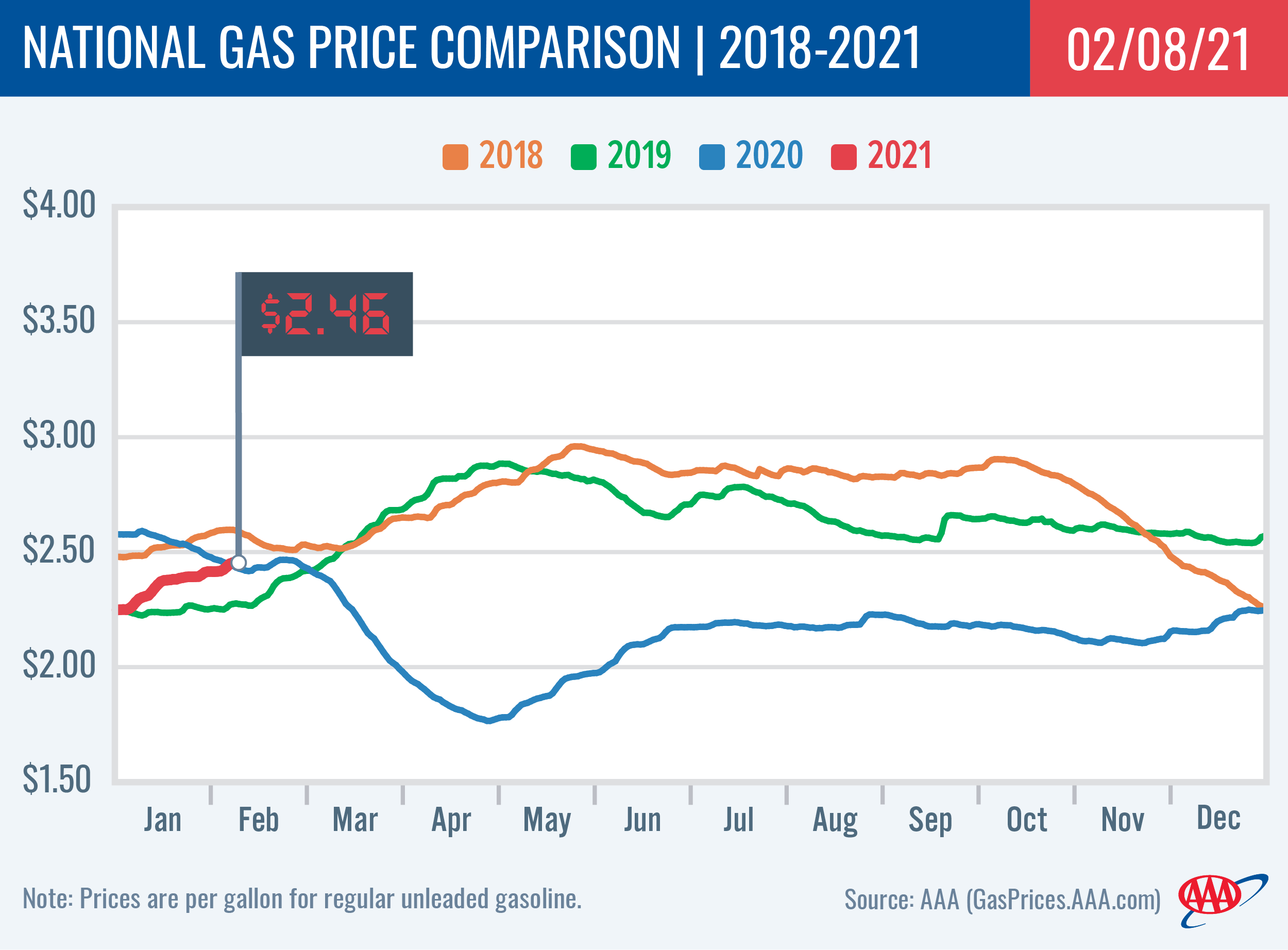
Diesel
For the week, the national average jumps a nickel to $2.70 a gallon. Oregon’s average adds four cents to $2.80. A year ago the national average for diesel was $2.91 and the Oregon average was $3.19.
Find current fuel prices at GasPrices.AAA.com.
AAA news releases, high resolution images, broadcast-quality video, fact sheets and podcasts are available on the AAA NewsRoom at NewsRoom.AAA.com.
Find local news releases at https://oregon.aaa.com/community/media/media-contacts.html
Fuel prices are updated daily at AAA’s Daily Fuel Gauge at AAA Gas Prices. For more info go www.AAA.com. AAA Oregon/Idaho provides more than 840,000 members with travel, insurance, financial and automotive-related services, and is an affiliate of AAA National, serving more than 61 million motorists in North America.
Updated 2/2/2021
Rising Crude Prices put Brakes on Savings at the Pumps
PORTLAND, Ore., – Gas prices continue to climb due to higher crude oil prices, despite a drop in U.S. demand and an increase in supplies. For the week, the national average for regular rises two cents to $2.42 a gallon. The Oregon average also gains two cents to $2.70.

For the last 337 days, the national gas price average has been cheaper year-over-year—as much as $1.12 a gallon less. However, AAA predicts that trend will end as early as this week. Currently, the national average is just a nickel less than a year ago. That gap is much larger in Oregon as the current average is 27 cents less than one year ago.
“For nearly a year, drivers have been saving 53 cents a gallon, on average, when filling up their gas tanks. That extra pocket change is quickly going away due to rising crude oil prices that have made for more expensive pump prices,” says Marie Dodds, public affairs director for AAA Oregon/Idaho.
Gas prices continued to climb this past week despite a drop in gasoline demand and refinery utilization. According to the latest U.S. Energy Information Administration (EIA) measurements, demand declined from 8.11 million b/d to 7.83 million b/d and total refinery utilization decreased from 82.5 percent to 81.7 percent over last week. These decreases led to an increase in gasoline supply of 2.4 million bbl.
Typically, these factors (decrease in demand, increase in supply) drive a drop at the pump, but sustained crude oil prices are pushing the increase. For three weeks, crude continued to price between $52 and $53/bbl, and then increased above $54/bbl this week. These are price points not seen since mid-February 2020. Gas prices are expected to continue to increase as crude oil prices remain at these price points, even as gasoline demand remains below 2020 levels due to the coronavirus pandemic.
Visit AAA.com/covidmap for an interactive map with the latest travel restrictions and policies for North America. Find AAA’s latest COVID-19 information for travelers here.
Oregon is one of 46 states with higher prices now than a week ago. Indiana (+9 cents) has the largest weekly increase. Delaware (-1 cent) has the largest weekly decrease.
For the 34th week in a row, California ($3.42) and Hawaii ($3.33) are the only two states in the nation with an average at or above $3 a gallon.
The cheapest gas in the nation can be found in Mississippi ($2.11) and Missouri ($2.13). For the fourth week in a row, no state has an average below $2 a gallon.
All 50 states and the District of Columbia have higher prices now than a month ago. The national average is 13 cents more and the Oregon average is 10 cents more than a month ago. This is the 45th-largest month-over-month increase in the nation. West Virginia (+24 cents) has the largest monthly increase in the country. Hawaii (+4 cents) has the smallest.
Oregon is one of 39 states and the District of Columbia with lower prices now than a year ago. The national average is five cents less and the Oregon average is 27 cents less than a year ago. This is the sixth-largest yearly drop in the nation. Arizona (-38 cents) has the largest year-over-year decline. Delaware (+23 cents) has the biggest yearly increase.
West Coast
The West Coast region continues to have the most expensive pump prices in the nation with every state in the region except Arizona in the top 10.
| Rank | Region | Price on 2/2/21 | ||
| 1 | California | $3.42 | ||
| 2 | Hawaii | $3.33 | ||
| 3 | Washington | $2.84 | ||
| 4 | Nevada | $2.77 | ||
| 5 | Pennsylvania | $2.71 | ||
| 6 | Oregon | $2.70 | ||
| 7 | Alaska | $2.62 | ||
| 8 | District of Columbia | $2.61 | ||
| 9 | Illinois | $2.59 | ||
| 10 | New Jersey | $2.57 |
California is the most expensive state for the fourth week in a row, with Hawaii, Washington, and Nevada rounding out the top four. Oregon is sixth for the third week in a row. Alaska is seventh and Arizona is 16th.
As mentioned above, California and Hawaii are the only two states in the nation with an average at or above $3 a gallon.
States in the West Coast region are seeing relatively small changes in gas prices in the last week. California (+4 cents) has the largest weekly increase in the region. Alaska (+1 cent) has the smallest week-over-week increase. Hawaii (-1 cent) is the only state in the region with a weekly decrease.
According to EIA’s latest weekly report, total gas stocks in the region increased from 32.67 million bbl to 33.60 million bbl last week. This may temper pump price increases in the region this week.
Oil market dynamics
This week crude oil prices have jumped to a one-year high due to declining global supplies and rising winter fuel demand as a major snow storm pummels the East Coast. Crude prices are poised to continue rising this week.
Crude oil price gains were limited last week by ongoing market concern that crude demand may take more time than expected to recover in 2021 due to new coronavirus infections and associated travel restrictions. However, EIA’s new weekly report prompted crude price increases earlier in the week after it showed total domestic crude inventories declined by 9.9 million bbl to 476.7 million bbl, which is the largest weekly decline since late July 2020. For this week, crude prices may rise optimism due to declining global supplies.
At the close of Friday’s formal trading session, WTI decreased by 14 cents to settle at $52.20. At the close of Monday’s formal trading session, WTI rose $1.35 to settle at $53.55. Today crude is trading around $55, compared to $53 a week ago. Crude prices are up about 16 percent in the last month and are about $2 more than a year ago.
Drivers can find current Oregon gas prices along their route with the free AAA Mobile app for iPhone, iPad and Android. The app can also be used to map a route, find discounts, book a hotel and access AAA roadside assistance. Learn more at AAA.com/mobile.
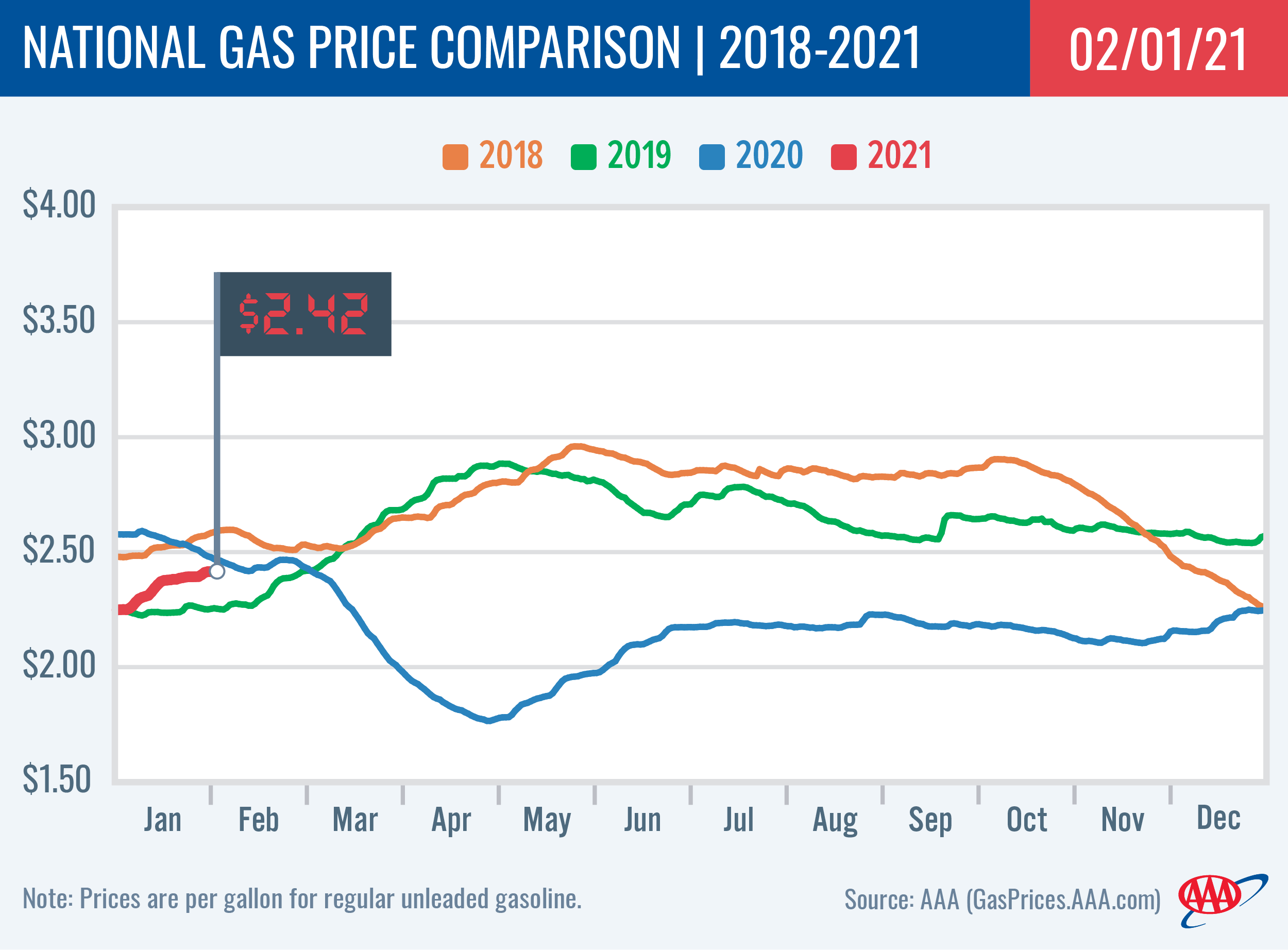
Diesel
For the week, the national average adds a penny to $2.65 a gallon. Oregon’s average holds steady at $2.75. A year ago the national average for diesel was $2.95 and the Oregon average was $3.21.
Find current fuel prices at GasPrices.AAA.com.
AAA news releases, high resolution images, broadcast-quality video, fact sheets and podcasts are available on the AAA NewsRoom at NewsRoom.AAA.com.
Find local news releases at https://oregon.aaa.com/community/media/media-contacts.html
Fuel prices are updated daily at AAA’s Daily Fuel Gauge at AAA Gas Prices. For more info go www.AAA.com. AAA Oregon/Idaho provides more than 840,000 members with travel, insurance, financial and automotive-related services, and is an affiliate of AAA National, serving more than 61 million motorists in North America.
January Oregon Gas Price News
Updated 1/26/2021
Jump in Gasoline Demand has Little Impact on Prices or Supplies
PORTLAND, Ore., – U.S. demand for gasoline shot up in the last week which would usually translate to fairly large gains in pump prices. However, most states including Oregon are seeing minimal increases. For the week, the national average for regular ticks up a penny to $2.40 a gallon. The Oregon average also adds a penny to $2.69.
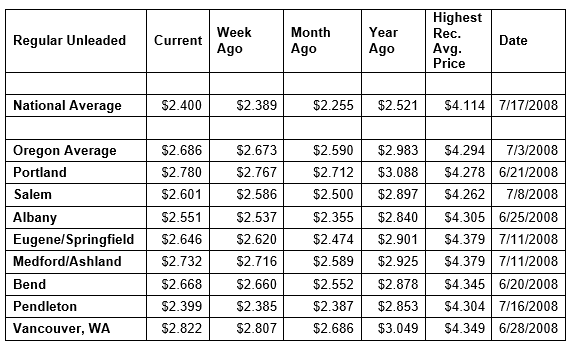
Gasoline demand jumped from 7.53 million b/d to 8.11 million b/d according to the latest report from the U.S. Energy Information Administration (EIA). For the week ending January 20, gasoline supply saw a small decrease of 300,000 bbl. At 245 million bbl, supply levels lag behind last year’s reading at this time by 15 million bbl.
“Drivers continue to see pump prices rise but at a slower rate than the past few weeks. Part of that is due to relatively stable crude oil prices throughout January,” says Marie Dodds, public affairs director for AAA Oregon/Idaho. “However, if demand continues to grow, we can expect pump prices to move higher.”
Demand remains below 2020 levels for this time of year due to the coronavirus pandemic, but the gap is narrowing. A year ago demand was at 8.7 million b/d. Demand fell to a low of 5.1 million b/d in early April 2020, as many states enacted lock downs and travel restrictions.
Visit AAA.com/covidmap for an interactive map with the latest travel restrictions and policies for North America. Find AAA’s latest COVID-19 information for travelers here.
Oregon is one of 43 states and the District of Columbia with higher prices now than a week ago. Nebraska (+5 cents) has the largest weekly increase. Indiana (- 5 cents) has the largest weekly decrease. The average in North Carolina is flat.
For the 33rd week in a row, California ($3.38) and Hawaii ($3.34) are the only two states in the nation with an average at or above $3 a gallon.
The cheapest gas in the nation can be found in Mississippi ($2.10) and Texas ($2.11). For the third week in a row, no state has an average below $2 a gallon.
Oregon is one of 49 states and the District of Columbia with higher prices now than a month ago. The national average is 15 cents more and the Oregon average is 10 cents more than a month ago. This is the 41st-largest month-over-month increase in the nation. West Virginia (+24 cents) has the largest monthly increase in the country. Montana (+5 cents) has the smallest. Indiana (-3 cents) is the only state with a month-over-month decline.
Oregon is one of 48 states and the District of Columbia with lower prices now than a year ago. The national average is 12 cents less and the Oregon average is 30 cents less than a year ago. This is the sixth-largest yearly drop in the nation. Arizona (-41 cents) has the largest year-over-year decline. Iowa (-1 cent) has the smallest. Delaware (+20 cents) and Maryland (+5 cents) are the only states with year-over-year increases.
West Coast
The West Coast region continues to have the most expensive pump prices in the nation with every state in the region except Arizona in the top 10.
| Rank | Region | Price on 1/26/21 | ||
| 1 | California | $3.38 | ||
| 2 | Hawaii | $3.34 | ||
| 3 | Washington | $2.82 | ||
| 4 | Nevada | $2.74 | ||
| 5 | Pennsylvania | $2.70 | ||
| 6 | Oregon | $2.69 | ||
| 7 | Alaska | $2.61 | ||
| 8 | District of Columbia | $2.61 | ||
| 9 | New Jersey | $2.55 | ||
| 10 | Illinois | $2.54 |
California is the most expensive state for the third week in a row, with Hawaii, Washington, and Nevada rounding out the top four. Oregon is sixth for the second week in a row. Alaska is seventh and Arizona is 16th.
As mentioned above, California and Hawaii are the only two states in the nation with an average at or above $3 a gallon.
Like other states in the nation, West Coast states are seeing small increases in gas prices in the last week. California (+3 cents) has the largest weekly increase in the region. Oregon (+1 cent) has the smallest weekly increase in the region.
According to EIA’s latest weekly report, total gas stocks in the region decreased from 33.18 million bbl to 32.67 million bbl last week. This may put some upward pressure on pump prices in the region this week.
Oil market dynamics
Crude prices declined last week following market concerns that crude demand may suffer as coronavirus infections rise and travel restrictions, which are meant to curb transmission of the virus, reduce crude demand. Additionally, EIA’s latest weekly report revealed that total domestic crude inventories rose by 4.4 million bbl to 486.6 million bbl, which also put downward pressure on crude prices. For this week, crude prices may continue to drop if market concern regarding demand continues to grow.
At the close of Friday’s formal trading session, WTI decreased by 86 cents to settle at $52.27. At the close of Monday’s formal trading session, WTI rose 50 cents to settle at $52.77. Today crude is trading around $52, compared to $53 a week ago. Crude prices are up about 10 percent in the last month and are about $1 less than a year ago.
Drivers can find current Oregon gas prices along their route with the free AAA Mobile app for iPhone, iPad and Android. The app can also be used to map a route, find discounts, book a hotel and access AAA roadside assistance. Learn more at AAA.com/mobile.

Diesel
For the week, the national average adds a penny to $2.64 a gallon. Oregon’s average edges up half a cent to $2.76. A year ago the national average for diesel was $2.98 and the Oregon average was $3.23.
Find current fuel prices at GasPrices.AAA.com.
AAA news releases, high resolution images, broadcast-quality video, fact sheets and podcasts are available on the AAA NewsRoom at NewsRoom.AAA.com.
Find local news releases at https://oregon.aaa.com/community/media/media-contacts.html
Fuel prices are updated daily at AAA’s Daily Fuel Gauge at AAA Gas Prices. For more info go www.AAA.com. AAA Oregon/Idaho provides more than 840,000 members with travel, insurance, financial and automotive-related services, and is an affiliate of AAA National, serving more than 61 million motorists in North America.
Updated 1/19/2021
New Year Sees Jumps in Pump Prices
PORTLAND, Ore., – Gas prices are climbing as we start 2021 as crude oil prices continue to rise. Every state reports an increase at the pumps. For the week, the national average for regular increases a nickel to $2.38 a gallon. The Oregon average gains three cents to $2.67.
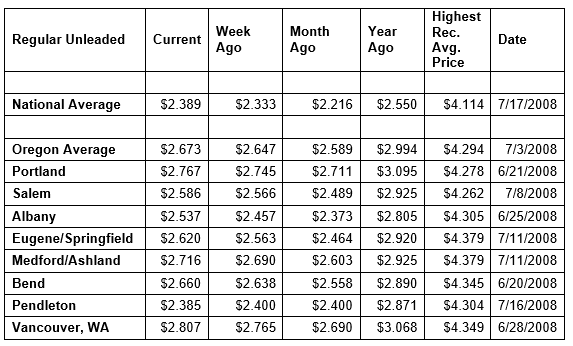
Since the beginning of the year, the national average has jumped 13 cents and the Oregon average has added seven cents. The last time the nation saw a substantial January pump price increase was in 2009. That year, the national gas price average jumped 23 cents and the Oregon average rose 21 cents in the first three weeks of the year. At that time U.S. gasoline demand and supply were lower and crude oil prices had been increasing, similar to today.
Gas prices have been rising this year as crude oil prices continue to increase — last week pricing as high as $53/bbl. The latest U.S. Energy Information Administration (EIA) reports show gasoline demand remains low at 7.5 million b/d, which contributed to a 4.4 million bbl increase to gasoline supply, for a total of 245 million bbl.
“The higher price of crude oil is outweighing sustained low gasoline demand and a build in gasoline supply,” says Marie Dodds, public affairs director for AAA Oregon/Idaho. “Drivers can expect Oregon gas prices to continue to climb through at least the end of the month, even though demand remains low due to the coronavirus pandemic.”
Visit AAA.com/covidmap for an interactive map with the latest travel restrictions and policies for North America. Find AAA’s latest COVID-19 information for travelers here.
Prices increased in all 50 states and the District of Columbia this week. Virginia (+9 cents) has the largest weekly increase. Wyoming (+1 cent) has the smallest.
For the 32nd week in a row, California ($3.35) and Hawaii ($3.32) are the only two states in the nation with an average at or above $3 a gallon.
The cheapest gas in the nation can be found in Mississippi ($2.08) and Missouri ($2.11). For the second week in a row, no state has an average below $2 a gallon.
All 50 states and the District of Columbia have higher prices now than a month ago. The national average is 17 cents more and the Oregon average is eight cents more than a month ago. This is the 45th-largest month-over-month increase in the nation. West Virginia (+26 cents) has the largest monthly increase in the country. Idaho (+4 cents) has the smallest.
Oregon is one of 49 states and the District of Columbia with lower prices now than a year ago. The national average is 16 cents less and the Oregon average is 32 cents less than a year ago. This is the seventh-largest yearly drop in the nation. Arizona (-43 cents) has the largest year-over-year decline. Delaware (+16 cents) is the only state with a year-over-year increase.
West Coast
The West Coast region continues to have the most expensive pump prices in the nation with every state in the region except Arizona in the top 10.
| Rank | Region | Price on 1/19/21 | |
| 1 | California | $3.35 | |
| 2 | Hawaii | $3.32 | |
| 3 | Washington | $2.81 | |
| 4 | Nevada | $2.71 | |
| 5 | Pennsylvania | $2.69 | |
| 6 | Oregon | $2.67 | |
| 7 | District of Columbia | $2.59 | |
| 8 | Alaska | $2.58 | |
| 9 | New Jersey | $2.55 | |
| 10 | Illinois | $2.52 |
California is the most expensive state for the second week in a row, with Hawaii, Washington, and Nevada rounding out the top four. Oregon falls to sixth, after spending the last three weeks at fifth. Alaska is eighth and Arizona is 16th.
As mentioned above, California and Hawaii are the only two states in the nation with an average at or above $3 a gallon.
Like other states in the nation, some West Coast states saw gas prices jump by a nickel or more in the last week. Arizona (+8 cents) has the largest weekly increase in the region. Oregon (+3 cents) has the smallest weekly increase in the region.
According to EIA’s latest weekly report, total gas stocks in the region increased from 31.44 million bbl to 33.18 million bbl last week. This may help keep pump price increases to a minimum in the region this week.
Oil market dynamics
Crude prices increased last week after Saudi Arabia announced that it would cut its crude production by 1 million b/d in February and March. Additionally, increasing crude prices were supported by EIA’s weekly report revealing that total domestic crude inventories decreased by 8 million bbl to 485.5 million bbl last week. If total domestic crude supply drops again this week, crude prices could continue to increase and push pump prices higher.
At the close of Friday’s formal trading session, WTI decreased by $1.21 cents to settle at $52.36. Markets were closed Monday for the Martin Luther King Jr. holiday. Today crude is trading around $53, same as a week ago. Crude prices are up about 11 percent in the last month and are about $6 less than a year ago.
Drivers can find current Oregon gas prices along their route with the free AAA Mobile app for iPhone, iPad and Android. The app can also be used to map a route, find discounts, book a hotel and access AAA roadside assistance. Learn more at AAA.com/mobile.
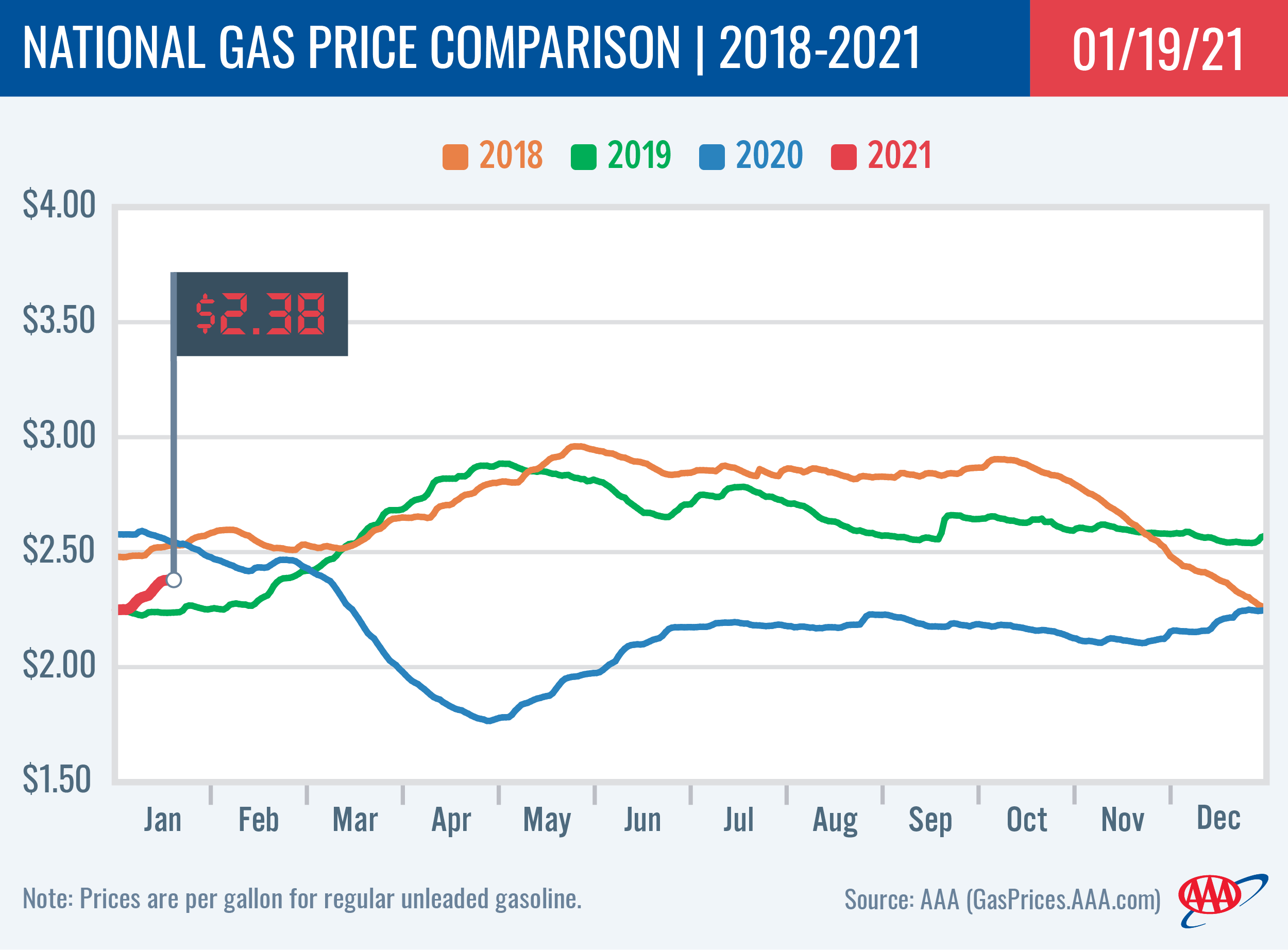
Diesel
For the week, the national average gains three cents to $2.63 a gallon. Oregon’s average adds a penny to $2.75. A year ago the national average for diesel was $3.00 and the Oregon average was $3.24.
Find current fuel prices at GasPrices.AAA.com.
AAA news releases, high resolution images, broadcast-quality video, fact sheets and podcasts are available on the AAA NewsRoom at NewsRoom.AAA.com.
Find local news releases at https://oregon.aaa.com/community/media/media-contacts.html
Fuel prices are updated daily at AAA’s Daily Fuel Gauge at AAA Gas Prices. For more info go www.AAA.com. AAA Oregon/Idaho provides more than 840,000 members with travel, insurance, financial and automotive-related services, and is an affiliate of AAA National, serving more than 61 million motorists in North America.
Updated 1/12/2021
Surging Crude Oil Prices Send Pump Prices Higher Despite Decreasing Demand
PORTLAND, Ore., – Retail Oregon gas prices are rising in the first days of 2021 even though demand for gasoline has fallen to the lowest level in eight months. Crude oil prices have surged above $50 per barrel, putting upward pressure on pump prices. Many states are seeing increases of more than a nickel. For the week, the national average for regular jumps seven cents to $2.33 a gallon. The Oregon average adds four cents to $2.65.
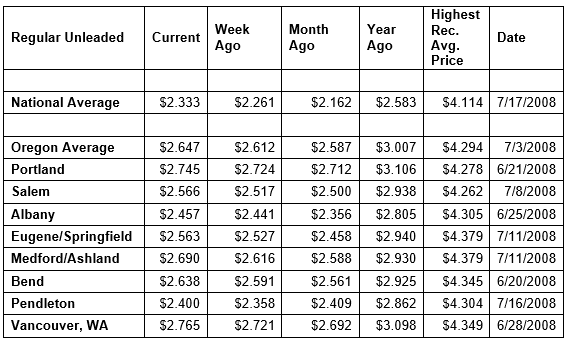
The national average is at its highest price since last March. The Oregon average is at its highest price since last September.
“Gas Prices are climbing as supplies tighten and crude oil prices get more expensive. Last week, crude oil jumped to the highest price since before the pandemic. If crude prices remain at these levels, it’ll cost more for drivers to fill up,” says Marie Dodds, public affairs director for AAA Oregon/Idaho.
Pump prices have increased despite gas demand falling from 8.1 million b/d to 7.4 million b/d — the lowest level recorded since the end of May 2020, according to the U.S. Energy Information Administration’s (EIA) latest weekly report.
U.S. gasoline supply sits at 241 million bbl. While this is the healthiest measurement since August 2020, it is 10 million bbl less than the start of 2020 (251 million bbl) when COVID-19 concerns were minimal. This year-over-year deficit, combined with lower refinery production rates and ongoing refinery maintenance, is pushing crude and gas prices more expensive.
Visit AAA.com/covidmap for an interactive map with the latest travel restrictions and policies for North America. Find AAA’s latest COVID-19 information for travelers here.
Prices increased in all 50 states and the District of Columbia this week, with 36 states and D.C. seeing jumps of a nickel or more. West Virginia (+16 cents) has the largest weekly increase. Hawaii (+1 cent) has the smallest.
For the 31st week in a row, California ($3.30) and Hawaii ($3.29) are the only two states in the nation with an average at or above $3 a gallon.
The cheapest gas in the nation can be found in Mississippi ($2.02) and Louisiana ($2.05). After 43 weeks, this is the first week that no state has an average below $2 a gallon. Last week, six states were below that benchmark.
Oregon is one of 48 states and the District of Columbia with higher prices now than a month ago. The national average is 17 cents more and the Oregon average is six cents more than a month ago. This is the 44th-largest month-over-month increase in the nation. Kentucky (+25 cents) has the largest monthly increase in the country. Idaho (-3 cents) and Utah (-2 cents) are the only two states with monthly declines.
Oregon is one of 49 states and the District of Columbia with lower prices now than a year ago. The national average is 25 cents less and the Oregon average is 36 cents less than a year ago. This is the seventh-largest yearly drop in the nation. Arizona (-51 cents) has the largest year-over-year decline. Delaware (+4 cents) is the only state with a year-over-year increase.
West Coast
The West Coast region continues to have the most expensive pump prices in the nation with every state in the region except Arizona in the top 10.
| Rank | Region | Price on 1/12/21 | |
| 1 | California | $3.30 | |
| 2 | Hawaii | $3.29 | |
| 3 | Washington | $2.78 | |
| 4 | Nevada | $2.67 | |
| 5 | Oregon | $2.65 | |
| 6 | Pennsylvania | $2.63 | |
| 7 | Alaska | $2.55 | |
| 8 | District of Columbia | $2.55 | |
| 9 | New Jersey | $2.48 | |
| 10 | Illinois | $2.48 |
After 17 weeks, California bumps Hawaii as the most expensive state with Hawaii, Washington, Nevada and Oregon rounding out the top five. Alaska is seventh and Arizona is 16th. Oregon is fifth most expensive for the third week in a row.
As mentioned above, California and Hawaii re the only two states in the nation with an average at or above $3 a gallon.
Like other states in the nation, some West Coast states saw gas prices jump by a nickel or more in the last week. Arizona (+8 cents) has the largest weekly increase in the region. Hawaii (+1 cent) has the smallest weekly increase in the region and in the nation.
According to EIA’s latest weekly report, total gas stocks in the region increased from 30.18 million bbl to 31.44 million bbl last week. This may help temper pump price increases in the region this week.
Oil market dynamics
Crude prices increased last week after Saudi Arabia announced that it would cut its crude production by 1 million b/d in February and March. Additionally, increasing crude prices were supported by EIA’s weekly report revealing that total domestic crude inventories decreased by 8 million bbl to 485.5 million bbl last week. If total domestic crude supply drops again this week, crude prices could continue to increase and push pump prices higher.
At the close of Friday’s formal trading session, WTI increased by $1.41 cents to settle at $52.24. At the end of Monday’s formal trading session, WTI added a penny to settle at $52.25 per barrel. Today crude is trading around $53, compared to $498 a week ago. Crude prices are up about 13 percent in the last month and are about $7 less than a year ago.
Drivers can find current Oregon gas prices along their route with the free AAA Mobile app for iPhone, iPad and Android. The app can also be used to map a route, find discounts, book a hotel and access AAA roadside assistance. Learn more at AAA.com/mobile.
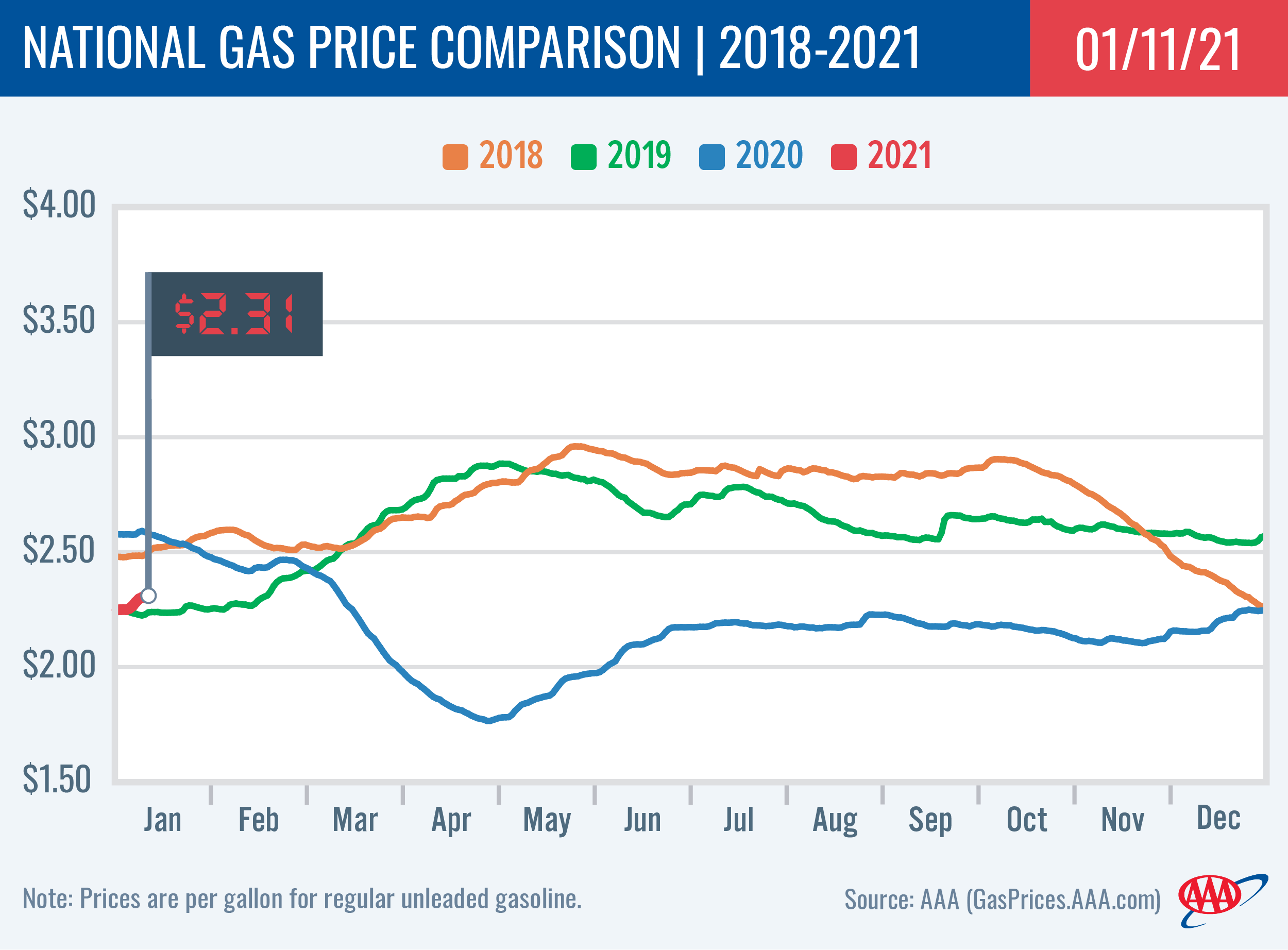
Diesel
For the week, the national average gains three cents to $2.60 a gallon. Oregon’s average adds a penny to $2.74. A year ago the national average for diesel was $3.02 and the Oregon average was $3.26.
Find current fuel prices at GasPrices.AAA.com.
AAA news releases, high resolution images, broadcast-quality video, fact sheets and podcasts are available on the AAA NewsRoom at NewsRoom.AAA.com.
Find local news releases at https://oregon.aaa.com/community/media/media-contacts.html
Fuel prices are updated daily at AAA’s Daily Fuel Gauge at AAA Gas Prices. For more info go www.AAA.com. AAA Oregon/Idaho provides more than 820,000 members with travel, insurance, financial and automotive-related services, and is an affiliate of AAA National, serving more than 61 million motorists in North America.
Updated 1/5/2021
Pump Prices Show Small Gains as 2021 Begins
PORTLAND, Ore., – The new year is underway and retail Oregon gas prices are fairly steady this week, changing by less than a nickel in most states. Stable crude oil prices and low demand for gasoline are the major factors. For the week, the national average for regular adds a penny to $2.26 a gallon. The Oregon average also gains a penny to $2.61.
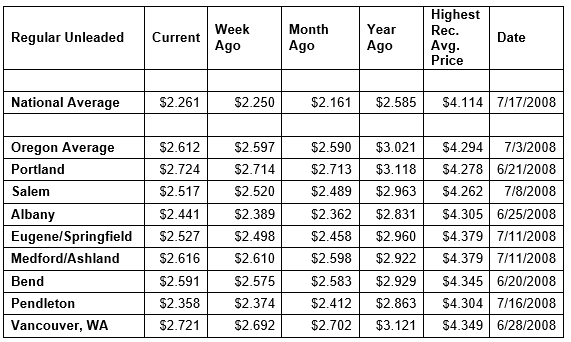
For the year 2020, the annual national gas price average was $2.17 per gallon, the lowest since 2016. The Oregon average for 2020 is $2.67, also the lowest annual Oregon gas price average for the state since 2016.
Crude oil prices have remained about $47 to $49 per barrel since late December. U.S. demand for gasoline is at the lowest level for the last week of December in 23 years (since 1998) at 8.1 million b/d, according to the U.S. Energy Information Administration (EIA).
“Holiday road travel was down at least 25%. With fewer people on the road, the majority of states saw little change at the pumps from the last week of 2020 to the first few days of 2021,” says Marie Dodds, public affairs director for AAA Oregon/Idaho.
AAA expects demand for gas to dwindle in coming weeks which could put downward pressure on pump prices this month, especially if crude oil holds at the current price point.
How high or low Oregon gas prices will go in 2021 will largely depend on crude oil prices, supply and demand. AAA expects that as the vaccine becomes more widely available and states loosen travel restrictions, Americans will begin to drive more and at that point we will see an impact at the pump.
Visit AAA.com/covidmap for an interactive map with the latest travel restrictions and policies for North America. Find AAA’s latest COVID-19 information for travelers here.
Oregon is one of 46 states and the District of Columbia where prices changed by a nickel or less in the last week. Indiana (-7 cents) has the largest weekly decrease. Ohio (+6 cents) has the largest weekly increase.
For the 30th week in a row, Hawaii ($3.28) and California ($3.25) are the only two states in the nation with an average at or above $3 a gallon.
The cheapest gas in the nation can be found in Mississippi ($1.94) and Texas ($1.95). This is the 43rd week in a row that one or more states has an average below $2 a gallon. In all, six states are below that benchmark, down from seven a week ago.
Oregon is one of 44 states and the District of Columbia with higher prices now than a month ago. The national average is 10 cents more and the Oregon average is two cents more than a month ago. This is the fourth-smallest month-over-month increase in the nation. Wisconsin (+21 cents) has the largest monthly increase in the country.
All 50 states and the District of Columbia have lower prices now than a year ago. The national average is 32 cents less and the Oregon average is 41 cents less than a year ago. This is the 8th-largest yearly drop in the nation. Arizona (-60 cents) has the largest year-over-year decline.
West Coast
The West Coast region continues to have the most expensive pump prices in the nation with every state in the region except Arizona in the top 10.
| Rank | Region | Price on 1/5/21 | |
| 1 | Hawaii | $3.28 | |
| 2 | California | $3.25 | |
| 3 | Washington | $2.76 | |
| 4 | Nevada | $2.63 | |
| 5 | Oregon | $2.61 | |
| 6 | Pennsylvania | $2.57 | |
| 7 | Alaska | $2.51 | |
| 8 | District of Columbia | $2.47 | |
| 9 | New Jersey | $2.41 | |
| 10 | Illinois | $2.39 |
Hawaii is most expensive for the 17th week in a row with California, Washington, Nevada and Oregon rounding out the top five. Alaska is seventh and Arizona is 20th. Oregon is fifth most expensive for the second week in a row.
As mentioned above, Hawaii and California are the only two states in the nation with an average at or above $3 a gallon.
Prices in the West Coast states changed by three cents or less in the past week. Nevada (+3 cents) has the largest weekly increase in the region. Hawaii (- 6/10ths of a cent) has the biggest weekly decrease in the region.
According to EIA’s latest weekly report, total gas stocks in the region decreased from 30.66 million bbl to 30.18 million bbl last week. This may put some upward pressure on pump prices in the region this week especially if there’s a disruption in supply.
Oil market dynamics
Crude prices increased last week due to a weak dollar and rising market optimism that coronavirus vaccines will help crude oil demand recover in 2021. However, as coronavirus infection rates continue to climb and travel restrictions increase, crude prices will likely be capped this week.
At the close of Thursday’s formal trading session, WTI increased by 12 cents to settle at $48.50. Markets were closed Friday for the New Year’s Day holiday. At the end of Monday’s formal trading session, WTI lost 90 cents to settle at $47.62 per barrel. Today crude is trading around $49, compared to $48 a week ago. Crude prices are up about nine percent in the last month and are about $15 less than a year ago.
Drivers can find current Oregon gas prices along their route with the free AAA Mobile app for iPhone, iPad and Android. The app can also be used to map a route, find discounts, book a hotel and access AAA roadside assistance. Learn more at AAA.com/mobile.
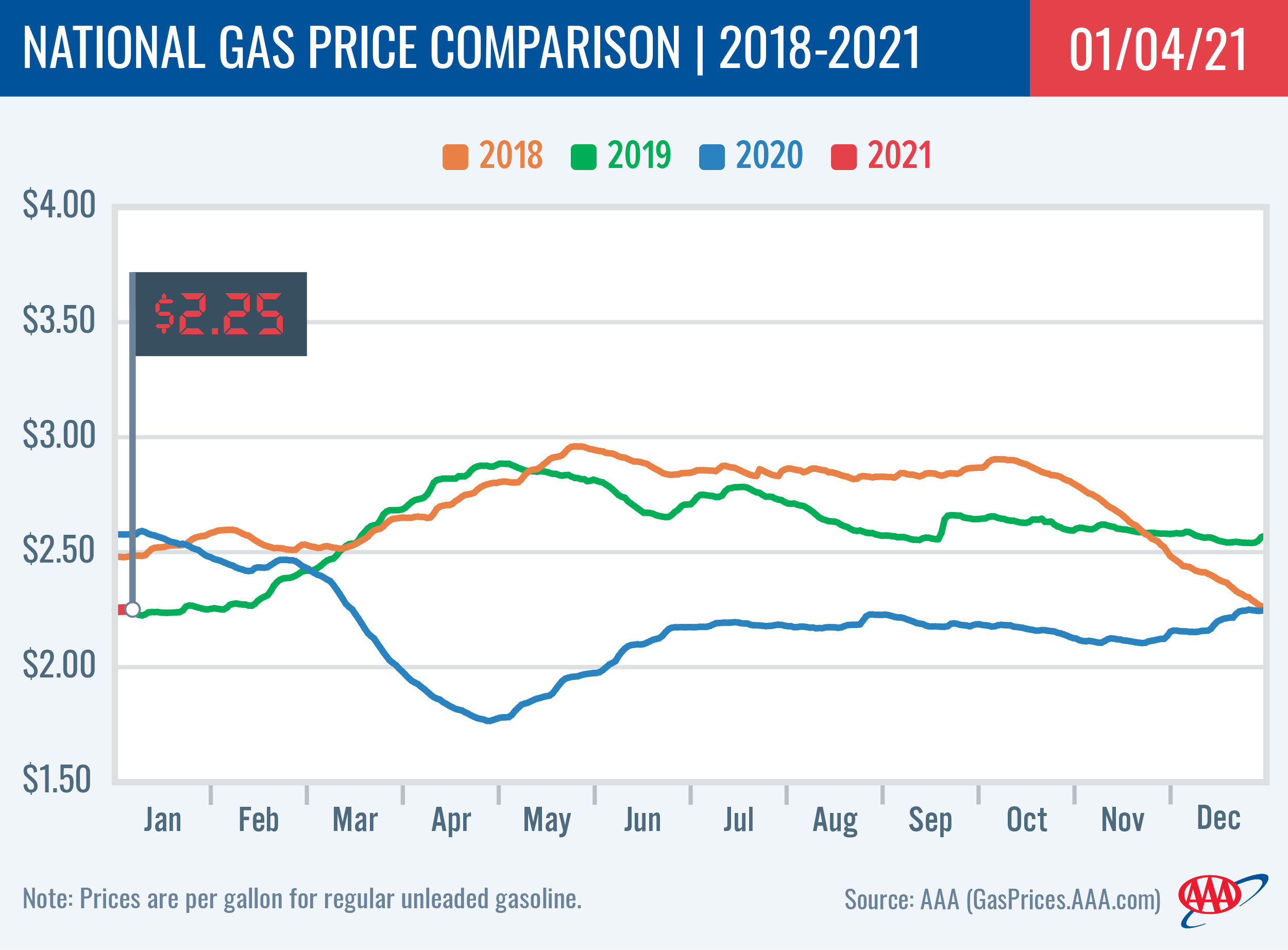
Diesel
For the week, the national average adds two cents to $2.57 a gallon. Oregon’s average adds half a cent to $2.73. A year ago the national average for diesel was $3.02 and the Oregon average was $3.27.
Find current fuel prices at GasPrices.AAA.com.
AAA news releases, high resolution images, broadcast-quality video, fact sheets and podcasts are available on the AAA NewsRoom at NewsRoom.AAA.com.
Find local news releases at https://oregon.aaa.com/community/media/media-contacts.html

